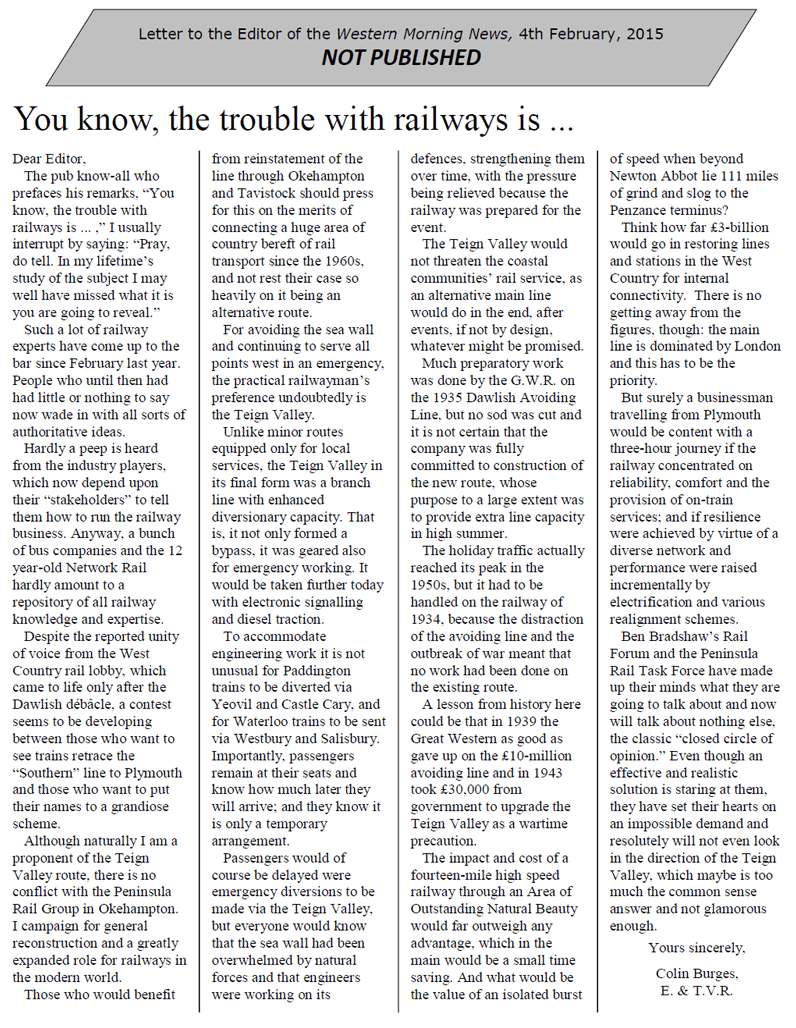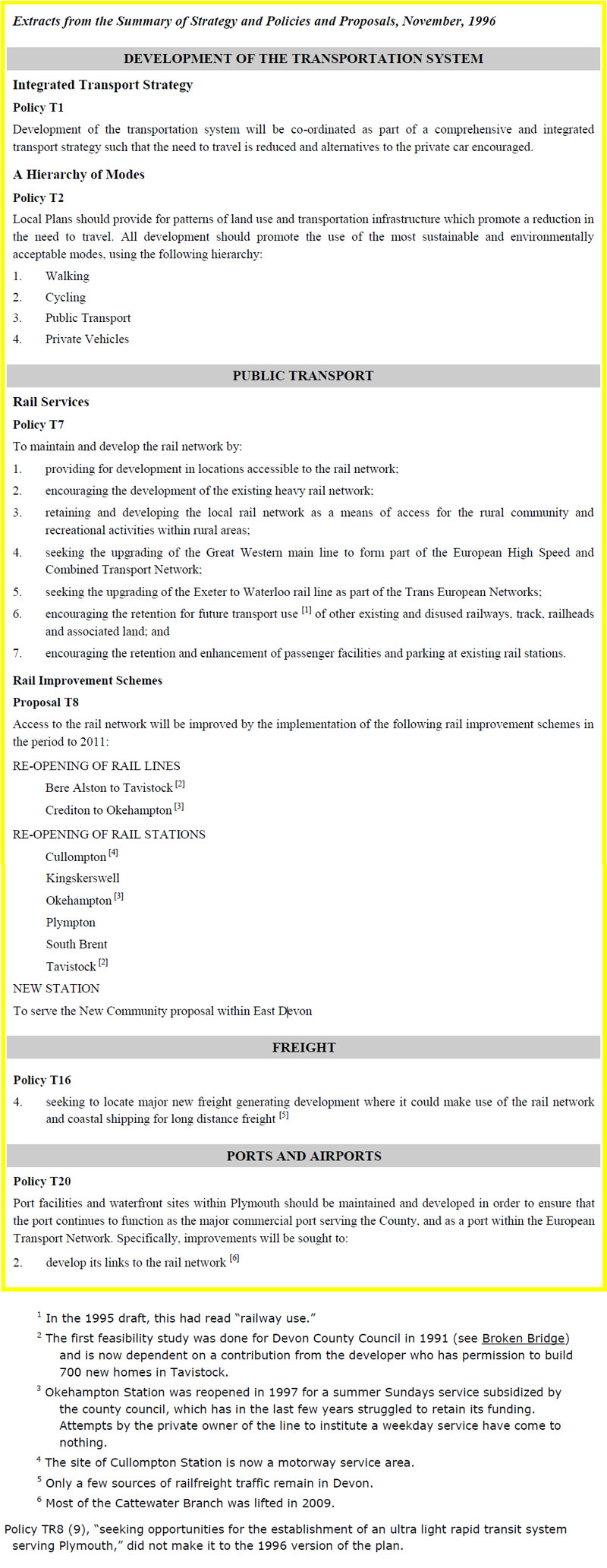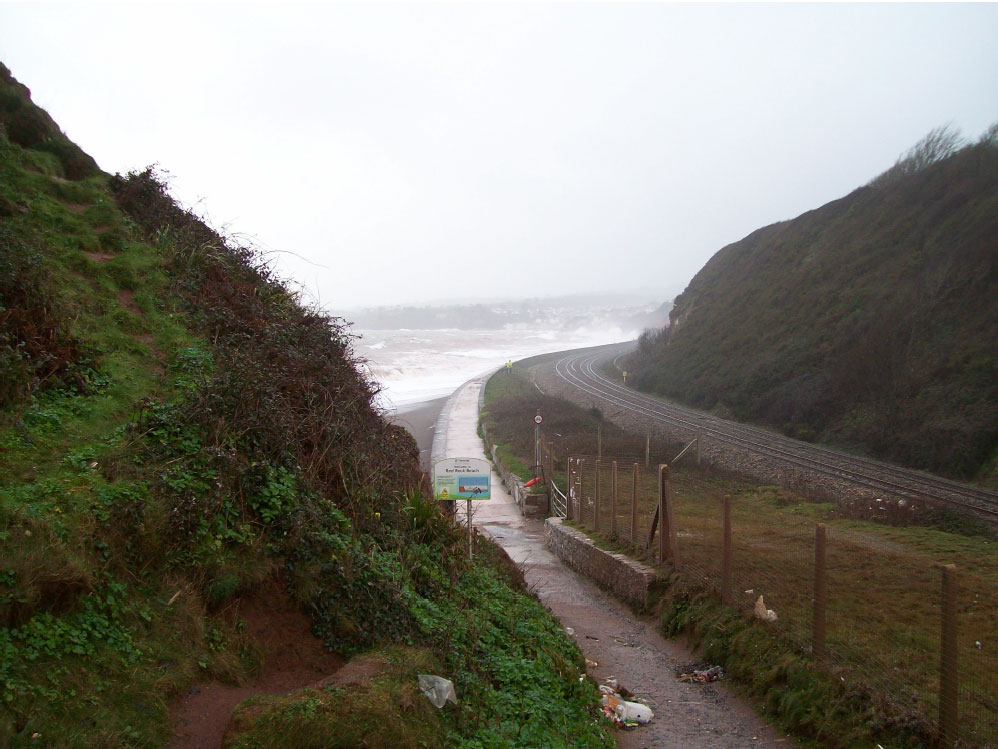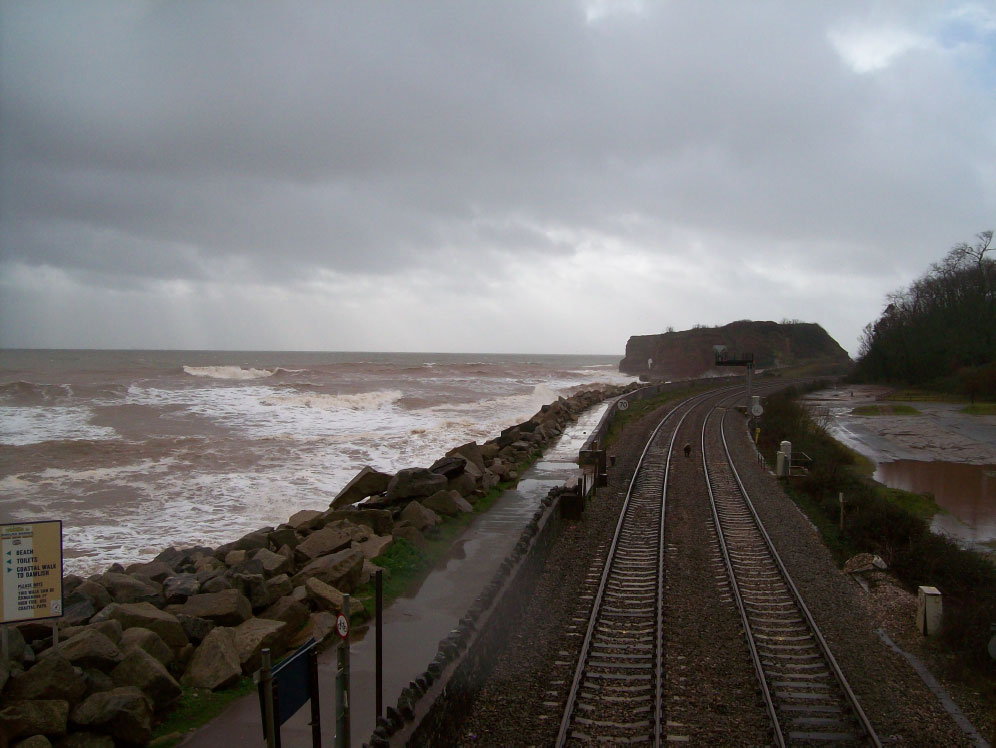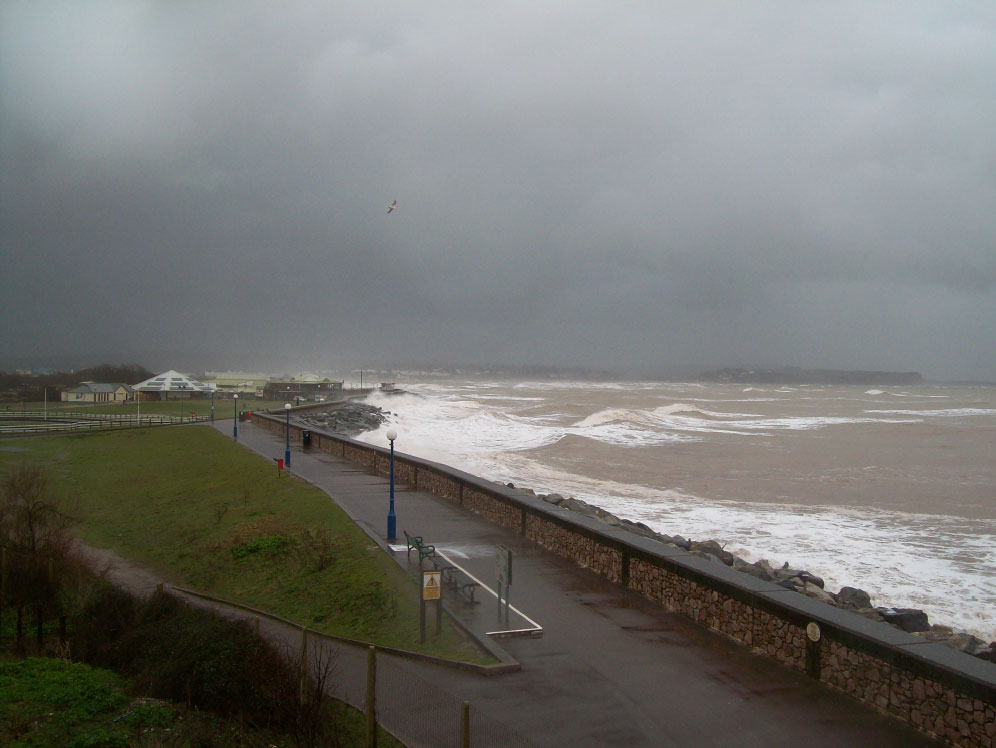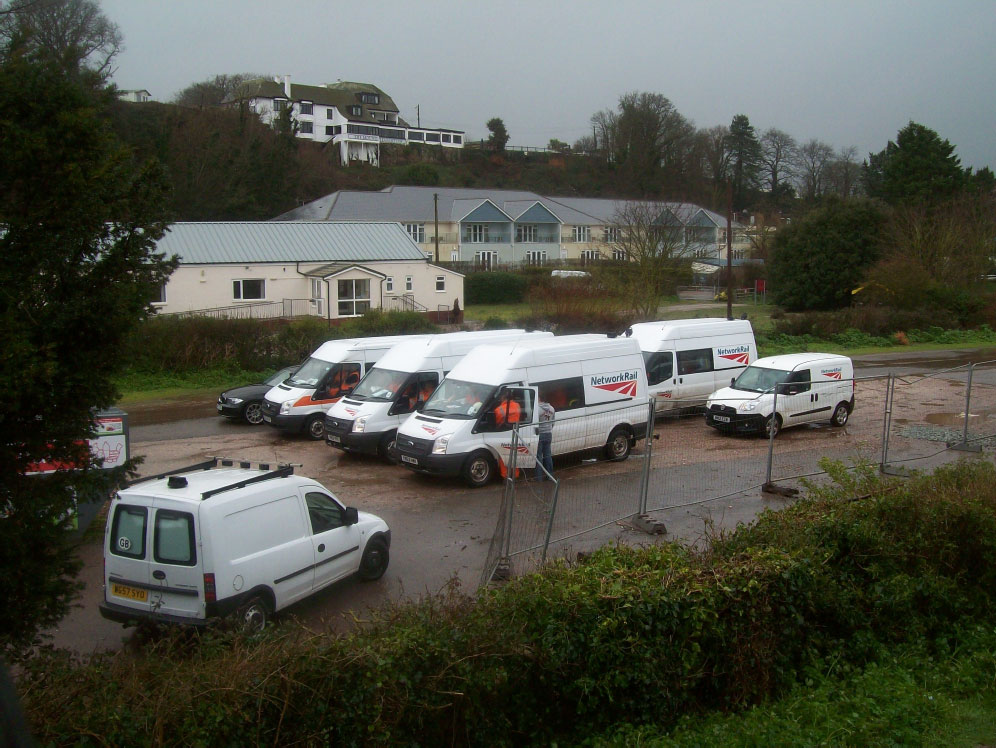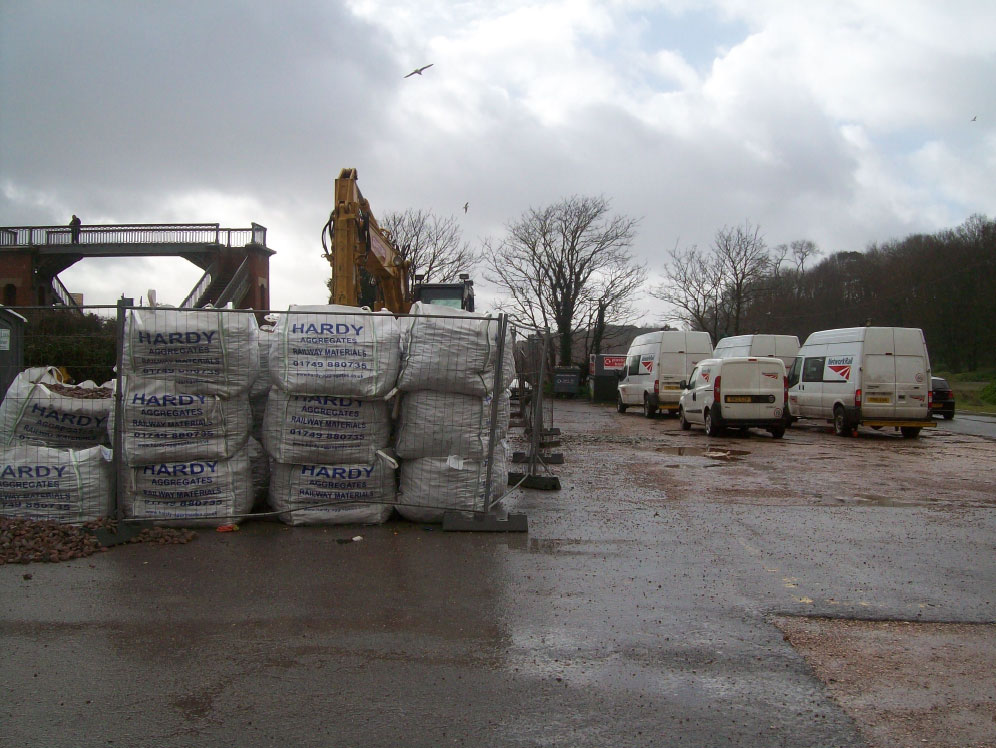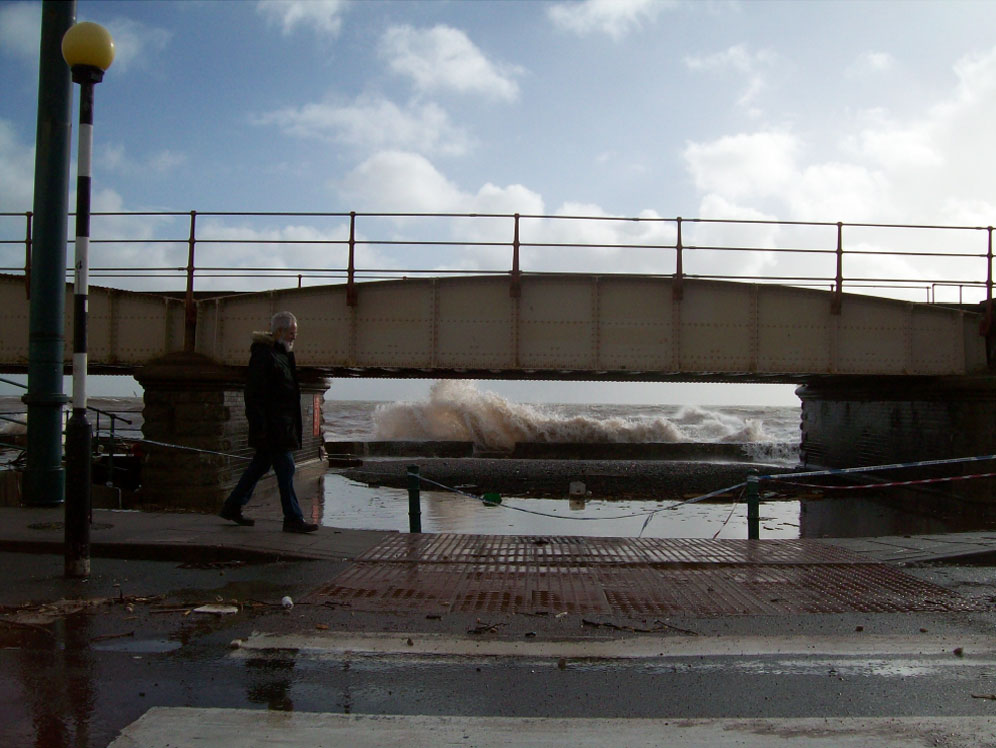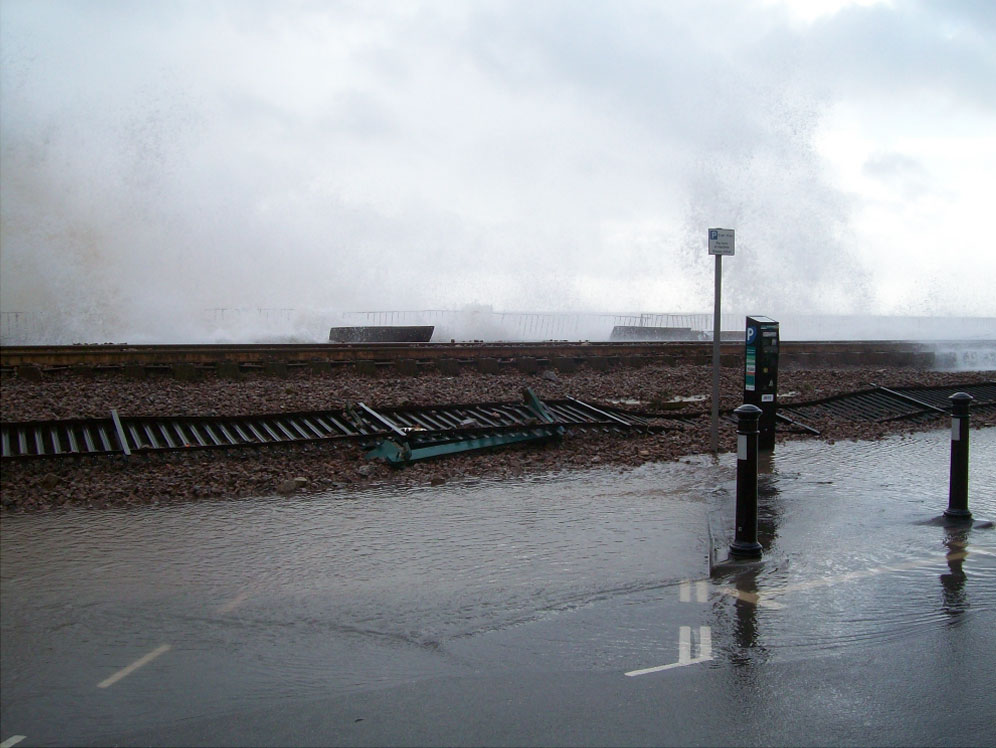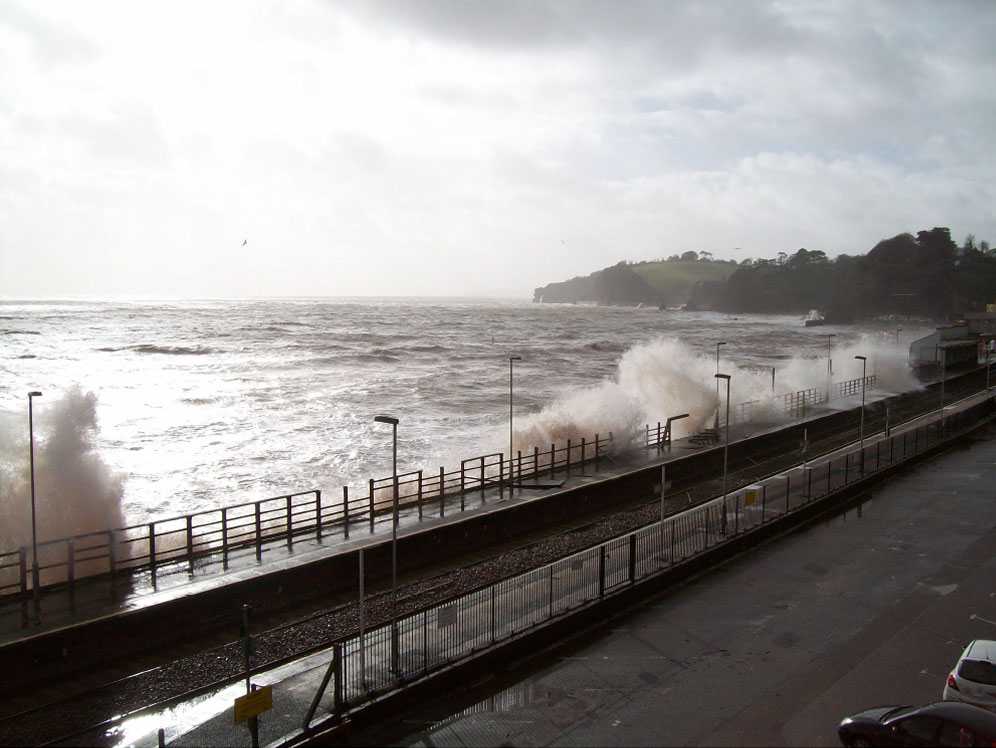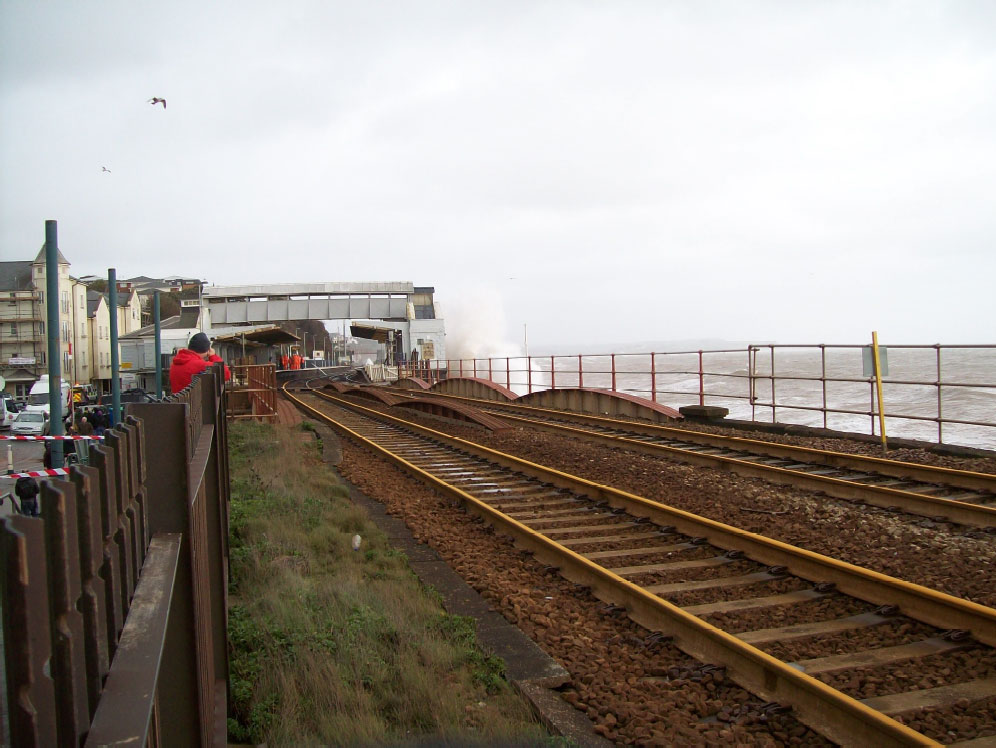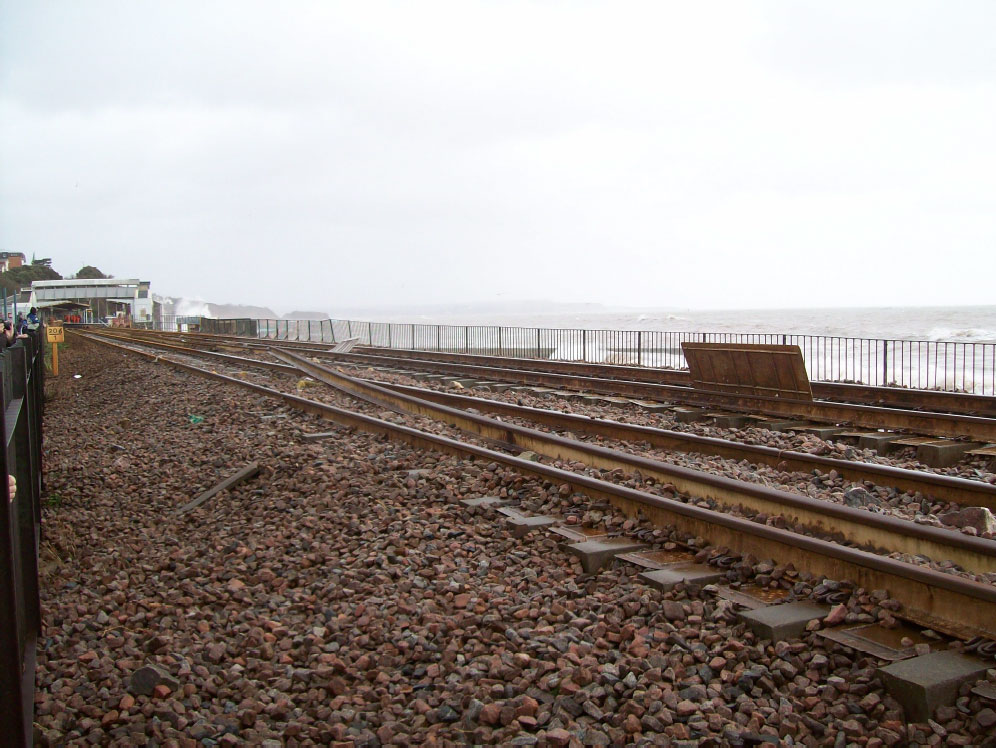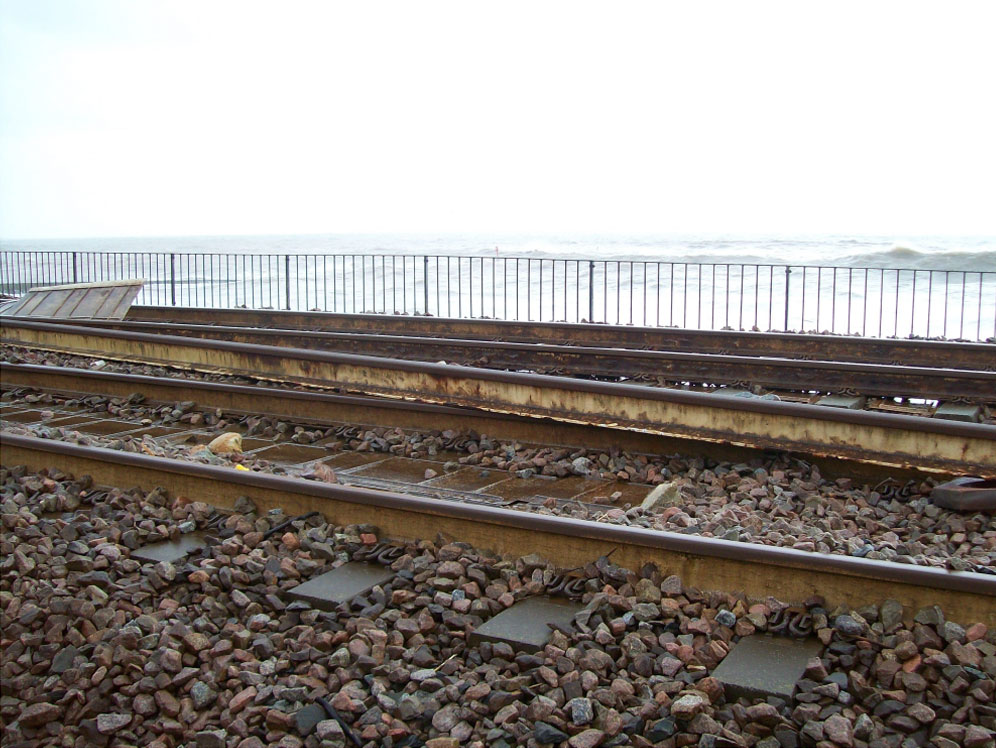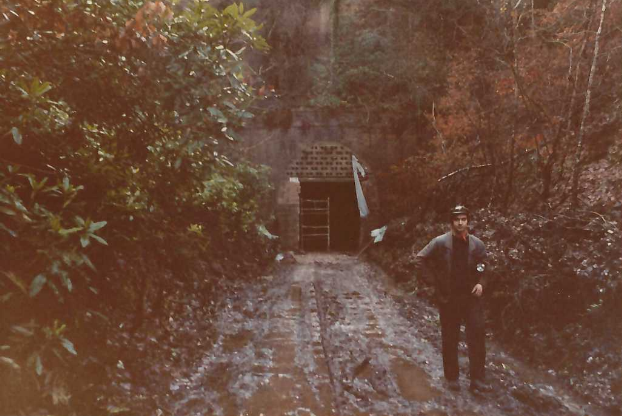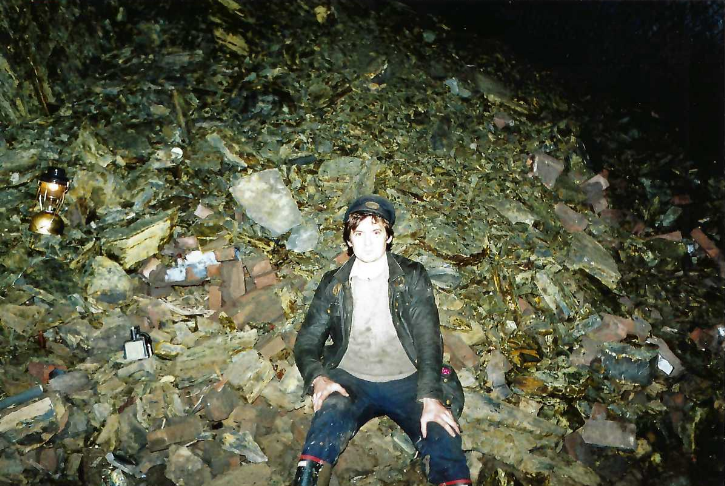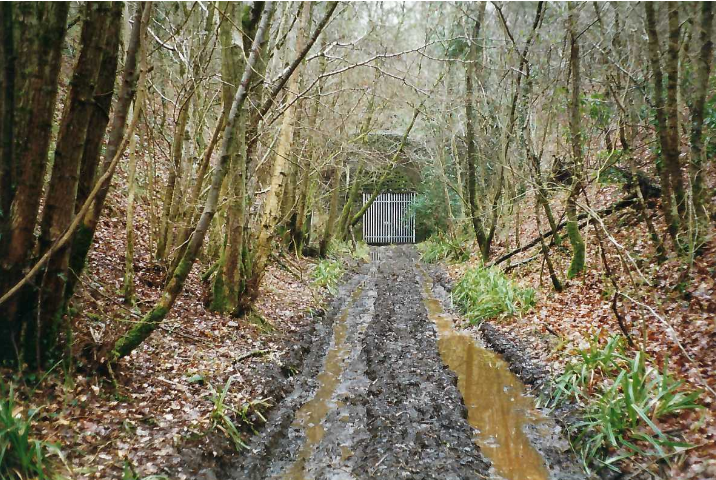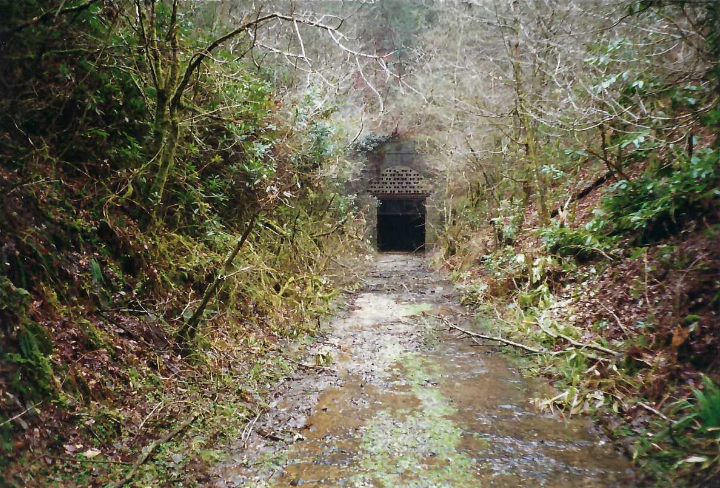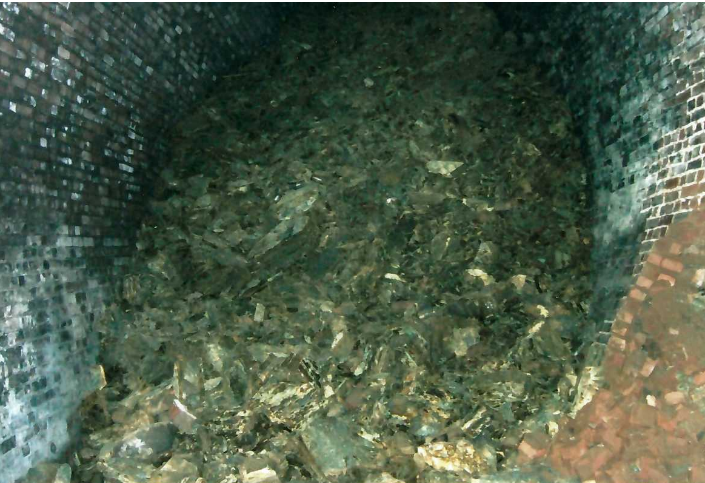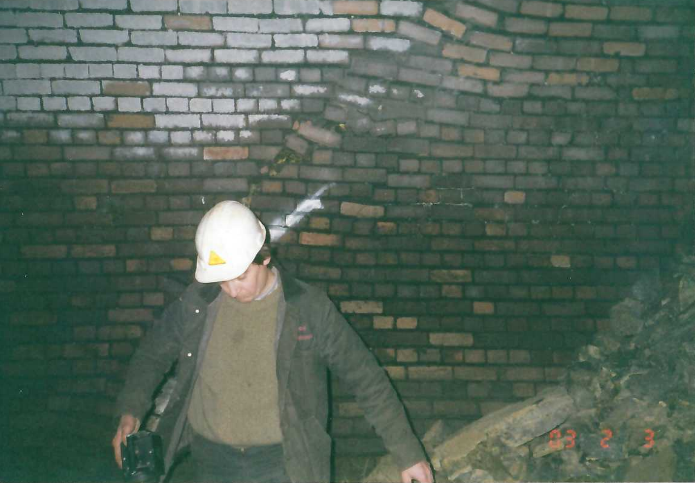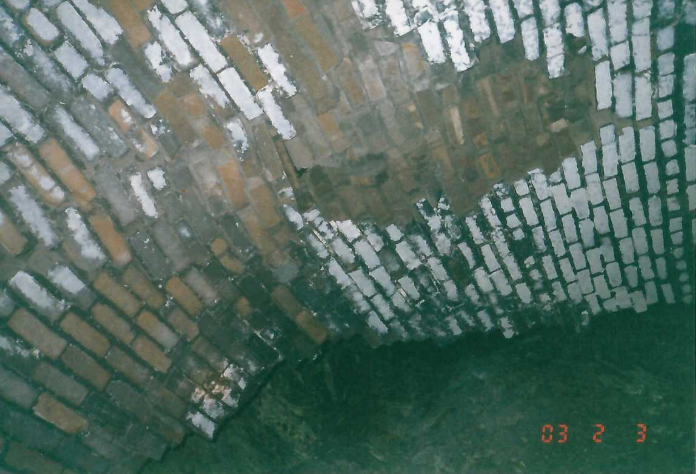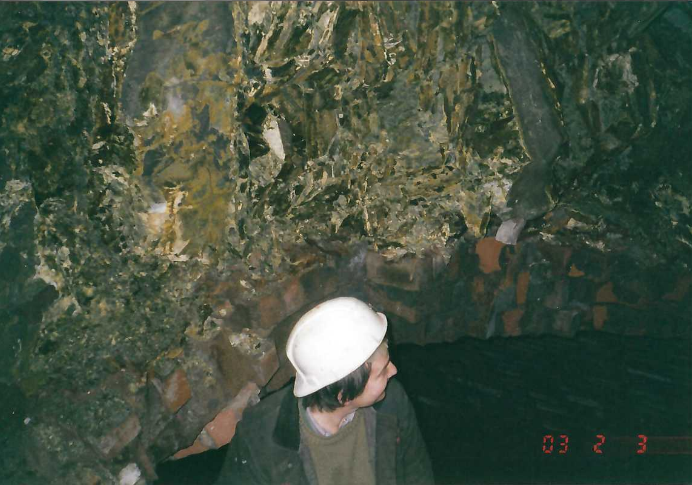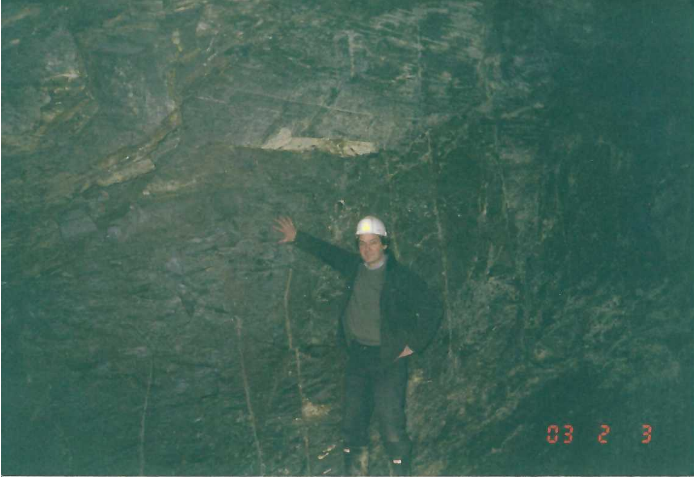Sequence of Coastal Main Line Chapters
Great Western Main Line West of Exeter Route Resilience Study
This was written before the Dawlish Débâcle in 2014:
The chapters above, with some additions, are collected in a PDF: Dawlish Sea Wall I
Events from 2018 to the present (April, 2024) are published only as a PDF: Dawlish Sea Wall II
>> Autumn Budget, 2021 >>
>> Dutch Reach >>
>> Transport Decarbonisation Plan >>
>> Roads Policing Review >>
>> Man with a Mission >>
>> Newton Abbot to Heathfield >>
>> Petit Petition >>
>> Moretonhampstead Station >>
>> Railnews >>
>> Drink-Driving: Still a Laughing Matter >>
>> Priority Transport >>
>> Tunnel Vision >>
>> Traffic in Towns >>
>> I'm only asking the state... >>
>> Dave Black - Vassal of the road lobby, yesterday's man >>
>> Gridlocked Devon >>
>> The Network Rail Roadshow >>
>> Lynton & Barnstaple Railway's Bid to Continue Reconstruction >>
>> Following the Débâcle … >>
 >> Great Western DNA Found >>
>> Great Western DNA Found >>>> The muddle of modern Italy compared with the splendour of Ancient Rome >>
>> Greens too green to govern? >>
>> Letter to Western Morning News, 4.2.15 >>
>> Heathfield Station >>
>> Devon County Structure Plan, 1995 >>
>> Fleabee - the lo-cust airline >>
>> Friends of Ashburton Station >>
>> Great Western Main Line West of Exeter Route Resilience Study >>
>> The costs entailed in keeping disused railways disused >>
>> The Dawlish Débâcle >>
>> 'Council leader wants remainder of Moretonhampstead Branch closed' >>
>> Letter to Western Morning News, 14.02.14 >>
>> Letter to Western Morning News, 21.02.14 >>
>> Letter to Western Morning News, 18.12.13 >>
>> B.R. ceases to be >>
>> Greenwall Lane Bridge >>
>> Letter to Western Morning News, 9.3.13 >>
>> Perridge Tunnel >>
>> Letters Appendix >>
>> Green Groups >>
>> Boots the Chemist >>
>> Rail Transport Services >>
>> And the traders—what do they care? >>
>> Stover Canal Society threatens railway >>
>> Marsh Barton, Exeter >>
>> Friends of the Atlantic Coast Line >>
>> Local Transport Plan, Three >>
There is something heroic but at once tragic in the claim that the E. & T.V.R. is unique in campaigning for a real railway: a system that is general purpose, expansive and deserving of much greater importance in the overall life of the country.
Many people show little interest in the world around them and have no idea what forces decide its makeup. The average motorist, for example, can imagine that the infrastructure and service provision that enables his free movement is the result of some great fortunate accident in an entirely natural process.
Those who choose to ignore, or are not aware of, the pressuring and machinations that are instrumental in bringing about so much of the structure of civilization and society, often rather resent being informed. It is perhaps in the nature of folk to feel peeved when introduced to a subject never before given any thought.
If any reason need be given why one form of transport should be championed loudly and boldly, it is because another has been heavily promoted behind the scenes, in the corridors of power, while playing on an easy attractiveness to ingrain itself in the minds of simple, unquestioning men.
The reader may go away and make enquiries but he will not find one railway, or what resembles a railway, that concerns itself with any more than its own restricted realm, be it territory or traffic. Not one of today's big industry players has a vision of an all-embracing national railway, now or in the future. Commentators only fix upon block freight and the hordes of passengers thrown up by a restless, growing population. A vast body of men who profess to support the railways, but who themselves happily subscribe to road transport at every turn, merely indulge in historical re-enactment or some such escapism.
There is certainly no power or influence remotely comparable with that of the Great Western Railway, one of the four big nominally independent companies to be nationalized in 1948. Given the management of the Great Western up until then, it is impossible to believe that such dynamism would have decayed, allowing it to watch its trading position being undermined and to capitulate business and capacity in the meek way that the state-run system went on to do, lacking the means to defend itself.
Had it continued, no devotee of the Great Western could bear to think of it becoming like a contemporary blue chip conglomerate, with cutthroat executives chasing and grasping market share, but if only some of this modern ruthlessness had been adopted, what a difference it would have made to the balance of transport in the succeeding years.
If it is understood that the road transport revolution went along with the decline of the railways, would it not have been harder to make the case for new roads, more and bigger vehicles and disintegrated development if a modern, sophisticated rail system had demonstrated that alternative expansion, with all its town and country despoliation, was not necessary?
Suppose the road protestors' best ally had been the railways, objecting to the unfair advantage being given to their competitors, demanding equal terms and advancing counter plans of their own. Imagine environmentalists having industry at their side in the form of transport operators not afraid to damn the opposition for its huge land-take, wanton energy consumption and degradation of human life and habitat.
It could be said that the whole rationale of the massive changeover to road transport depended on first destroying the railways, or so neutralizing their position that they could not compete or protest.
The railways had very little voice after government control was taken in 1939 and practically none after 1948, when the road lobby and its largesse attained supremacy. A faint, heroic cry was heard from Edward W. Burkhardt at the 1995 denationalization but he was quickly silenced. What hope was there that a fragmented industry, lacking pedigree railwaymen, led by a generation detached from history, would know what to say even if it could find a voice?
Must we always be monstered by the mass media?
When claiming that the E. & T.V.R. spokesman champions the railway as an industry lobby should do, it is understood full well that his words and actions make no difference. One man's carping from the shadows at the back of the hall can never be heard above the shrill choirs of the road interests. A lone rebel cannot counter the forces arrayed against the railway or make up for the weaknesses of its structures or the muteness of its adherents.
Proof that the Teign Valley voice, though faint, is unique comes from Sim Harris, Editor of Railnews, writing under the heading above in the September issue about sensationalist hacks repeatedly distorting the truth and poorly portraying the industry. After asking "who is speaking up on behalf of the railway?" he says:
"The rather grim conclusion is that there is no one—no organisation—which is willing to take the gloves off and speak assertively and authoritatively about the industry as a whole, without any wretched public relations 'spin' (such as when the DfT suddenly discovered that electrification was 'disruptive' recently).
"We don't need spin. We do need to speak loudly and clearly about the benefits of rail without dressing them up. And we do need to take on the critics on their own terms, and at their own level."
The Roadshow Continues
Four separate chapters in "Campaigning" tell the sea wall story after the disastrous débâcle of February, 2014.
The account was not kept up, which has resulted in all the events since 2016 being described together.
Two appendices contain the whole ten-year saga:
Dawlish Sea Wall I finishes with Network Rail's first roadshow at the Langstone Cliff Hotel in 2016. This contains the four published chapters with some additions.
Dawlish Sea Wall II begins with the public airing of the South West Rail Resilience Programme in 2018. This is only published as a PDF.

Autumn Budget, 2021
Unheeded advice to the Chancellor on transport investment
In September, followers of Transport Action Network were urged to add to the pressure on the Chancellor of the Exchequer to cancel the £27-billion "Road Investment Strategy II" programme and fund instead measures to advance sustainable forms of travel and transport.
https://transportactionnetwork.org.uk/tell-rishi-sunak-to-stop-funding-ris2/
As a token effort, the scribe, part he hoped of a dispersed team, picked up his pen, knowing that what he wrote would be scanned by some artificially intelligent device, made into a meaningless statistic and ignored.
"The desire to continue building roads must come from a belief that there will be like-for-like replacement of existing vehicles by electric ones and, fatally, that their number will grow."
The longstanding fixation with spending on roads to facilitate self-centred transport should have ended long ago, but politicians generally have never been able to see what lay beyond the "Great Car Economy." Now it has become doubly urgent that sustainable transport, in all its forms, is given every advantage, for the health of the nation and the good of the planet. Throughout the necessary revolution, it should be possible to "balance the books," but more important than this is the unaccountable human wealth that will accrue.
Infrastructure and Construction
Any fears that winding down the roads construction programme would mean less work and prosperity should be allayed by consideration of the vast potential that exists for expansion of the railway system, tramways and other public transport.
Coupled with the development of the support and supply industries, which this country once had in abundance, and a great easing of the regulatory burden that now artificially inflates costs, many more schemes could be pursued. These would bring great long term benefits to the population and advance the present environmental imperative of ending the subservience to "Big Oil."
Manufacturing
Instead of devoting enormous resources of labour and materials to the churning out of what has become the most wasteful consumable, the private motor car, a transition should be made to a manufacturing economy that enables and encourages production of much longer lasting, better designed and built, vehicles of all kinds, chiefly trams and buses.
A consistent and continuous programme of railway electrification would stimulate exporting industries, as well as providing a low energy transport spine, essential if the country is to meet its carbon reduction aims.
Transport Spending
The ridiculous roads programme, Road Investment Strategy 2, could have been lifted straight from the pages of a 1970s policy document, when transport spending was dictated by the roads lobby, despite it having been understood for many years that "suppressed demand" would lead to more and more traffic filling new roads.
The emphasis now must be on reducing motor traffic, whether propelled by oil or electricity; reducing the need to travel where possible, by such means as fully-functioning neighbourhoods; greatly increasing travel by public transport; and making safe and attractive so-called "active travel," which would lessen the strain "sedentary" illnesses put upon the N.H.S.
The desire to continue building roads must come from a belief that there will be like-for-like replacement of existing vehicles by electric ones and, fatally, that their number will grow. All new road building must now be curtailed, a move the Welsh Parliament has made, and the processes reviewed according to prevailing environmental standards.
Transport Taxes
Buchanan famously stated in his 1963 report: "Except for the smoking of tobacco or the drinking of alcohol, there is no way of laying out the citizen's money that has proved easier to tax than the owning and using of motor vehicles."
While seemingly never tiring of this, motorists bleat about the injustice while overlooking that the cost of motoring has actually fallen, aided by reductions of tax and duty. The notion that choked roads are an indicator of a thriving economy must end because it is at odds with the new environmental awareness. The physical and societal damage done by motor transport must be recognized and undone. Nothing will be achieved if tax incentives to electrify the road system lead to the same congested roads.
Taxation of electric vehicles, which soon will be all that can be bought, should be introduced immediately, both to curb growth in ownership and encourage use of genuinely benign modes. Equally, for the remainder of the life of oil-driven vehicles, the Fuel Duty Stabiliser should be reactivated.
Neither lorries nor freight trains have to bear their full "track costs," but hidden subsidies favour road freight far more, operators of heavy vehicles paying practically nothing for the wear and damage done to public roads, which is out of proportion to the weight imposed.
Air Passenger Duty must remain and be at a sufficient level to persuade domestic and continental fliers to use surface public transport. Aviation fuel should be taxed at the same rate as DERV to dampen demand for the most polluting form of transport.
Tax relief or grants should be given to firms or individuals wishing to substitute the likes of cargobikes and cycle rickshaws for conventional vehicles.
November, 2021: Four days before world chieftains and their entourages flew to Glasgow for a fortnight of prattle and waffle about climate change, the chancellor delivered a budget that made not so much as a nod to what briefly took over from the plague as the most pressing emergency of the day.
After a period of almost unprecedented peacetime expenditure, helping to keep nine million workers on gardening leave, propping up failing businesses and dishing out supply contracts with gay abandon, the chancellor dared not cause a rise in the cost of living and so decided to continue the eleven-year freeze on fuel duty and effectively cut the tax on domestic flights.
It was surely only a technicality that he cut the roads' budget from £27-billion to £24-billion, as the thrust of the budget was "business as usual," with the excuse, "I don't know what else to do."
Dutch Reach
Review of The Highway Code
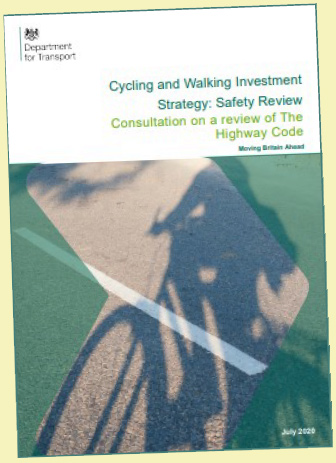
Happily continuing the legislative lag between the senior form of transport and the rude pup, Department for Transport and its predecessors overlooked the countless deaths and injuries of vulnerable road users, the blighted and stunted lives, the lives that might have been, and all the concomitant misery and misfortune, and finally, in the year of the great plague, with many suddenly rediscovering foot and saddle, or so-called “active travel,” as a permitted escape from house arrest, decided that some effort should be made to improve safety.
The review of The Highway Code is better late than never, the scribe grudgingly will admit.
Remarkably, the Department consulted widely with concerned groups such as Living Streets and Cycling U.K., resulting in long overdue suggested revisions to the Code which are as favourable to pedestrians, cyclists and horse riders as it is possible to be under the present system in one advance.
The principal change would be the establishment of “a hierarchy of road users which ensures that those users who can do the greatest harm have the greatest responsibility to reduce the danger or threat they may pose to others.”
Perhaps a hierarchy of responsibility would be better than a hierarchy of road users, for the aim should be equalizing, not dividing, individuals.
“Presumed liability” has been enforced in all but five European countries for some years, so what is proposed here is typically a very late corrective measure.
An item in a newsletter from Roadpeace, one of the charities consulted, alerted the scribe to the opportunity to respond, which was open from late July until late October, 2020.
"...in the present state of motor traffic I am persuaded that any civilised system of law should require, as a matter of principle, that the person who uses this dangerous instrument on the road dealing death and destruction all round should be liable to make compensation to anyone who is killed or injured in consequence of the use of it. There should be liability without proof of fault. To require an injured person to prove fault is the gravest injustice to many innocent persons who have not the wherewithal to prove it."
Lord Denning, 1982
A novel safety tip was revealed under “Waiting and parking.” “We are recommending that a new technique, commonly known as the ‘Dutch Reach’, is introduced to this chapter. This advises that road users should open the door of their vehicle with the hand on the opposite side to the door they are opening. This naturally causes the person to twist their body making it easy to look over their shoulder and check for other road users. This will help to reduce the risk to passing cyclists and motorcyclists, and to pedestrians using the pavement.”
This of course would apply to the driver and his passengers on both sides of the vehicle. The pavement may also be a cycle path.
Roadpeace published copies of its own responses but the scribe confined himself to “yes” and “no” answers, merely adding some final comments.
Rule 67: Half a metre is scarcely enough safe clearance from a parked vehicle, even if occupants opening doors exercise the “Dutch Reach.” Without this precaution, 0.5 metres is quite insufficient.
The existing general ignorance of The Highway Code comes from most motorists never having referred to it again after their driving tests. None of the long overdue changes can have any effect unless they are widely disseminated through public information broadcasts, advertisements, targeted social media messages, etc.
A very great help in this regard would be examples of the new rules being applied in real situations.
By far the greatest delight for the scribe will be seeing these alterations enacted for the good that they must do; but he will take some pleasure from hearing the squealing simpletons of The Lost Valley, who think of cyclists - or really anyone not behind the wheel of a Wankmobile - as "road vermin" or "morons," when they discover that their carelessness and callousness will hurt them.
"It may come as a surprise to many to hear the UK is probably the worst place in Europe
for a cyclist to be injured by a motorist."
Richard Gaffney, Principal Lawyer, Cyclists' Touring Club
https://www.slatergordon.co.uk/newsroom/cycling-accidents-and-presumed-liability-uk-vs-europe/
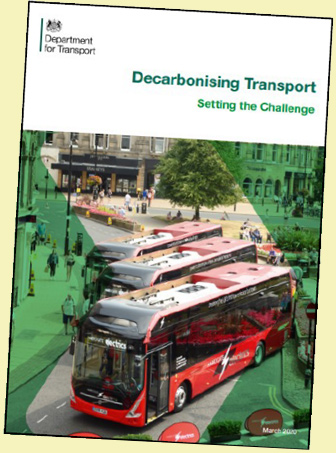
Transport decarbonisation plan
A call for ideas from a department that has long ignored them
In July, 2020, came a prompt from Campaign for Better Transport: "How to shrink transport's carbon footprint? Have YOUR say."
The Campaign suggested some answers but the scribe chose to have a go at the dopey department using his own words.
What should be done to reduce the greenhouse gases that are produced from:
Cars?
Out of exasperation with the rising cost of rail electrification, rightly always seen as the apogee of a powered transport system, government has effectively fallen to electrifying road vehicles, as if this were a simple answer. But replacing 30-million oil-powered vehicles with battery-electric equivalents would unleash possibly worse environmental damage overall and would do nothing to relieve traffic congestion and a host of other problems caused by the general over-dependence on motorized road transport. Vastly reducing the number of cars is needed, not just to curb greenhouse gases, but to deal with other environmental degradations, not least of which is the extravagant consumption of materials.
Passenger Rail?
What should have commenced, at the latest, in the 1930s and been completed in the 1970s, electrification of the rail network, would have provided a spinal transport system that could have run on any fuel and positioned the country well to face, or perhaps avoid, environmental challenges like the one in view. Nothing represents government failure more than the crackpot "bi-mode" train, which is sure to be used as an excuse to curtail electrifying the network. Ultimately, the least damaging and best form of passenger transport over land is the electric train.
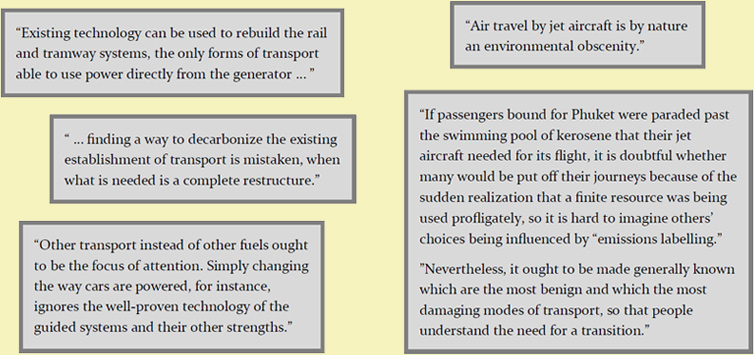
Q18. What other views do you have on how to decarbonise the UK transport network?
As with electricity generation and food supply, it should first be established what is actually needed. If waste were eliminated and efficiency concentrated upon, the question would remain: Where and how shall they be obtained?
Cheap oil is responsible for setting the whole world in motion, with the result that people and goods move under power far more than is good or necessary.
If there is to be a revolution in transport provision, tackling pollution on its own and attempting to perpetuate at all costs the great car economy is the wrong approach: far more needs to be done to reduce the need to travel and for goods to be moved.
Zonal planning, which has caused excessive movement, or designed-in unnecessary movement, through such abominations as out-of-town shopping centres and sprawling housing estates, should revert to the high-density mix that had evolved before the car made mobility a curse. Homes with space for two cars, and offices and works with enormous car parks, make everywhere bigger and more dependent on road motor transport.
As many people as possible should be absorbed by public - or "shared" - transport, and this should take more forms than it does now and be less regimented.
Q19. Any other comments?
The motorist's demands that he drive wherever and whenever he wants, as far and as often as he likes, in this crowded island; that he park his car in narrow streets in ancient towns and cities, and in the most exquisite countryside; that all else get out of his way; that enough road space materialize, as if by magic, to meet his and many million others' needs; these demands, often dictated by his actions, are an absurdity.
Yet it is this demanded "freedom" that government has spent a hundred years facilitating at every turn; bowing slavishly to vested interests; believing it to be the only path to economic growth; being fearful of disregarding the public's childlike clamour; and of course happily milking the tax cow. Even as government sets about decarbonizing transport, the road construction programme does not falter, as if the future can hold only more of the same, but battery powered.
The modes that today are needed are the ones that over the same period were allowed to wither, often as a price to be paid for a motoring utopia. Buses and trams were lost; walking and cycling became less popular and more hazardous. The greatest damage of all was done to the railway system, which, if it had been allowed to make the difficult metamorphosis from the steam age, promised to become a vast, modern network operating in its own reservation, able to move large numbers of passengers and great quantities of goods in all directions, by night and day, under all conditions. It was one of the country's greatest assets—a British birthright—which could have set the whole course of transport development.
Instead of making this possible, the railway was undermined and, in great part, destroyed, by continual acts of sabotage; a quarter-century of chaotic denationalization, spent rediscovering that unified railways work best, is just one example; the advice this year to "use your car, not public transport" could be the latest.
Never with any real vigour were the disbenefits of private motoring and trucking tackled. Those who chose, or had no choice but, to walk or cycle or use public transport have been hugely disadvantaged. Air pollution is reckoned to kill as many per year as the plague has done this year, and with less discrimination; the great health time bomb, obesity, brought on by inactive lifestyles, will probably kill more in time, yet these crises do not cause stoppages.
A pair of boots; a humble bicycle; an omnibus; a lightweight van; a tramcar; a tub on a man-made waterway; a pair of rails to make the energy go further and a wire above to collect juice made from wind and sunshine; they are all staring at the Department for Transport, but the department whose crowning creation is the utterly hellish road system asks the public how to decarbonize transport.
Response to Transport Decarbonisation Plan: call for ideas
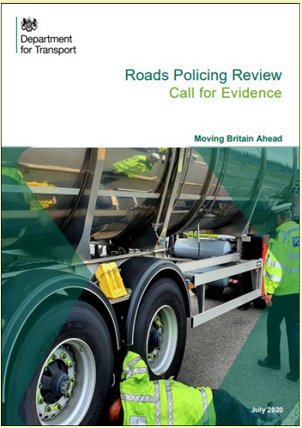
Roads Policing Review
Call for evidence
Richard Martin, the Police and Crime Commissioner's assistant, kindly wired on 13th July, 2020, inviting the railway to make a submission to the review before the closing date of 5th October. This was the first of a rush of consultations in July.
The Foreword begins: "Great Britain has some of the safest roads in the world but there is no room for complacency and this government is committed to making our roads even safer." But the Department for Transport is concerned that "since 2010 we have seen a plateauing in the number of people killed and seriously injured on our roads after years of steadily declining numbers."
If there were five fatalities and 68 serious injuries every day on Britain's railways, as there are on Britain's roads, or even casualty figures relative to the share of traffic, the scribe cannot help but wonder whether it would have taken ten years to think about a review.
Here is an extract:
Current offending behaviour
The railway provided brief answers to 14 questions.

Man with a Mission
Should anyone detect a missionary's zeal in the themes on these pages, there may be some hereditary explanation. My grandfather on my father's side, Revd Richard Burges, was General Secretary of the India Sunday School Union in the years when it was seen to be the duty of the church to convert heathens throughout the empire to Christianity.
Legend has it that a telegram once reached him addressed simply "Burges, India." While letters have found me with only the vaguest idea of my address on the envelope, it has to be admitted that "Burges, Teign Valley" hardly compares with a subcontinent.
My grandfather I feel got the better posting. He was supported by the British Sunday School Union and received gifts from the non-conformist philanthropists, W.D. & H.O. Wills, who may not have approved of the anti-smoking campaign he conducted. He lived very comfortably and a great number of natives was receptive to his teachings.
Trying to bring civilization to the unguided of the Lost Valley through the agency of rail transport, unpaid, is utterly dispiriting. At least savages had the decency to put missionaries in the cooking pot; here the bringers of enlightenment are just ignored by the apathetic and detached, wedded to cars and material consumption.
A pamphlet, "Our Sunday Schools, Their Achievements & Possibilities," found on the electronic babel, has allowed me to read my grandfather's words for the first time. It is a paper read before the Calcutta Missionary Conference in 1898, the year my father was born in Darjeeling.
Naturally, I was curious to know if any writing characteristic had come down the line, even without contact; my grandfather died in 1947. There is none, except perhaps a weakness for alliteration. I found "no lady of title or talent." And "The India Sunday School Union is already crippled for the lack of lakhs, but its troubles would increase if each of our seven thousand teachers claimed financial payment for his work."
Today, I would risk arrest and imprisonment if I were to use language such as: "THE HEATHEN PRINTING OFFICES ARE FLOODING THE COUNTRY WITH LITERATURE FOR CHILDREN." However, substitute "roads lobby" for "heathen" and it could be a refrain of mine. And, especially with a railway fraternity that needs sparking into life, I would have every justification in using the pulpit cry my grandfather added: "SHALL WE LOOK ON AND BE IDLE?"
Revd Burges asks: " … what more spiritually invigorating to many who are dying of soul-inanity than an hour spent in building up a Sunday School … ?" Dying of soul-inanity, eh? He was fortunate that he did not live to get sucked in by the infantile, banal and often uncouth posts on the Lost Valley's Mughook pages.
"The drink is a hydra-headed monster which it is the duty of the Church to strangle," were not his words, but it was clearly his thought. I confess to some ambivalence towards liquor but in one regard I leave no doubt, made known in "Drink Driving: Still a Laughing Matter."
"India is a country without a Sabbath. The big wheel of activity rushes on without a rest. On the river and on the railroad, in the mill, and in the street, in the field and in the family we see ceaseless toil all round the year."
The passage above and "if gospel bells are to ring out over this cheerless heathen land" could have come from a writer about modern Britain. C.B.
https://archive.org/details/oursundayschools00burg/mode/2up
The India Sunday School Union, founded in 1876, is still going strong.

Newton Abbot to Heathfield
The remnant of the Moretonhampstead Branch and once part of a diversionary route
The most recent attempt to make some use of this four-mile line, dormant since the last train traversed it in 2015, has come from Heath Rail Link, formed in 2017 as the Newton Abbot to Heathfield Railway Revival Group.
This is the third in the last ten years to have landed upon the line, which at first looks as if it could offer a comfortable home to preservationists or be developed as a functional public transport operation, or both.
The report appears under "What's New" because the railway has stepped back from deep involvement, convinced that no project like this can be advanced in any worthwhile way under present conditions.
If the near five hundred "supporters" on Heath Rail Link's Mughook page were to pay a subscription to Railfuture, or send a donation to Campaign for Better Transport, or form a pressure group of their own to agitate locally, this may still not bring results but it would surely do more good than chattering about reopening a short, residual line which would make little sense on its own and is beyond the capacity of any power but the state. That "supporters," for the greater part, resolutely do not subscribe or donate or take part in debate about the wider issues, actually suggests that they are not much interested in the provision of practical rail transport.
The only action that warrants inclusion here has been a message to Bovey Tracey Town Council, which it was hoped would bring a measure of realism to the exchanges.
Appendix: Message to Bovey Tracey Town Council
The last train to tread the metals passing Teigngrace: https://youtu.be/6zFpOyefoQ8?t=219
Heathfield - Newton Abbot Community Rail Project
March, 2020: Teignbridge District Council has submitted a bid to the "Restoring Your Railway" fund.
Petit Petition

To: Chris Grayling, Transport Secretary
It was not the railway's idea to start a petition calling upon a government minister to order a thorough appraisal of diversionary routes. The prod came from campaigning organization 38 Degrees, reacting to one of many news reports about train service disruption on the coastal main line.
A wire was received from the organization's Kieran Maxwell suggesting that someone should set up a petition. This can hardly have been computer-generated, although it may have had an element of automation. It must have stemmed from human initiative, from someone picking up local news stories to see if any would warrant a campaign being started.

While not imagining for a moment that there would be any meaningful result, the approach was considered worth acting upon, if only as a test.
The campaign page was headed "Railway Diversionary Routes," and called upon Chris Grayling, Transport Secretary, to "Engage an independent consultant to examine and cost the reinstatement of former railways which connected Exeter with Newton Abbot and Plymouth, and which provided diversionary routes when the line through Dawlish was closed."
In the box marked "Why is this important," was entered:
"No amount of money spent on the coastal route will make it invulnerable and arguably some of what the fantastic schemes being proposed would cost should be spent on route diversity.
"Rail passengers will accept being diverted in an emergency because they remain at their seats and know how much longer their journeys will take."
The next step was to send messages urging individuals or members of groups to sign the petition, a mere matter of two clicks.
Now, there are some issues which excite people to the extent that a call to action quickly has large numbers responding. Once word went around of a petition concerning one of these issues, a runaway effect would have each person signing getting another, or two or three more, to add weight, and so on.
Railway supporters are not like this. While there were more signatures than messages sent, it is clear that few, if any, were able to propagate the campaign by mobilizing a list of contacts; some messages did not even result in a signature. The scribe has the petition but it will not be published.
The group representing those most likely to benefit from a reinstated Southern diversionary route, Okerail, seemed reluctant to carry the post on its Mughook page, any move by the Teign Valley, or other outsider, seemingly being viewed with suspicion, and the response was all of nothing.
By way of an agent, a post was made on the Teign Valley Mughook pages, subscribed to by over thirteen-hundred locals who revel in having an outlet for their banal chatter.

To most, the reinstatement of the branch railway looks like an impossibility and therefore little thought is given to the idea. Yet such reinstatement, even in a basic, modern form - that is without staff or facilities at any intermediate station - would be the most lavish provision of infrastructure imaginable in this lost valley, carrying with it the power to widen transport and travel choices for a great many.
Of course, there would always be those who insist that the railway would do little good, or no good at all; that few people would use the local services; and that its value as a diversionary route would be minimal, not worth the cost of providing it. Some, justifiably, would be concerned about the environmental damage or disruption.
Naturally, proponents of railway expansion will claim that while there will often be undesirable results when any great scheme commences operation, the overall effect of railway reinstatement would be greatly beneficial, a result that all previous examples prove without doubt.
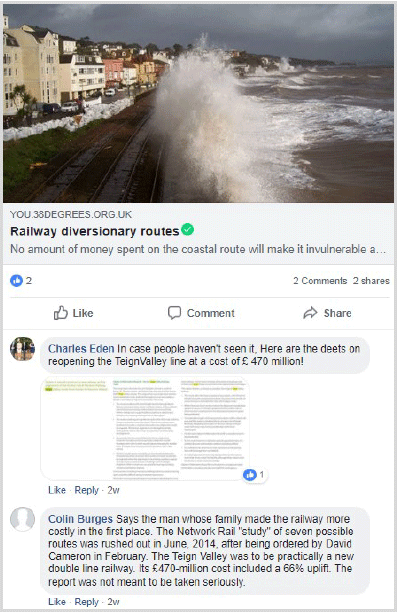
And to the environmentalists, whose concerns the railway industry, as both promotor and provider of sustainable transport, would give the utmost attention, it would have to be stressed that reconstruction would be far less disruptive than building a line where there had not been one before.
Even allowing for the Teign Valley intelligentsia not being represented on the Mug pages, the post should have generated some discussion; far less important subjects often attract lengthy outpourings of bile and misinformation. Some sign of life, at least, may have been shown by talk of reviving the Teign Valley Action Group* if ever railway reinstatement became a serious prospect; or by a threat to derail the first train; or by a young blade declaring: "We don't want none of that buplic transport ere."
On this occasion, out of the more than one thousand, three hundred subscribers, whose pap and prattle generally fills the page, how many were persuaded to sign the petition? The answer is three.
The post attracted only one comment, from the man whose father, a successor of the original owner, paid a pound for it when a mile of the line was sold off after closure.
A deep well of support should have been found in the group hoping to revive the disused line from Newton Abbot to Heathfield, the remnant of the Moretonhampstead Branch and part of a former diversionary route. Well over 400 people have been admitted to the Mughook page, Heath Rail Link, and so a post was made there.
It succeeded in adding a few more signatures to the petition but also brought forth the usual damp squibs. It is strange that men who subscribe to a group with the aim of restoring a passenger service between Newton Abbot and Heathfield, would rather engage in pointless argument about detail and pour scorn on anyone who dares to think expansively, than simply sign a petition, which was deliberately plural in its title.
Most of the Mughook exchanges are reproduced in the following appendix. The carping tongues who took the time to compose numerous posts, could not be bothered, or wilfully refused, to make two clicks in support. The scribe had decided once before that Mughook was a useless campaigning tool. His thoughts were boxed in the Friends of Ashburton Station story. Foolishly, he returned; this time he has left for good.
Appendix: Mughook Comments about diversionary routes
Though the failure of this petition to attract even three-score signatures does not matter, it is telling of a malaise which infects the railway camp. Out of the thousands and thousands of people who profess an interest in railways, only a very small number joins campaigning organizations, whether the national Railfuture or local, specific-interest groups. Even among those who are active, there is often a woeful lack of ambition. The firm belief among middle-aged men that most movement will evermore be cars of some kind on the roads and that the railway network and its minimal functions can only grow incrementally, is hard to unseat.
Environmentalists who look to railway people, both within and without the industry, to put flesh on the bones of broad ideas of what railways should be doing and where they should be going, often do so in vain; the Mughook miseries mentioned above would more than likely smother them with a wet blanket. Anyone who looks to industry players to take the lead quickly finds that most managers and executives have little use for the system they control, scant knowledge of its historical development and no understanding of the vastly expanded role the modern railway could fulfil.
It was thought that maybe a few hundred would sign as a show of solidarity, but the total when the petition, out of embarrassment, was taken down stood at fifty-seven; God bless them.
If every member of every West Country rail user group, society and organization, including railway staff, were to have signed, it would still not have made a petition worth presenting to the minister. It is doubtful whether even a petition signed as well by every Teign Valley resident and those of Mid Devon and North Cornwall, and everyone who may at a stretch benefit from reconstruction of the former diversionary routes, would have had any effect whatsoever, such is the sparsity of population.
Fifty-seven loyal souls signing a petition may be a poor showing but it is still more energetic than the loose assembly that substitutes today for a rail industry, which, lacking voice and vision, has shown no interest at all in reopening the diversionary routes.
* Teign Valley Action Group was formed in 2000 to oppose plans to reopen Ryecroft Quarry.
Moretonhampstead Station
Housing development proposed where trains must in future go
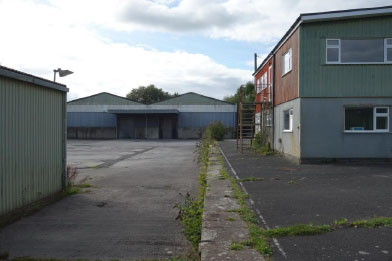 In March, 2019, a planning application was submitted by Baker Estates Ltd., on behalf of B. Thompson & Sons (Transport) Ltd., for permission to erect 40 dwellings on the site of the former terminus.
In March, 2019, a planning application was submitted by Baker Estates Ltd., on behalf of B. Thompson & Sons (Transport) Ltd., for permission to erect 40 dwellings on the site of the former terminus.
The haulage firm that has occupied the station for most of the years since the line was closed, has restructured and now only needs the "town" end of the site, making redundant the area where the goods shed and part of the passenger platform still stand.
The railway has objected to this application, as it did in 2001 when permission was sought for 80 homes on the whole site. On the earlier occasion, the National Park Authority had fielded several subsequent applications, with the number of dwellings reducing to 51, and the matter was not concluded until 2004 when the Inspector's report on objections to the First Review of the Local Plan ruled that it was "much too premature to contemplate losing the employment use of even a proportion of the site."
" The sudden emergency which has been creeping up on us in full view for fifty years... "
In July this year, the authority was anxious not to be at fault when the call goes out, "Right, who hasn't declared a climate emergency?" For good measure, the committee resolved to declare a climate and ecological emergency.
Like all the other posturing from piddling parishes up to Whitehall, it is a quite meaningless move, based on the belief that, unlike other emergencies, this one can be dealt with by the least action: a long series of minor adjustments, when the situation, if it is as bad as is being made out, demands nothing less than rapid phase change.
It is like the self-professed conscientious soul disregarding the 50,000 gallons of kerosene he may be sitting above on the airport runway and later getting worked up about the one-use plastic straw brought with his in-flight drink.
In this case, the reality is that the authority will have no choice other than to grant permission for the development and thus obstruct the return of the railway to Moretonhampstead with miserable, volume homes, the majority of whose occupants will drive cars practically everywhere they go for work and play.
There were once 31 stations on or around Dartmoor; now there is but one. The Draft Local Plan, 2018-33 (in October, 2019, being prepared for examination by the Secretary of State) contains half a page on rail transport, with not one action proposed. "Electric Vehicle Charging Points" are given a page, resignedly accepting perhaps that the only answer is to use electricity to perpetuate the established disorder.
Without any guidance or mandates from government, even if there were a free-thinker who had managed to slip the manacles of the motor car, it is not for a cosy little authority like Dartmoor National Park to make a stand. If it had tried to be bold in the last Local Plan and insisted that the only development that would be permitted at Moretonhampstead Station would be the sort that could easily be adopted or displaced by the return of rail transport, the policy would surely have been struck out by the government inspector on the grounds that it would amount to "planning blight," there being no prospect in his view of the branch line being reconstructed from Heathfield.
An example of phase, or step, change would be some move towards rebuilding the railway system as part of a general revival of public transport. Even if, in the case of places like Moretonhampstead, it meant only a halt to the loss of what remains, it would still be a start.
Appendix: Letter of objection to the National Park Authority
Appendix: Letter of objection, 30th March, 2001
Appendix: Letter of objection, 13th August, 2001
Appendix: Letter of objection, 26th February, 2001
December, 2019: A new application was submitted for 35 dwellings, including three in the retained shell of the goods shed. Simon Hickman of Historic England had been good enough to write a personal objection to the loss of the goods shed, so perhaps his opinion helped to sway the developer.
As objections by the railway are made for the record, for a future unrecognized by planning policy, one will not be submitted on this occasion; there is also another consideration which will be revealed later.
A message was sent to the Parish Council, politely asking why railway reconstruction had not been mentioned in the council’s submission. A prompt reply was received which stated that “the effect of this development would only be to move the terminus 100yards down the line.” And: “The consultation period has closed, and we have already sent our comments.”
What will the Town Elders say when Thompson’s apply to develop the remainder of the station? And councillors should know that in practice comments are accepted until the case officer writes his report to the planning committee and that very late submissions are sometimes read out at the meeting.
The council was obviously not united in its view of the development because the chairman of the parish planning committee who signed the letter of support, dated 22nd January, the same day wrote to object on his own account. He did not mention railway reconstruction.
Appendix: Correspondence with Moretonhampstead Parish Council
Appendix: Personal Objection by Parish Councillor
March, 2020: Incensed by the report to the Development Management Committee containing no proper reference to the railway terminus, despite repeated appeals in the past that such historical installations be named, the scribe could not resist wiring some last-minute caustic comments at the case officer.
It is quite an accomplishment to write 32 pages about proposed development at Moretonhampstead Station and not once mention Moretonhampstead Station.
You do refer to the former railway and its remaining buildings but "Land at Station Road" hardly recognizes the original function and the one which dominated for nearly a hundred years.
Preserving a bit of the fabric treats the place as a transport curiosity with no relevance to the modern world. Yet, had there been a balanced approach to transport after the war, the branch line could well have remained open, leaving Moretonhampstead today as one of Dartmoor's gateway stations.
Twelve miles up the line, Teignbridge District Council has just submitted a bid for a grant from government's "Restoring Your Railway" fund, proposing to reopen to passengers the remnant of the branch from Newton Abbot to Heathfield. If this were to be successful, in changing times would future extensions to Bovey and Moretonhampstead be so unthinkable?
On Friday, with no choice but to do so, members of the authority will nod through a lousy-looking enclave housing estate with its 83 parking spaces, a development at the former terminus which incorporates no new thinking and most likely will be populated by people who will drive everywhere - even to the town - and have no sense of "place."
Last week, in Bristol, Greta Thunberg finished her speech to 15,000 excited followers with: " ... change is coming whether you like it or not."
Heaven forbid that it reaches the cloisters of Parke.
At the Bovey waxworks on 6th March, members followed the officer’s recommendation and nodded their heads in approval.
It's been too long since the scribe's Latin lessons for him to translate what could be the national park authority's motto, so, rather than cheat, here it is in our tongue:
We don't listen, we don't learn and an original idea has never entered our heads.
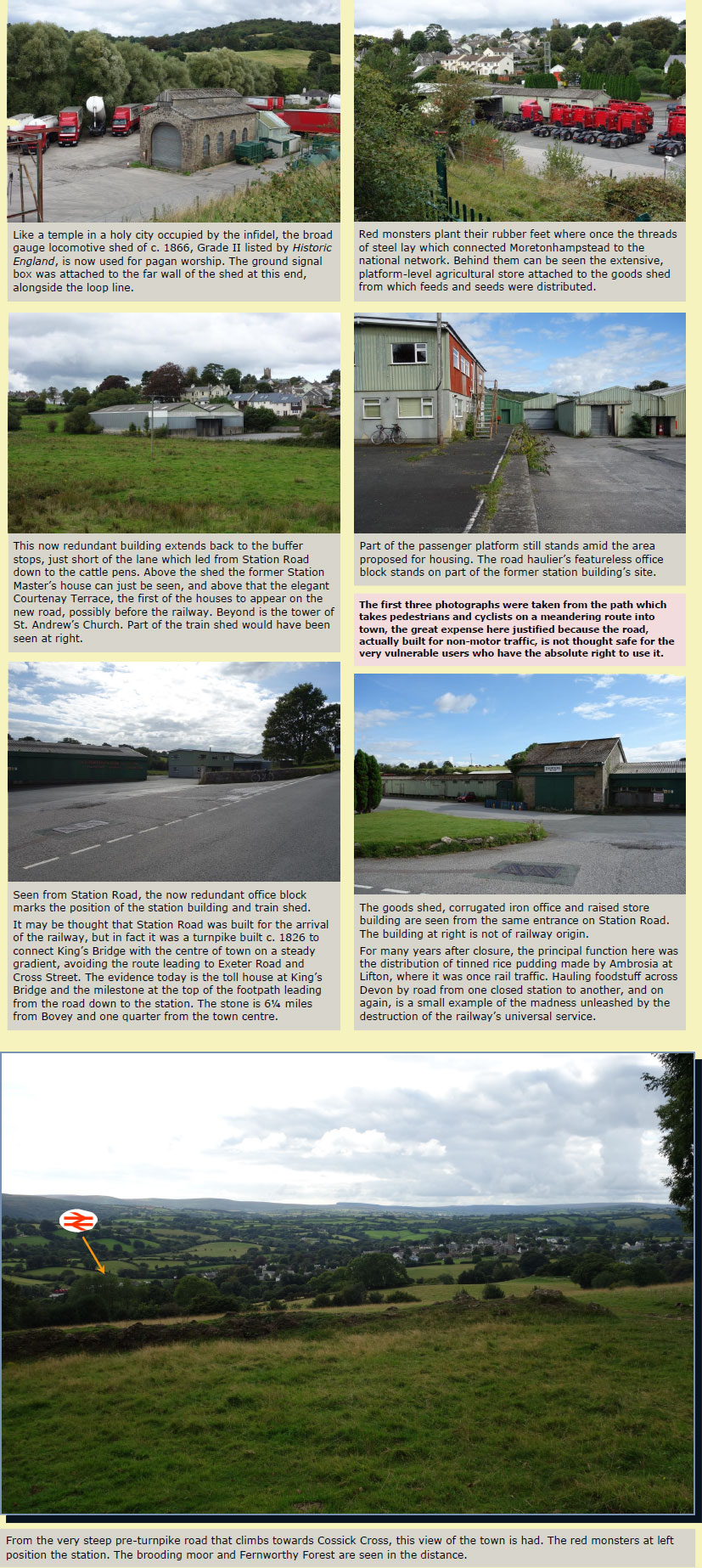
In December, 2019, the railway wrote to B. Thompson & Sons, asking if the corrugated iron hut next to the goods shed could be taken away and re-erected at Christow.
Ryan Thompson, Director, was kind enough to reply and said that he had forwarded the letter to Tom Biddle, Development Manager at Baker Estates. He added: "It's nice to think of preserving this little piece of heritage, if possible.
"The scribe telephoned Mr. Biddle on 18th. He advised that a new planning application had been submitted and promised to contact the railway when appropriate.
The application was approved on 6th March, 2020, and Mr. Biddle was telephoned again on 17th. He said that the Managing Director was to be at the station that morning. He would consider the request and discuss it with the demolition contractor.
Nothing more was heard and the building was demolished.
It was never closely inspected by the railway and it appeared in very poor condition, so perhaps its loss should not be regretted.
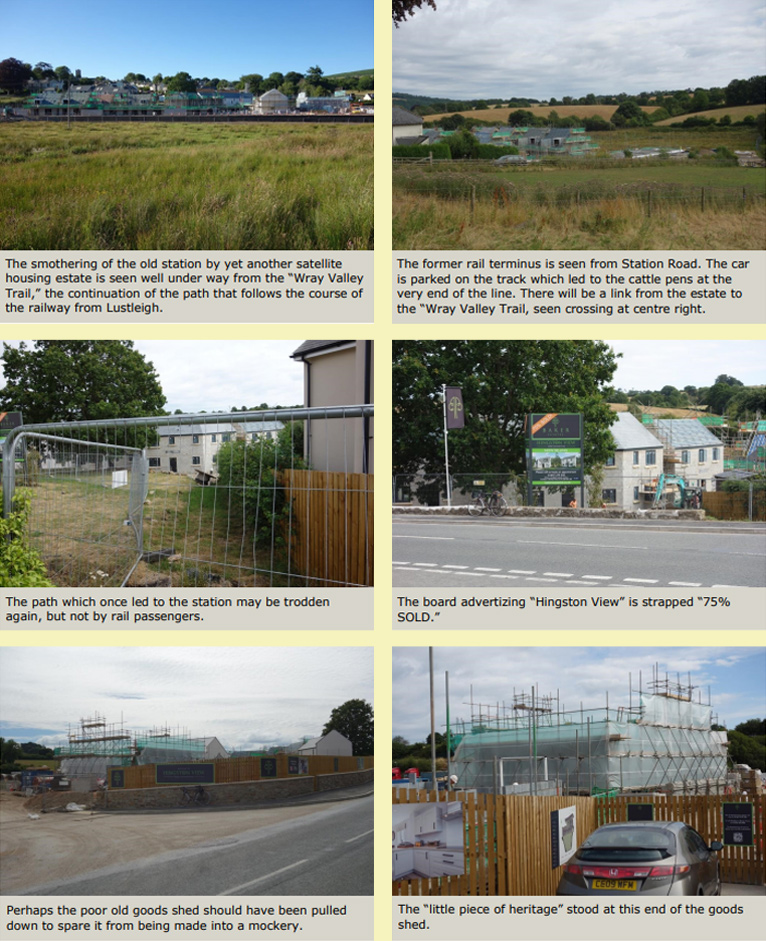
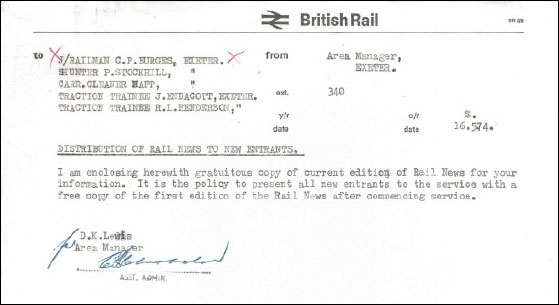 Railnews
Railnews
A letter to the Editor
Sim Harris is one of those establishment lackeys who draws a divide between the kind of railway expansion schemes that are deliverable within the narrow confines of today and those which are judged as barmy, even though they were once possible and could well be again in a modernized form if enough people believed in the full development of public transport systems and were able to use their imagination.
In a review of Campaign for Better Transport's "The Case for Expanding the Rail Network," in the March, 2019, issue of Railnews, entitled "Unbundling Beeching," Mr. Harris admits that there is merit in some of the proposals, but tends to sneer at or pick apart many of the other cases, especially where railway reconstruction would mean homes being demolished or, God forbid, a road built on an abandoned railway formation being displaced; even going so far as to say that "heritage" railway owners would object to their lines becoming truly functional again, as if their takeover would be any different to the exercise of state powers down the years. Would this be worse than the "People's Railway" of 1948 being thrown to a committee of vultures?
Railnews was first published in 1963 by the new British Railways Board to replace all the former regional titles. In 1978 it was issued free to staff; new entrants had been given an introductory issue. It ceased publication in 1996 but was restarted independently in 1997 and has continued since then.
The Teign Valley scribe received his free copy in May, 1974, but had actually started reading it much earlier, often being handed a copy on his way to school by a kindly booking clerk at St. David's.
Faced with all the institutional and entrenched opposition, whether overt or tacit; with the private car exerting a stranglehold on alternative thinking; with rail and other public transport innovation limited by closed minds or by its always being too expensive; there are still "railway" spokesmen and supposedly friendly commentators dictating what cannot or should not be done, even before the hostile voices from outside are raised.
Some men seem to delight in putting down proposals that would bring back rail transport to comparatively small populations and enable the railway to regain territory and areas of activity. Instead of being the ones brimming with ideas and writing encouragingly about every blossoming proposal, they are in the cripple siding pooh-poohing initiative, while congratulating themselves like smug intellectuals who can see why nothing should be done in given cases.
An intellectual will decide that a task is impossible and then sit back, satisfied that the power of his reasoning has saved him fruitless work. A lesser mortal may also realize that the chances of success are slim, but his spirit is disquieted by the lack of action and so the task is begun regardless, just to see what happens. Instinct cocking a snook at logic, perhaps.
If it is not on the scale of High-Speed Two or Crossrail, should a project not be considered? London Underground carries about as many passengers as the national network. Using the kind of figures that Beeching was fond of trotting out, if the Underground's small mileage were added to the country's, it could then be said that half of all traffic is carried on 2.5% of the network. Twice as many journeys were once made on trams than on trains. More passengers probably pass through one barrier at Waterloo in an hour than use the main line between Exeter and Newton Abbot in a day. In the end, it is easy to rubbish any call for expansion because of its lack of volume or intensity, if someone is so minded.
When listening to those who pronounce that there are quite enough railways, or that only a few more are needed to complete a useful network, it is often abundantly obvious that they speak as people who have cars very firmly planted beneath their backsides and who could make any journey they liked without using trains. The car is their primary, everyday mode of transport and if they were honest they would admit to being able to do without public transport of any kind, save perhaps "park and ride" buses.
Many would never stoop to using a local bus or train, and this goes for the majority of today's railway managers, who, like David Cameron being flown to Exeter before making his triumphal arrival in Dawlish, would only catch a local train for publicity purposes or when they can really do no other for the sake of appearance. They speak as if they do not know or care about those who are without a car; or those who cannot drive for one reason or another; or those who dearly wish to break away from car dependency; or those who feel that any journey beyond a certain length can only comfortably or properly be made by rail. The owner of a £20,000 motor car has only one consideration: the desire to be mobile when he pleases and as such he has little idea what the car really costs and does not see it as a waste if it stands in his driveway or other parking place for 23 hours on most days.
And those whose bottoms are grafted to their car's upholstery are not listening to the trumpet calls which may be sounding the end of the system that they have adhered to without thought or concern; the environmental groundswell that should make possible again a riot of diverse and widespread public transport provision.
If it were possible to involve communities in less stringent forms of railway operation, and the descent through a long life of rolling stock and materials were practised again, the religious pessimists who quote the multiple, man-made obstacles placed in the path of railway reconstruction today would have to recant.
Those to whom the car is the normal or preferred mode of transport can easily scoff at the people of Bude who met a few years ago to discuss putting the town back on the railway map. The former terminus of a branch from the famous Halwill Junction, once served by through coaches from Waterloo, now has the distinction of being the English holiday resort furthest from the railway network, lying 33 miles from the nearest station, Bodmin Road. The next closest are Barnstaple, 34 miles, and Exeter (St. David's), 55. Since it is not so much further, at 72 miles, a driver with a fast car may take the A39 and A361 to what could be called the West Country's "passenger concentration station" at Sampford Peverell (Tiverton Parkway). Reopening Okehampton, 29 miles away, would still leave Bude much further from the rail system than the place which was once remotest in all of England, Hartland Point.1
To the Sim Harrises of this world, a single main line and a scattering of branches which see no business or first class travel are all the West Country needs and their kind would not be troubled by people in Bude and the great expanse of Mid-Devon and North Cornwall lacking the opportunities and connections that rail transport brings.
To a real transport campaigner, the best place for a "railhead" serving Bude is not Barnstaple or Bodmin or Okehampton; Halwill is not good enough; Holsworthy would not do, either. For Britain to have the public transport it needs to tackle a range of critical issues, and for rail to win dominancy again, the only rightful station for beautiful Bude would be Bude.1

It is typical of a mean metropolitan to dismiss the rail transport campaigners who work in their own time and against the deadweight of authority to promote a great variety of schemes.
There is the spirited and resourceful Olga Taylor who champions Pilning (High Level), a station that the industry cannot be bothered to close or even service with a one-a-day "parliamentary." Read her upbeat submission to the latest organizational review and then the lifeless responses from the usual wet blankets.2
Should there not be a "toy train" waiting at Barnstaple to weave through the hills to Lynton? What is the point in reconnecting the old Ashburton terminus to its branch line? These are two projects supported by this railway and covered on these pages primarily because, even under today's flaccid conditions, they have the potential to provide functional transport.
Just as they have done throughout for disintegrative denationalization, the obedient establishment hacks continue their support for the new London & Birmingham, a 1930s-style economic stimulation project stemming from the 2008 financial crash, and ignore the calls instead for railway development in all areas and extremities of the country.
In his review, Harris refers to some lines on the C.B.T. list as "remarkable railway byways," clearly, in his view, not worth considering.
Admittedly, the report has several inaccuracies. It is fairly obvious that Portishead and Clevedon should have been the Clevedon Branch from Yatton, which had an intensive service until closed in 1966; but Harris takes it to mean the light railway which closed in 1940. Even if C.B.T. had meant the Weston, Clevedon & Portishead, would it be so unthinkable to have back Col. Stephens's charming little line, with its many wayside halts, as a classic electric tramway?
The inclusion of the disused Weymouth Quay branch may seem "rather bizarre" to Harris, but who can say with certainty that Channel Islands sailings will not return to Weymouth one day and that passengers, instead of being herded at airports, again choose to be taken to the quayside in comfort. Or maybe the powers could be taken up by the corporation for a tramway. Its continued existence is only an issue because of heavy motor traffic. This is one of the most interesting lines left, but it does not any more fit with the dreary, destaffed, monofunction system to which the railway has been reduced. Whereas once it was just part of a diverse, penetrative network, the operation of which real railwaymen looked upon as ordinary.
No doubt Harris is a man who as well as proclaiming where the railway should not go, also rules on what it should not do. It is this thinking which has emasculated the railway to such an extent that it can no longer carry its own consumables and equipment; which has every roving manager out on the roads in a staff car; which introduces trains to the West Country that have no space for surfboards; which puts rolling stock on lorries; which transfers traincrew in taxis; and which with the least excuse sends for buses to substitute for trains.
Spurred by a Swedish schoolgirl, Railwatch, the magazine of Railfuture, resorted to stronger language than usual in the July edition.
"We are gradually moving the perception of Railfuture from a bunch of earnest dreamers to an organisation people are increasingly turning to for advice on railway development issues, including reopening proposals, improved services and a better offer to the passenger and the freight customer.
"There is actually nothing wrong with being a dreamer. This can be a strength, not a
weakness, providing we can engage and communicate rational arguments."
"Rail does not seem to grasp the opportunity of producing an energy-efficient, emission-free rail system."
Ian Brown, C.B.E., F.C.I.L.T., Railfuture Policy Director

Even the Editor of Rail Engineer, a free, industry magazine reporting on current projects and technological developments, creditably took it upon himself in September to write to the Transport Secretary pleading the case for rail electrification, a letter headed "The rail industry's contribution to the 2050 net zero greenhouse gas emissions target."3
The minister, until the music starts again, is Grant Shapps, whose attentiveness can only be held for two pages at a time on rail matters; it is not known what limit has been imposed on road lobbyists.
Meanwhile, at the Railsnooze desk, the limp-wristed response to a rail transport campaign is to caution that being too ambitious or demanding may cause ministers and civil servants to take fright, like clucking hens disturbed in the night by a furry intruder. A principal reason that such panic and confusion has sprung from predictions of environmental disaster is because for so long so many people were afraid to voice their concerns and the few who had the solutions were too shy to shout about them.
Harris's final paragraph was the one that sparked a response from here.
"However, putting forward the meandering Teign Valley line between Exeter and Newton Abbot as a candidate, even in the 'later on, maybe' list, seems unlikely to help—and even more unlikely to justify investment, at least in any circumstances we can foresee."
It is only ¾-mile further via the Teign Valley than the main line so there cannot be much of a meander.
That Railnews can foresee no circumstances in which the Teign Valley would be useful is because "we" lack that deep belief and have little imagination.
The railway's letter, which was accompanied by a souvenir mouse mat, was not published. A copy of "A Summary of the Case for Reopening the Inland Railway Route between Exeter and Newton Abbot" was sent to the editor in 2014 and that was also ignored.
The July Railnews carried a one-line letter from a correspondent who wrote: "Bring back the Big Four, that's what I say." The scribe may say the same, but not in so few words. Those leviathans (the L.M.S. was the largest commercial undertaking in the British Empire) did not need outsiders to tell them how to run their businesses or to plead with government in the absence of other representation.
Appendix: Letter to the Editor of Railnews
https://www.connectbude.uk/
https://www.pilningstation.uk/pilning-station-group-submission-to-the-williams-rail-review/
https://www.railengineer.co.uk/2019/08/30/rail-decarbonisation-a-letter-to-the-minister/
Drink-Driving: Still a Laughing Matter
A letter to the Police & Crime Commissioner
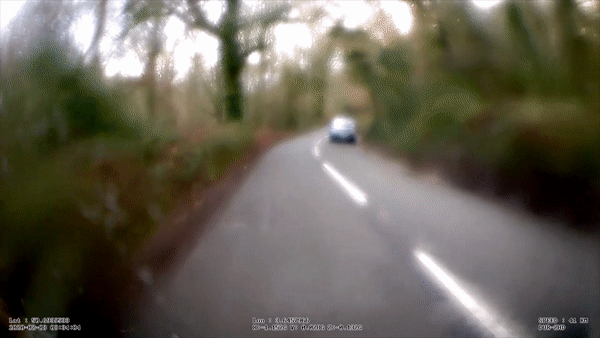
There is great disparity between the way in which private and public transport are governed and often it is not understood how this tends naturally to favour the advance of road motoring. There is disparity between self-centred and public road transport, and between road and rail public transport.
Anyone who leaves the relative safety of a railway station and ventures onto roads and streets is immediately struck by the widespread disregard of the law and the lack of common human decency shown by many motorists.
Absolute adherence to the rules on the railway system is built-in and routine. The great body of historic regulation, reinforced today by detailed "safety cases," is overseen internally by an incorruptible chain; it can fail but never be deliberately avoided. A train cancellation or delay may be caused by only a small fault, whose equivalent may be ignored by the private motorist, or even by the bus or haulage operator. A high level of safe practice can give the impression of unreliability or inefficiency. Many people are less appreciative of this determination to preserve human lives than they are of the poorly-paid freelance driver whose tatty, unmarked van tears around dropping their web-order parcels.
Motorized road transport is controlled most of the time by the individual’s sense of right and wrong, which fortunately in civilized men prevents their behaviour from sinking beyond a certain depth. There is only very scarce intervention by police, whose officers are overly stretched dealing with general offending. Although, it has to be said, that, even without the involvement of criminals and uncivilized types, it often seems, especially to the vulnerable road user, as if the law of the jungle is all that prevails.
In the absence of policemen, much of the law is forgotten and a good example of this is the attitude in rural areas to driving under the influence of alcohol, which, much as it was in the 1960s, is still a laughing matter in some circles. And, these days, a young driver is as likely to be doped as drunk.
On this particular subject, in November, 2018, a letter was sent to Alison Hernandez, the Police and Crime Commissioner for Devon and Cornwall. It began by explaining the evolution of the transport modes and how the disparity arose, none of which she was likely to have heard before. It claimed that while development of road vehicles had leapt ahead, a 70-year age gap was still evident in the much lighter application of authority.
"Motorized road transport quickly got ahead of the lawmakers and for all practical purposes remains there today, protected it seems by an institutional resistance to reining in an essential freedom—even if that freedom is but a myth—and by a peculiar, nonsensical human fixation."
The detail of a nearby example of a drink-driving incident was recited. It involved units of three emergency services being deployed, including a helicopter, on a false alarm. No action could be taken against the young tough responsible, when he was found, despite it being known that he had staggered across the car park of a local boozer before over-turning his vehicle three miles down the road.
Whereas the railway has been taken to an extreme of safe practice, arguably restricting the ability to give its best service, drivers of vehicles on a road system that demands more concentration and awareness than ever can legally be under the influence of alcohol, and it is allowed to continue year after year.
"Government … dithers over the alcohol limit for drivers because it is fearful of the effect reducing the tolerance any further would have on pubs, especially those in rural areas; the move could be seen as the killer blow to a perhaps already dying trade. But this overlooks two broad considerations: rural pubs need not be dependent upon motor cars; and nothing should stand in the way of improving road safety."
"Safety legislation has prohibited, slowed or made more expensive activity in every field, sometimes annoyingly or seeming to be unnecessary. The principle holds that no consideration should override the advance of safe practice, even if this denies us other benefits."
Whereas a train driver must not have had a drop of alcohol to drink for many hours before going on duty, a car driver can leave a pub having had a short, early evening session and get behind the wheel almost with impunity.
And if anyone protests that there is no comparison of responsibilities, I would answer that there is just as much, or even a greater, risk attached to flinging a two-ton Barbarian down a dark, wet, winding country lane as there is driving a train guided by rails, with its multiple safeguards.
C.B.
The problem of police strength being too low was understood but it was suggested that only a few examples made of habitual drink-drivers would cause a shock in an area for quite some time, and that, with a little intelligence, it would amount to inexpensive and effective policing.
A prompt, referenced acknowledgement was received in which Mrs. Hernandez advised that a member of her team, the industrious Richard Martin, would respond as soon as possible, certainly within a month.
No more was heard, which is especially disappointing as Mrs. Hernandez is the Association of Police and Crime Commissioners' Lead for Road Safety and, as such, it may be thought that she would be greatly concerned about drink-driving in her predominantly rural area.
A reply need not have commented on the historical position and the example of lawlessness was from 2012. It was not expected that Mrs. Hernandez would say that she was going to urge her officers to pull over more drivers leaving rural pubs on the strength of the railway's letter.
What would have been encouraging is to have heard from Mrs. Hernandez that she and her fellow commissioners were pressing for a long overdue reduction in the blood-alcohol limit for drivers to at least the same level as in Scotland.
Were it not for the great disparity between systems, the blood alcohol level for road vehicle drivers would long ago have been made next to nil, with no tolerance shown to offenders.
Had the truth been out when the letter was written, another quite appalling local incident could have been mentioned, in which two young men died when their Jaggwa collided with another one, causing an innocent man's death in hospital three days later.
"Recording a narrative conclusion, [the coroner] said that [the deceased] had "previously taken cannabis and cocaine" and the car he was a passenger in "was being driven with excess speed" and "on the balance of probability", [the driver] was driving under the influence of drugs."
DevonLive, 4th June, 2019
Appendix: File of correspondence with Alison Hernandez
"You know, more people are dying on our roads than through any serious violence that's happening in our communities, so it is a really important issue. Some of the key things that we’re looking at is to see what we can do, particularly working with the National Police Chiefs’ Council Lead, Anthony Bangham, who definitely believes that enforcement is one of the key areas that we must focus on at the moment. Because through austerity, we believe roads policing teams have lessened, so we need to bring some enforcement back into play."
Watch Alison Hernandez deliver these words, in response to rising road casualties:
http://www.apccs.police.uk/videos/apcc-lead-for-road-safety-alison-hernandez/
In the letter's postscript, Mrs. Hernandez was advised that the letter was part of a campaign and that a copy would be forwarded to Roadpeace, the national charity for road crash victims.
Roadpeace did not at first acknowledge the letter or the enclosed £25 donation. When thanks for the donation came, it did not mention the letter. Sally Howard, the new Administrator, explained that staff changes
had caused a bit of disruption and that the letter had been passed to Amy Aeron-Thomas, Justice and Advocacy Manager, for information, adding: "Thank you again for your support with campaigning and donations."
July, 2019
The foregoing piece was sent, accompanied by a letter, to Mrs. Hernandez in case she wanted to correct or comment upon what had been published.
On 7th August, her assistant, Richard Martin, wired:
The letter, dated 8th January, reached Christow by wire on 7th August, along with the second reply.
Appendix: Further correspondence with Alison Hernandez
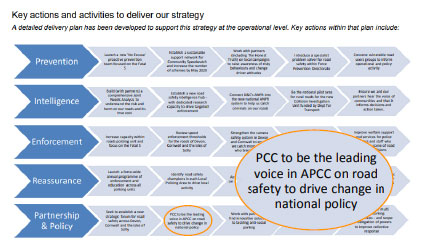
It will be left to the reader to decide whether Mrs. Hernandez has even begun to address any of the points made in the railway's letters; or whether, with the number of officers available and the law as it stands, there can be only the vainest attempts to improve conditions on the roads.
In neither of the railway's letters was the vital question asked and in neither of Mrs. Hernandez's letters did she state her position voluntarily, so, to be clear, it was put to her in a closing letter (actually, two questions were put).
She had drawn attention to her force's "Roads Policing Strategy," whose small print on page nine gave a useful pivot.
As England is so out of step with other European countries, and indeed much of the world, in its tolerance of drink-driving, do you support the calls for a reduction in the blood-alcohol limit to at least the same level as in Scotland?
As the "Policing's Road Safety Strategy" states "P. & C.C. to be the leading voice in A.P. & C.C. on road safety to drive change in national policy," will you use your position and influence to lobby government for this reduction in the blood-alcohol limit, so that police advice "don't drink and drive" can become an order?
Mrs. Hernandez replied again at length but the short answers were in effect "no" and "no."
The permitted alcohol limit for car drivers is a glaring irregularity. In all other areas, the law has closed in on unsafe practice yet it is still permissible knowingly to drive a motor car in an unfit, or less than fit, state. It would not be possible in a modern workplace where plant or machinery or vehicles are operated, yet someone whose manner, concentration and reactions are unquestionably affected by even small amounts of alcohol is allowed by law to get behind the wheel of a potentially lethal moving object and set forth on public roads, shared with very vulnerable users, under the influence of quite a large intake of drink.
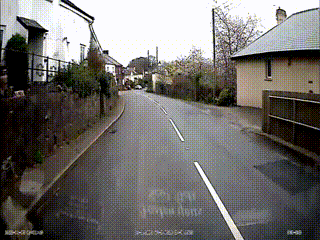
It is indefensible and talk of extreme offenders being the problem is merely a diversion. It should not matter whether the drinking-driver who stays within the law as it stands causes few accidents, although this should be enough in itself; it is the greater danger that he poses, which any industry risk assessment would rule out in the pursuit of the safest possible conditions.
In her reply, Mrs. Hernandez draws upon some convenient studies done in Scotland since the blood-alcohol limit was reduced in 2014 which cast doubt upon its effect, while ignoring that this limit, or a much lower one, has been in force across Europe and much of the world for many years.
Lowering the limit to 20mg. (of alcohol per 100cc. of blood), which should be the maximum, would mean that police could say with absolute authority: "If you're going to drink, DON'T drive. If you're going to drive, DON'T drink." Instead, the unscientific limit set in 1965 continues to allow drivers to have had "a few." The few - if it is a few - which all recent studies show has such a drastic effect on driving ability.
The roads may be jammed with some of the 40-million vehicles registered to use them, but the country is still far from the saturation point when it comes to the number of drivers, or drivers with the first call upon a car. Yet representation is heavily slanted in drivers' favour; motorists preside over motorists, whose "rights," interests and freedom are paramount in decision-making.
Even in the case of a serious offender, the motoring magistrate will be mindful of the near condemnation depriving another motorist of his licence could entail, such that pleas of hardship and loss often result in leniency. Just as a man will shudder at the thought of another man's balls being cut off, the motorist knows how awful it would be for another poor fellow not being allowed to drive.
The shrieks from motorists and the motoring lobby at the least tightening of control, as if basic human rights were being denied, overlook that driving is a licensable privilege entered into by choice and under what should be strict, enforceable terms.
It can be seen why this fraternity has effectively resisted the change which has swept over every other comparable sphere of activity. Of course there have been great advances in safety and efficiency, mostly for the benefit of the motorist; the closing of the technological gap was acknowledged in the opening paragraphs of the first letter to the commissioner. However, the gap remains often as wide as ever in the relatively light control exerted on the motorist, certainly in practice and arguably with intention.
Measures taken of the full environmental and societal costs of road transport prove how damaging it is in many respects, yet little is done to dampen demand or encourage travel by other modes—or even to discourage travel. Recommended moves in this direction, like road pricing or forms of taxation that shift costs from vehicle ownership to journeys, are routinely ignored. Manufacturers have naturally striven for stronger vehicles as a selling point, but the aim should not have been to make car occupants safer but to make those outside less vulnerable, without segregation.
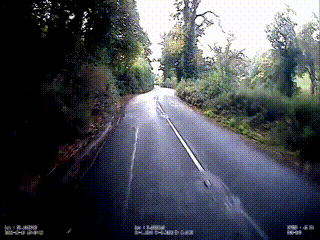
Possibly the most lamentable of all the failures has been in day-to-day policing, which long ago became too much of a task for ordinary constabularies. There is so little likelihood of rural drink-drivers being pulled over that many have forgotten the law exists, but this is only a part of the broad issue of drivers' fitness, which can be impaired in many other ways.
For there to be any comparison with the safety standards of the modern railway, a dedicated roads police force would be required. This would have to be visible and intrusive, conducting random, roadside checks on vehicle conformity and driver competence. The courts would have to hand down stiff penalties for offences which endanger or cause the loss of life and limb, including a lot more lifetime driving bans in the most serious cases.
The Police and Crime Commissioner for Devon and Cornwall not seeing the need to bring down the blood-alcohol limit for motorists to the level where drink has no appreciable effect on their driving is one of those positions held by people in authority over the years that has helped maintain the 70-year gap, reference to which was used to open the subject in the railway's first letter. While reasoning that a reduction is not necessary, she may as well be a motoring lobbyist, of the type that has always resisted encroaches which spoil enjoyment of the "open road," epitomized by Toad in his gauntlets and goggles. She may do it unconsciously but she does it as well as those who are paid to defend this wretched establishment.
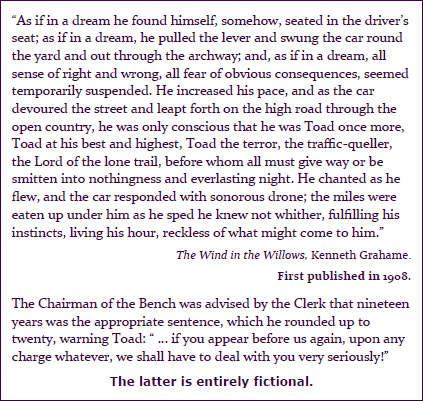
It was thought that Mrs. Hernandez's replies would be of interest to the good people at Brake, the road safety charity, so a letter was sent, along with copies and a £20 donation. They were not acknowledged.
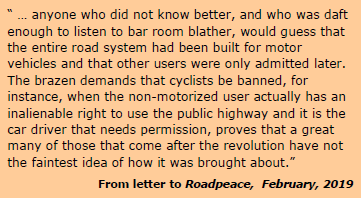
In her reply of 7th August, Mrs. Hernandez proudly advised of the new system which allowed road users to submit evidential film of dangerous driving.
https://operationsnap.devon-cornwall.police.uk/
The railway's utilicon was equipped with a forward-facing camera some years ago. Still images of the worst incidents recorded are kept and shown to people who know the roads.
Some say that a slow vehicle incites dangerous overtaking and intolerant behaviour. The same sort will claim that road safety is improved by increasing speed and that "performance" cars are safer because they can "get you out of trouble." These beliefs and the people that hold them are not worth challenging.
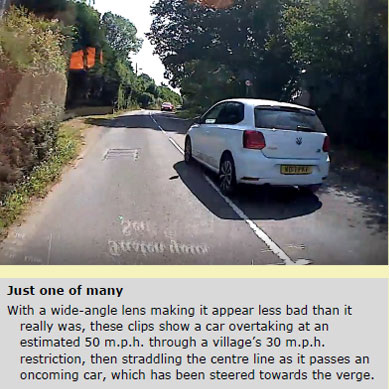
Among other requirements, evidence submitted to Operation Snap has to be original; copies will not do. The utilicon covers an annual mileage which is far below the average, yet on almost every journey, thoughtless or inconsiderate behaviour is experienced, some of it downright dangerous. It would be too costly in memory cards to submit a recording of every occurrence, even if the railway had any desire to take part in this kind of police informing.
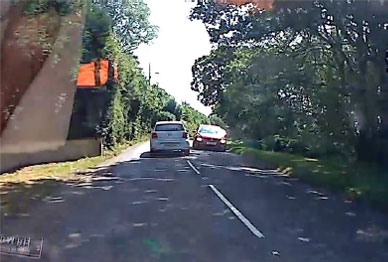
December, 2019

While being unhappy with the seemingly steadfast position taken by Mrs. Hernandez, the scribe could not flog the Commissioner further without being able to refer to some development or other.
Patience was rewarded when a circular telegraph was received from the Rail Safety and Standards Board, an independent body guiding the industry in the absence of any other unifying force.
A link to a Highways England initiative, Driving for Better Business, caught the eye of the scribe and thank goodness it did, for who should quickly be revealed as an eager supporter? Why, the Police and Crime Commissioner for Devon and Cornwall, that is who, anxious as ever to "lead by example."
Any effort to improve driving and road safety would have to include drugs and alcohol, and Driving for Better Business does not disappoint; in fact, its suggestions to firms' managers framing rules for staff driving on duty are much more demanding than the law applying to the ordinary motorist. Zero-tolerance of alcohol is clearly the only course.
So, Mrs. Hernandez was asked if she would be using the model clauses for her office staff and civilian staff in her police force, or whether she would be less dictatorial.
"And if you do take the hard line, will you still shrink from campaigning to extend the prohibition to the motorist at large?"
Richard Martin replied on behalf of the Commissioner, stating again that "lowering the limit alone is unlikely to have an impact in itself."
A brief reply from the railway put it that lowering the limit "would have an impact on drinking and driving" but conceded that his "system-wide approach" was necessary.
"While my writing about transport issues is naturally influenced by personal experiences, I try to step back from individual events and take a broad view.
"Admittedly, choosing this subject has come from my living in a rural area where, like most, there is no police presence at all, where drinking and driving is both blatant and habitual, and where I know that men still think it is a laughing matter."
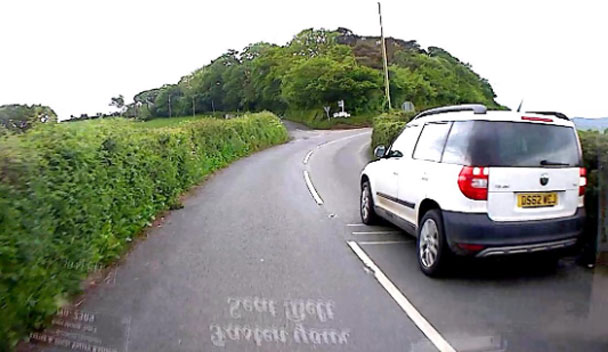
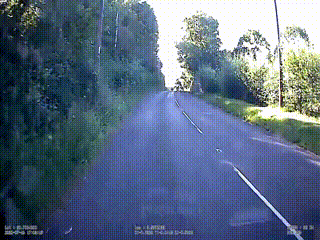
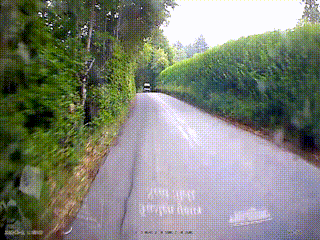
A two-minute animation produced by the Institute of Alcohol Studies
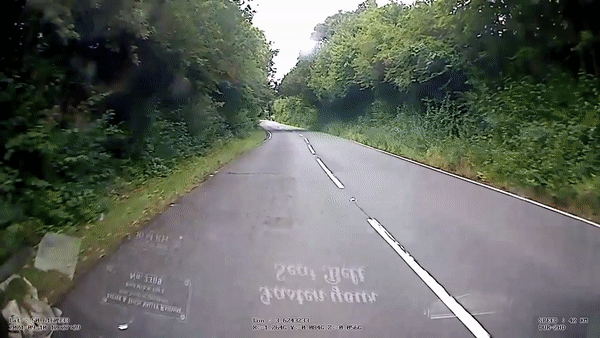
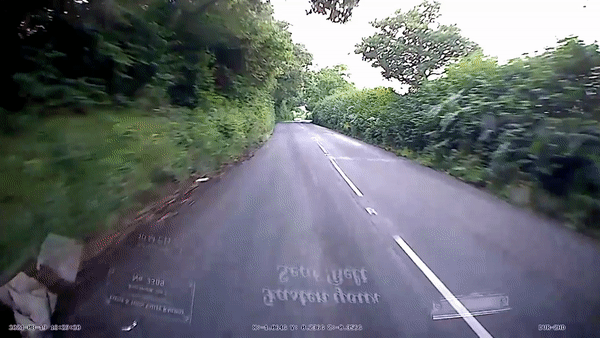
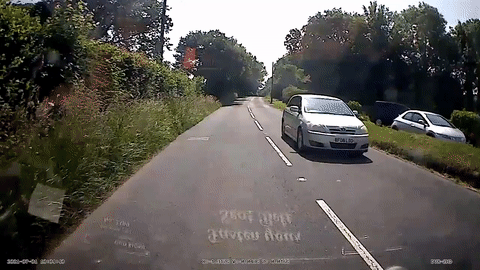
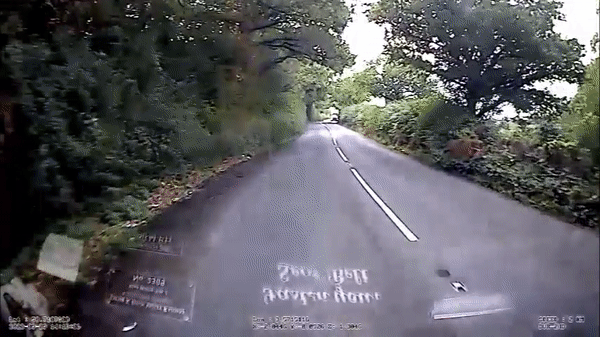
April, 2021
Postponed for a year because of the plague, local elections, which included Police and Crime Commissioners, took place on 6th May, 2021.
Alison Hernandez was nominated again, but was challenged by Brian Blake, Gareth Derrick and Stuart Jackson, representing the Liberal Democrats, Labour and the Green Party respectively.
A letter was sent to Mrs. Hernandez, whose postal leaflet proclaimed “Safer Streets + Safer Roads = Safer Communities,” and properly she replied as a candidate rather than the commissioner.
Appendix: Correspondence with Mrs. Hernandez as P. & C.C. candidate
Much the same letter was sent to each of the three challengers, who, in the final paragraph, were asked: “... how much importance would you attach to road safety? Would you make the commitment called for in the manifesto [“Commit to act on road danger”]? With the channels available to you, would you do your utmost to impress on government the need to reduce the blood-alcohol limit for drivers, as recommended in January’s PACTS report?
All were kind enough to reply.
Mr. Blake, a retired police officer, stated:
“There are several points but yes I would support a 20mph speed limit not only in residential areas but villages as well. I also think the tolerance on the drink driving limit should be brought down in line with some European countries. These as you know are not within the remit of a Police and Crime Commissioner but local authorities and the Government but I would support them.
“During my service as a police officer I attended several fatal road accidents and speed was a factor in over 50% of them. My manifesto includes the need for more visible road policing which in my view is the best deterrent against bad driving. This is a national issue. Last year I drove from South Devon to Dover and not once did I see a Police car on the route except for one dog van on the M25.”
Mr. Derrick, retired from the Royal Navy, wrote:
“Many thanks for getting in touch with me about road danger reduction and drink-driving in particular. I do agree with you that there is still too much of this going on, despite the supposed fact that it became socially unacceptable a long time ago. I have read into the Action Zero manifesto and support its proposals.”
“I intend to re-establish that this kind of offence must be recognised as proper crime, with appropriate deterrent sentencing as you suggest, and lobby for this wherever possible.”
Mr. Jackson, “full-time in cancer care,” replied:
“Countries which have introduced a dramatic reduction in the blood-alcohol limit for drivers have given their populations one thing which the UK lacks: clarity. UK drivers think they can risk drinking and driving, in moderation, with our current situation.
“I am a keen cyclist myself and I do know that motorists are the main threat to cyclists; they are much more hazardous than steep descents. I am also a motorist.”
It was no surprise that Mrs. Hernandez, with the Conservative ticket, found herself within a few days of the election back at the same desk at Middlemoor H.Q., near the caravan park where the scout was born.
On the 18th, the scribe wrote to her under the heading “None for the Road.” She was congratulated on her return and told, without their being identified, what her challengers had had to say in answer to the questions that had been put to them.
“None for the Road” is a video made by Glasgow City Council with the intention of emphasizing the danger of drinking and driving after Scotland reduced the permitted blood-alcohol limit in 2014. A few examples like the one made in the film would soon make drink-driving less of a laughing matter in places like the Teign Valley, even with outdated English law.
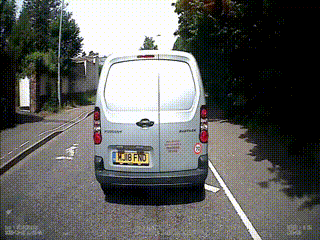
None for the Road: https://www.youtube.com/watch?v=EHujQXxQi7c
Mrs. Hernandez was heavily involved in the challenge of policing the “Group of Seven” summit held in Carbis Bay between 11th and 13th June.
She was good enough to reply to the railway on the 15th. While her letter brought some promise, the first few lines were a disappointment.
“There would still appear to be no political interest in reducing the drink drive limit on our roads. Instead, the Government’s view is that the enforcement of current laws should be made more effective and the punishments increased.”
Copies of the election correspondence had been forwarded to Roadpeace. This reply from Mrs. Hernandez was sent to Nick Simmons, the C.E.O. with some comments added by the scout:
"It is clear to me that, despite English law now being so obviously out of step with our neighbours, government will not act on drink-driving because it fears the damage that would be done to wayside boozers and because it has always taken the light touch approach to the motorist.
“In no other areas are such economic and cultural considerations put ahead of improved safety; legislation has been crushing and disruptive everywhere else for many years.
“One of many eye-openers last year, as if I needed them, was the demonstration of lobbying power provided by Tim Martin, who as good as told government when he would be reopening his Spoons. Of course, he would not have broken the law but then he knew his bluff would work.
“In April it was predicted that pubs would be the last businesses to reopen, possibly only by Christmas. Some time after they actually opened, the announcement was slipped out (no one I know even heard it) that the public could resume making non-essential journeys on buses and trains.
“It could be said that because rural drink-driving causes few known casualties it is not worth committing manpower to enforcing the law. This misses the point: everyone in my area knows that at certain times there will be drink-drivers on the roads. Those who consume what they take to be the permitted two pints at lunchtime and “early doors,” and those who spill out in darkness, effectively reduce everyone’s safety in a way that I maintain would not be tolerated in any other public sphere.
“After falling off my bike crossing a ford, I am hobbling around with a broom under each arm. I was entirely to blame and no motorist, drunk or otherwise, was involved."
When Mr. Simmons replied, the scribe put down some more thoughts:
"My real disappointment was with Alison’s first sentence; the rest of her letter held promise but I’m afraid that I’ve heard it all before.
“A few years ago there were police publicity stunts meant to encourage motorists to pass cyclists with care. Normally I laugh off the behaviour of the worst drivers, but the other day, on the last eight miles of a 45-mile ride, with blood streaming down my face, I just wanted to put up a flag saying “Out of the Game!” I suppose, in my fragile state, I felt more like a novice and just wanted some consideration.
“On the roads I use and journeys I take, I never see the effect of any showy initiatives. All I see is government constantly balking at the fundamental changes which could be enacted by the stroke of a pen and which would radically improve road safety."
In his reply, Mr. Simmons said that “we are determined to engage with Alison and I am hopeful she will join the DfT Post Crash Victims Working Group that I sit on ... ” And, encouragingly, he expected an imminent announcement of some fundamental changes to government policy on victim support and road safety.

December, 2022: A memo headed "'Cognitive distraction' and 'inattention blindness' among drivers" was sent to Mr. Martin, requesting that he bring the subject to the attention of the Commissioner.
No reply was received.
May, 2023: A note headed "Crash, not Accident" was sent to Mr. Martin, asking him to draw the Commissioner's attention to the appeal by Jo Shiner, Chief Constable of Sussex Police, for the correct use of language.
https://www.youtube.com/watch?v=TCv49EWXCkU
Mr. Martin was good enough to reply.
June, 2023: When it was agreed that volunteer "Station Friends" would help to keep clean and tidy the reopened Okehampton Station, each was issued with the handbook illustrated at right. A copy fell into the hands of the scribe and was taken away to be digested.

The ten-pages devoted to "Drugs and Alcohol Policy" provided another reason further to press the Police and Crime Commissioner in a letter.
After a rambling six paragraphs, the scribe continued:
"Extraordinarily, the volunteer could have been in the boozer at lunchtime and had the two pints of beer which most think of as the limit. He could have driven his car through town or country and along Station Road and reported for "duty."
"But he would not be allowed to pick up a watering can or a broom and even his being present on railway premises with that level of alcohol would lead to him being "sacked," for, unlike drink-driving, alcohol abuse is heavily "policed" within the railway industry."
The scribe then returned to the claim that he had made on page four of his first letter to the Commissioner, nearly five years before.
"Quite obviously, there is one overriding reason for government having failed to correct what has long been a glaring anomaly and this is the devastating effect changing the law would have on pubs, especially those in the countryside which depend on custom from beyond their locality. It is a very rare case of an economic consideration outweighing the endless striving for safety."
The plague had provided new evidence, both of the undue importance given to "hospitality" and to the power of industry lobbying, conducted quite openly.
"Tim Martin, the outspoken boss of Wetherspoon, which he claims provides £1 in every thousand of all tax revenue, was reported to have said that he would be preparing to reopen his pubs in late June. Though he did not actually say this, it is strange that he and others were allowed to open their doors again on 4th July, a new thanksgiving day for drinkers. Far from being the last to reopen, as had been predicted, pubs beat buses and trains, where it was thought that infection would likely spread more readily than in the boozy confines of pubs."
The scribe, who, as a former employee of B.R., enjoys concessionary rail travel for leisure and pleasure purposes, should not have returned to the trains until 17th July; few heard the announcement of this relaxation.

A description of the true realities of hospitality and the licensed trade concluded:
" ... If we were to be honest and not adhere to a fable, most pubs would be classified, along with sex shops and gaming parlours, as nuisance businesses."
The largesse lavished on this trade contrasted markedly with the penny-pinching that started when rail unions submitted pay claims for staff that had kept trains running amidst the plague.
"Repeatedly during the railwaymen's protracted pay claims, reference has been made to how much it cost to maintain public transport services over the stoppage, which government had imposed, at the same time as warning people that buses and trains were dirty and dangerous. Indebting generations to come, vast sums were handed out in grants and support payments, not least to the "hospitality" trade, yet government chose to beat up ordinary railwaymen for a situation that was none of their making, during which, to their credit, they carried on calmly."
People having the sense that roads are not safe was touched upon.
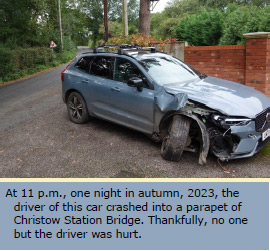
"The repercussions are far worse than the statistics show, for there is no mention of the perception that roads are made dangerous by drivers who, for various reasons, are unfit to be behind the wheel.
"The statistical likelihood of being run over by a drink-driver may be very small, but this is no comfort on the ground when a motorist who has just left the pub, having consumed enough alcohol to have slowed his reactions and dulled his awareness, comes haring around a bend in the road. Anyone would be foolish to be out on the lanes leading away from a rural boozer and not take refuge at the sight of an approaching car, for fear of its driver being "under the influence"."
In every other area, all risk, without exception, is eliminated as far as possible. Yet, on the public road system, one howling, anachronistic source of danger is allowed to remain.
"Manufacturers have made continual improvements to the safety and "crashworthiness" of their vehicles. Crumple zones, impact cages, collapsible steering columns, laminated glass, seatbelts and air bags make cars safer for occupants, although arguably are deleterious to safety for others. Cars stop more quickly thanks to improved brakes and brake control. The technical advances are not set at nought by the fact that the wretched things can still be set in motion by drivers who have been drinking, but the effectiveness of design improvements has been reduced; just as all the gains in efficiency were ruined by the arrival of the ridiculous Sports Utility Vehicle."
The Commissioner, who often disports for the cameras, was asked, perhaps cruelly, if she would like, as a publicity exercise, to visit the family of Marie Perez-Gonzalez, the nurse who was run over by a 21-year old doped driver, and tell her bereaved relations that she thought the 1967 Road Safety Act was not in need of reform.
The culture which continues to produce dangerous drivers like the young man who mowed down the nurse and left two children without their mother, is "partly encouraged by lax laws, insufficient enforcement and inadequate punishments."
The Commissioner can only pretend to be pursuing Vision Zero while police turn a blind eye to the rebellious and often lawless behaviour which everyone reports seeing on the roads.
Two examples from the scribe's own recent experience were given. The first was his treatment at the funeral of an old friend whose premature death was brought on by excessive alcohol consumption. When he left, sober, he felt that the disgust shown towards his abstinence must have made him the most unpopular guest at the wake. "The experience revealed again how so many ordinarily decent chaps do not see drink-driving as a serious matter."
The second was an old man who disobeyed a 20 m.p.h. restriction in his haste to get to the car park of a nearby farm shop. If he had knocked over a cyclist or pedestrian, the urgency would have been getting a few groceries or going for a coffee.

"The man and his wife most likely could have made this journey by bus at no cost, but he will hold on to his right to drive, and continue to drive like he has done since he was an excitable lad. Flouting speed limits he does not agree with and disguising his number plate for the sake of vanity stem from that youthful exuberance and road rebellion which is still being nurtured."
Another example of the flippancy shown to motoring law was a story told to the scribe that he had every reason to believe. It concerned a regular offender being at a local boozer when two policemen came to answer a call. He felt "rather uncomfortable" because he stank of dope but could not leave because he had had too much to drink; neither condition would normally have stopped him driving home.
Concentrating on drink-driving overlooks the greater problem. Vulnerable road users will be disturbed by the knowledge that there are drivers getting behind the wheel who are just under the limits for drink and dope; and will be horrified to hear that some drivers will be over the limit for both. The term "drink-driving" must be understood to be generic.
The scribe then conducted a very unscientific experiment. He downed a measure of grog that he thought would not cause him to fail a breathalyzer test and then gave forth as he normally would when lightly lubricated.
"What everyone of my generation wants to know is, when was it that the boys in blue that we remember became the black-clad, stubbly, shaven-headed, tattooed, pumped up, tooled up paramilitaries of today, carrying a bad attitude, with their teenage daughters on work experience, more concerned with the normalization of moral decay than with applying the immutable laws that we all once understood?
"And the horrendous Crime Commissioner's office? Well, there's six million quid down the drain."
When he was rid of the toxins, the scribe took up his pen again and claimed that the purpose of the experiment was to show that, although he had undergone a change in character, had become uninhibited and had spoken rashly, as many do after only a little to drink, he would still have been allowed to drive a motor vehicle.
The scribe felt that he was speaking for a great many who use the roads, especially those without the protection of a steel shell, when he described the virtual free-for-all that he witnesses almost every time he ventures out. It is too vast a task to be adequately policed.
"Your much publicized Vision Zero is meaningless to me as long as you do nothing to unseat or disturb, or even get the attention of, the whole cult of motoring machismo which hooks boys at an early age and continues to hold them until decrepitude finally slows them, by which time they are usually bumping into things because they cannot even see where they are going.
"That young man who killed the mother of two children surely belongs to the set that worships fast cars; fast, powerful and often lethal cars; cars with modifications which nullify the manufacturer's type approval; cars with stickers and embellishments which match the infantile mind of the driver; cars which substitute for individuality or personality, or which make the drivers believe that they are sexually attractive, whether this is a young buck in a "hot hatch" or a bald old coot in an expensive convertible."
The only way that zero road deaths could be realistically achieved is if there were vastly fewer vehicles, driven more slowly over shorter distances, reduced to nothing more than a means of transport. Instead of this, the stampede is now underway to replace every vehicle on the road with even dirtier, heavier and more damaging contraptions, dressed up as "guilt-free motoring."
Mrs. Hernandez has signed up her office to the National Highways "Driving for Better Business" initiative but she will not state what drink-driving policy she has adopted for her staff. The scribe took it that she had used the model conditions with their zero-alcohol clause. Why has she joined other authorities, and commerce and industry, but will not use the weight of her position to campaign for it to be forced upon drivers at large?
Could it be that she has a favourite hostelry that she knows would be done for, along with many others, by a reduction in the blood-alcohol limit for drivers? The woman is, after all, only human; very human, judging by her numerous gaffes and faux pas.
This was the letter's penultimate paragraph:
"You are a member, perhaps unwittingly, of the establishment which has, over many decades, helped to feed and perpetuate the absurd love affair with the motor car. You did nothing in all the time you were the lead on road safety among commissioners to press for a reduction in the drink-driving limit and you continue to believe that you can have a Vision Zero without any meaningful change in the law."
Appendix: Further letter to Alison Hernandez
A reply, by wire, came from Mr. Martin on 4th July.
Thank you for your letter of 7th June.
The Vision Zero South West partnership is currently in the process of reviewing its strategy for the coming years. I will draw to them your concerns over the drink drive laws.
There continues to appear to be no political appetite in Westminster to change the drink/drug drive limit laws.
You will be aware that drink/drug driving is one of the Fatal Five behaviours most often represented in fatal road crashes. The Fatal Five is included in the current VZSW strategy and intoxicated driving is included in the Police Road Safety Strategy.
The Commissioner's Police and Crime Plan includes priorities of road safety and drugs. Cracking down on drug use and supply should also improve road safety outcomes.

The Police and Crime Commissioner resolutely refuses to add her name to those more conscientious men and women who hold the equivalent position across the country. Reports are issued, strategies are developed and catchy names are invented which make not an iota of difference on the roads and streets.
And ordinary motorists, enjoying the effect of the historical 70-year lag, will continue to drive quite lawfully having drunk two and three quarter times more alcohol than a volunteer sweeping the platform at Okehampton is allowed.

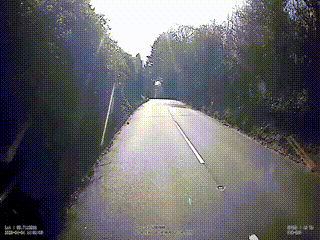

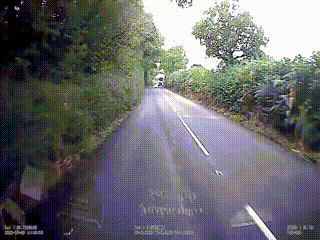
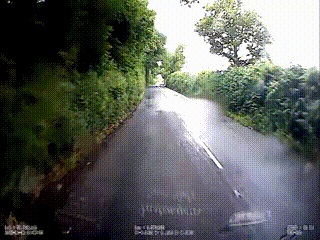
Bridge Strike, Christow
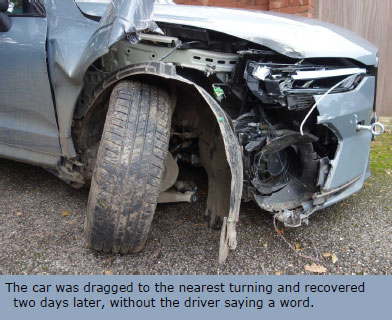
Conveniently proving the reality of the problem, a drunk driver smashed into the station bridge late in the evening of 19th October, 2023, causing severe damage to a parapet. Thankfully, only the driver was hurt.
The crash was reported by the railway to the local beat bobby, P.C. Hawkins (13114) on 24th. He replied, advising that he could not create a crime report from a wired message. Others had the patience to use the proper channel.
On 25th, justified by five years of correspondence on the subject of drink-driving, a message was sent to the Police and Crime Commissioner.
A reply came on the 1st November from Erica Harris, Customer Service Support Officer, advising that the matter had been passed to the Head of Road Safety within Devon and Cornwall Police for his attention. She added: "He has shared this with his team and asked them to take some actions such as patrolling in Christow over a period of time ... "
The following morning, no less than Superintendent Adrian Leisk (34247), Head of Road Safety, got in touch.
Thank you for your email expressing concern around Devon & Cornwall Police's approach to drink driving in the Teign Valley.
I am also sorry that you have experienced damage to the station bridge at Christow.
The vehicle involved will have been insured and therefore, although disappointing to experience, should be recoverable against the relevant insurance company. Our incident number for the report of the damage is reference 418 of 211023.
We have an active operation (Dragoon) to identify and take action against those who pose significant risk on our road network. This includes drink and drug drivers.
We have a No Excuse team, consisting of a Sgt and 5 constables based in South Devon who use marked and unmarked cars, equipped with Automatic Number Plate Recognition (ANPR) cameras to tackle those above drivers who pose a risk on our road network.
If you are happy to provide any specific intelligence around the drink driver, I will ensure that this is submitted on the system and shared with the No Excuse Team Sergeant.
Out of interest, who was the local neighbourhood beat manager you have informed? I will ensure join up between our specialist teams and the local policing team.
Kind regards,
Adrian
In its reply, the railway was able to provide some "specific intelligence." It is omitted here:
Thank you for your message.
My contacting the Commissioner was, I felt, justified because I have had long correspondence with her on the subject of drink-driving, mainly in an effort to persuade her to add the weight of her position to the campaign to reduce the blood-alcohol limit, which for some reason she continues to shrink from doing.
The old railway bridge is owned by National Highways, whose Historical Railways Estate division takes care of over 3,000 structures, a legacy of closed railways. The bridge was sympathetically repaired last year at a cost of £70,000. It has never been struck before despite being used by large lorries. On Monday the road was closed and contractors from South Wales are rebuilding the wall as I write.
The car driver was ...
In what must have been a semi-conscious state, he was found by a following driver ...
The damage to the bridge was not reported to the authority and no advice was given to the owners of the private lane where the car was left.
Both [men] are regulars at local boozers, particularly ... So blatant is the offending here that tradesmen leave their marked vans on show in the car park.
In my conversations with local people, I have been heartened to find that there is considerable anger about this behaviour. The road closure this week has also caused great inconvenience and the diversion of the bus route.
The local neighbourhood beat manager was David Hawkins 13114.
While I am in touch with you, I wonder if you could save me wading through the court lists to find what happened to the young driver who ran over and killed nurse Maria Perez-Gonzalez while she was crossing Western Way in August, 2021.
Super. Leisk replied:
Really grateful for the information. I have passed this to our intelligence team, in addition to ensuring that PC Hawkins is connected with our roads policing enforcement teams.
I am sorry, but I am unable to provide an update on the fatal collision you have referenced, and have checked Open Source information available on the internet, which would suggest that the case has not yet been finalised.
I will be maintaining an interest in how this develops, hopefully you will learn of enforcement activity taking place in due course.
The owning authority wasted no time: the bridge was fully repaired a mere 18 days after the damage was done.
In February, 2024, National Highways answered a F.o.I. request submitted by the railway.
This was conveyed to the Superintendent on 1st March:
You may remember the incident that was brought to your attention when a drunk driver caused severe damage to a former railway bridge parapet at Christow.
National Highways have advised: "The repairs cost £25,472.98 and the process is being followed to recover this from the driver's insurance company.
The other regular offenders I thought may have shown some caution after this prang, but it appeared that drink-driving carried on being a laughing matter locally.
Here's a Chief Constable arguing that those who choose the car as a murder weapon should be punished like murderers.
The case of the young Beamer driver who I asked you about finally reached court in January, 28 months after he killed a nurse on Western Way.
https://www.devonlive.com/news/devon-news/driver-charged-causing-death-exeter-9011813
I know you're doing your best to keep the roads safe.
No reply was received.
Bridge Strike, Christow Station
Priority Transport
Sherford
One of Devon's two new towns is taking shape to the east of Plymouth. Unlike the soulless Cranbrook to the east of Exeter, Sherford does at least have a more traditional vision, despite being mainly a low density development. With a nod to Poundbury, an urban extension of Dorchester, artists' impressions of Sherford include street scenes which draw upon those of Devon's old market towns.

Whether these overspill developments are necessary - and others are planned - or are being built too conventionally is not the issue here. Assuming that they have to be built, what is the dominant form of transport to be? Of course, no matter what pretence is made otherwise, it will be the car.
Sherford lies to the south of the A38 "Devon Expressway." To the south-west can be found the course of the former Plymouth to Yealmpton branch railway. Had its Elburton Cross Station still been open, it would have been about a mile from Sherford’s planned town centre.
Given that reconstruction of the branch through Elburton would involve demolition of homes, and the value of the 5,500 houses intended to be built, making a northerly deviation at the expense of the house builders would have provided a better service and helped to reduce car dependency in the new community.
Activity on the Plym estuary may have led some people to speculate that the railway was going to be reopened on account of the new town, for why else would £3.5-million be spent on Laira Bridge? Alas, they would have been wrong: the 1892 viaduct is now a foot and cycle path, a duplicate of the one on the road bridge next to it, and rail transport, heavy or light, will not spirit passengers past the traffic jams to Plymouth, as it may have done had there been some continental-style forward planning.
Cranbrook, incidentally, is served by rail: its unstaffed, windswept halt opened in 2015 on the Southern main line. It is only a little to the east of the former Broad Clyst Station, which justifiably could have been reopened years before. Cranbrook, however, was originally billed as an "eco-town" and as such there were certain token provisions that had to be made. The label has quietly been dropped, but it got its station and may get another as the ugly place sprawls east beyond Crannaford Gates.
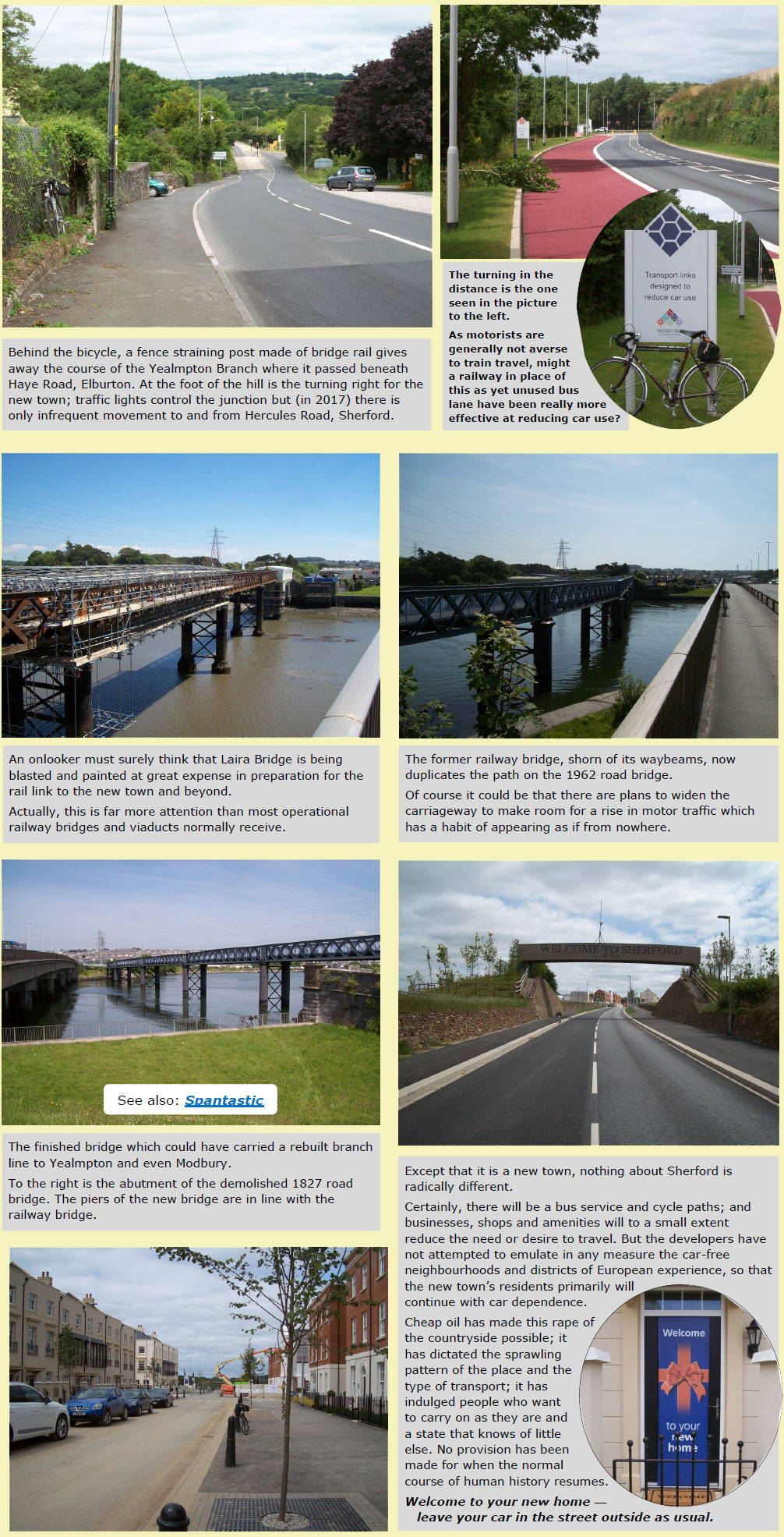
Nansledan
Another development in progress where there may one day be a station is Nansledan, the Duchy of Cornwall's "Poundbury-by-Sea" on the outskirts of Newquay. Though the buildings are distinctive and well finished, Nansledan appears to incorporate none of Poundbury's revolutionary transport thinking, summed up by The Prince of Wales as "... placing the pedestrian, not the car, at the centre of the design."
If in time a halt is built on the Newquay Branch, it is likely to be where a new link road is to bridge the line between Chapel and Trencreek crossings, about a mile and a half from the terminus. But it would only be built in the last stage of the satellite settlement and by then motor traffic would have long been spewing onto the A3058 and residents would have found themselves as wedded as ever to their cars.
Tolvaddon
Rail transport is not needed in the midst of Tolvaddon Business Park, Camborne, where in 2012 roads were made, with lighting and bus shelters, using European "Convergence" funding, in the hope of attracting firms to the park's greenfield development land.
There can be no argument against laying in the necessary service roads, but were this example adjacent to a railway would a connection ever be made in the hope of attracting firms desirous of a rail facility?
Under present conditions, the answer is that no speculative provision could ever be made and that therefore every new factory and trading estate commences with an inbuilt reliance on road transport.
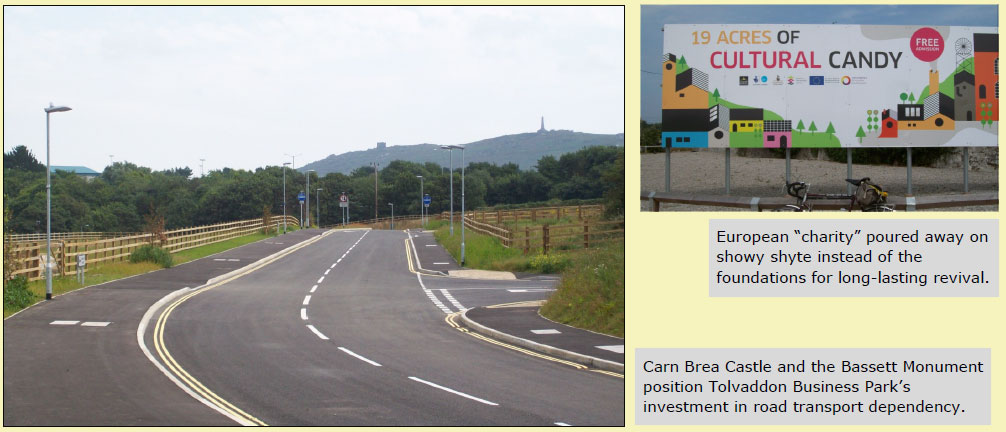
Filton
In Bristol, what is now the growing aeronautical complex was served until 1986 by workmen's trains calling at North Filton Platform, but its reopening now depends on a passenger service being reintroduced on the Henbury Loop Line, an aspiration of the MetroWest consortium which at the present rate is a very long way from realization.
People are more likely to be won over to public transport if good provision is made before demand arises.
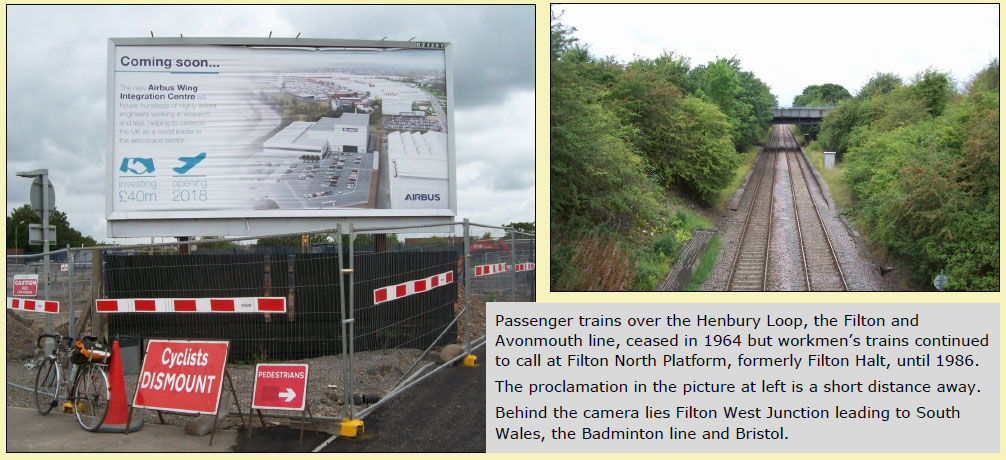

Exeter Gateway
Goods traffic had dwindled to next-to-nothing in Devon and Cornwall when the idea of intermodal terminals for Exeter and Plymouth was put forth in the draft 1995 Devon County Structure Plan.
The stations in Exeter were deemed unsuitable and so a site at Matford was considered, along with Heathfield, adjacent to the A38, and the M5 motorway junctions at Cullompton and Sampford Peverell.
The usual infill had followed the completion of the M5 motorway in 1977, but by the mid-1990s it was expected that Exeter's expansion would overtop the dam and flood east. Around this time there was talk of a new town with a working name of Clyst Hayes.
Seeing an opportunity, Church Commissioners, the custodians of the Protestant church's massive estate, proposed in 1997 that their Hayes Farm at Clyst Honiton, lying between the London road and the old Southern main line railway, and being close to the M5 and new A30, should become the intermodal freight terminal that Exeter needed.
After much parleying, a planning application for an "Exeter Gateway Intermodal Freight Terminal and Distribution Park" was submitted in 2000.
In its simplest form, two 1,300-foot sidings and a run-round loop at a right angle to the main line would make a junction by way of a nine chain curve with the single main line at 167 miles 43 chains from Waterloo. Whimsically drawn on the plan were a triangular junction, a further siding and loop, and a servicing and fuelling siding. There would be as well the necessary railway offices and accommodation. The tracks would be set in an extensive concrete apron over which travelling cranes or other lifters could work, and as a stacking area for containers. The various warehouses of the "distribution park" would be arranged on either side with service roads.
Early on, there was mention of a passenger line being built to the airport terminal but fortunately this flight of fancy was not pursued.
The 2000 application was passed in 2007. It was unequivocally to be a railfreight depot. The conditions included a legal agreement (Section 106 of the Town and Country Planning Act, 1990) that bound the developer to have a fully operational rail terminal, proven to be serviceable, before any of the associated warehousing was occupied ("commenced" is also used but it is thought that "occupied" was meant). The reason given by East Devon's planners was: "To ensure that the rail facilities and ancillary areas are fully provided and ready for operation before the occupation or use of any warehouse in the interests of sustainability in freight distribution by ensuring that access to rail is available at the earliest possible time and to encourage the use of alternative means of transport."
The Church Commissioners had now to find a specialist to build a rail terminal without help from government or industry. A very costly part of the project would be a detailed study of how the terminal would fit into the system and the installation of the junction and its signalling; Network Rail’s consultancy fee estimate was £40,000 for a start. Within the developer’s control, but no less demanding, would be the task of attracting firms to the speculative warehousing and then coordinating their occupation with the arrival of the first train.
When Broad Clyst goods yard was open, half a mile away, a local train would pick up and detach wagons at a series of stations centred on a marshalling yard. Even in the 1980s, a diesel and three crew would "trip" a single wagon from the siding at Whimple to join a trunk train at Exeter.
Now that almost the entire infrastructure of the general purpose railway has been dismantled or destroyed, the new terminal would be a destination on its own, with the nearest container "railport" being at Bristol, 80 miles away. Trains terminating at the "Gateway" would have to be well, or even fully, loaded for the operation to be viable and competitive with road transport.
The project was not without interest: one experienced investor, Drawbridge Securities Limited, negotiated for some time with a view to developing the railhead.
Three years after winning approval for their scheme, when Commissioners must have become quite frustrated, Johnny Sainsbury came along offering to take the whole site south-west of the railhead and build a supermarket distribution centre. Unlike his competitor, Tessie Cohen, however, Sainsbury is not a rail enthusiast and the site was saddled with the legal requirement that prospective businesses would have to prove their ability and intention to forward or receive substantial traffic by rail.
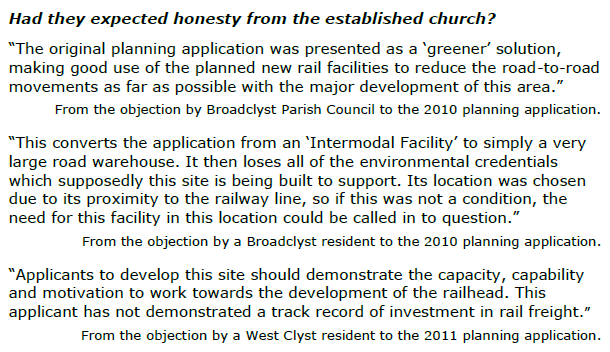
How was this fix to be escaped? The Commissioners went to East Devon planners to plead the case for relaxing the Section 106 to allow some development. This resulted in a planning application being made to defer the commencement of the railway works for no more than two years after the occupation of up to 50,000m2 of covered floorspace. Permission was granted in 2011 and the Section 106 was varied accordingly so that "Phase One" could begin.
Still nothing happened and it was not long before the "big four" supermarkets saw their fortunes change. Expansion plans were curtailed or cut back and Sainsbury, despite having done a lot of preparatory work at Hayes Farm, announced in 2014 that he was postponing construction; it was generally understood what this meant.
Some of the big chains' woes were attributed to the rise of the two highly efficient German names and Lidl stepping in to take the Hayes Farm site in 2015 for a Regional Distribution Centre seemed to confirm its success. The firm wasted no time and by 2017 its massive (12-acre) building with 127 lorry loading docks was open.

Meanwhile, the Commissioners had finally given up on the railfreight terminal and were anxious to start on "Phase Two," the land at north-west. Agents approached East Devon again, stating: "It has been clear for many years that the provision of a railhead at Exeter Gateway is not a financially viable proposition, as evidenced by the lack of any demand for such a facility or operators who would use it. SSL's [Sainsbury's] proposal did not include any rail-based transport, and their active interest in the site only came about when we were successful in re-engineering the original planning permission to delay the required railhead... ."
More consultants' reports were issued in 2015 when the Local Plan was being updated. One author1 wrote: "During my involvement with Exeter Gateway over some 10 years, there has been no evidence of demand from potential occupiers for alternative transport modes such as rail freight in this location." Another concluded: " ... it is currently impossible for a terminal developer at Exeter Gateway to find rail freight traffic that would justify the considerable investment required to create an intermodal terminal and attract investment. No public sector funding mechanism exists to create such terminals; they are private sector funded on the basis of the earning capability."2 The agent added: "In view of the clear conclusions of these reports, we consider that the allocation for Exeter Gateway should be amended to remove any proposal for a railhead and recognise the future of the site as a road-based distribution facility."

In 2017, an outline planning application for 110,000m2 of warehousing and demolition of Hayes Farm, and an application to discharge the railhead legal obligations, were considered together. The officer's report to committee stated: "... notwithstanding previous assessments and statements made about the feasibility of delivering the railhead in this location, at the Local Plan examination held Summer 2015 the Inspector concluded that 'there seems to be no realistic prospect of a railhead being established at the site allocated in the Plan'."
Most of the reasons cited against the railhead and its location were known in the first place. The junction would be with a former main line, now a singled secondary route, with restricted loading gauge ("W7")3 and axleweight ("RA6")4. Trains working via Exeter would face a severe incline and two tight clearance tunnels, St. David's and Blackboy. Because of the construction of "pocket" wagons, carrying 9ft. 6in.-high containers would have reduced train loads and thus the competitive advantage of rail. Once a train of 60 SLUs5, that which would have been accommodated at the Gateway, was considered respectable, but the push for economy now demands trains half as long again.
Rail was mentioned once more in the 2018 application with respect to "Phase Two," when Clyst Honiton Parish Council suggested a station for the Gateway. Dismissing it, the case officer wrote: "... this is not relevant to the determination of a reserved matters as this type of facility would have to have been secured off the outline stage but in any event a new station solely to serve this development would not be viable on a scheme of this size and no further transport mitigation was identified as being required."
The reopening of Broad Clyst Station to serve Cranbrook was rejected in favour of a new site. With all the commercial development to the west, it now seems that Broad Clyst would have been more central to passengers from old and new areas.

Beyond bytes in the electronic ether, in future the only evidence of this aborted project will be a fossilized railway curve, like those seen on maps all over the country where the boundaries of dismantled lines survive in new development. At the north-east corner of the Lidl's complex is the land reserved for the line leading from the junction (possibly "Exeter Gateway West") to the railhead. A gap has been left between Lidl’s and the railway for a possible future cycleway. Will cyclists or train passengers ever wonder why the corner of the lorry park is rounded off?
Did the Church commit the sin of opportunism? Was the railway element used to "sell" Hayes Farm for 45 acres of covered storage? Or was it a genuine attempt to break the stranglehold of the lorry? Since the airport is no longer in open country and a ribbon of sheds and shanties, concrete and tar, will soon extend beyond Cranbrook, it is not worth questioning the motive of one lousy landowner.
The final response of the industry, whose players throughout had been indifferent bystanders, came from a spokeswoman for Network Rail. On being consulted about the undoing of the Section 106, she said simply: "... we have no comment to make on the above proposal."
In the 20 years since a railhead was first talked about, nothing has been achieved. In much less than the last 10 years, the £11-million improvements to the A30 junction of the M5 and the £9-million Clyst Honiton Bypass, with its ridiculous tunnel, have been completed, and the airport is set to expand. It cannot be said that rail will play no part at all because there is a new passenger station.
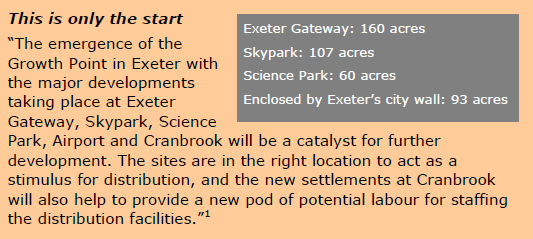
The planning policy twaddle has it that landscape, wildlife and human health are valued; that car use should be curbed; that train travel should be encouraged; that walking and cycling are beneficial. It paints pretty pictures and shows unspoilt coast and countryside as if to counter the awful sacrifice that has to be made in the pursuit of endless economic growth. The gobbling up of East Devon farmland, the unrestrained, irresponsible land-take of one greedy generation, paying no heed to the endless succession of life, is by a twist of terminology "sustainable."
The question of whether the railway has lost here is best answered by what would have been its position had the intermodal depot opened. No general traffic would have worked west of Exeter because any abstraction would have reduced train loads to the Gateway, the costs of which, because of operating difficulties, would have been only marginally less than road transport. So the place would have become like a port where a ship ties up because it can go no further; or like a 1960s freight concentration depot, where the railway serviced branches and small stations using road transport. Taking this much further, the Gateway’s sphere would have been the entirety of Devon and Cornwall; one report said that the West Country would be better served from Bristol.
Those who viewed what could be called the railway's "universal service" as hopelessly antiquated did not see the great advances that would be made in handling, tracking, control and organization, on top of electrification and automation; perhaps they did see, but did not want railway modernization reducing the case for road expansion.
After full denationalization (from 1994), the unlikely hero Edward Burkhardt of Wisconsin Central took over most of the freight businesses. Though he may have been the one to succeed with the intermodal depot, this was not his style: he tried to service the network where he could by taking advantage of the remaining loading docks, hardstandings and private sidings to generate dispersed traffic at or near its source.
In the 1950s, there were more than 150 places in Devon where wagons could have been loaded; now it is difficult to find one. As is often asked on these pages, would it not have been better, instead of seeing how small and narrow the railway could be made, to take a unified industry to its greatest extent, offering the widest variety of complementary services possible?
1 Simon Lloyd, "Market Report on the Distribution Sector with reference to Exeter Gateway," D.T.Z., June, 2015.
2 "Exeter Gateway and rail freight," M.D.S. Transmodal, June, 2015.
3 The maximum profile of vehicles permitted to pass. It should be at least "W10" and preferably "W12."
4 Route Availability grades lines from one to the least restrictive 10. A vehicle graded one is unrestricted. The former Southern main line is "RA6" and the Bristol & Exeter is "RA8."
5 A Standard Length Unit is 21ft. A loop with a nominal capacity in SLUs would also take an engine and brake van.
"That's never going to happen."
This remark was muttered by the Teign Valley scribe when he first learnt of the plan for a freight terminal near the airport, because it smacked so much of "green tokenism" and anyway seemed unworkable. An agency must have included it to soften the impact of industrial sprawl.
For over 20 years, consultants, applicants, planners, lawyers, agents, operators and camp followers travelled thousands of miles and attended countless meetings, churning out paper at every stage. Reports were commissioned which promoted the idea; later reports exposed its folly.
In the end there is nothing to show for it all. And some unimportant railwayman knew instinctively that it would get nowhere.
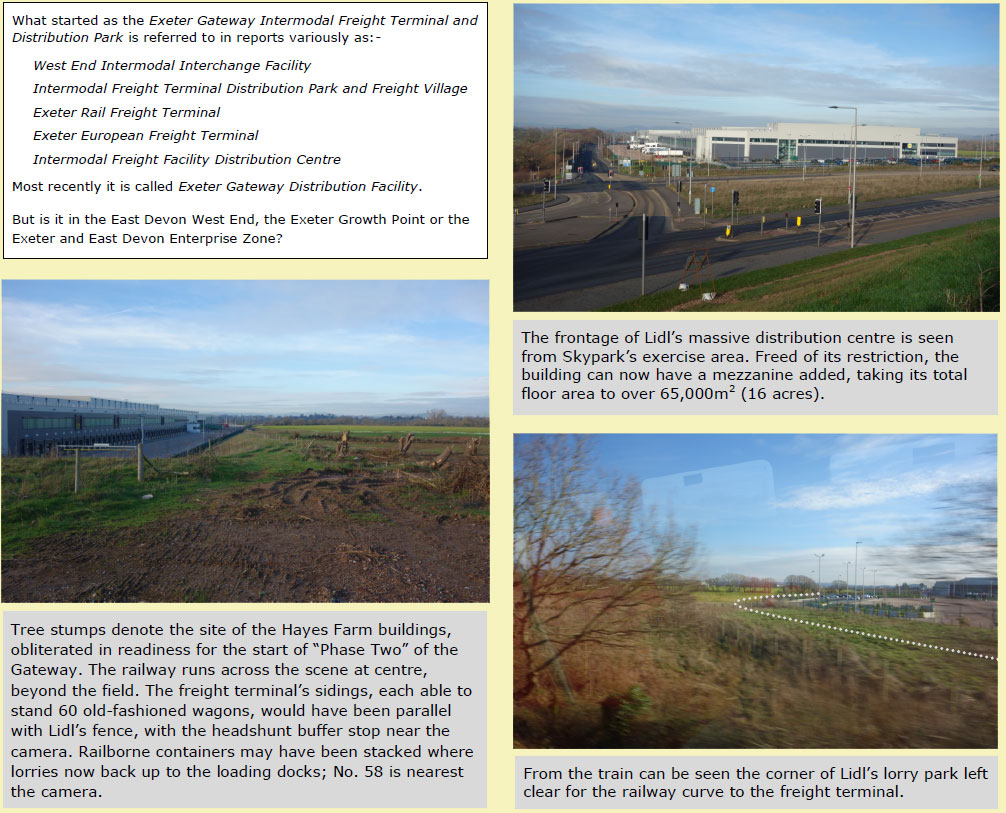
"The first stand-alone settlement in Devon since the Middle Ages."
See also: Cranbrook, under "All the Stations..."
Return to the Gateway
After the completion of the first of the "Phase Two" warehouses, a "delivery station" for Amazon, and part of the new access road, a lull in activity allowed the scout, on a grey day in January, 2020, to wander over the land which had grown its last crop before being smothered.

Tunnel Vision
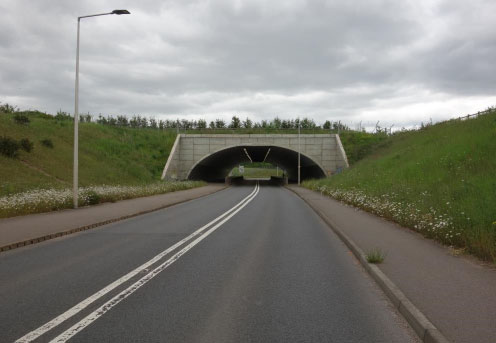
It would be obvious to anyone, without even an engineering bent, that the short "cut and cover" tunnel on the Clyst Honiton Bypass, opened in 2013, was for some reason required by the adjacent aerodrome.
In order to write the story of "Exeter Gateway," above, the Teign Valley scribe was faced with 16 East Devon District Council planning applications, spanning a decade. He studied seven of them and read 132 of the 581 files they contained, which ranged from brief submissions by individuals to repetitive and mind-numbing consultants' reports.
Buried in one of the files was a copy of the letter from Department for Transport to E.D.D.C. headed "Exeter Airport Public Safety Zone," which advised that the new link road "may be placed in tunnel to allow for the possibility of aircraft overruns."
From road level, it may be thought that the tunnel is beneath the runway, like the one at Heathrow that the E. & T.V.R. scout has cycled through. In fact, the tarmac is 180 yards away but the grass above the tunnel is still a high risk area. In line with the runway and 150 yards further on is the first house in Clyst Honiton.
The tunnel was built to withstand the landing forces of a Boeing Dreamliner, whose fully-laden weight is up to 250 tons.
In 2017, four years after it was opened, the tunnel lighting was improved. Its 238 400-watt luminaires, using 833,952 kilowatt hours of electricity per annum, were replaced by L.E.Ds. consuming only 216,564 kilowatt hours. The scribe has no idea what Devon County pays for its power but it must be that at least £10,000 is spent here annually. This for an 87-yard tunnel that should not need lighting at all.
It is enough to make an environmentalist groan with anguish. A road bypass, built to take the increasing flow of cars and lorries generated by Greater Exeter’s sprawl, has a permanently-lit tunnel to safeguard Exeter Airport—many of whose flights are over land—and the growth of aviation.
As always with road expenditure, there is a stark contrast between its highest specification and the often miserable provision for public transport, where it exists. It is not clear whether this tunnel was essential but it was built anyway, strong enough to cope with the remote chance of a Dreamliner, which may never actually need to land, finding itself on the grass at the end of the runway.
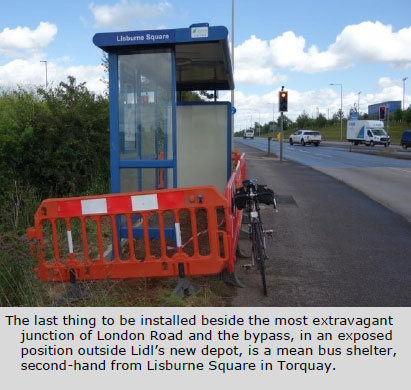
Such is the thinking, that road schemes are eminently deliverable but that rail expansion is almost always impossible, if the scribe were to suggest employing the same sort of concrete segments used at Clyst Honiton to make a new structural lining for Perridge Tunnel, he would hear nothing but howls of derision.
It can be taken that not one of the hundreds of councillors, penpushers and engineers involved in the planning and construction of the Clyst Honiton tunnel, men and women for the most part with no long view, had any doubts about its necessity or any concerns about it being a microcosmic example of waste and profligacy, and such a monumental testimony to ignorance and complacency.
This is what the "day-off-school" protesters outside County Hall are up against, although they do not know it. The children probably think that the empty posturing of "climate emergency" resolutions is a victory, when all it means quietly to the duds and old stagers, after a few inconsequential concessions, is business as usual, perhaps best expressed by: "Carry on driving and flying, but stop using plastic straws." The big picture and what really needs to be done are far beyond their comprehension.
Appendix: Copy of letter from Department for Transport to E.D.D.C.
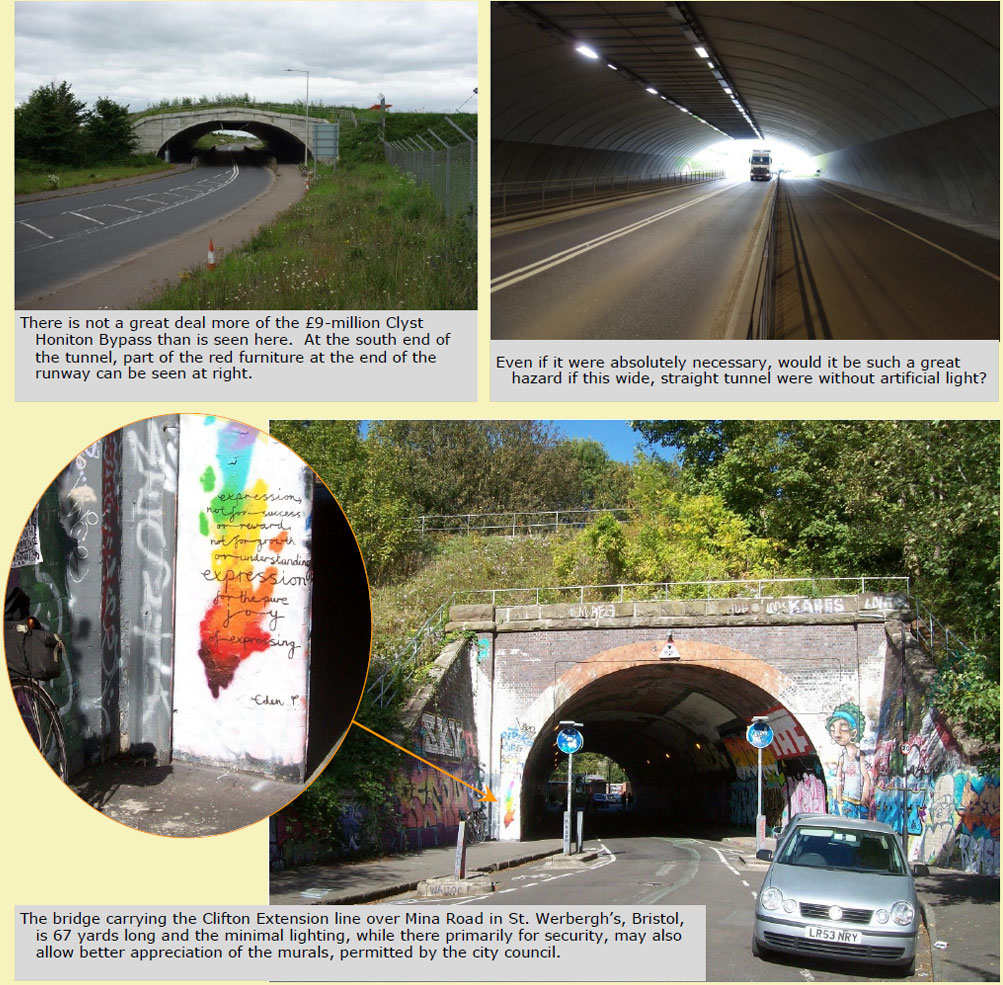
Traffic in Towns
Almost everyone it seems has at least a vague idea about Beeching - or "that fellow Beecham" - and his report, even if its proper name, The Reshaping of British Railways, is not known. It was published in March, 1963, and in November the same year came the more obscure, but no less devastating, Traffic in Towns, often known as the "Buchanan Report," after its principal author.
The first report was bent on "rationalizing" the transport system considered outdated and fit only for retirement; the second aimed to make possible, or tolerable, the youthful upstart's full potential, using the characteristic "predict and provide" method which is still allowing futile road expansion today.
The Teign Valley scribe had long known of Traffic in Towns but had never seen it, let alone read it. The copy that was obtained by Crediton Community Bookshop had been disposed of by Bradford's Reference Library and was date-stamped only eight times between October, 1968, and November, 1983.
The scribe has selected passages from the Report's 230 pages which should give a flavour of its style and approach. Some are boxed below and the remainder are contained in an appendix.
Early on, one paragraph clicked with the scribe, who has often regretted always doubting what the old boys had told him. For those who may have heard it said, through the fog of tobacco smoke in a bar or over the red tops in a greasy spoon, that the reason the railways were of no interest to government was because they cost the state a fortune, whereas the motorist was a huge source of tax revenue, and were convinced that this alone could not have determined transport policy, here is that very notion encapsulated in an H.M.S.O. report.
"If the rising numbers of motor vehicles are going to necessitate huge expenditures, they are also going to generate huge revenues. Except for the smoking of tobacco or the drinking of alcohol, there is no way of laying out the citizen's money that has proved easier to tax than the owning and using of motor vehicles. ... The money to be spent should, ideally, all be spent in the immediate future and, once spent, will in great part not need to be repeated for a long time. But the new revenues will go on indefinitely."
Though thoroughly researched and exceedingly well written and presented, much of Traffic in Towns was hopelessly, even laughably, idealistic. And far from the ideal being a high plateau where a wonderfully beneficial invention unquestionably serves mankind, the vision is in many ways a nightmare one, but probably no worse than what has actually happened.
The authors talk resignedly about the importance in a democracy of letting a population with no governing sense of responsibility have what it wants without check or caution, and letting it find out for itself that the stampede will trample all that is held dear before going over the edge of the cliff.
Earnest Marples, the Transport Minister and roadbuilder who commissioned the Beeching and Buchanan reports, fled to Monte Carlo in 1975, pursued by revenue men with cutlasses drawn.

Worth watching, if only as a fascinating period piece, is the Central Office of Information film made for the Ministry of Transport in which James Cameron outlines the problem and then discusses it with Colin Buchanan and others in their drawing offices.
"Everyone knows that we’re being invaded, devoured and practically immobilized by our own machinery. We want cars; we need cars; and cars are beginning to destroy our civilization."
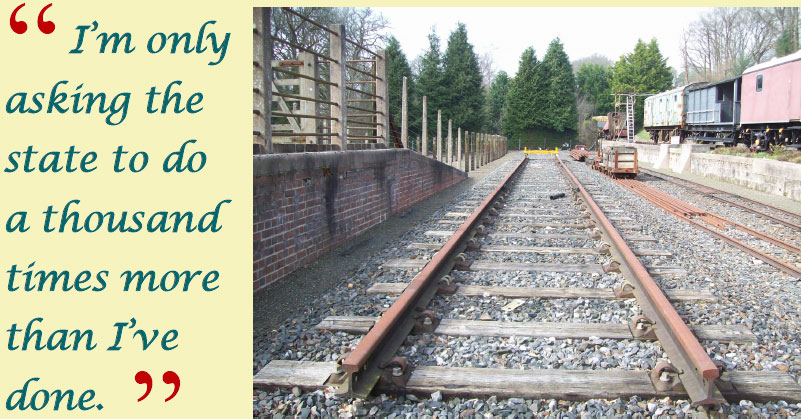
Along with, "The Teign Valley: the practical railwayman's preference," the quote above was coined in 2014 after the sea wall had been breached at Dawlish.
Rather like the utterance of a politician, no thought was given to this when it first came out in conversation. But a moment's calculation proved that it was very nearly true.
In fact, this symbolic length of track is greater than one thousandth part of the Teign Valley Branch. To re-lay a single line from the toe of the points at the main line junction in Exeter to the buffer stop in the bay platform at Heathfield, seven chains short of 16 miles, would actually need 935 lengths of track equal in length to this one.
While this claim is undeniably a great simplification of what is entailed in railway reconstruction, it does somewhat demystify a part of the physical task.
This section of the Up Main at Christow may not be of any use, but it is real and its installation involved the same effort as laying new material would have done.
And, as can be seen, this short token track is not all that has been done here.
Dave Black
Vassal of the road lobby, yesterday's man
Dave Black is Head of Planning, Transportation and Environment at Devon County Council. In April last year I wrote to him about rail transport, asking questions, stating facts and making observations.
Not having had a reply two months later, I wrote again, requesting that at least one question be answered. Mr. Black's P.A. telephoned to say that she could find no trace of my letter and so I sent a copy. Mr. Black then replied, acknowledging receipt of both my letters. He promised that "we will contact you in due course with our response."
A year and a half later, nothing has been received.
Now, Mr. Black is a council officer, not a policy maker, so it could be argued that the letter was addressed to the wrong man. But the aim was to reach Sir Humphrey, not Jim Hacker; the organ-grinder, not the monkey. Mr. Black may not determine policy but it is upon his professional reports and recommendations that decisions are taken in the council chamber.
It may also be argued that Mr. Black is not obliged to enter into correspondence with a member of the public, especially one who does not have a constituency or represent an interest group. But there are few environment and transport campaigners in Devon and the established pressure groups are locally weak or inactive, so in the absence of the scrutiny he would likely come under were such groups strong, I feel it is reasonable to expect that he answer an individual, if only for the exercise of showing his conviction.
There are other reasons why Mr. Black should have answered: because his predecessor, Edward Chorlton, most certainly would have done; and because he said that he would.
These were the subjects that I brought up in my letter, beginning with, "Dear Mr. Black, Have you a maverick in the building?"
Teign Valley and Slopes
"Devon Character Areas," part of the landscape assessment of the county lurking in cyberspace, contains a description of "Teign Valley and Slopes." It is well written and informative; it is also wonderfully idealistic in its aims. For instance, under strategy guidance is: "Protect the route of the disused Teign Valley Railway for potential reopening or recreational use."
"Now, your department has always been dismissive of the Teign Valley railway route, saying that it had no value in future for heavy transport purposes. So how much weight should I attach to this inconsistent statement found in a county council document? Can I use it to strengthen my campaign? My guess is that it was written by a conscientious environmentalist with a leaning towards railways who acted, harmlessly, without authority."
Mr. Black may have replied: "The author of this report had no reason to make this statement and no value should be attached to it by transport campaigners."
The Dawlish Débâcle
"As you know, the Teign Valley was thrust into the limelight two years ago. On the morning after the breach of the sea wall, I stood on Langstone Rock watching the forces of nature pummelling the railway, and thought that the year thenceforth was going to be interesting."
After this, I went on to say that I knew nothing would be done because of the railway's diminished importance.
"To those whose highly ambitious schemes took no account of population and the railway's paltry share of traffic, I pleaded that they include a fallback position, something modest and achievable, to cover the danger of ministers taking fright."
Of course, that fallback option was the reinstatement of the "least considered and most easily dismissed" Teign Valley route.
"So vast has been the expenditure on roads in Devon and Cornwall that the railway cannot hope to compete with speed, there having been no new main line construction since 1908. In an age when passengers can work and communicate on the move, the railway's strengths should be comfort and deep dependability. This would extend to emergencies, when longer journeys over diversionary routes would be unbroken and accurately timed.
"There may be a lesson from history here. In 1939, the Great Western as good as gave up on the government-funded £10-million Dawlish Avoiding Line and in 1943 took £30,000 to install four long passing loops and improved signalling on the Teign Valley Branch."
If not for his information, then for his amusement, I enclosed "A Summary of the Case for Reopening the Inland Railway Route between Exeter and Newton Abbot" and a promotional mouse mat.
No question was asked of Mr. Black.
The 1995 Structure Plan
"Twenty years passed during which there was minimal railway development in the county; growing passenger numbers in latter years must be set against the almost complete loss of freight traffic in a true measure of effectiveness. The developments which would undoubtedly have changed people's lives and brought much benefit did not happen. Schemes which may have been the basis of further work never got started, while the massive expansion of public transport generally which I believe is the only option if we are to maintain our civilization, is still nowhere on the horizon."
No question was asked of Mr. Black.
A retrospection of the 1995 plan can be found on these pages:
>> Devon County Structure Plan, 1995 >>
If only ...
The image of an emasculated station was used rhetorically to ask:
"Yet should not an industry that had been able to promote and defend itself have kept a national parcels service and at least some sort of freight distribution system with dispersed sidings and terminals to enable traffic to be won to rail near its source, like Ed Burkhardt tried to revive in the brief days of Wisconsin Central? Surely in the natural course of transport development, with all the advances in handling and control, the railway's reach and capacity would not have been so radically reduced and such a scorched-earth retreat made.
"At the many places the railway long ago ceased outright to serve, I always wonder what may have happened had the stations not closed. I picture modern equipment overlain on the ruins and try to imagine the difference even basic rail services would have made to the surroundings and hinterland. But the railway pulled out and a generation has grown up and grown old knowing only dependence on road transport. Particularly in the wastelands of North Cornwall, Mid-Devon and Central Somerset, the railway is an irrelevance.
"This sense of loss can be taken further: once it is determined that a railway should be rebuilt or a station reopened, the long period of delay denies rail transport to people whose lives may have been made better, or even saved. Think of the countless journeys that would have been made to and from Tavistock had the railway been rebuilt not long after the first feasibility study was done in 1991, and how this reopening would now be strengthening the case for reinstatement of the former main line."
No actual question was asked of Mr. Black.
The Rump of the Moretonhampstead Branch
Mentioning that the latest suggestion for this disused branch is the Stourbridge-type operation of a lightweight Parry unit, I commented:
"But, as with the county plan, local authority aspiration has weakened. From Heathfield Station being mooted for possible future use as an interchange in the mid '90s, it has only the vaguest mention in the latest local plan. And this at a time when you are preparing to spend £23-million on the corresponding A382."
Again, no question was asked of Mr. Black.
The Exmouth Branch
Mr. Black would know, I wrote, that the Exmouth Branch was listed for closure in 1963. It is now the busiest of the remaining West Country branches.
"Had the line closed, however, it would almost certainly now be a shared use path for most of its length and any moves to reinstate rail transport would meet with opposition from people who had become attached to the well established amenity. The prolonged process and procedures of such a reopening would also be vastly more difficult than those associated with closure."
No question was asked of Mr. Black.
The Portishead Branch
"The West Country branch line which will be the first to reopen, that from Bristol to Portishead, must have a cast iron case, given the growth of the former River Severn port and the congested roads leading into the city. The track was never lifted and the land not sold; the sections used for a cycleway are merely permissive. Yet still Network Rail's exhaustive G.R.I.P. has to come into play, as if it were the first ever railway and it were to be built on a pristine landscape and affect a population hitherto untroubled by such intrusion."
No question was asked of Mr. Black.
The need to facilitate railway reconstruction
"It is easy for a practical man such as yourself to imagine what would happen in an under-developed country, or here under conditions of national emergency, or what would have happened in earlier times. You know how quickly railway reconstruction could be achieved if the engineers were given free rein; if they were concerned only with the physical task and were untrammelled by the regulatory millstones.
"Though an imposition, the turnpikes were built without much difficulty. These and other roads were greatly improved for motor traffic from the 1920s to the '50s. There followed the era of massive new road construction which was supposed to render the railways redundant. None of this, certainly up to the 1970s, had to face the environmental and economic hindrance now slowing even the simplest railway reinstatement or infrastructure project.
"When was there ever a railway equivalent of land taken for a minor road improvement being secured over a 6d. stamp, the method remembered by Michael Hawkins in his book Devon Roads?
"If we accept that the railway is being called upon to relieve the excesses set in motion by unbridled road expansion, then surely there is justification for some derogations and easements to allow railway schemes to be hastened. Instead of saddling them with a weight of legislation that the competition never had to bear, and which is only possible because of the surfeit of graduates that write the largely meaningless reports and conduct the pointless studies, should it not be enough to show that the alternative would be even more growth in traffic and road space? I know that this is a matter for central government and local authorities must obey the law. Nevertheless, it is human life I am talking about, not a game of chess or a table-top exercise designed to bog down progress. Is it not time for the counties to press for a relaxation of diktats in order better to meet government targets?"
The last line is a question that could have been answered by Mr. Black.
The Ashburton Branch
The work done to prove that Ashburton could be connected by a mostly new route to Buckfastleigh was summarized. An enclosure explained that there had been conferences with Historic England, Environment Agency and Highways England.
"The next authority we are hoping to meet with is yours, principally to consider how a new line of railway would intersect the roads in the vicinity of Castle Bridge (Peartree), but also to discuss the project with officers responsible for tourism and the economy."
Mr. Black was asked to identify whom to contact at County Hall.
Iceberg Warning
To finish, I wrote of my outlook, experiences and concerns. Telling Mr. Black that I thought his "empire" was set up to fail I have no doubt worried him about as much as a chap defending Jericho was when told that the Israelite brass band was on its way.
"To dissuade you from thinking that my position is rooted in nostalgia or the desire to regress, I will say this: I am not the kind of environmentalist who wants to see an end to our industrial and technical prowess; I am not the kind of railway devotee who wants to see steam traction and semaphore signalling. My father gave up driving before the war and I have never owned a car, yet I can honestly say that my life has been enriched by having become accustomed to walking and cycling at an early age. My enjoyment has been greatly reduced by the amount of motor traffic and by the inadequacy of public transport.
"In the course of the day, when I see perhaps six white vans tear along my dead end lane, making deliveries which would once have been collected on foot from the station or brought by the postman, I am again struck by the folly of allowing cheap vehicles and cheap fuel to shape our world, when in the long march of history these can only be abnormalities and passing distractions.
"Even in this relatively quiet spot, I see heavily-subsidized lorries wastefully making small drops or working to remote operating centres. Everywhere the school day litters the roads with cars carrying children who would once have walked or cycled or used public transport. This ranges from the parents who have chosen the school in the next village, thus replacing a walk with a car journey, to those who drive a hundred miles or more each day to private schools. Even the school bus is a menace: as a cyclist, I find that they are among the most dangerous crates on the road, in the way that they are driven, if not their condition.
"And this spills out onto the road system at large, along with all the other aimless and frivolous movement, and the journeys made out of laziness or thoughtlessness or vanity: the dogs being driven to green spaces; the bikes being carried to the start of some "abstract" cycling; the sandwich vans; the grotesque "off-roaders;" the immature boys showing off their feathers; the greying men pretending to be young again, and so on. Despite all the talk about the need to curb car use, the spirit of the "open road" still holds that nothing must slow the motorist down or interfere with his freedom. It is all just traffic arising which, despite your wider job description, you seem to do your best to accommodate without question.
"You have hardly an alternative: this is not an authoritarian country and people are free to choose; the fact that choice is seldom exercised with any responsibility does not matter. However, you may take issue with me and say that you happily provide for this pulsating economy driven by cheap oil; that it is a man's duty to use every invention and resource to its utmost extent, for to do less is the kind of timidity that leads to extinction.
"Because of its sheer extravagance, I firmly believe that the empire over which you preside is destined to collapse. It is set up to fail as assuredly as the actions on the bridge of Titanic led to disaster. And just like the passengers who were dancing and carousing the night away, blissfully unaware of what was about to unfold, most people bound up with their daily grind and manic mobility have no idea what is coming."
Appendix: File of correspondence with Dave Black
Can they be cute in pursuit?
So, I put only two questions to Mr. Black which could have been answered in a few lines. If he had not the time or the inclination to give his view on the other subjects, he could easily have excused himself with courtesy or brusquerie.
One of Devon County Council's original functions was the construction and maintenance of roads and bridges. Who could have predicted in the late 19th century that Devon's road system would grow to 8,721 miles* — a greater mileage than any other county and indeed Belgium — and that much of it would be traversed by fast and heavy motor traffic? Men who have held the equivalent of Mr. Black's post down through the years have been natural road builders.
Some responsibility for public transport provision was borne much later, when the rise in car ownership began to hit bus services. Now the county council heavily subsidises local bus and train services. A rural bus passenger may pay only a small part of the cost of his journey, while the county is prepared to underwrite the summer Sunday trains from Exeter to Okehampton to the extent that £25 is rumoured to be paid for each passenger.
It would surprise me to find that Dave Black was a man who did not like his car, even that he was not an enthusiastic driver who took great pride in his vehicle. I would guess that he learnt to drive very quickly after coming of age and that a car has been at the centre of his being ever since. I doubt that there has been any point in his private or professional life that he has had the slightest misgiving about modern motopia. Though he has had to busy himself with measures to slow down traffic in places, and with the promotion of public transport, car sharing, walking and cycling, these are things I imagine that he truly understands only as technicalities.
Privately he would admit that altogether the efforts to relieve road congestion have had only an incremental effect. If for instance the remaining stations planned for Exeter—Marsh Barton and Monkerton—were to open at enormous cost, what is the best that can be achieved? That rail takes another thousand or so journeys a day, a fraction of the movement on one road leading into town. It may even be negated by so-called "suppressed demand," as any freed road space is taken up by new and unanticipated motor traffic.
Mr. Black is not alone: in authorities across the land, "old school" or "class of 1970" men like him do the same jobs. They must do their work well and to the complete satisfaction of their masters; maybe they do all that the dreary consensus will allow. But do they nudge and cajole and can they be cute in pursuit of a higher purpose, or are they just safe hands appointed to carry on, in spite of impending danger, as usual?
There can be no doubt that it would be useless appointing a woolly-minded regressive to Mr. Black's post who, given the power, would quickly bring the county to a standstill and cause a revolt. I appreciate fully that only so much can be done at once without the immediacy of an emergency. What sustainable transport campaigners are seeking is a change in direction like the one attempted in the 1995 Structure Plan. But, beyond the trumpeting and trailing of petty, inconsequential schemes, the drive is really still the same: investing more in what already has had too much put into it; providing ever more road space, even as a future with robomotors points to less being needed; and segregating slow and vulnerable road users to help speed the motor traffic on its way, so that cars remain as attractive as possible, because this is all that most men know and what vested interests demand.
My estimation is not in the least a personal attack on Mr. Black, a man I do not know, and it has to be said that there is no serious suggestion he is in the pay of the road lobby. Millions, including many who claim to be environmentalists and many who work for the railways, the intelligent and the dull, the conscientious and the uncaring alike do the bidding of the industries connected with road transport without being rewarded in any other way than having what they do continued and reinforced. Motorists may not bleat or resist or show any sign of changing but may still be unwilling participants who, by their actions—the purchasing, subscriptions and use that go with car ownership—help the bloated carbal to hold or advance its position.
And perhaps unkindly dubbing Mr. Black "yesterday's man" has nothing to do with his age; men much younger than him are stuck in the rut of tired and outdated thinking. Here in the Lost Valley, seventeen-year-olds adopt such a position as a natural progression from first being strapped into a child's seat for every journey their parents made.
Mr. Black may simply have been bemused by my approach; I do not know for certain what he thinks. All I can take from his not bothering to reply, when dear old Ed Chorlton most probably would have done, if only for the challenge, is that Mr. Black is cockily confident that what he and the council do is right and that he need have no truck with dissenters.
C.B.
* A small part of this mileage is trunk roads which are the responsibility of Highways England.
December, 2018:
It would take a longer pin than I possess to get this reclusive fellow out of his shell. In May, I had another go but again without success.
In my assumptions about him as a man, I wrote that ...
"I would dearly wish to be proven wrong; to find that within the straitjacket there was a revolutionary anxious to turn the world around."
Returning to Devon County's involvement with railway development, I wrote:
"My view, with which I feel certain the verdict of history will concur, is that the railway should be a unified organization capable of acting to a very large degree like any commercial undertaking, sharply focussed on its interests and trading position. It should be free to promote and expand its transport and associated businesses, and to press for its proper place and purpose in a changing world. It should not be at the mercy of government whims or short term planning, or be beholden to a gaggle of "stakeholders," or have to be advised by watchdogs and pressure groups, or have to suffer in silence the carping of critics.
"Of course, under what might be called the "railway covenant," in return for the great advantages given from the start to the transport system, not least its private estate, there must be acceptance of great responsibility. Demanding the freedom of a normal business would not mean that there is a desire for a slackening of the over-arching power of the legislature or an end to liaison with local authorities, or a reduction in co-operation and cohesion at every level and in every area."
By way of example, I wondered how much quicker Marsh Barton Halt would have been seen through to completion when railway expansion was a practised routine.
"Assuming that the siting of the trading estate had not for some reason been determined by the proximity of rail transport, and that railway facilities in the form of a new freight yard and possibly private sidings for the larger manufacturers and traders were not planned in the first instance, then railway managers would have soon become aware of the potential for traffic. In fact all employees at the time were encouraged to be on the alert for changes which might give rise to new revenue opportunities.
"Even as the estate was growing, commercial managers would have been eyeing the patterns of travel of the workforce and maybe the customers. A petition may have come forth from a traders' chamber or from the city council. In due course, if it were felt that a halt on the main line could be justified, then a proposal would have been put together and presented to the Great Western board of directors, who would have considered it along with a pile of other proposed investments and renewals. The case would have been accompanied by what today would be seen as the flimsiest forecasting of demand and by an estimate from the engineer based on something similar he had recently done.
"Rubber-stamped by the board within the month, along with approvals for new works of all kinds across the system, the engineer would probably have had a two-platform wooden halt with the most basic furniture and access finished in less than eight weeks. It may have been sited so as to take advantage of the footpath underpass, or at Clapperbrook Lane Bridge, with the continuing expansion of the estate in mind. Depending on its usage, the halt may have been improved and its train service adjusted over time.
"How did it come to pass that this kind of responsive action, which would have been seen certainly up to 1947 and quite likely into the early years of nationalization, has been reversed so that you, as an officer of the county council, have become the driving force and the railway—if any loose organization can be identified which approximates to the title—is for the most part obstructive, or clearly non-expansionist by nature?"
The reason why I continue arguing that it would be better for groups to set aside their hopeless individual campaigns and for authorities to suspend their floundering projects, is that the process is simply too much of an obstacle and costs are quite unreasonable. Instead of people wasting time, money and effort on what they believe to be the only way to conduct their campaigns, united pressure should be put on government to relax the regulatory millstone and to find ways of drastically reducing costs, so that railway development today becomes no more difficult than road expansion was in the 1970s. At a stroke, this would make a host of schemes possible, it would expedite them and enable many more to come forward in the long run.
"The difference in cost between constructing a halt at Marsh Barton under closed-off building site conditions and doing so on an operational railway has become vast. It is hard to see more than £1-million-worth of work in the simple fabric of a modern halt, yet the estimate has grown from £4- to £7– to £13-million and most of the excess must be put down to what I call "industry loading;" the same industry whose members will start collecting fares the moment the halt opens.
"Should the cost rise to the point that the B.C.R. falls below one, I wonder if the scheme will be dropped or is it now to be built, like "Pete's Pool," at any cost?"
"Returning to the inter-war years, the same railway that managed to replace the girders of the approach spans of the Royal Albert Bridge between trains would not have "loaded" the task of building a wayside halt."
Pete Edwards, Leader of Exeter City Council, has not quite said that he will build Exeter's new swimming baths on the site of the bus station at any cost but, like Marsh Barton, estimates have soared and many are now calling for his "pet project" to be reconsidered. Nationally and municipally, too much public money is squandered on works that have broken the reins of reason.
In a way suggesting that Mr. Black should spend less time with simpletons who read car magazines and watch Top Gear, I wrote:
"It is a pity that men like you who are surrounded by others of like opinion and viewpoint, do not occasionally spend time with dissidents, just to hear their ideas and look from their angles. I review my own position constantly and welcome challenges to it as useful tests. In my experience, beyond a certain age, through familiarity and convenience, most men get stuck in a rut of thinking from which no reason or appeal will lift them."
Finally, in a desperate bid to win over my opponent, I sent two Railfuture publications for him to keep or place in his department's reference library. These cost over £30 to buy and send.
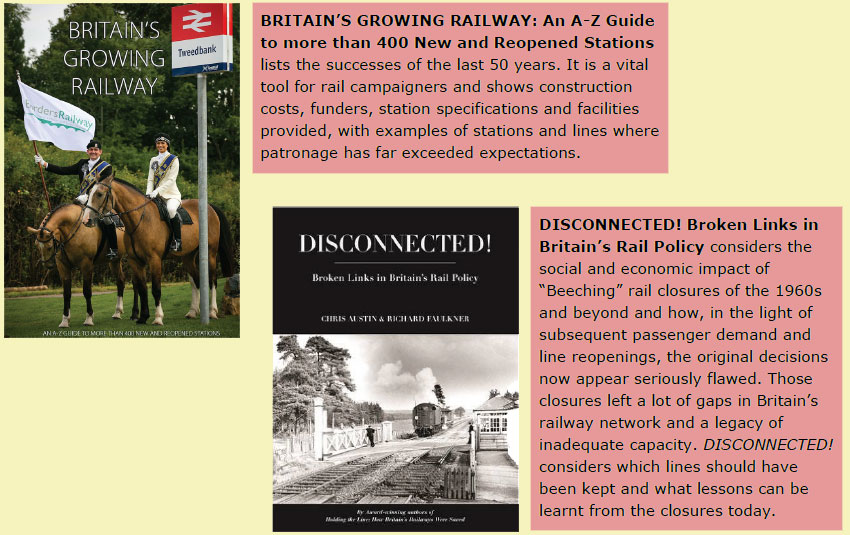
Three weeks later, Mr. Black was good enough to reply thanking me for the books. And that was all.
Again, it has to be made clear that it is not Mr. Black's job to enter into correspondence or discussion with individuals, especially when it involves broad policy matters and the whole direction of the county council. He is a council officer who takes his orders from elected representatives. But like a top civil servant advising his minister, Mr. Black's is the guiding mind for often uninformed and empty-headed councillors. Though Mr. Black occupies a back room, he has a great power to influence what takes shape on the ground.
If Mr. Black were regularly lobbied by the railway industry, and by transport and environmental campaigners, he would surely have to listen and become versed at responding. As it is, rare as they are, he knows that he need not answer letters like mine and obviously he has no personal inclination to defend his position.
C.B.
Appendix: File of correspondence with Dave Black
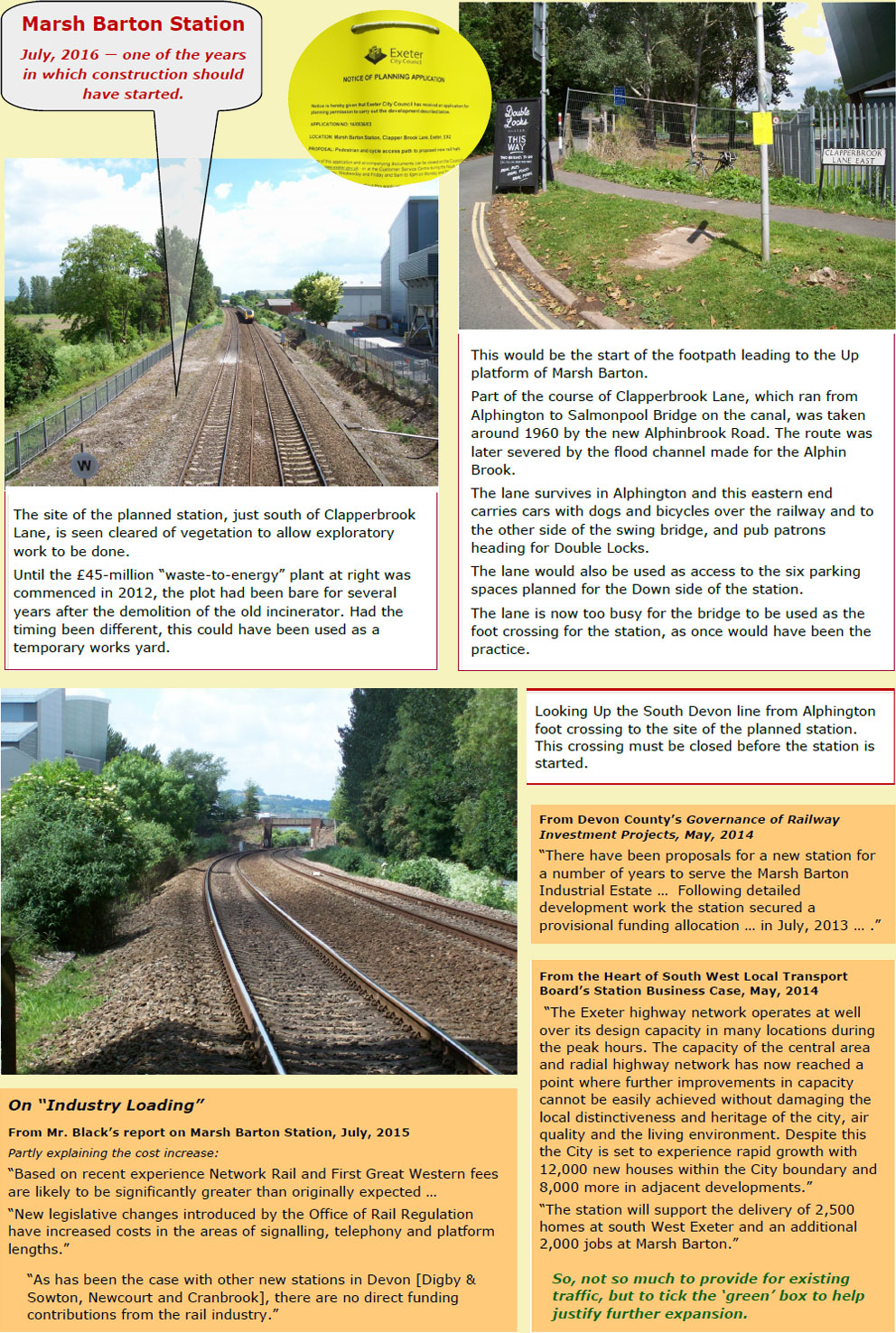
July, 2023: The project which obtained provisional funding in 2013, finally became a reality when it opened for passengers on 4th July, 2023.
The original cost estimate of £4-million, rose to £6-, £8– and £12-million, before being given the go ahead as a £16-million contract.
On 11th May, the station is ready but not yet approved by the spoilt industry; the industry which would once have done this entirely on its own, but which now waits meekly for its "stakeholders" to do all the work.
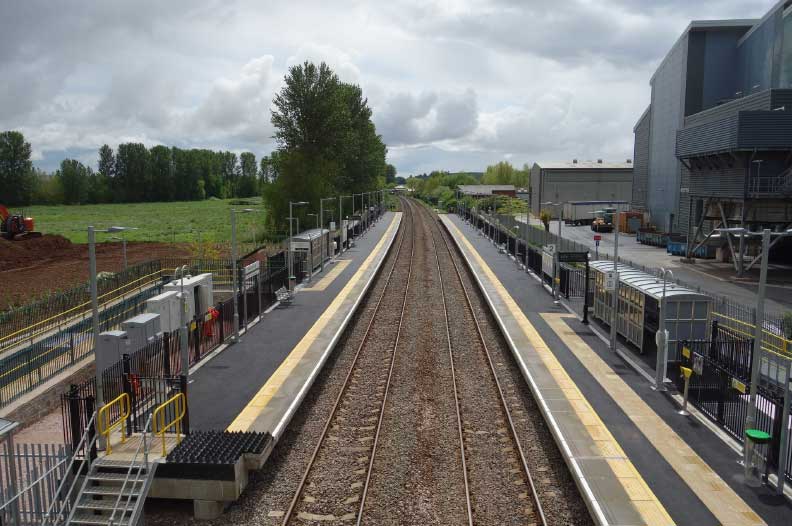
Album of photos charting the construction of the station. Click to see photos in full resolution
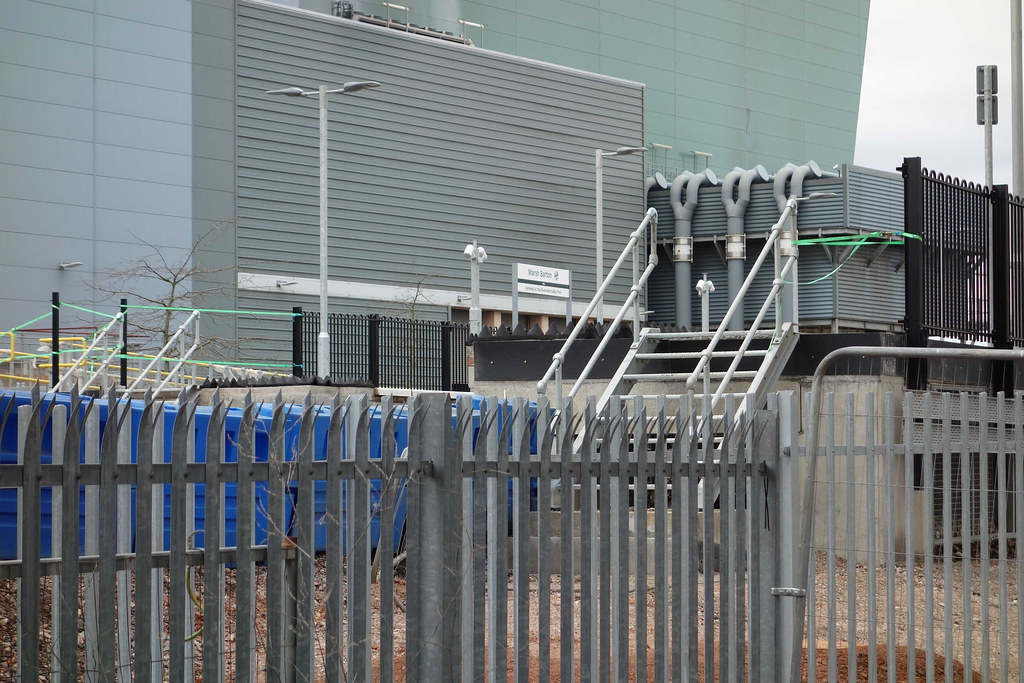
Gridlocked Devon
"I love Sundays … "
In September, 2017, DevonLive, the shared web guise of Exeter's Express & Echo, conducted a series of special reports about Devon's congestion problems and the impact that pollution is having on people's lives.
"Gridlocked Devon will look at some of the major challenges caused by congestion across the county and find out what is being done to encourage people to use other modes of transport."
It was reported that the level of nitrogen dioxide considered safe was exceeded not just in parts of Exeter, Torbay and Plymouth, but also in Newton Abbot and Ivybridge. Emma Brennan, bless her, a Labour county councillor, has suggested closing parts of Exeter to traffic one Sunday a month, encouraging vehicle ownership reduction and raising city centre car parking charges.
The paper's Woodward and Bernstein shone light on the majority of local councils allowing staff to park cars at work free of charge or at heavily discounted rates.
"Despite launching numerous schemes to encourage residents to use alternative modes of transport, council workers are able to park for just £2 per day in an Exeter city centre car park and for free at many district council offices across Devon."
The series began with the Editor and two reporters setting off from Matthew Hall in Topsham to see who would be the first to reach the newspaper's offices in Little Queen Street. One hurried up the road to catch the train to Central Station; one mounted his bicycle; and a third went to find his car. The cyclist got in first, quickly followed by the train traveller. The motorist came in nearly ten minutes later, slowed as much by having to park as by the weight of traffic he encountered.
 The feature culminated with a Facebook debate which contained the usual mix of fair and quite nasty comments. One incensed the E. & T.V.R. scout so much that he went to the Express & Echo offices to complain.
The feature culminated with a Facebook debate which contained the usual mix of fair and quite nasty comments. One incensed the E. & T.V.R. scout so much that he went to the Express & Echo offices to complain.
Remembering the days when the offices and presses were in Sidwell Street and callers could just wander in, and, not so long ago, when the offices were at Sowton Trading Estate, the scout spoke some plausible reason for being admitted into the downstairs intercom. The Echo has followed the same path as the Western Morning News, leaving its central office for a large out-of-town block and then returning to take a small suite of offices.
A young lady took away the scout's screenshot of the offending words and the charming Edward Oldfield, Social Media Editor, came to the front desk. He said that he was equally disgusted but that he had no control over Facebook.
Advantage was taken of the meeting with a man whose stuff the scout had read and a lengthy chinwag ensued which covered modern newspaper production, public transport, cycling and social media. The scout told Mr. Oldfield that he looked much younger than his photo suggested and that his was considered the paper's "voice of reason." It was pleasing that he readily recalled the case of the Bridford parish councillor who was convicted of careless driving after extremely aggressive behaviour towards cyclists on the Teign Valley road.
When he returned to the station, the scout was glad to find that Morts Mortimore's post had been removed.
It did not take long for the railway's webweaver to identify the man who says he delights in putting cyclists in the hedge on a Sunday. Not surprisingly, he had been banned from posting by Facebook before.
Really this should have been a Police matter and it most certainly will be if his name is seen again attached to threatening comments.
The Network Rail Roadshow
"Come and find out the future proposals for defending the line," went the handout.
In November and early December, 2016, Network Rail put on a series of public information events to explain the measures proposed for the defence of the main line between Exeter and Newton Abbot.
The launch was held at the Langstone Cliff Hotel on 17th November and the E. & T.V.R. scout grudgingly went along, knowing that it was all a waste of time. He caught the train from Polsloe Bridge and after riding out to the seafront and stopping to look at the camping coaches, whose future was then uncertain, he climbed the path to the hotel. It appeared that the scout was the only one to have come by train and his was the only bicycle to be seen.
It did not take long to digest what was being proposed and the pie-in-the-sky nature of it; there had already been some release to the press. As the scout entered, a lady from Teignmouth was being interviewed in front of a television camera and she was talking about the fabled avoiding line. And there they were, the vain and the vacuous, lining up to deliver their well rehearsed, but quite meaningless, lines. Even standing as close as he could, the scout found it hard to catch what Tory Clone, Painted Doll and an ex-M.P. who had bought luxury furnishings for his London flat at taxpayers' expense, had to say—as if it mattered.
Eventually, the scout managed to grab the coat tail of the N.R. floorwalker, Uncle Monty from Withnail and I, that Dawlish had transformed from "a P.R. man who worked for the railway" into a "railwayman who has a P.R. job." It was put to him that the amount of work being proposed would never get funding in full and that anyway the timescale would probably see the programme fall apart. He referred to the £10-million just then announced to fund further development of the scheme; exploratory work so far had cost £3-million.
On the subject of bypasses, the scout had heard Mike Gallop (Route Asset Management (Western) Director) tell the Beeb that Network Rail had not ruled out another route but had decided that everything had to be concentrated on strengthening the existing line. The scout put it to Monty that quietly his authority had no intention of pursuing any expansion of the network. He trotted out the untruth that the Southern route would not give such a good service and that one of the factors that stood against it was the need for drivers to have dual route knowledge; he was about to explain what this meant when the scout let on that he was an ex-B.R. man.
"Are there any enthusiastic railwaymen within Network Rail that want to see the system expand into barren country and the railway recapture lost traffic?" the scout asked him. "We're all very enthusiastic," he replied. So the scout drew his attention to the two local stations that were completed well over budget at around £2-million each and the next one, Marsh Barton, whose estimate had now rocketed to over £7-million, most of which, according to D.C.C. reports, was industry loading. The scout put it to Monty that here the industry was the obstacle to railway development. He said that he didn't know much about it, only that Marsh Barton was a "difficult one."
The lady being interviewed earlier collared him about the lack of advertising and the failure to release details of the scheme. Monty seemed surprised and said that an agency did the N.R. advertising (naturally) and found what was by now in her hands on the N.R. web pages. The scout should have jotted down the link because it has eluded him since; this is the nearest that has been discovered:
https://drive.google.com/file/d/0B9x_iW8jXCh_VFh0aHZHSTJlUkk/view
Two publications were available: a leaflet, Exeter to Newton Abbot railway defences: Long-term protection of the railway and the community, and a pamphlet, Exeter to Newton Abbot Geo-Environment Resilience Study. Under "Additional Routes," the leaflet states: "Please note: This study does not cover the possibility of any additional routes into the South West. This issue was dealt with in a separate report published in June 2014, and there are no plans at the moment to build any of the options listed in that report."
Monty told the scout that the "Northern" route was costed at £600-million; but then he also advised that Portishead had been reopened (he meant Portbury). He also put a spin on the electrification fiasco, saying that it was not the disaster everyone was making it out to be. Bless him, he was only doing his job.
Afterwards, waiting alone on Warren platform for the 1827 to take him and his mount back to St. Thomas, the scout recalled being seated on the verandah of a G.W. brake van on the main line in the small hours of a January morning, having got a ride on the Signal & Telegraph's train dropping cable ducts for the Exeter area resignalling (actually, he was paid "rest-day worked").
Just to test the P.R. officer who looked like he enjoyed an occasional drink, in the following week the scout asked if it would be possible for the proponents of additional lines, the E. & T.V.R. and the Okey camp, to have pitches at the next stop on the roadshow, the Rougemont Hotel in Exeter. This was politely refused, which turned out to be a relief because when the scout looked in to see the venue on 28th, hardly anyone was there.
The Rougemont is opposite Central Station but it is still unlikely that any N.R. staff came by train or would even think of doing so, such is their remoteness from the system whose track they manage.
The visit was not without reward. This time the scout was approached by a keen young coastal engineer on secondment from Mott MacDonald who very capably answered every question put to him, including at last the positions of the mystery buoys that gave the fateful warning of extreme wave height back in 2014.
There is in reality only one and it is anchored at 50° 34' N., 3° 24' W., or roughly two miles east of Dawlish. It is managed by the Plymouth Coastal Observatory in connection with the Channel Coastal Observatory and its readings are relayed to shore currently.
www.channelcoast.org/data_management/real_time_data/charts/?chart=103
On the Plymouth Coastal Observatory front page can be seen a picture of a WaveRider buoy, which must not be used for mooring:-
southwest.coastalmonitoring.org/live-waves-and-tides/
The works proposed range from simple flood defences and drainage between Exeter and Dawlish Warren, and between Teignmouth and Newton Abbot, to the quite fantastic ideas for the coastal section between Parson's Tunnel and Teignmouth.
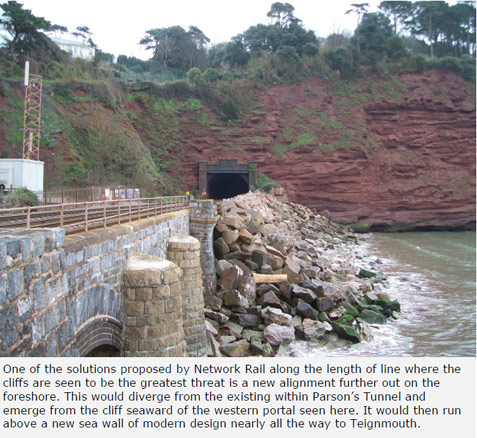
Here, the cliffs are seen to be the greatest threat: a massive slip had to be induced to make them stable just before the line was reopened in 2014. The solution, it is held, is either to reduce the slope of the cliffs, involving substantial land acquisition above them and closure of the line for a year, or the construction of a new alignment commencing in Parson's Tunnel and taking the foreshore all the way to Teignmouth, which would allow the cliffs to be stabilized by toe buttresses of imported material. The latter bright idea would offer the possibility of an additional running line and a path along the undercliff as well as one along a new sea wall.
The track authority has vaguely programmed all the works proposed over a 60-year span and suggested a cost of around £500-million, both of which can be dismissed as worthless estimates.
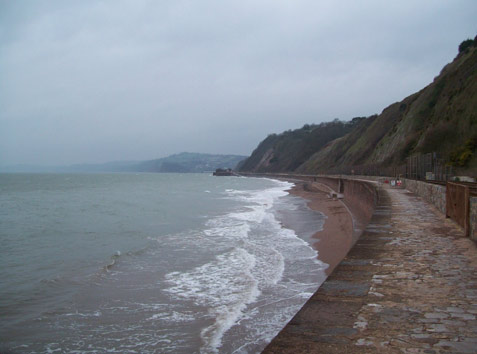
A lot can happen in 60 years; under the right conditions, a lot can happen in six years. More than once on these pages, reference is made to how long work takes today compared with the time it took to build whole sections of line in the first place: three years to build the 22-mile P.D. & S.W. Junction between Lydford and Devonport compared with the 26 years spent to date talking about reopening the six miles between Tavistock and Bere Alston; over a year to make a single platform at Cranbrook compared with the four years it took the L. & S.W.R. to build the line from Yeovil to Exeter.
Almost the entire railway network in the West Country was completed in 60 years. In fact, the South Devon between Exeter and Newton Abbot, with its original seven tunnels was built in two years.
With the fluxion of weather, unforeseen events and human frailty, looking 60 years into the future is hard enough for a seer; it is impossible for an organization that has not yet itself come of age. Since 1921, for instance, there has been no such period without a major change in railway organization; as the present muddle cries out for normalization, more sweeping change is sure to come.
No one knows what nature has in store that may interrupt or set back such long term plans. And with a precarious supply of energy and an overwhelming environmental imperative, there must soon come a time when the railway, along with other public transport, regains supremacy; then all the dither and delay which afflicts it today will be swept aside so that expansion and development become just a matter of demand management and engineering practicality.

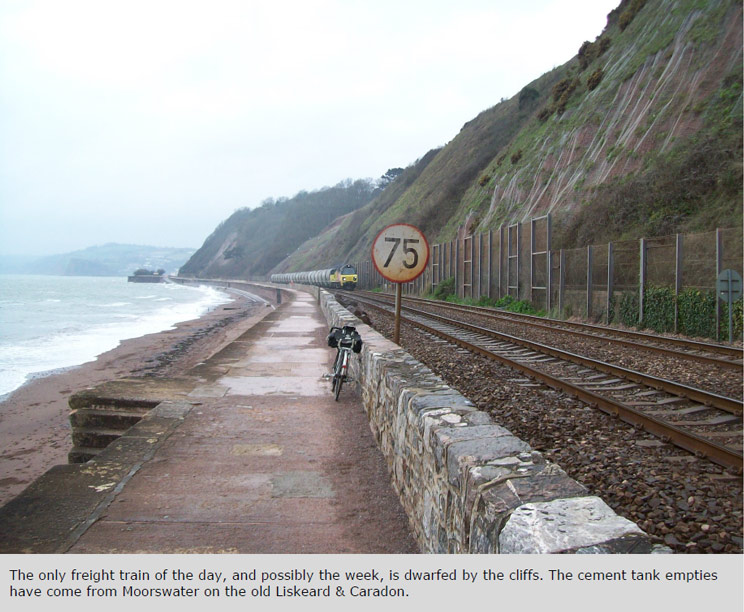
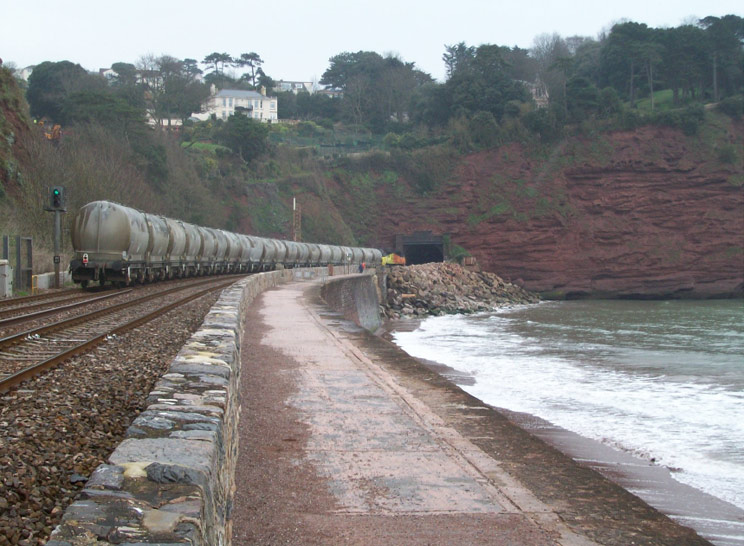
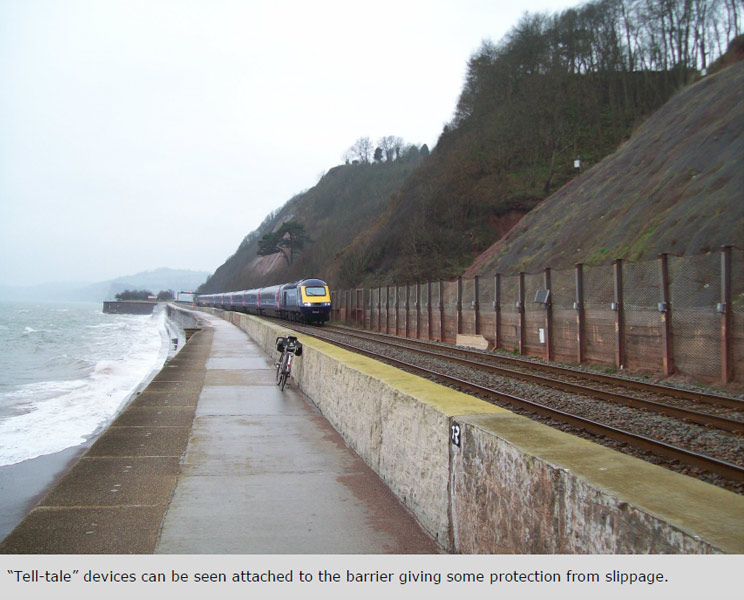
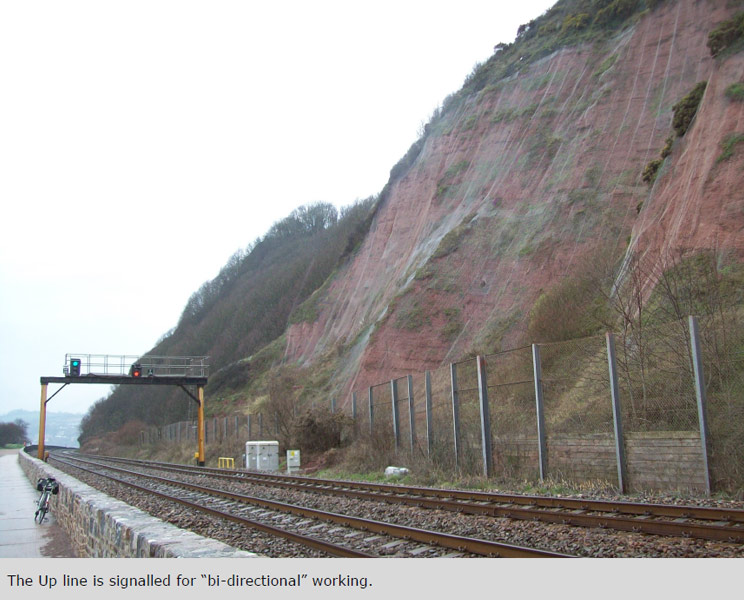
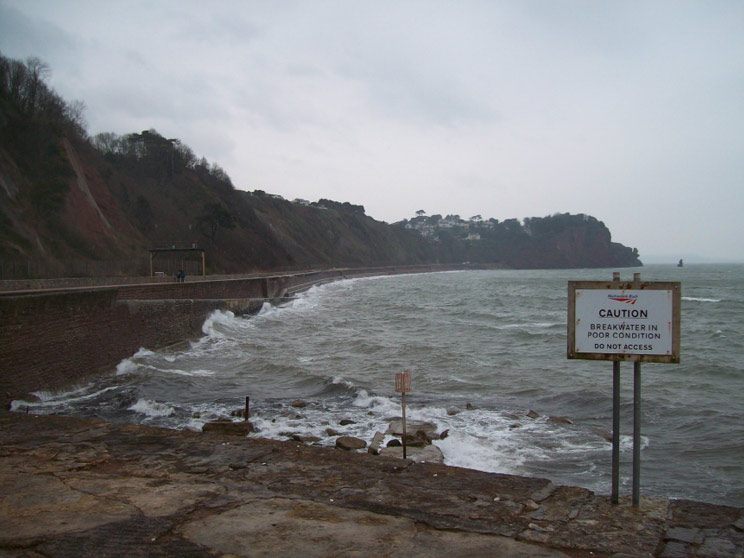
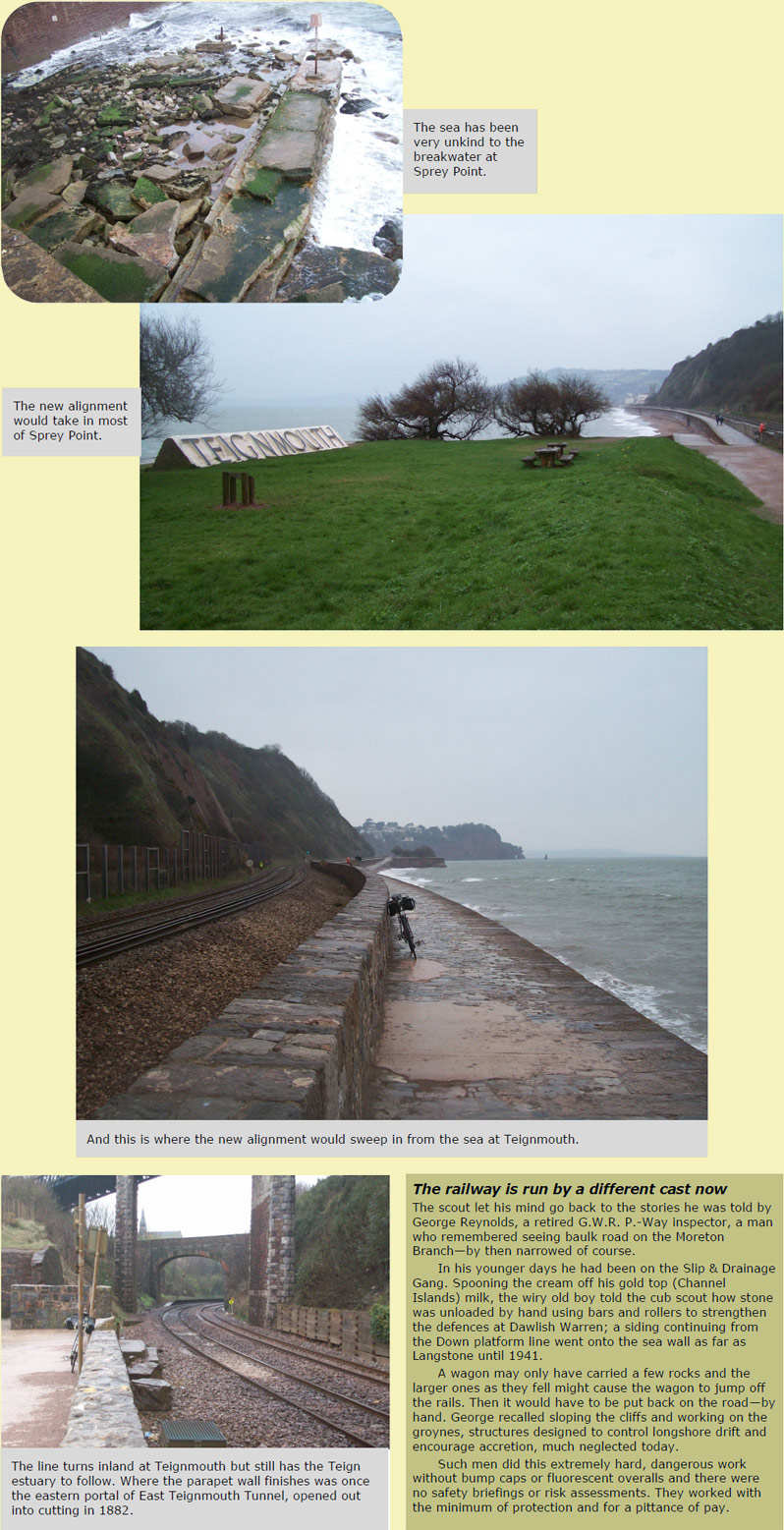
Coping with Perilous Exposure
The danger is that far too much money will be spent on this line and that vastly better resilience than it has now will never be achieved. With worsening conditions, it is possible that no real progress will be made and all the while there will have been no attempt to create route diversity, once a great strength of the British railway system.
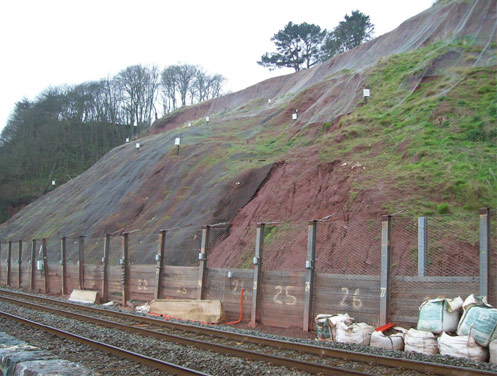
Short of tunnelling behind the cliffs, no amount of work will make this route invulnerable: it only needs to fail in one place to stop trains. As this railway said after the Dawlish débâcle in 2014: "The challenge is to ensure that the existing line has the greatest possible resilience, but to have readily available an inland diversionary route between Exeter and Newton Abbot."
Certainly more must be spent in future than was spent in the years of complacency. The sea defences should be strengthened over time, partly in response to nature probing their weaknesses. The sea wall should be rebuilt to a scientific design in stages over many years. The installation of "tell-tale" systems connected to signalling (already underway as in the figure at right) giving warning of the slightest movement of the cliffs or obstruction of running lines, will greatly improve safety. In the winter months, trains laden with rock armour should be held at Exeter and Newton Abbot, along with dedicated on-track plant in a state of readiness when storms are forecast.
But to provide for intermittent closure, whether planned by the engineer or enacted by the gods, at a moment's notice if necessary it must be possible to divert trains onto bypass routes according to emergency timetables based on the degree of disruption. Not, in the case of the Teign Valley, as a substitute for the main line, but rather—and the comparison is detested—as the series of back lanes that a motorist uses to avoid a pile-up on his quick way home. This is not the route he would take every day but one he knows is there if he needs it.
The Eclipse of Rail
Quite ridiculous claims were made at the time of the débâcle about the damage being done to the West Country economy by the closure of the main line.
Even if the railway is carrying more people than ever before, road traffic has grown to such an extent that it now far surpasses rail on almost every count.
The main line carries around 12,500 passengers a day and there is little other traffic. On the approach to Exeter the railway passes beneath Exminster Viaduct carrying the M5 motorway, and then goes under and over two principal roads into Exeter. The average daily flow of vehicles at these points is:-
| M5 motorway | 84,600 |
| Bridge Road (former Exeter Bypass) | 33,300 |
| Alphington Road | 23,300 |
To company car man, town planner and other such numbskulls, this level of traffic is seen as a measure of human success.; flows of road vehicles are seen almost as natural forces, like rivers. Few see the reality of finite reserves being frittered away in what will be in the end a very short-lived and irresponsible period of excessive and damaging consumption.
A very great unwinding of road transport, brought about by energy and material shortages, if not some unforeseen event, is inevitable. Far from being feared as the end of modern civilization, such curtailment should be embraced as an opportunity for a rational approach to transport provision. It can only be hoped that there will be enough time to plan and prepare, for there is such lack of vision that most will not have seen change coming.
There cannot simply be a transference of all road traffic onto rail and no one should want this even if it were possible. What should happen is that a highly developed, fully extended railway system, powered in the main by renewable energy, encompasses the greatest share of all necessary movement in every direction that it can.
Under these conditions, akin to a national emergency, the need to maintain the coastal railway line and to have what might be termed today 'redundancy,' in the sense that there is always more than one way, would be clearly understood. This would then hasten the decision to begin work.
"the practical railwayman's preference."
The Lynton & Barnstaple Railway's Bid to Continue Reconstruction
"Like the adornment worn by a beautiful woman, this railway will flatter its setting."
In February, 2016, the L. & B.R. applied to North Devon Council and Exmoor National Park Authority for permission to rebuild the line between the existing temporary terminus at Killington Lane and Wistlandpound, to reopen Parracombe Halt and Blackmoor Station and to carry out associated works.
The most long-winded (2,000 words) letter* of support will have come from their friends on the Teign Valley. What else but admiration can there be towards a railway whose spokesman, Tony Nicholson, when asked on the platform at Woody Bay by the presenter of the BBC's Great Railway Journeys about his ambitions, pointed unflinchingly first to Lynton and then to Barnstaple?
* Actually seven, one for each of the applications.
Reminiscence and Rediscovery
The first realization that there had been a narrow gauge "main line" railway in Devon I can still remember: it was in William Henry Smith's in Tiverton around 1969. Finding the David & Charles book on the subject, I turned excitedly to my Father to ask what he knew of the line. His answer was casual, as mine would be today if similarly I were asked about something long gone and I had seen so much else go too.
Not many years later we found ourselves at the recently closed Town Station in Barnstaple and Dad recalled seeing the "toy train" waiting at its bay platform, the edge of which was still there. The line to Ilfracombe was intact, though doomed to destruction as a preservation idea was to come to nothing.
Then, following the course of the little line alongside the River Yeo, we came upon the railway's headquarters and depot at Pilton, then in use by a building firm. Dad asked permission from someone in the former goods office to look around the yard, with all the sheds still in use and their inspection pits visible. A memory which remains vivid, but upon analysis makes no sense, is my going to the far end where the single line went off towards Lynton and seeing little sleeper impressions in the ballast of a fenced off triangle. Was that possible after 35 years' disuse?
A few years ago, realizing that I had not cycled the route since the mid 1970s, I set out to follow it as closely as I could, stopping along the way to look at sites I had missed before. On one occasion, I delivered a modified Permaquip trolley to Woody Bay and spent all day marvelling at the work done so far and following the route to Lynton. After lunch on Lynmouth front, I began the climb back up the notorious hill. Whether I stopped because I was beaten or because I wanted to look over the wall into the gorge, down which the flood waters raged on that fateful night in 1952, shall be open to debate. I could not get going again and as the road was too busy to allow tacking, I walked to the top. On previous occasions I had scaled the path which criss-crosses the cliff railway, so being beaten by Lynmouth Hill should not necessarily be put down to decrepitude.
C.B.
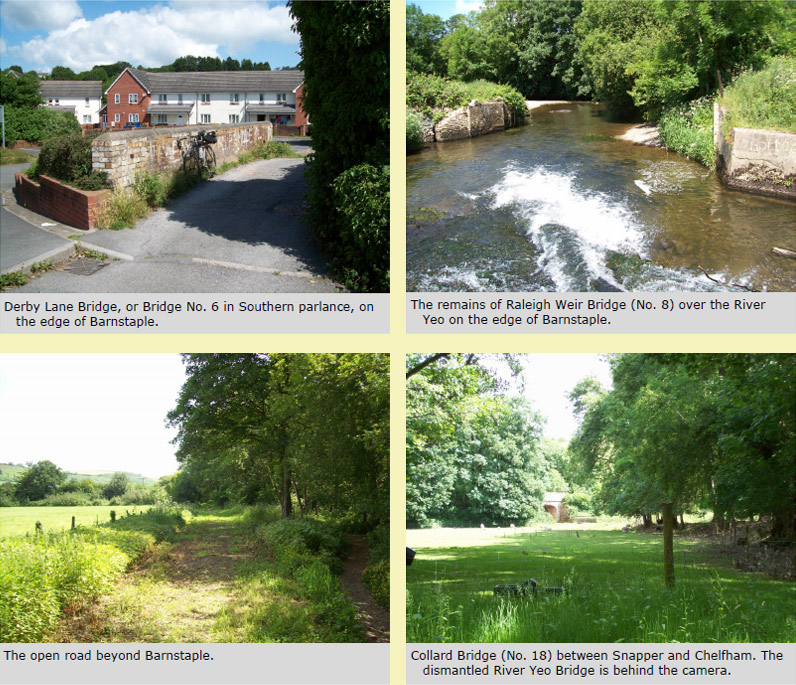
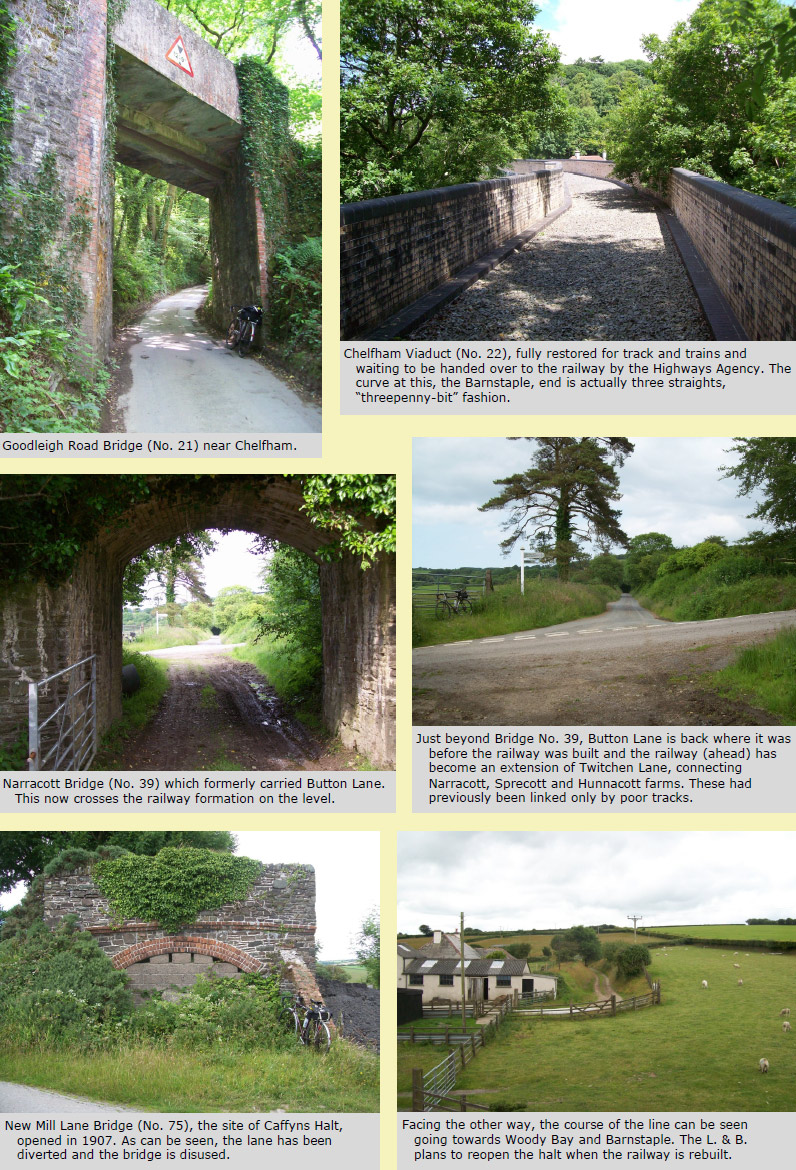
In 1979, having given up my project at Longdown the year before, I was at a bit of a loose end. The stirring in North Devon led me to send £5 to Bill Pryor at Lynton. Nothing was heard back and I resumed my own work. The L. & B. remains the only railway that may have tempted me to forsake the Teign Valley.
C.B.
Following the Débâcle...
After the Network Rail helicopter was seen hovering over Christow while tracing the course of the railway, a scouting party came on the ground to look more closely at the abandoned diversionary route.
Quite naturally, the "pathfinders" called in at Christow where it was explained to them what the Teign Valley line could provide, both in emergencies and in the normal course, given the advances in traction and signalling technology.
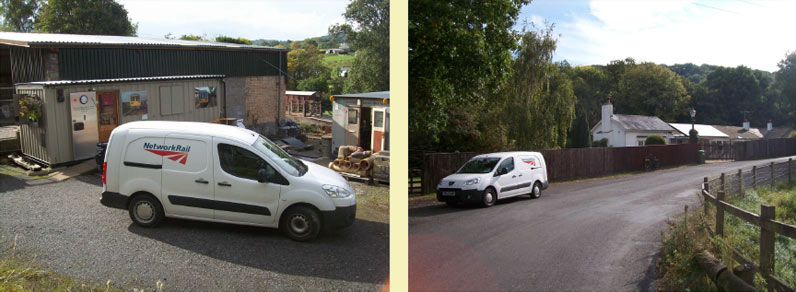


From the 121 comments on an article in

5th February, 2014
By the cheerful StuckinUK4Now
(The other alternative—the former Teign Valley branch from Exeter to Newton Abbot through the hills—is shorter, but was just a pottering country branch line and in no way suitable for main line traffic. Nor are there any significant population centres along that route to make it viable; the largest place it served, Chudleigh, is such a small town that it doesn't even rate a bank branch any more—the last one, Lloyds TSB, closed in 2006. The Teign Valley route would only be of value as a purely diversionary route when the sea-wall route was out of action and would probably 'rust in peace' for most of the time).
UPDATE: Not everyone agrees with the idea that reinstating the Teign Valley branch line is an unsuitable idea; there's an outfit calling itself the 'Exeter & Teign Valley Railway' with grandiose ideas about reopening it as a privately run community line, and seems a touch eccentric! You can view their website here:
Admittedly they don't seem to be proposing it as a substitute for the sea-wall route through Dawlish, but as to the viability of the line which merely served a few villages and one very small town, I stand by my original evaluation above (although I would be happy if the group succeeded in their aims and proved me wrong!)

Sea-level rise impacts on transport infrastructure: The notorious case of
the coastal railway line at Dawlish, England
This paper, recently published in the Journal of Transport Geography, finds that the incidence of disruption has increased, and will increase further, with the rise in sea level.
Some extracts:-
... the Newlyn tide gauge recorded its highest ever water level on 3 February 2014.
... the southwest of England, which is sinking at a rate of 1.1 mm/yr due to ongoing glacio-isostatic adjustment, will experience the highest rates of relative sea-level rise during this century.
Track restrictions run from Level 1 to Level 3 and have a range of impacts on rail traffic from 20mph speed restrictions on the down line to full closure of both the up and the down lines until safety inspections (and any necessary remedial works) have been completed. In-sea sensors provide information to NR staff in advance of severe overtopping events in order to allow them to close the line before it becomes dangerous to passing rail traffic. The events of February 2014 amounted to a spectacular example of a Level 3 restriction, when the in-sea sensors returned the most extreme warning possible, a 'black alert'.
In this study, we assume that the underlying driver of change in overtopping frequency and thus transport disruption is sea-level rise, and thus for the first, empirical, stage of the work, we seek to establish from observations a relationship between overtopping and sea-level change.
During the lifetime of the railway, there has been ~0.20 m of sea-level rise in the English Channel, although nearly half of this occurred during the last 40 years.
... 150 years of sea-level rise has significantly reduced the available 'freeboard' ...
If our calculations are correct, and assuming sufficient maintenance to retain sea defences in their current condition, then in headline terms: sea-level rise of 0.05-0.07 m by 2020 means the average number of DLRs [days with line restrictions] will double to 16-19 per year; by 2060, sea-level rise of 0.27-0.39 m will cause an annual average of 46-63 DLRs; and by the end of the century as many as 84-120 DLRs will occur each year as a result of a 0.55-0.81 m increase in sea level.
By 2060, with high-impact events occurring on average twice a year, the extent to which the railway would be able to maintain a credible service has to be brought into question.
... there is more and more evidence to show that travellers can adapt to a major change in network conditions rather more readily than policy makers currently assume; were such a major change the introduction of a regime or road user charging, rail patronage may increase to the point where such major disruption along the South Devon coast becomes a far greater test of public policy than it is today.
The authors are David Dawson, Jon Shaw and W. Roland Gehrels, from Leeds, Plymouth and York universities respectively.
http://www.sciencedirect.com/science/article/pii/S0966692315002197
Peninsula Rail Task Force
June, 2016
This talkshop, brought to prominence during the Débâcle, has drafted "The 20 Year Plan — for investment in the South West Peninsula Rail Network."
With not a practical railwayman, an environmentalist or a true forward thinker among its half-hearted proponents, the Teign Valley could scarcely find the words to comment:-
"Really? Two years' work by a host of contributors to form a plan to develop the most sustainable form of transport over the next twenty years and this is the best that can be done?"
"The most glaring omission is the need for a feasibility study of the Teign Valley route, not as an alternative main line but as a branch line with enhanced diversionary capacity, the practical railwayman's preference."
https://peninsularailtaskforce.co.uk/
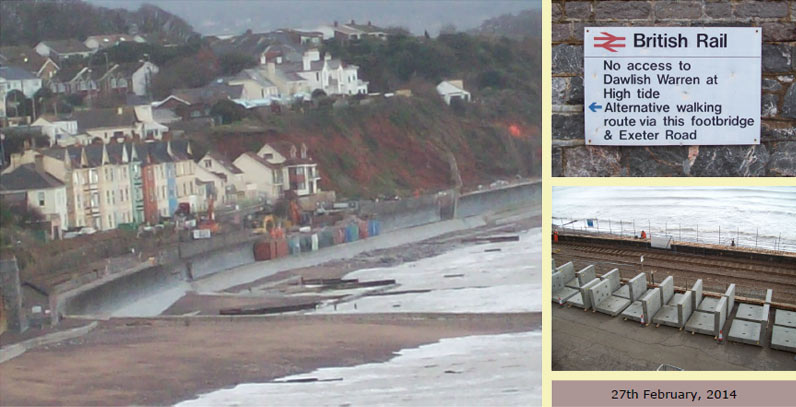
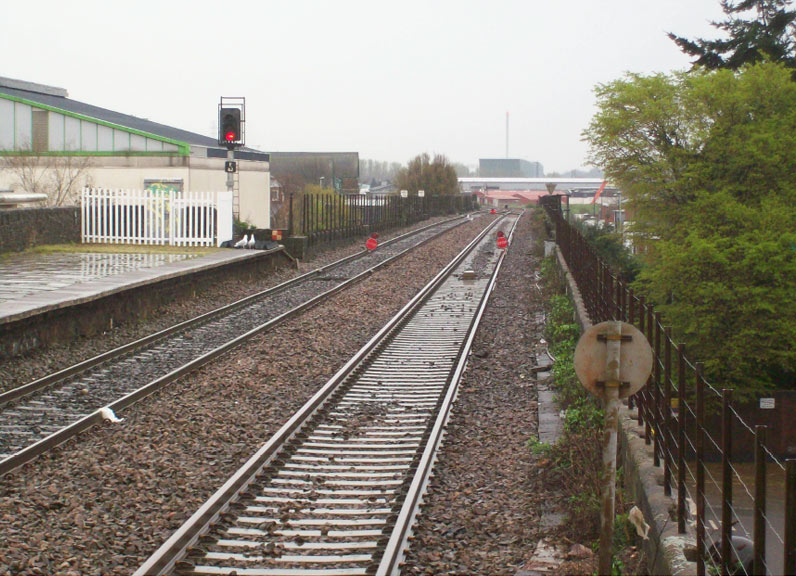
BLOCKADE (telegraphic code for "All lines blocked at...") Exeter St. Thomas, 3rd April, 2014.
Exeter Railway Junction is just ahead and what is left of the Teign Valley goes off where the crane jib is seen.
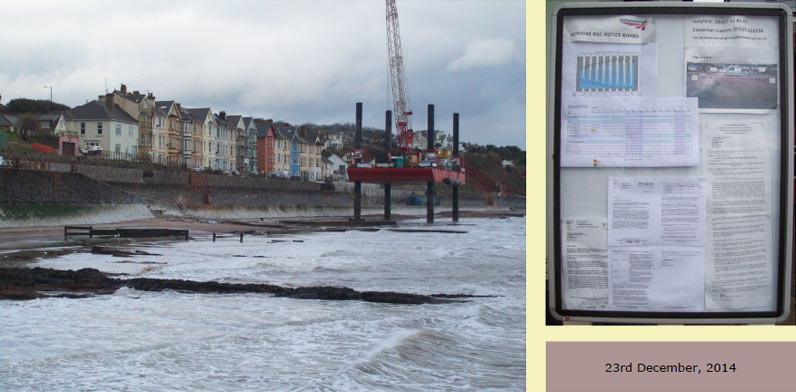
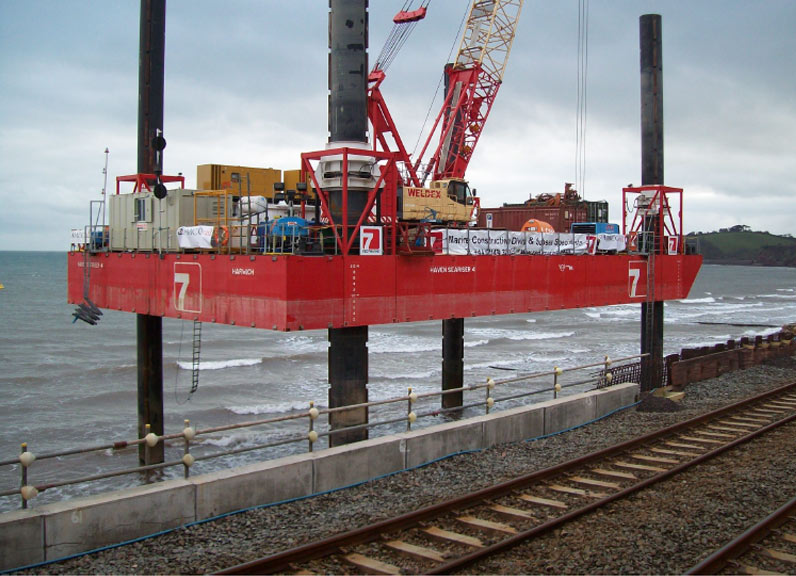
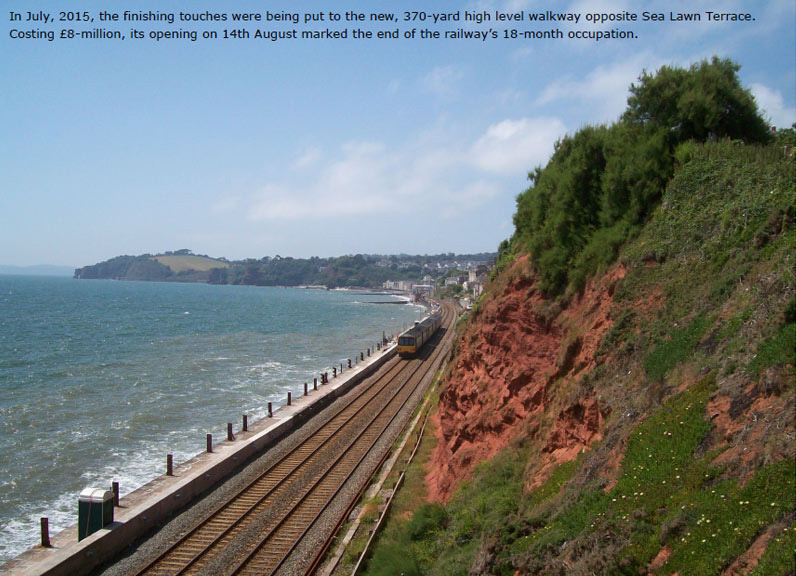

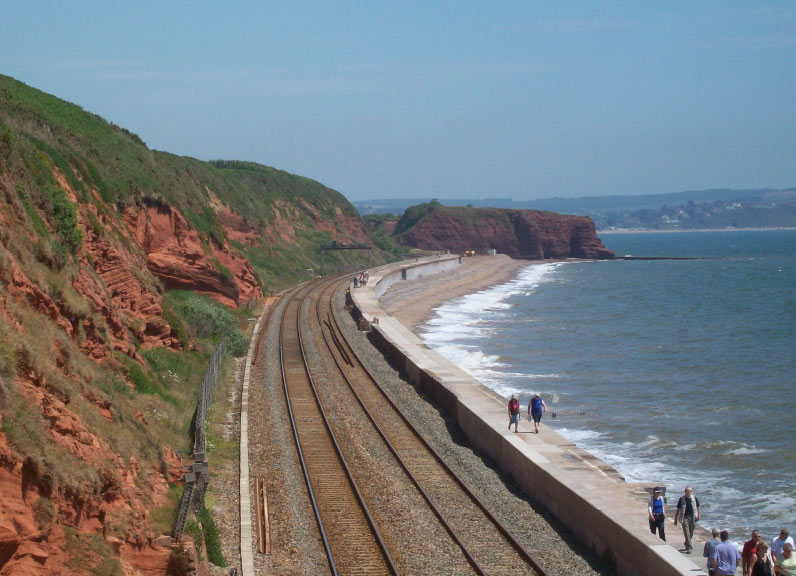
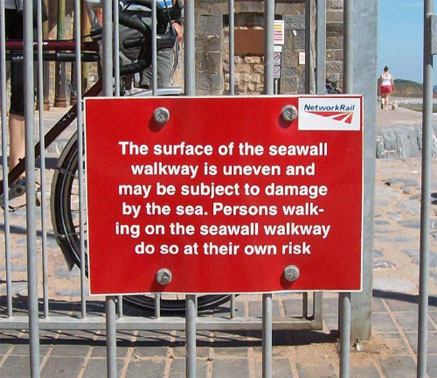
August, 2016
Even the theoretical 200-year storm, which the wall has not yet had to face, should not harm this mass of concrete.
But the train service remains vulnerable. As the railway said in its case for reopening the inland railway route: -
"Disruption will not just occur when there is damage to the sea wall or the track above; there will be many occasions when white water alone will temporarily curtail the train service. Even where Network Rail has poured 5,000 tons of concrete, the line can still be lashed by waves."
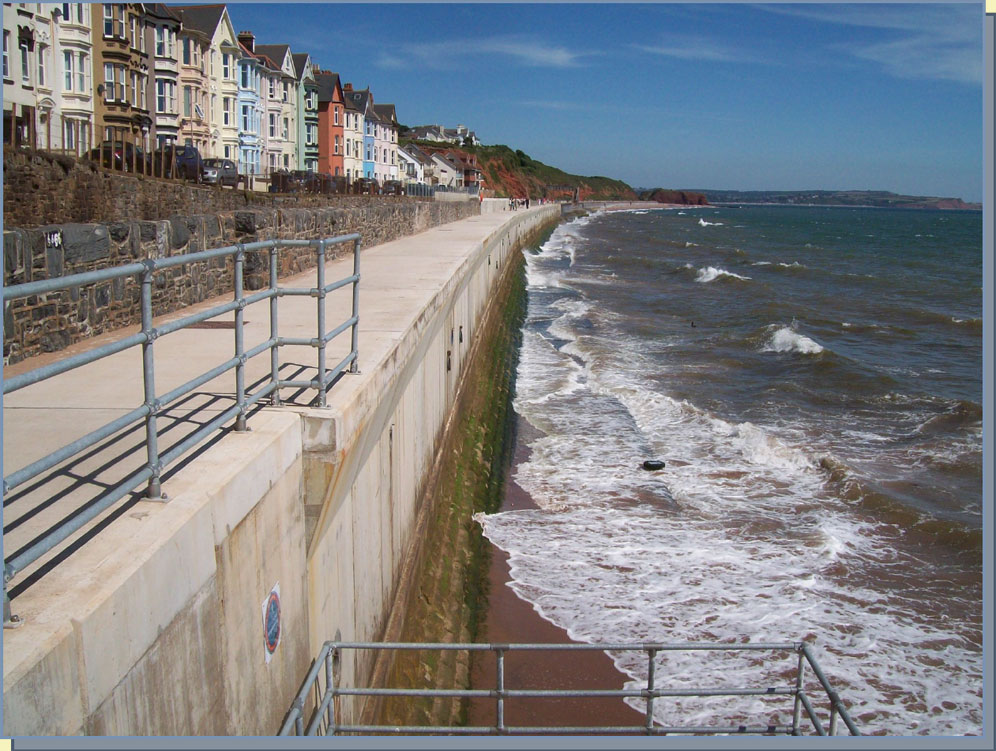
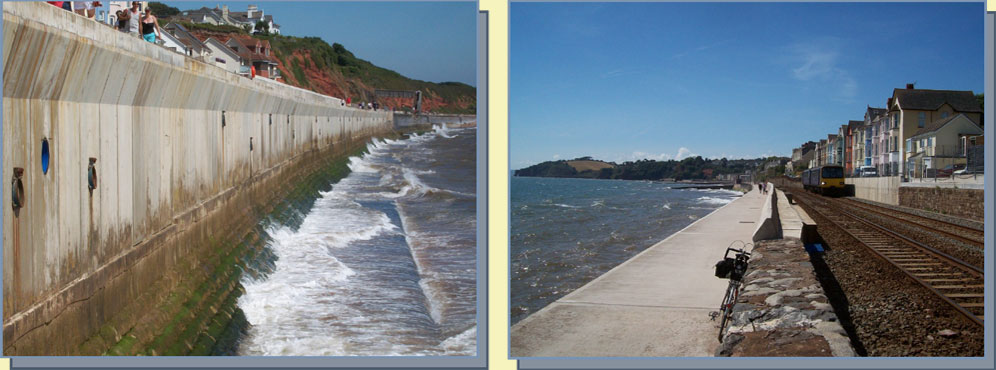
Great Western DNA Found
Mad geneticist recreates extinct railway
Rather like in the crackpot film where incomplete dinosaur DNA is made up with strands from a frog, the new Great Western has been genetically engineered out of a bus company.
Of course, the idea that any semblance of the Great Western Railway could be resurrected just by corporate rebranding is as ludicrous as the queen claiming to be the "Empress of India."
What has been done is a brazen-faced example of repositioning. A tarnished name rhyming with worst has been dropped and an historic one adopted, with all its associations in the public mind.
There is no need to say more than has already been said on these pages about the old firm, but the excuse will be taken to mention some aspects of the Great Western which may serve to show how very different the company was.
Two pieces concern Francis Mildmay, the 1st Baron Mildmay of Flete (1861-1947),
a director of the Great Western Railway
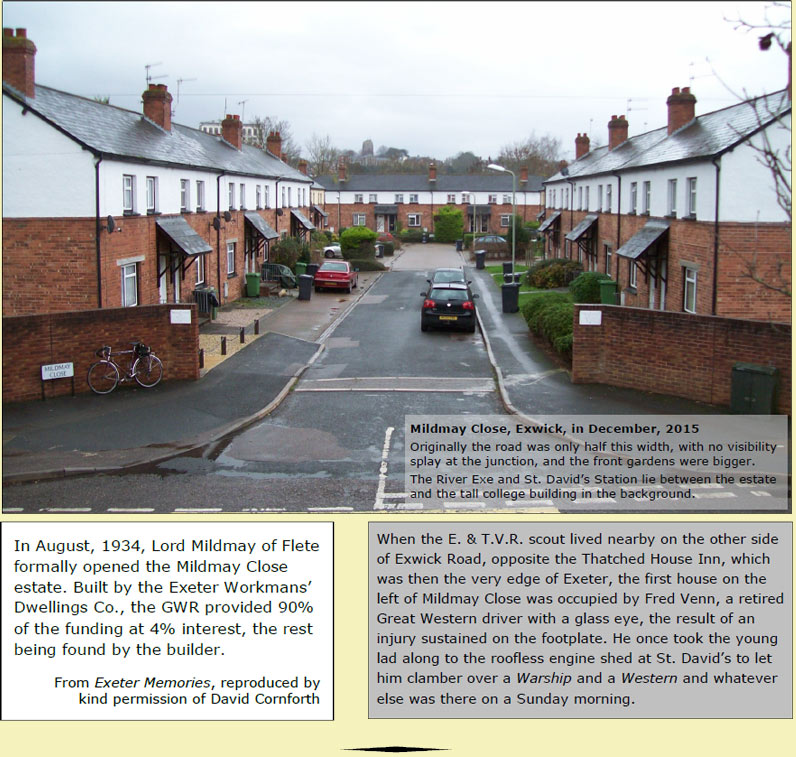
At the opening of Newton Abbot's lavishly rebuilt station in 1927, Lord Mildmay, accompanied by the Chairman and Deputy Chairman, the General Manager and most of the chief officers of the Great Western, said that the town had no fewer than 900 employees and that as the largest business the company paid the most rates, adding that unfortunately much of what was contributed had been spent on improving the Newton Abbot to Torquay road.

The improvement that Lord Mildmay referred to and the volume of traffic being sped on its way were minimal when compared with the modern madness. Yet there was keen awareness in railway board rooms that the growth of motorized road transport since the world war was already taking goods and passengers off rail and the worry was that the losses would increase, as the interloper had burst forth with little or no regulation, with costs heavily slanted in its favour.
Today it has gone to opposite extremes. Road "improvement" has resulted in a new £110-million dual carriageway between Newton Abbot and Edginswell, at the outskirts of Torbay; while rail “rationalization” has left Newton Abbot as a gaunt remnant of a grand station and the branch to Kingswear sold off beyond Paignton. It must be said that more passengers use Newton Abbot now than when Lord Mildmay made his speech, but the place is devoid of the many complementary functions which made the railway a general purpose transport system.1
Since the cruel abolition of the Great Western Railway at the end of 1947, what protest has there been from the industry at this reversal of supremacy? There was none under government control and the hope that some of the old fervour may have been restored by denationalization was unfounded. In a disintegrated industry, which element should speak up for rail as a system?
When the valiant Kingskerswell Alliance2 was promoting its case against the link road, which included the proposed reopening of Kingskerswell Station and improved train services, did the group have an ally in the railway? Did the rail industry criticize the inequality of transport expenditure and point to the unsustainability of continuing to provide for a fossil fuel-dependent mode? Was any alternative rail transport plan forthcoming? No. There was not so much as a whimper, a muttered aside or even a sigh of despair throughout the whole process from what may be termed a railway voice.
If Lord Mildmay's equivalent in a modern trains company management, say Gaz of Pleb Street, were to take his family to Torbay for a holiday, instead of somewhere like Marbella, would he detrain from a Pacer at Paignton and do without his car for a fortnight, or would he, like almost everyone else, tear down the new South Devon Link Road and never go near a station, except maybe to ride the steam train to Kingswear?
1 It is not to downplay the efforts of modern train operators to attract passengers, pointing out that to some extent increased patronage was inevitable. There is a far greater population than there was in 1927. In the course of work or the pursuit of pleasure, there is much greater mobility. There are many more students; older people travel more; there is “disposable income.” And part of the shift to rail must have come about because of the misery of being on the roads, despite continuing massive expenditure.
2 http://media.freeola.com/other/19776/kingskerswell-bypass-alternatives.pdf

General Buller, 1905
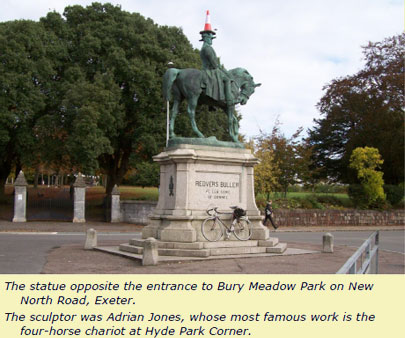
A glance around any modern construction site will often reveal the range of lifting and handling equipment which makes light work of what was once only accomplished by plentiful manpower and tackle.
So bringing up the story of how General Buller's statue came to be at the junction of Hele Road and New North Road in Exeter is not to deny the reality of today's methods, but to question why, given these advances, the railway no longer does anything in this field.
It was during one of rail historian Amyas Crump's fascinating "down memory line" slide shows that the writer first heard how Buller's statue was delivered and put on its plinth of Cornish granite in 1905.
The 4½-ton bronze was taken from the founder, A.B. Burton of Thames Ditton, to Brentford Dock, where it was loaded to rail on a Friday afternoon. A gang was sent from Swindon to offload it at Exeter goods yard, carry it up St. David's Hill and erect it on its plinth. This was done, ahead of schedule, by Sunday noon. "All in a day's work," it may be said, for a general purpose transport system.
If this were to be mentioned to managers of the mucky outfits that run the modern railway, they would no doubt scorn the idea that any transport service beyond what is offered today should be their business.
These rootless, soulless types may go so far as to join the highway kings in arguing that had motor transport been developed earlier there would have been no need for railways; that railways were only an intermediate stage between waterways and the pinnacle of human achievement that is modern road communication.
But, to a great extent, the meteoric rise of road transport, aided by youthful vigour and in no small way abetted by a clear run politically, tended to slow development of the older industry, already burdened as it was by an accumulation of onerous legislation. In very many areas, what was introduced in later years on the railway was never sufficient to enable effective competition and the ingenuity of road vehicle designers saw little equivalent on rail.
Had the railway's combination of infrastructure and ability, established over the course of a century, been the foundation for progress which kept pace with, or even outpaced, the road competitors, today there most certainly would be wagons and handling devices making use of new technology and freight trains running at up to 75 m.p.h. over much of a very extensive network, serving myriad sidings and complexes. Manufacturing and commerce would have been attracted to stations and linesides on the promise of good rail communication, often helping the fortunes of less busy locations. The railway would have its own supporting road services extending its reach to the outlying doorstep or gate. Stalking salesmen would not miss new sources of revenue and skilled staff at every level would keep traffic on the move.
Just as importantly, had the railway's political representatives been as strident and demanding as those of the road interests, it is also certain that rail transport's position would never have become so diminished and road transport would never have gained such an advantage; particularly at a time when environmental concerns should have worked very much in rail's favour, keeping traffic off the roads as far as possible and making the best use of energy.
The railway's undignified retreat was not the result of a normal, healthy transfer of power, as happens when an inferior system yields to a new superior. With the inherent advantages of the mode—its private reservation and free-running vehicles—a natural state would have been one in which rail captured the bulk of traffic beyond the very local and road transport did what it does best or can only do.
Maybe the railway would no longer be placing statues of old colonials, but it would surely be doing a great deal more than it does today.

Station Road Bridge, Exwick
In 1974, not long after the E. & T.V.R. scout had cycled over it, the old lattice girder bridge on Exwick's Station Road collapsed into the swollen River Exe. The abutment on the station side had been weakened by the floodwaters.
Station Road was not half as busy in those days and the bridge was narrow, with no pavement.
Just next to the landing was the five-lever Exeter Goods Yard signal box which controlled the goods avoiding lines at Exwick Crossing. There was a crossover partly in the road and points led to the cattle pen and grain sidings. The road crossed the four (there had been five) goods yard sidings and movements were made on these with only the protection of the shunter; the gates of Red Cow Crossing were not shut in conjunction.
When trains were accepted on the avoiding lines, a tall gate, hung from the end of one of the girders, was shut, causing pedestrians and vehicles to queue on the bridge. Fortunately no one was on the bridge when it collapsed.
Under the watchful eye of green-carded, "Special A" signalman, Arthur Finch, the E. & T.V.R cub-scout felt very important when bringing a freight train nearly to a stand, before pulling off the one signal—both home and starter—the indication to the driver that the "permissive" block section ahead was occupied.
For more than a year there was no through traffic over either crossing; a "bailey bridge" was erected downstream for pedestrians, a great relief to the scout who had had to cycle around the blockade to the station from his then home in Exwick.
The new bridge girders were brought on a special train of GIRDERs (POLLENs, in G.W.-speak), wagons that were effectively bogies coupled only by their load. The girders were craned into position from the train; if it is assumed that the manufacturer had a rail connection then this load may never have touched a road.
All right, so this was not undertaken in Great Western days, but the men whose expertise made it possible were worthy successors of earlier railwaymen, which breed is now extinct.
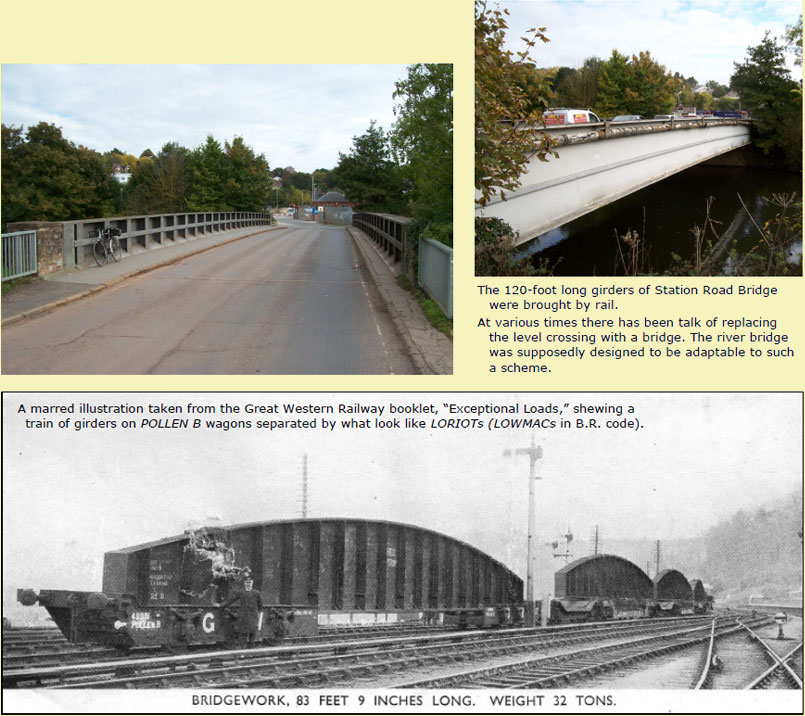

The Versatile Crocodile
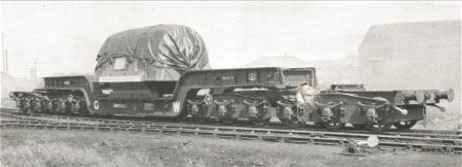
While the "Exceptional Loads" booklet was out, it couldn't be resisted mentioning the Great Western's largest wagon, the 120-ton CROCODILE L, with interchangeable "straight" and "well" girders.
It is not stated whether the wagon had "cross traversing" gear, but the two later 135-ton TRANSFORMER trolleys introduced by B.R. certainly had this facility, enabling loads to be shifted a foot on either side so as to pass obstructions. This would more likely have been required on curves where the "centre throw" of the wagon would have put the load "out of gauge."


A 1962 British Transport Films documentary, "Measured for Transport," shows one of these wagons, B901800, carrying a 123-ton transformer from Llandudno Junction to Blaenau Ffestiniog, where it is offloaded by Pickford's and taken to the Ffestiniog Power Station, a pumped storage facility then under construction at Tan-Y-Grisiau. Although the manufacturer, Ferranti of Manchester, went bankrupt in 1993, its transformer is still in service.
https://www.youtube.com/watch?v=afvGStYT9xI
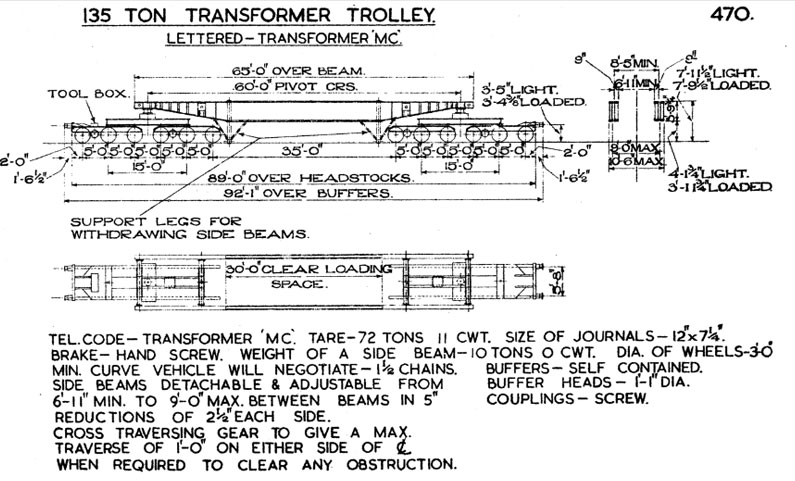
The railway workshops which built these specialist wagons were only a part of a great organization that made not just the movement of very exceptional loads possible, but also the despatch of demanding consignments of all descriptions a matter of course.
There were the loads inspectors who advised on the selection of rolling stock and how to support and secure loads, and who travelled around to see that the vast array of goods offered to the railway for carriage was loaded safely, bearing in mind that its transit usually would put it in close proximity to fast passenger trains.
In back offices, train planners would find paths for slow-moving specials and route them according to their restrictions, and controllers would see that all took place as booked, balancing the competing demands of the train service.
The engineer would know the gauge limitations of his district; he could perhaps arrange to move a lineside object and use his judgement to permit an excessive weight to pass over a bridge or culvert at reduced speed.
Staff along the line understood how traffic was shifted; they knew the dangers present and the precautions needed. Guards would have the sense to tug on a chain or rope or to feel an axlebox as they cast their eyes over loads. It was not just signalmen who kept watch from their boxes: it was the rule book duty of all staff to observe the passage of trains.
With operating flexibility and route diversity, the presumption was that if it were physically possible, a load would pass by rail.
Then the state started to undo this colossal organization. First the network was drastically reduced. The expertise and the equipment that had made possible a complete freight transport system inevitably soon followed; the 1970s example above must have been one of the last.
Today, the railway is a transport system that does not even serve itself: heavy construction materials to the smallest consumables are carried by road; managers drive everywhere; a vast fleet of lorries and vans adds to road congestion; and traincrew is routinely taken around in taxis.
On the continent, a huge number of lorries is carried on rail routes termed "rolling highways." Here, locomotives, power cars and carriages are put on lorries, often to depots not even rail connected.
And the graduate halfwits that have charge of the system, the men who imagine themselves descendants of the original Great Western, do not see it as lamentable failure that the railway which once shifted the traffic of a worldwide trading empire and of two world wars, which lifted whole farms and factories and dealt with massive seasonal or emergency rushes, cannot now carry its own toilet paper and post, and treats a surfboard or a cycle as a problem.
The muddle of modern Italy compared with the splendour of Ancient Rome
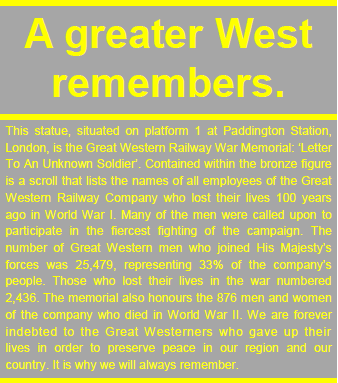
Last year, a series of billboard and newspaper advertisements was run by First Great Western which vainly attempted to claim that the passenger train operator was somehow a descendant of the Great Western Railway Company. The high―or low—point of this campaign was the full page image of Paddington's Tommy statue on 11th November with the implication that the company men who gave their lives were the same "Great Westerners."
Leaving aside the morality of using the war dead as part of a promotional push, it must be said that the people behind it meant well in trying to revive a name and create lineage. Their efforts should not be wholly condemned.
For there is no doubt that First Great Western has amongst its staff many enthusiasts, or people who are merely eager to please or be co-operative. It was such men who made possible the "money shot" of a Class 142 D.M.U. carrying a Christow destination board traversing the junction points at City Basin. It was friendly nutters who enabled the E. & T.V.R. scout to hop on a special train at Cranmore and tick off his last Somerset station in style. A pleasant fellow whom the E. & T.V.R. met recently was the F.G.W. manager responsible for the return of some named trains and a G.W.R. monogram on the Mark III refurbs. It was Rebekah Hartley, a First stewardess, who organized the Santa specials to Heathfield and gave the railway a pitch in the booking hall at Newton. And these must be only a few of the total.
But it should not be offensive to these good people to state the truth: a contemporary train operating company running a mono-function franchise serving 270 stations, having very little control over any more than day to day operations, is not the same thing as the huge, multi-purpose, unitary organization which, in 1947, really could go right back to the men who gathered at Temple Meads in the reign of William IV.
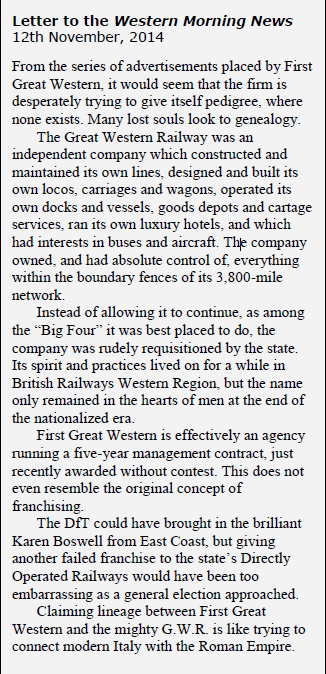
 Instead of pretending that there is a connection and searching for succession in the emptiness, enthusiasts should learn and speak the truth about Britain's railways; about how badly they have been treated and the unfair advantages given to other modes. By far the greatest tribute a young devotee can pay the old firm is to strive for the railway that the Great Western would have become, had it been allowed to continue unfettered its long development into the modern era.
Instead of pretending that there is a connection and searching for succession in the emptiness, enthusiasts should learn and speak the truth about Britain's railways; about how badly they have been treated and the unfair advantages given to other modes. By far the greatest tribute a young devotee can pay the old firm is to strive for the railway that the Great Western would have become, had it been allowed to continue unfettered its long development into the modern era.
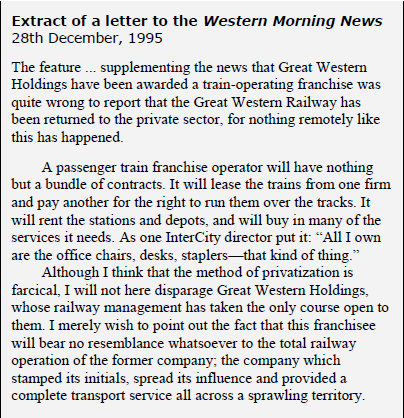
With its fate by then known, in 1947 the Great Western Railway published its final title, Next Station: A railway plans for the future.* It was full of bold ideas for the development of the manifold parts of the service. Some plans were firm and ready for execution, others only vague in outline. This was at a time when the railways had just emerged, worn out, from six years of war and when materials were in short supply.
The writer was the talented Christian Barman, recruited from London Transport. A flavour of his style can be tasted in these words from his Conclusion:—
"To improve the service to the traveller, to raise it to the level of the knowledge and the potentialities of our time, is the governing purpose. More and finer trains; brighter, cleaner compartments with stronger and better distributed lighting; stations worthy of their important position in the general civic scene; trains and stations from first to last an example of good taste, good craftsmanship, a fit environment for gracious living; such are the objects this Railway has set itself for the years immediately ahead. New coaches are to be built at the rate of some two or three hundred a year; at least twenty new stations are on the first programme. For the industrial community there are to be 2,400 new freight wagons by the end of 1947, thirty-one modernised goods stations, and new types of organisation including a network of thirty-four concentration points for the overnight delivery of small consignments of goods."
Nationalization put an end to the Great Western Railway and its plans for the future. Next Station became its valediction.
* A facsimile reprint, The Great Western Railway's Last Look Forward, was published by David & Charles in 1972.
Greens too green to govern?
Their supposedly being strong adherents of the most sustainable form of powered transport, the circulation list for the 2014 summary of the case for reopening the Teign Valley contains five Green Party recipients. Four of them were individuals, who received tailored letters, and three were sent the railway's latest collectible, a computer mouse mat.
There has not been one reply.
A local person with some knowledge working on an environmental transport project who raises a local issue having a strategic bearing, it might have been thought would attract Green Party people, eager to find pegs on which to hang their policies.
Unless, that is, their position is purely theoretical and they do not want to sully it by applying doctrine to the complexities of the real world.
The local green (or transition) group also seems determinedly to ignore the railway, which is partly its own fault for having made no approach.
At the inaugural meeting about climate change held in the village hall some years ago, a woman who had arrived in a chunky-tyred Renegade, or somesuch, was heard bawling into her walkie-talkie: "No idea what it's all about. But everyone's here, Darling!"
All right, so that's made up. But another event was judged a success because the car park was full. Er ... the corner will be turned when an environmental campaign meeting is well attended and the car park is empty.
A circuit environment preacher spoke at a meeting not far from the railway and it was reported that "he gave us much to think about as we drove home" (past the closed station).
Or is it that they do not do paper, believing that the vast infrastructure of the worldwide web has less impact than the faithful, human postie?
Or maybe they do not like "preferably in private ownership" in the summary. It is Green Party policy to renationalize the railways and so members do not want to heed a railwayman's warning that far more important than ownership is the structure within which railways operate.
Transport is such a colossal subject, like many others, and so intertwined, that even good environmentalists most often shrink from gaining an understanding of it or making any attempt to tackle the global problems, and instead busy themselves with microcosmic stuff that makes not a scrap of difference, other than to make them feel better.
To the green gabblers, the smallest changes are always the most meaningful.
November, 2015: Since this was written, but not as a result of it, David Bailey of Dawlish has been kind enough to reply, agreeing that the Teign Valley route should be reopened.
Ownership of the Railways
A brief comment
A non-dogmatic position is taken with regard to nationalization of the railways. It was said from the start, and the view has been held unshakably, that the method of denationalization was effective sabotage.
But the state has been a poor custodian of the railways. Up until the First War, government, without having contributed a penny towards the development of the system, increasingly regulated the private companies but did not interfere with their management.
Two crippling world wars, the failure to allow the railways to compete on equal terms between the wars, a botched nationalization, the destruction of the universal service given by an expansive, general purpose network — which held the promise of being developed into a modern, versatile, sustainable system — and the eventual enslavement of government and people by the road interests, has led to a fear of state control. However, it is accepted that it may be the only course out of the present shambles.
Ownership of the railways is less important than the framework within which they operate. If government faced up to the future, it could, almost by the stroke of a pen, alter the direction of transport provision, towards the public systems and away from what is really only an aberration thrown up by cheap oil.
In the opening remarks on these pages, it is asked what might the balance of transport be today if the railways had been able to stick up for their system in the same ruthless way that the road transport lobby has done throughout its ascendancy.
Heathfield Station
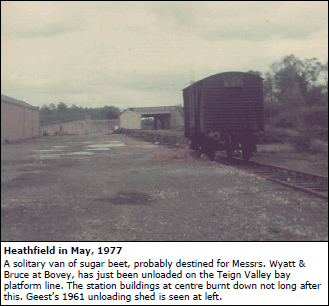
A few years after Teignbridge District Council published some policies in its Local Plan supporting and encouraging the retention of the branch line between Newton Abbot and Heathfield, and supporting in principle a proposed road/rail interchange at Heathfield, the newly-denationalized and disintegrated railway industry, in the form of the Property Board, determined to thwart any ideas of station development at Heathfield by disposing of nearly all of the land adjoining the remaining tracks, including the formation of the Teign Valley Branch as far as Bovey Lane Crossing.
On 14th February, 1996, at a non-descript chain hotel on the outskirts of Bristol, the E. & T.V.R. scout, who had walked from Stoke Gifford Station (Bristol Parkway), heard 40 lots go under the hammer, each no doubt with its own story to tell. The land at Heathfield fetched £48,000.
Before and after the event, this railway wrote to authorities, elected representatives and pressure groups, drawing attention to the folly of the sale at Heathfield. Replies regretted the action of the Property Board, but of course nothing could be done to abort the sale or, as it turned out, to have any control over how the land was used afterwards.
Since then, this railway has simply observed the changes, most of which have become established under the ten-year rule.
>> Appendix: A selection of items from the file >>
>> Special Trains on the Moretonhampstead Branch >>
When the photograph above was taken, there was a big sign between the carriageways of the A38 pointing to Heathfield Station, and it was possible to pass from the westbound direction into Bovey Lane and Station Road, a manoeuvre that would today horrify a traffic engineer. The gap was closed in the early 1980s, but the E. & T.V.R. utilicon did more than once cross the grass to avoid going to Drum Bridges and back; there were no crash barriers then and much less traffic.
A bridleway bridge is now being built at the same place, but this has nothing to do with the station.
Twenty years before this photograph was taken, three passenger trains, waiting to depart from their respective platforms for Newton Abbot, Moretonhampstead and Exeter, would have been a regular sight.
Within twenty years of 1977, despite by then being the subject of vague planning policies supporting the idea of reopening the station in some form, all this land had been sold off as part of a scorched-earth, asset-stripping retreat by the rail industry.
And twenty years on from that sale, what future has the station and the rump of the branch line to Moreton, now further truncated to one engine length beyond the loop at Heathfield?
After a long period of disuse, in 2011 the line was revived for timber traffic ex Teignbridge, and Heathfield's loop is now used for running round. But this movement was only meant to last for three years.
In February and March, 2014, the line was in the news because it was part of the former diversionary route. Heathfield was highlighted on television screens and front pages all over the country, while ridiculous speculation went on over ways of avoiding the storm-lashed coast.
Teignbridge District Council's current local plan policy statements, considerably reduced from the heady heights of 1995 (see Appendix), now hint at what the future may hold.
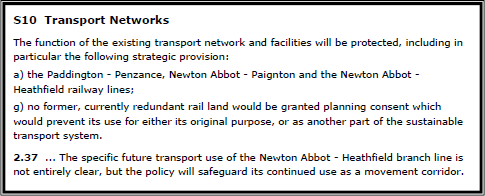
Devon County Structure Plan, 1995
Twenty years on ...
Reading this old plan today, it could almost be sensed that an environmental activist or railway campaigner—or both—had got into County Hall one night and been devilish on a keyboard, altering all the files just to the extent that no one would notice what had been done.
The plan's tone is quite forthright in places. For example: "The motor vehicle is one of the most environmentally damaging forms of transport."
It is not really anti-car. But celebration of the car's dominance gives way to a sort of resigned acceptance of the need to provide road space to meet the economic growth aims of the plan.
This was the era of growing concern about the environment. World leaders had gathered in Rio de Janeiro in 1992 and out of that had sprung Local Agenda 21, an action plan for the 21st century.
Since then there have been many more summits and the far-eastern economies have burst forth, making effective environmental action virtually impossible.
On the local level, if what little that supposedly was sought for railways had been achieved by the end of the plan period, 2011, today there would have been further ambitions. What might they have been?
The new Ivybridge, actually a park-and-ride station for the South Hams, had opened in 1994. It was meant to be part of a wider Plymouth travel-to-work area plan, with a corresponding "parkway" station rumoured to be planned for Trerulefoot in Cornwall.
Ivybridge was understood to be the first of a series of reopenings, as listed in the plan. It is often stated that in fact this new station, which leapt from an estimated £500,000 under British Rail to £1-million under Railtrack, acted as a dampener on further development. Certainly, nothing has happened since.
If the Highway Programme from the plan were reproduced here, the cynic would note that, whereas nothing of the rail improvements has been achieved, a remarkable number of major road schemes were completed or are now under way.
Perhaps all that rail-pie was put in, not by an intruder, but as a sop to any campaigners with thoughts of getting into the building.
Fleabee - the lo-cust airline
Heading for his weekly dose of social reality at the bus station caff on 23rd October, the E.& T.V.R. scout came upon a throng of agency temps in Southernhay, Exeter's old business quarter, promoting the new air service to London that was to start the following week. The pretty things—nineteen of them, boys and girls, dressed in purple shirts—were stopping professional types, tempting them with free coffee. To make the connection between air travel and sustainability, the coffee machine and several advertisements for the thirty-five quid flights were on man-powered tricycles.
Passing the assembly again after lunch, the scout thought he would go to St. David‘s and report the promopush to someone. First Great Western has its own regular lovelies who strut the platform, so it was one of these "Customer Hosts" that he approached. Thinking it would be news to her, he was surprised when she reacted with an angry: "Where are they?"
"Southernhay," he replied.
"Good. They were at the front of the station this morning getting in the way and handing out coffees. We had to get B.T. Police to move them on. The boss of Flybe was here taunting the railway."
Mobbing the station entrance was taken from the same handbook of brash promotional techniques as placing trailer billboards beside the railway line, reading (something like): "If you'd flown, you‘d be home by now."
The Express & Echo reported the incident (below). The Western Morning News was silent about its little darling but did report the following incident.
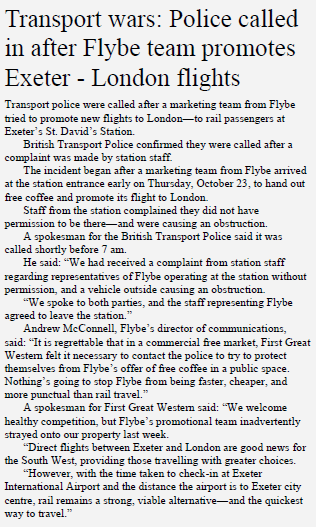
Less than a week later, a Flybe pilot was confronted as he entered the cockpit of a Newquay to Gatwick flight after a worried crew member had tipped off the Police.
The pilot was led off for a breath test before being arrested for allegedly being unfit to fly the plane.
Devon and Cornwall Police said the man, a 48-year old from Copplestone in Devon, was thought to be above the normal "drink-drive" limit of 80 milligrams of alcohol per 100 millilitres of blood. The much stricter limit for pilots is 20 milligrams, the same as it is for train drivers.
The flight was cancelled.
It is assumed that the man had driven from Copplestone to Newquay (c. 70 miles), or from a dive in town to St. Mawgan, in the same alleged condition, but drunks on the road is a much less serious matter, it would seem.
A letter to the Editor of the Western Morning News was not published:-
Dear Editor,
On the Thursday before the launch of Flybe’s new service ...
When I mentioned this later at St. David’s, I was told that ...
As only a week later (allegedly) a drunk pilot was hauled off a Flybe plane at Newquay, it strikes me that the boss should spend some time in the office studying his safety case.
Just as the road hauliers began their assault on rail freight transport by creaming off the most profitable traffics, the carriage of which enabled the railways to move the bulk commodities of British industry at not much more than cost, so a tinpot little airline today tries to entice business passengers, the train’s best payers, without the flyboys having the burden of being a general public transport provider.
January, 2019: The not so cocky airline was sold to Virgin Atlantic and Stobart Group for £2.2-million, or 1p per share. A year ago, the business was valued by the market at closer to £100-million.
Higher fuel cost, currency fluctuations and political uncertainty were the reasons given by the chief executive for the airline needing to seek a buyer.
Friends of Ashburton Station Aiming to save a model Great Western terminus
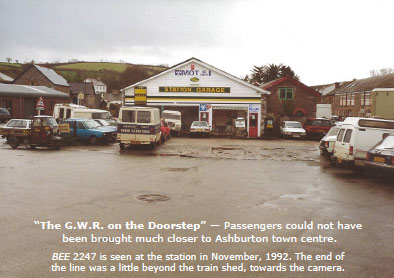
After three years' work, including much consultation, by the Dartmoor National Park Authority on a masterplan—to which future planning applications would have to conform—for the Chuley Road area, some members of the South Devon Railway at last became aware of the threat to Ashburton Station.
Having been pressing for a long time, and the urgency of the matter since April, this railway was happy to submit some words of support to the Park Authority, delivered by hand along with a copy of Peter Kay's history of the Ashburton Branch to stimulate the planners' imaginative juices, twelve days after the public meeting held in Ashburton Town Hall at which a railway mob thrust its views before officials and townsfolk.
Time will tell whether, as Yamamoto is supposed to have remarked after Pearl Harbor, "a sleeping giant" has been awoken; or whether a tired old dog has been disturbed from its stupor.
>> Appendix: Letter to the Dartmoor National Park Authority >>
(This and the history book were never acknowledged)
January, 2015
"There are railways up Snowdon and Snaefell. Would it be so bad to have ours to Princetown rebuilt?"
>> Appendix: Correspondence with Dr. Kevin Bishop, National Park Officer >>
July, 2015
From the early euphoria of being amongst a gang of railwaymen fired for action, afterwards retiring to the Silent Whistle (formerly the Railway Hotel) for a beer and going on to the exotic Mogul's Palace for a late supper, it was always likely to end in disappointment.
The railway group had arrived very late to the fray, was ill-prepared and faced one of the most morale-sapping authorities in the land. Nevertheless, a process followed which, to the uninitiated, gave some hope that, in true British tradition, victory could be snatched from the jaws of defeat.
The Friends of Ashburton Station was formalized under the chairmanship of Alasdair Page, with David Sheppard, of B.B.C. Radio Devon fame, as secretary. A plan was hastily drawn up and over the coming months was presented to the planning team, Buckfastleigh and Ashburton town councils and a meeting of the Dartmoor National Park Authority.
Not having any experience of this authority, the group sensed that they were being received with some enthusiasm and that the senior forward planner seemed quite friendly and supportive.
Aiming to come up with the answer they wanted, the National Park's planners pretended to conduct a serious study of whether railway reconstruction was possible, who wanted it and what benefits it would bring, and issued their report in April, 2015, clearing the way for the masterplan to be presented to the authority on the first Friday of June. The Ashburton Railway - Appraisal of Options Report was the bundle of denials and distortions expected of an authority that excels at finding the spark of an imaginative idea and pissing on it.
The matter was deferred on 5th June because Ashburton Town Council had yet to make its decision. No one was at Parke to represent the station friends' group, which ably demonstrates the belief at large that endless outpourings on internet chat pages substitutes for human presence and action on the ground.
At its meeting on the 9th, Ashburton councillors voted to support the adoption of the masterplan. Teignbridge District Council, which until 1997 was the planning authority for this part of the National Park, had already given its approval, which was no surprise, it being another anti-rail council. All opinion having been gathered, the matter was again put to the Dartmoor authority.
The showing for the railway was better on this occasion and three men were booked to speak on its behalf. Charlie Dennis, Ashburton Town Councillor and S.D.R. volunteer driver, referred to his canvassing of Ashburton traders and their almost universal desire to see trains return. Vernon Coon (who had been prepared to speak at the earlier meeting), an independent railway supporter, was cut short after saying: "rarely in the history of town planning has an authority got something so spectacularly wrong, spurning a golden opportunity for some very short term limited gain."
"The plan as it stands is a one trick pony, addressing the needs of one company and their objective of moving from Brewery Meadow to Pear Tree.
"I would urge members to include the option to retain the track bed and safeguard the whole route into Ashburton Station for the benefit of business and the whole town but also to consider the option of a Public Enquiry which would give the benefit of allowing all interested parties the opportunity to put their case to an independent hearing chaired by an accountable inspector rather than the limited forum this important document has so far received."
Dick Wood, former General Manager of the S.D.R., had brought 25 copies of Heritage Railway to the meeting; he was ordered not to hand them out but to leave them on the table. The magazine contained a damning editorial by Robin Jones, who drew attention to local authority support for schemes in Cornwall, Dorset and elsewhere, and asked: "So what on earth is going wrong in Ashburton?" He also stated: "For reasons I and others are struggling desperately to comprehend, Ashburton's big chance has been transformed into the dampest of squibs." (Yes, that's what this authority does so well. - Ed.).
Mr. Wood informed the members that 18 local authorities around the country were working with private railways on development plans. He spoke of the economic benefit that steam railways bring and cited figures for the South Devon. His speech was also cut short.
It was obvious from the first question about car parking that members were minded to approve the masterplan. After a brief "debate," during which several members faked sadness that the railway could not be accommodated—and one saying that it would be better to have a new station outside town—they voted unanimously to follow the officer's recommendation.
On 29th June, this railway sent each of the 18 authority members (17 to their home addresses) an individual letter, a copy of the original letter above, the leaflet There were once 31 stations ... and a promotional mouse mat.
>> Appendix: Letter to individual members of the Dartmoor National Park Authority >>
Wrong Name and Failure to Consult
In short, the need for a masterplan at Ashburton Station arose because three sizeable businesses wished to sell up or relocate, and thus to redevelop their sites. The Dartmoor planners were afraid that pocket schemes might not work together and so they viewed the site as a whole and tried to produce an area redevelopment that would benefit the town. Planning applications would have broadly to conform to a framework masterplan, necessary, it was said, to ensure that chaotic, piecemeal development was avoided.
Actually, what makes British townscapes so delightful is their very randomness—the differing rooflines, the changes in level, the add-ons and adaptations, the varying styles and materials and all the years of history encapsulated in architecture. But it was never done all at once, which is what happens now under area redevelopment, which somehow never blends at the edges. But that was then; we will accept that Dartmoor had to face the challenge using modern methods.

The initial failing was fundamental. Upon entering this area of the town, the officer had first to establish a name for it which properly defined its character. Immediately in front of anyone coming from the town centre along St. Lawrence Lane is the train shed, to this day "Station Garage." Attached to the right of it is the station building. Behind it is the goods shed; beyond is the locomotive shed. All but the train shed is solid masonry. This is Ashburton Station—or just "the station," since, when the rail transport system was the prime mover, "station" in general use meant "railway station." Other stations—bus, police, fire—had to be explicitly qualified. Station Roads across the country testify to this; they never led anywhere but the railway station. Ashburton does not have a Station Road, but its railway remnants are substantial and unmistakeable. Had this been the site of a castle, a mill, a factory or an ecclesiastical building, then surely this would have decided the historical name.
In Budleigh Salterton, East Devon, on the Green Line, a stranger might be forgiven if he failed to identify it, as Station Road does not lead all the way and the station itself has become Norman Crescent, commemorating the later bargain food store that occupied the site.
But, no, the modern town and country planner who lives his life in his car, who goes everywhere by road and is detached from history, chose to call the complex "Chuley Road," a name that would be meaningless to anyone outside Ashburton who did not have dealings with firms there.
The big questions that have to be asked then are: four years ago, when the first discussions began about what would amount to major upheavals on the site, if it had been called Ashburton Station, would not the railway interests immediately have been made aware of what was going to unfold? And, given that start, how advanced might have been the railway's plans today?
It could be argued that the first fundamental failure led to the second one. If it had been decided to refer to the complex by its rightful name, it may have woken up the officers to the need to consult railway authorities and to research its history. Not, in this case, its operational history, but only the 43 years since abandonment.
Ashburton Station was the terminus of the Ashburton Branch. The planners might have asked themselves: isn't seven miles of this branch still in use? And isn't the present terminus, Buckfastleigh, only 2½ miles away? And isn't the operator of that railway a statutory body?
Had the planners done any research, they would have discovered the traumatic amputation of the lower limb that occurred in 1972, the work done in 1997 on possible reconstruction and the never quite extinguished desire among many to reconnect to the historic terminus.
And so, whereas normally not just immediate neighbours are consulted about proposed developments, but government departments and anyone else likely to be interested or affected, in this case the planners did not think to consult the railway authority just down the line or indeed anyone with specialist knowledge.

Parke, the National Trust-owned pile on the edge of Bovey Tracey, has been the headquarters of the Dartmoor authority since 1979. The estate borders the former Moretonhampstead Branch. Most of the staff coming to work in their cars will pass the roundabout which marks the position of Bovey level crossing; no longer of road and rail, but of Station Road/Haytor Road and Monks Way, the bypass built on the course of the line. The Bovey station building still stands, as does the goods shed which is owned by the National Park.

There were once 31 stations on and around Dartmoor. There will not be a planning officer in post who remembers when the last one, Okehampton, closed in 1972. Modern men, passing over that "level crossing," will either see railways as yesterday's transport or, as likely, have no thoughts whatsoever.
It was for this very reason that a copy of the Railway Development Society's (now Railfuture) 300-page South West Rail Strategy was sent to the former National Park Officer in 2004. There is no guidance from government, there are no internal policies; an individual should be able to deposit information to fill this void and although it was not done with Ashburton in mind, it was for just such an eventuality.
But National Park officers, it is said, do not read material in their reference library any more. After the meeting in June, I went to reception with my own copy of the document and asked the young lady if she could say whether it was in the building. She said she would look after lunch and took my name and telephone number. She informed me that there was no library catalogue. She never telephoned and it can be seen from the letter from Dr. Bishop, the current National Park Officer, that he would not say whether it could be found.
So, either the document is not in the building, meaning that the only source of information on railways was thrown out; or it is in the building and nobody thought to see what it had to say about the Ashburton Branch and its terminus.
A Granite Rock and a Hard Place
From the day the station friends' group made themselves known in early November, 2014, there could only be one outcome, and all that happened between the meeting in Ashburton Town Hall and the one at Parke on 3rd July was a convoluted exercise in the National Park being seen to follow procedure and save face. No organization, including a department of the state, could have produced any meaningful plan in the short time available. Devon County Council, for example, has been working on reinstating the six miles of track between Bere Alston and Tavistock for nearly 25 years.
Why was this? Because as a result of the original failures, the narrow ideas of the masterplan had been discussed for too long for it to go on any longer. Plans for a convenience store, some houses, a bit of public space and more car parking—a scheme straight out of a town planner's uni course work—had been promoted, amended and consulted upon until it had become stagnant.
Meanwhile, one of the businesses that intended to relocate on the edge of town had submitted a planning application and rightly, for itself, having only its own interests to consider, demanded determination of the application without further delay, the new homes it included being outlined in the draft masterplan, a promise it would now be hard to revoke.
What a pity British Rail did not impose such covenants on all the land that was flogged off in the 1960s and '70s and later was hugely uplifted in value by supermarkets, industrial premises and housing estates.
Of course, the best covenant of all would have been one allowing the state to take the land back as of right, continental fashion.
The authority was stuck between a bog and a shit place. Because it had pursued only the one unimaginative use for the site, completely ignoring its former purpose, it was now being pressured to deal with a planning application which would enable a firm, which no doubt bought the railway formation for a few thousand pounds from the B.R. Property Board in the mid 1970s, to fund its move to the out-of-town location. The authority knew very well that if the firm appealed a refusal, the inspector would likely find in the applicant's favour, there having been no work done on a railway scheme sufficient to give reason to protect the alignment. The authority has too small a budget to expose itself to an enquiry and can thus be browbeaten, not by the likes of Tessie Cohen, but by an ordinary town trader.
Mel Stride, the identikit Tory M.P. for Central Devon who has a constituency home in Ashburton, did not answer two letters from the railway on the subject of the inland diversionary routes but was there like a shot when the station friends' group asked for his help and promised some publicity.
From the start, the authority knew that the railway friends' efforts would be futile. The authority knew the reasons it would use to demolish whatever work was done. Members filing into the meeting room at Parke on 3rd July had worked out, or more likely bluntly been told, that they could give only one answer. The debate was a sham; the result was predetermined. No weight of submissions, no speaker or professional consultant could have made a difference.
After the Dawlish débâcle in February, 2014, the spotlight was cast upon two Dartmoor railways: the Teign Valley Branch and the former Southern main line. By November, a third was picked out. Yet, is any indication given in the letter from National Park Officer, Dr. Bishop, that his authority is now cognizant of these transport routes and is aiming to form some policy for these and any other railway issues that may arise? Has the authority given any sign that it would know what to do in future? Is there the remotest possibility that Dr. Bishop's non-communicative, distant, complacent, tired, incompetent authority will admit that it has fouled up Ashburton Station?
C.B.
The view from the back row ...
Whom do they represent? What do they protect?
Sitting on the public benches in the meeting room at Parke to hear the speakers and witness the enacting of a foregone conclusion, my eye ranged over those around the tables.
The head of planning was there, dressed like a Cuban pimp. The chief executive passed for a humourless meerkat. The chairman ... Ah, the chairman, one of three members I once reported to the standards committee, accusing them of speaking untruths.* The house lawyer was sat preening himself as if he were about to hold the floor at the Old Bailey.
At each side of the room the members face each other across the floor. There is an overwhelming sense of dullness about the place. It's the grey, the frowning, the specs on strings, the excess of cartilage, the gender imbalance, the crippling conservatism. You half expect one of them to have become a stiff by the end of the meeting.
They sit there doodling or feigning interest in the agenda and appear not to be listening as speakers pour out their heartfelt pleas.
They don't catch buses or ride bicycles or do shitty jobs. They don't have to worry about the bills. Their detachment is not the kind that might produce wise decisions, like the elders who once went into the wilderness to contemplate in isolation.
Whatever these men are individually, and there must be some with ability, their strength is sunk in the collective mire.
One of them continued to sit there in judgement over the lives of others while he faced criminal proceedings for allowing a crook to grow dope on his farm, a "diversification" he thought would aid its profitability, and is still only "given leave of absence" after admitting his guilt and being sentenced.
My hope in writing to them all was that possibly one free thinker might break ranks and say: "I am going to vote for this because I have to but I believe that as an authority we are making a monumental mistake." Or even: "It is obvious that our officers have blundered." But not one really cared a damn about signing the death warrant for Ashburton Station.
And when it was over and I found myself talking to railway advocates in the courtyard, the grinning members started filing out with plates laden with sandwiches and cake. The ranger service cut, a load of functions scrapped, funding slashed, but a caterer still brings a buffet lunch for the members—on top of the £130 each they get for turning up.
The impression is given that those who work at Parke believe they are guests at an Edwardian country house party which plebs should never get near. I think that the National Park would have been better administered from a nondescript office building in town, with a token moorland scene hanging on a wall.
Many argue that the Dartmoor National Park Authority serves no useful purpose; indeed, that National Park designation has been a handicap and failed to deliver any worthwhile result that could not have been achieved by other means. I had clung to my indoctrination, convinced that the detractors were wrong, but I can no longer shrink from admitting it: this authority is a shower of shit. It must be dismantled and any useful roles transferred to other, existing bodies.
C.B.
* They were naturally found to have done no wrong.
Insider
August, 2015
There being no objections forthcoming from the army of S.D.R. supporters to the proposal (D.N.P.A. Ref.: 0045/15) to build five homes on the course of the branch railway, the E. & T.V.R. submitted a brief letter.
>> Appendix: Letter to the Dartmoor National Park Authority, 21.8.15 >>
On 23rd August, a request was made under the Freedom of Information Act, 2000, for the D.N.P.A. to advise the amount of money paid to the Building Design Partnership (BDP) and other outside consultants in connection with work on the Chuley Road Masterplan.
If the figure is revealed, it may show why the authority is so determined to ensure that the masterplan is not undone. It should be understood that, had the railway interests been consulted in the first instance, and plans for reconstruction instituted - or, at the very least, the railway land protected for the future - a masterplan would not have been necessary because the other sites would then have been only peripheral.
September, 2015
January's application for outline planning permission to build 30 homes, with five on the line of railway, was withdrawn and another (D.N.P.A. Ref.: 0441/15) was submitted, this one seeking permission for 32 homes with four on the track. This railway immediately sent another letter of objection.
>> Appendix: Letter to the Dartmoor National Park Authority, 7.9.15 >>
At the same time it was revealed that the Dartmoor National Park Authority, in response to an approach from a law firm acting for the South Devon Railway Trust, had, after being advised by its own hired counsel, decided to return the masterplan to the final draft stage and conduct more procedural covering. Six weeks have been allowed.
November, 2015
Mr. Walledge, Head of Legal and Democratic Services, was kind enough to reply promptly in September, providing an analysis of the payments made to outside agencies so far. It is entered here without comment, except to say that Dartmoor clearly is under pressure from a higher power.
>> Appendix: Response to Freedom of Information Request, 17.9.15 >>
The Spiritual Terminus
The hour has come; where are the men?
Unlike the railways which have from the beginning, or for a very long time, fanned the flames of an ambition to reach some distant point, whether the revival of a complete railway or an extension to make a line whole, the Buckfastleigh crowd, in all honesty, have never had any real desire to reach across the gap to the stranded terminus at Ashburton.
It is fully accepted that nothing could have been done at the time to save the branch; it was the height of road mania when it was intended that railways be destroyed. Perhaps it was too much to expect that any yearning would develop while the line was run by the Dart Valley. But for all the years that the branch has been under the present control, there should have been amongst real men a growing urge to put right a gross injustice, culminating in the widespread belief that, come what may, there would be only one end: Ashburton would be reconnected.
But there never has been any conviction. Anyone who had questioned or listened and who had felt the pulse at Buckfastleigh would have concluded the same. A former General Manager once openly admitted that returning to Ashburton made no sense as Buckfastleigh would still be the effective terminus. Honour played no part; the heart had no say.
A recap of the events of the last five years proves the lack of spirit. In 2013, Tuckers' were granted planning permission to build a new complex on 12 acres of pasture the firm had bought speculatively in 2010 for around £100,000. Within this was the course of the railway. Not a bleat or a bah was heard from the local railway people about this or when the land opposite was being talked about as the site of a new market to replace Newton Abbot.
At the same time, the National Park authority published its masterplanning exercise for Ashburton Station. Although this was disguised as "Chuley Road," it is hard to see how it escaped the notice of so many railway people that the station and any hope of reinstating the line was in jeopardy.
Even when the Teign Valley alerted the Friends to the danger the station faced in April, 2014, it was November before anyone acted, and then the fledgling campaign was led, not by a gang of old hands, but by one of the youngest members of staff and a local radio presenter.
Considering the lateness of the hour and the forces by then arrayed against the railway, the Friends did extremely well to come up with a set of plans and promote them as best they could in the time available. The committee members said to start with that they could only do this much and that it would be up to others to take forward the campaign. It is unfortunate that they baled out at such a critical moment but they should be commended for doing the groundwork and setting up a momentum.
Out of the thousands of staff, volunteers, supporters and associates of the South Devon, fewer than 50 could be bothered even to do the least thing and object to houses being built on the track, when the first of the planning applications came up for consultation. Earlier this year, at the authority meeting at which the masterplan was to be ratified, no Friends were present; on the next occasion when the plan was adopted, there was only a small contingent.
Had a latent force been unleashed a year ago, its cry by now would have been deafening; there would have been meetings and fund raising and press releases; studies and research would have been underway; the South Devon would have been at long last making an heroic push.
But no matter what musings and bold talk there might have been about Ashburton in the cabins and pubs, the truth is that there is not and never has been any real belief in a return to the spiritual terminus.
And in this they have failed not just the locality, not just the railway brotherhood: they have failed the nation.
The Mughook Experiment
Does the medium used by people to lay bare the dreary minutiae
of their lives for others to view have any value in campaigning?
The railway's penman reluctantly signed up to Mughook so as to read what was being written by the Ashburton friends group in the only area where there seemed to be any activity.
What he found seemed like an endless scroll of disjointed, disorganized entries in a virtual scrapbook, much of it with poor spelling and grammar, tapped out in the small hours by people with heavy eyelids. The group was actually constituted in January, 2014, but its jottings are useless as a journal or an action report or archive.
When the Teign Valley joined, the group had around 700 members and none had noticed that there was a planning application before the National Park Authority for the first of the developments affecting the station; in fact, the application had been submitted in January. This was withdrawn and another submitted on 18th August. It was this one that the Teign Valley brought to the attention of the Friends in an initial post on Mughook.
The call to arms was quickly acted upon and the railway exposed its own web pages and letters to the authority as a source of inspiration.
In the case of Tuckers' relocation to Peartree, Mr. Churchward, the Managing Director, had mobilized his customers by encouraging them to write or fill in pre-printed pro forma letters. It was reasonable to assume that a great many of the 700 Friends could do better than the 1,562 identical letters submitted in support of Tuckers'.
The planning file at Parke did begin to grow, most submissions being wired rather than written, despite the railway's suggestion that paper has more weight; it has a physical presence, the presentation on the file is better and the act of writing a letter is a mark of greater commitment.
However, the effort soon faltered. This was put down to a failing of the Mughook mechanism which does not necessarily notify dormant members of new strands.
Shortly afterwards, the Teign Valley agitator, being unused to dealing with people he had not met and had never spoken to, and finding the whole thing completely foreign, quietly left by the ethereal back door.

18th November, 2015
There being no greasy spoon in Ashburton, the E. & T.V.R. scout repaired to the Royal Oak for lunch. After a pint of ale and some pork pies, he asked the landlord how he felt about the railway reopening. The reply was detailed and articulate and his support was gratifying to hear. He even offered the use of his back room to campaigners free of charge.
Round the corner in North Street is one of those gems that only survive in places like Ashburton. The scout wanted a jar of Stone's furniture cream (made in Crediton to a 1760 formula) and Church's Ironmongers, trading for over 100 years, did not disappoint. It was known that the owners had written in support of the railway and they were thanked for doing so. They said that they were by no means alone in wanting to see a rail revival.
Later, at the National Park headquarters, Dan Janota, the Senior Forward Planner, whom the scout had met twelve months before in Ashburton Town Hall, was good enough to come to reception for an amicable discussion of the case in hand and wider railway issues.
He seemed genuinely to want the Friends to work with the authority and provide the concrete evidence he had requested. "Give us something to work with," he said, adding, "don't keep telling us what others are doing: tell us how it can be done here." The scout remarked that a year ago his advice to the Friends had been to put a strong emphasis on public transport: "you can get your steam wank from a working railway." And also to get the engineering study out of the drawer, get it updated and costed and into the public arena.
Mentioning that there had been no canvassing of opinion in Ashburton regarding railway reconstruction, Mr. Janota said he felt that the townsfolk were weary of consultation. But he said that any scientific market research done by the Friends would be accepted as evidence.
Perhaps the most heartening intelligence was that the authority, mindful of the talk about reopening the Southern route to Plymouth, had commissioned a scoping report: "Devon Main Line Route Options." 1 Let no one dare criticize this. Stick it to the fridge like a child's first drawing which a doting parent thinks is a work of art.
Mr. Janota kindly returned Peter Kay's Ashburton Branch history and he was thanked for his courtesy and for being so candid.

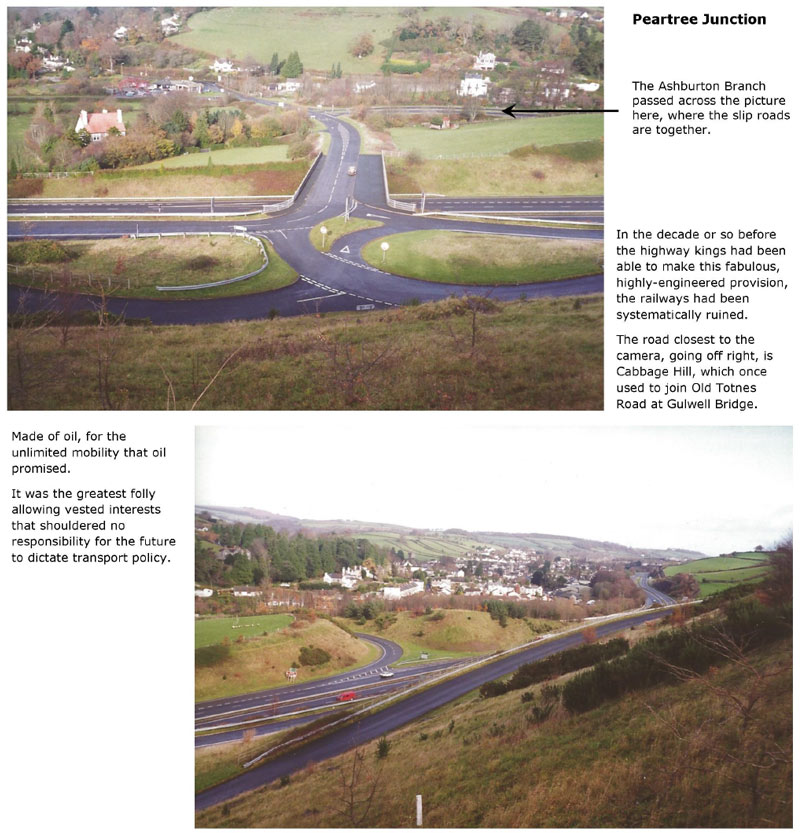
Great Western Main Line West of Exeter Route Resilience Study
At the time of the Dawlish Débâcle, Network Rail was charged with reporting to Government on its proposals for ensuring future dependability of West Country rail services. This was supposed to include ways of strengthening the existing coastal section as well as examination of five other possible routes: the former Southern main line between Exeter and Plymouth; the Teign Valley and Moretonhampstead branches between Exeter and Newton Abbot; and three variations of the 1930s Dawlish Avoiding Line scheme. It was said that there would be extensive consultation in the areas concerned.*
From all accounts it was understood that Network Rail would report in the first instance by the end of June, with a more detailed study to be delivered in autumn.
The interim report is more likely to be a package of half measures than what is really needed, but the truth is that rail‘s share of traffic is so small that Treasury would baulk at funding anything grand, even if the wretched track authority were to make a bid. However, it would be a tragedy if all that resulted from February‘s débâcle were subsidy for Newquay Airport and a start on upgrading the A303.
Every year, the railway finds some pretext to draw attention to the Teign Valley. Early on, it was obvious that no effort would be needed in 2014, as the route appeared nationally on television screens and newsprint.
Naturally, there was much chatter throughout the hiatus and some ridiculous assertions were made by the usual panel of self-appointed experts. The railway sent some letters to the paper to give factual information an airing, but it was decided that the time for action would be between the main line being reopened and Network Rail submitting its ideas.
Using a mere 3,000 words and language for the most part intelligible to the establishment, "A Summary of the Case for Reopening the Inland Railway Route between Exeter and Newton Abbot" was sent out towards the end of June, with a copy aimed to land on the desk of the Secretary of State for Transport on 27th.
* A Network Rail gang was seen in the Teign Valley but the men spent all day sitting in their van.
>> A Summary of the Case for Reopening the Inland Railway Route
between Exeter and Newton Abbot >>
In February, 2017, a Postscript was added.
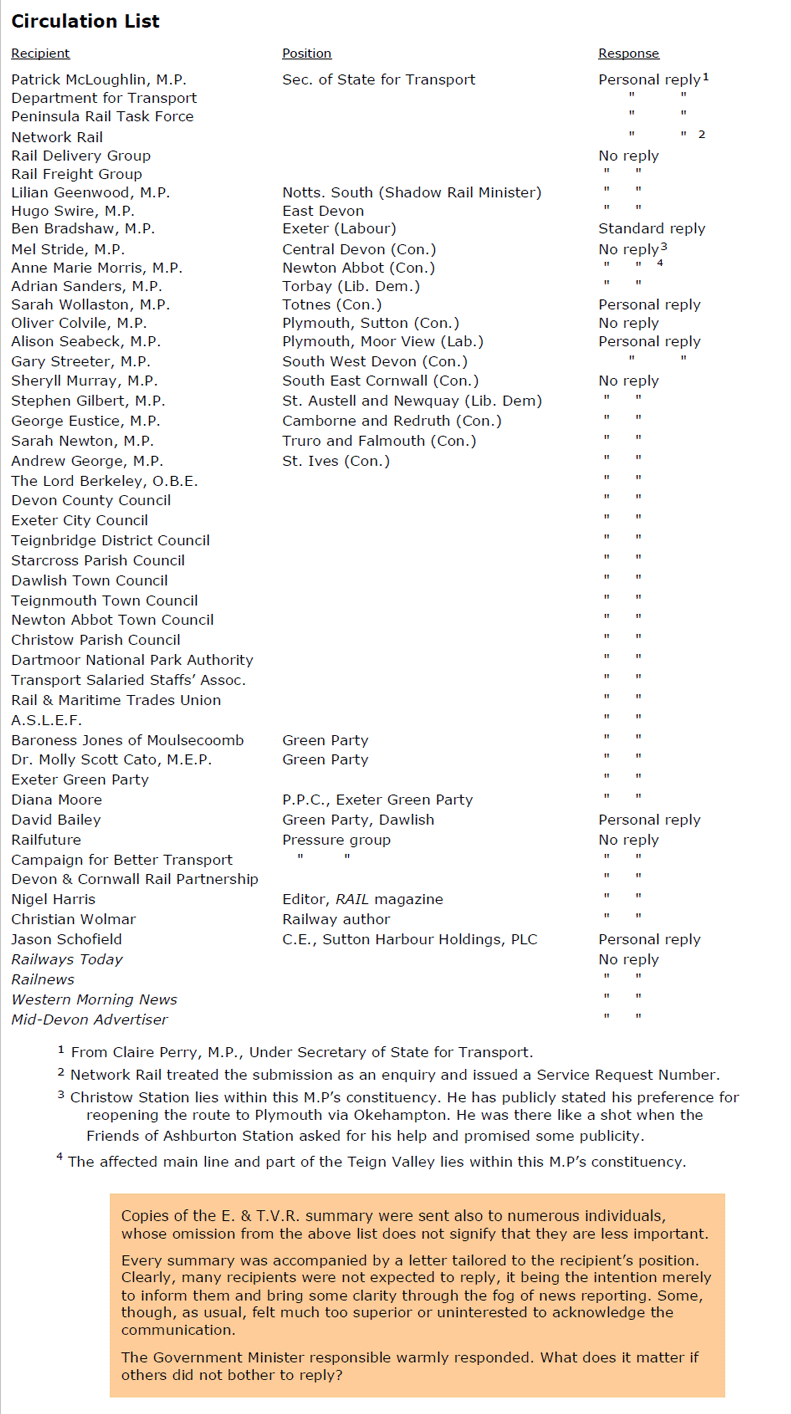
The Network Rail Report
Playing to the cameras while visiting Dawlish shortly after the line was washed away, Prime Minister David Cameron announced that he had ordered Network Rail to prepare a report detailing what might be done to strengthen the route or build an alternative, as if money were no object.
Off record, in a hushed aside to the senior Network Rail officer, it is imagined that he added: "But don't go to a lot of trouble."
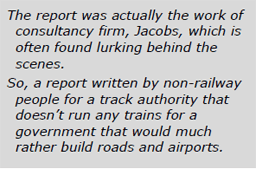
And, bless it, the firm did not. Its study, submitted at the last minute like a grubby schoolboy handing in his prep, could not have been awaited with less eagerness.
Broadly, it looks at three options:-
(i). Do no more than usual;
(ii). Strengthen the sea defences and stabilize the cliffs;
(iii). Talk about the impossibility of an alternative route.
Item three involved rebuilding the Southern route to Plymouth via Okehampton, building a new double line railway along the Teign Valley route and building a new inland cut-off with junctions somewhere between Marsh Barton and Hackney. This was narrowed down to five specimen routes out of a possible twenty.
Costs ranged between £470-million and £3-billion. The Teign Valley was the least expensive, though still extremely poor value for money, rating a Benefit-Cost Ratio of 0.29.
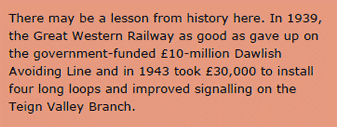
What Network Rail did not do was price for a branch line with enhanced diversionary capacity, the value of which the track authority probably failed to understand.
The estimated cost of reinstating the Teign Valley would be £180-million, or ten times the loss1 sustained in February and March. Delivering a B.C.R. of about 0.7, it would better the "Borders" project in Scotland.
Since the report was not meant to be taken seriously, there is no more that need be said, but some extracts are reproduced here to prove that someone has read the thing.

The map used on page four and throughout is taken from a road atlas and has the railways picked out, including parts of the Moretonhampstead and Cattewater branches that were taken up more than three years ago.
1 The compensation paid by Network Rail to train operators, not the overall damage
to the West Country economy.

Western Morning News transport
analyst discovers worm hole
in space-time continuum
Neill Mitchell — mentioned before; establishment drip formerly of Margaret Thatcher's press office; no doubt his contacts at the Daily Mail got him a little retirement retainer with the regional rag — had another opinion piece published in the Western Morning News on 9th September: "Why we must demand the best railway services for all regions."
He stated in a previous article that the distance between Exeter and Newton Abbot could be reduced by eight miles. This railway responded with a letter to the editor pointing out that the distance by rail is 20 miles and from St. David's to Newton Abbot as the crow flies is 14 miles. The letter was printed incorrectly and posted in cyberspace for all to see, making the railway seem incompetent.
Mitchell made the claim again in a subsequent article. This time the railway wrote a letter not for publication to the editor showing up the daftness of his stock contributor.
"The letter asking how it was possible to reduce 20 miles by eight, when the distance as the crow flies is fourteen and the shortest possible diversionary line would be 16 miles long, had its figures printed incorrectly so that no one took any notice."
Now, in his latest piece, Neill Mitchell claims that building a modern Dawlish Avoiding Line "... would clip some 12 miles off the circuitous length of the current 60 m.p.h. main line, reducing the rail mileage between Plymouth and Exeter from 57 miles to near parity with the 44 road miles of the A38 "Devon Expressway.""
What hope is there of revealing deeper truths if the small matter of the distance between two places cannot be established?
The costs entailed in keeping disused railways disused
When a bus company withdraws its services from a route, there is no infrastructure to consider: the road network is provided practically for nothing in the case of public service vehicles. Buses and drivers are easily disposed of or reassigned to other work.
When a railway is closed, however, often massive infrastructure is abandoned, trains are scrapped prematurely and skilled men made redundant. What land and material are sold realize only a relatively small sum and the remaining liabilities such as land nobody wants and structures that can only be transferred to statutory bodies have to be carried in perpetuity. An enormous capital sum is written off. The burden of whole-life costs, increasing continually, must at some point cancel all that the railway did while it was operational.
Two examples of structures on the Teign Valley Branch which have been covered in these pages in recent years are Perridge Tunnel and Greenwall Lane Bridge. A request sent to the Highways Agency (successor to BRB (Residuary)) under the Freedom of Information Act, 2000, brought the disclosure that since the turn of the century, £221,015.72 has been spent on Perridge Tunnel and £232,605.12 on Greenwall Lane Bridge. These figures do not include the unavoidable costs of officer time and expenses attributable to these structures.
 It is only when the news media covers a subject known to the
reader or viewer that the standard and accuracy of reporting
can be tested. Then he is often left wondering how much he can
trust the coverage of subjects about which he knows little.
It is only when the news media covers a subject known to the
reader or viewer that the standard and accuracy of reporting
can be tested. Then he is often left wondering how much he can
trust the coverage of subjects about which he knows little.
Rashness spurred by instinct could have led this railway to see an opportunity for publicity,
there being so much attention suddenly focussed on the destruction of the railway at
Dawlish. For a moment, it was thought that some beautiful people could be hired to parade
outside St. David's and Newton stations with placards to prick the politicians.
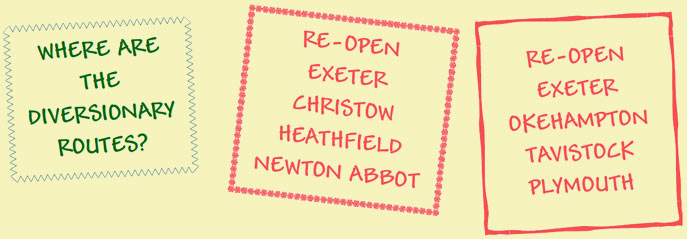
But would it have been picked up by the newshounds? Would the British Transport Police have moved the placard carriers on? Would it have done any good; made any lasting impression? Would it not just have been playing to the cameras?
This railway campaigns all year round, as can be seen by the issues detailed on these pages. None of this would interest the 24-hour pulp news industry, whose outpourings are hysterical at worst and hastily-researched at best. The meja feeds off mumbling ministers and prattling politicos, off the “human interest” of people suffering or about to lose everything. It does not want solidity or depth or continuance in its material.
In a few days or weeks, the story will go off the boil and be dropped, just as Cowley Bridge was last year. And for campaigners it will be back to the long march.
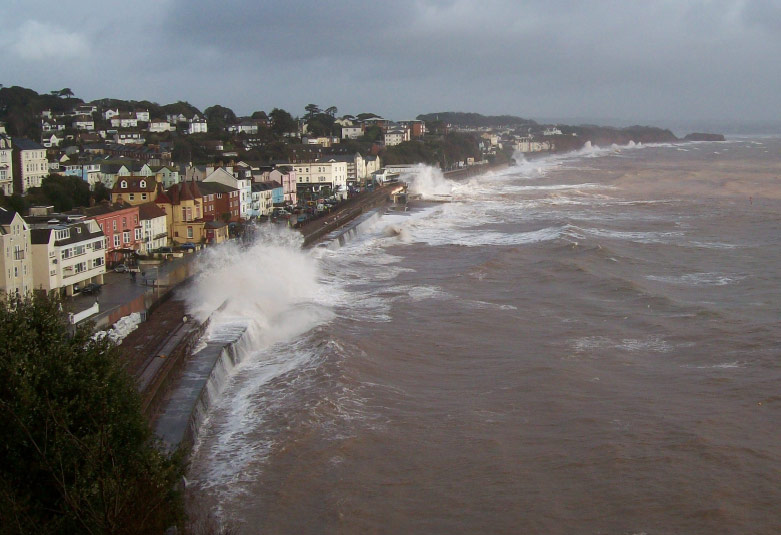
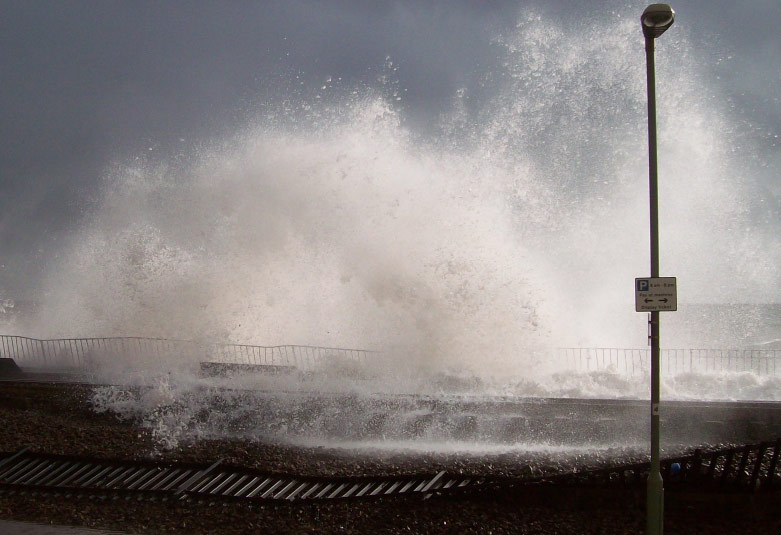

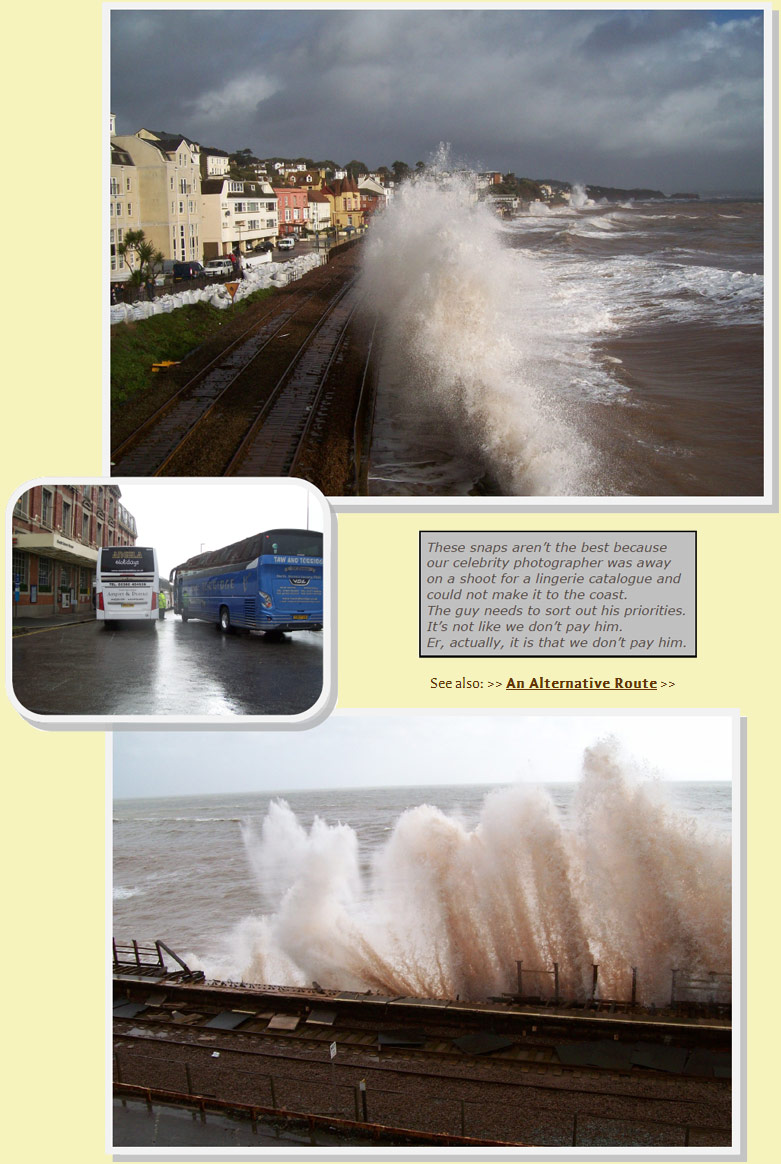
By the time this poor quality video was taken on the morning of 5th February, 2014, the wind had eased, the tide was ebbing and most of the damage had been done. Nevertheless, there is still anger and excitement in the air and sea.
It is fortunate that winds must change and tides turn, for cliffs, beaches and man's defences would look very different were these extreme conditions to prevail.
Beside the photographer on the coast path that leads up above Kennaway Tunnel to Lea Mount was a woman with a tripod and camera, which appeared to be pointing at Sea Lawn Terrace. He imagined that the pedlars of woe at Wapping would pay well for a shot of the moment a house crumbled into the sea.
Some more photographs taken on the morning of 5th February, 2014
(Click on these images to enlarge and see captions)
Sky News on the Scene
Kevin Cook, railway historian and friend of the Teign Valley, was called upon by Sky News to be interviewed on site from the studio not long after the débâcle. He recalled that he had expected a warm up but instead went straight on the air.
https://www.youtube.com/watch?v=0fTArYAm-Hs
He gave his views again on the morning the line was reopened, after Prime Minister David Cameron had delivered his scripted spiel.
https://www.youtube.com/watch?v=EAWws2STzhU
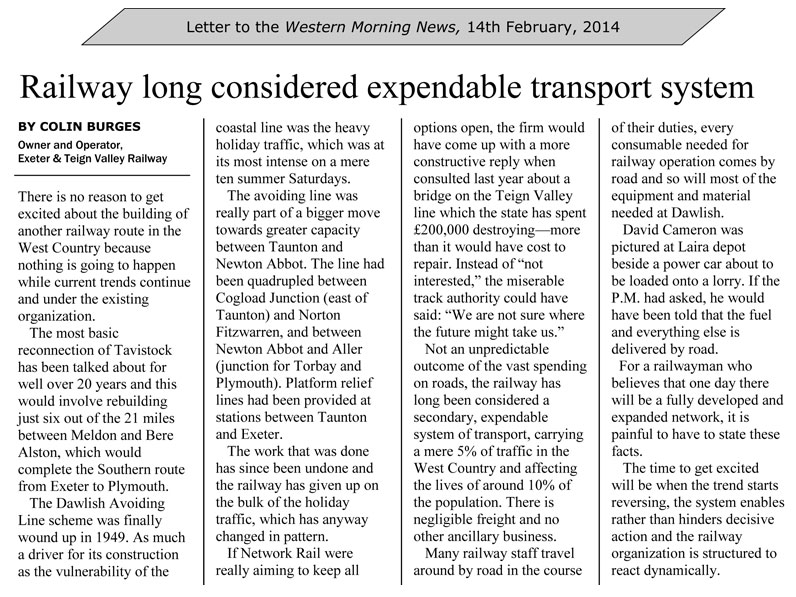
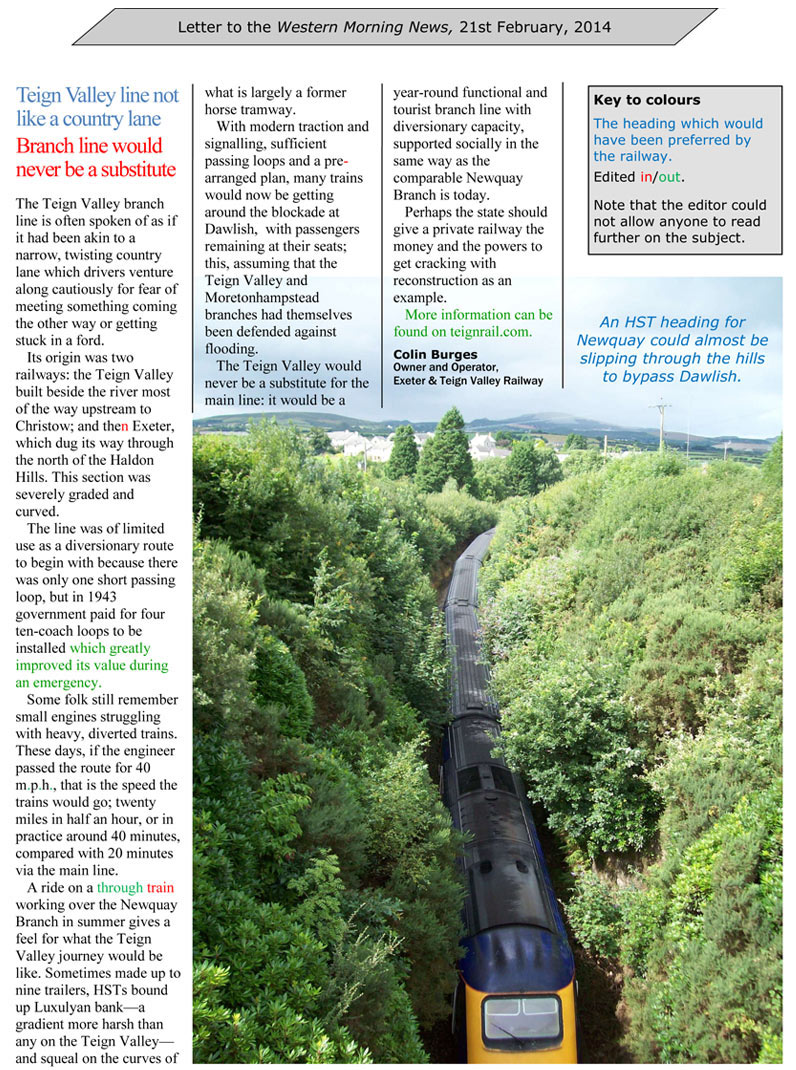
>> Descending Luxulyan Bank >>
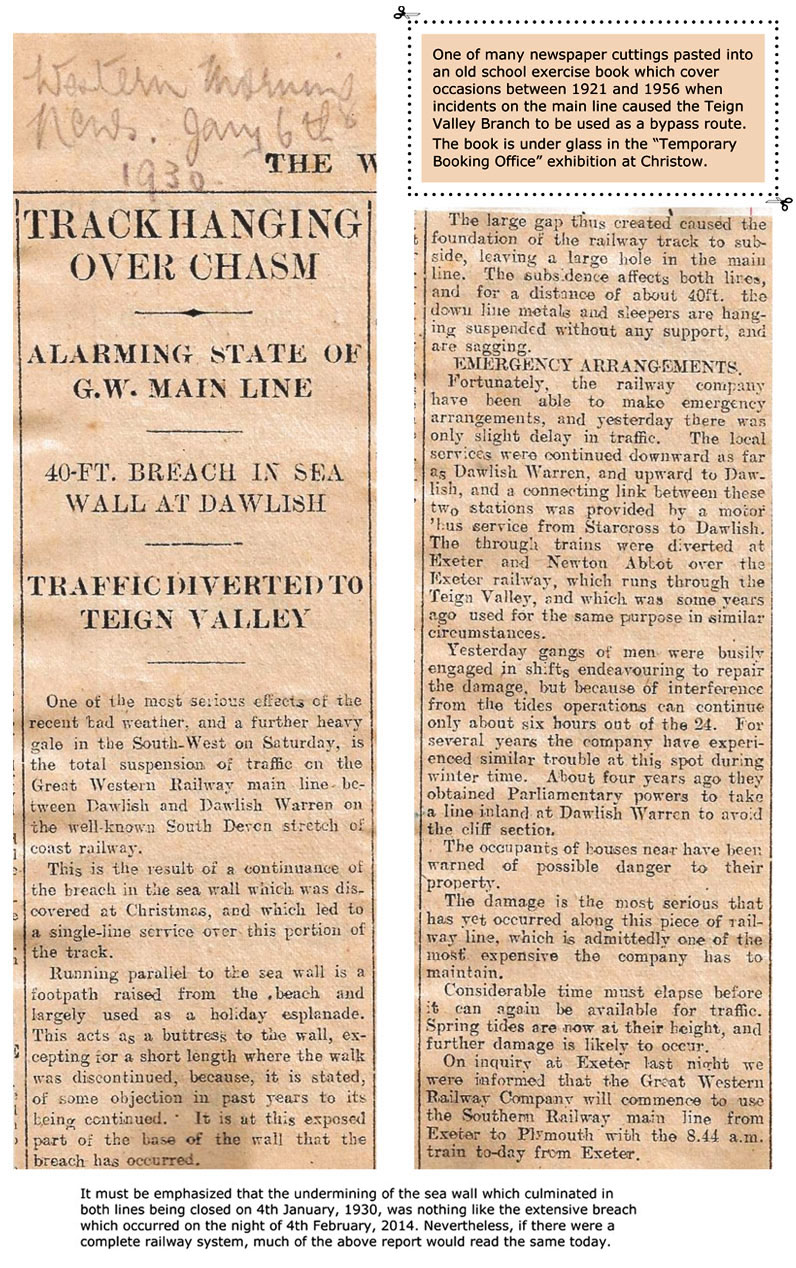
"Beeching lines to re-open"*
In an effort to provide a lead for a story, included with the letter above were a copy of the 1930 newspaper clipping reproduced below and a page from the notice issued the same day by the Superintendent's office in Exeter detailing the emergency working, including trains diverted via Christow.
On several occasions this railway has sent interesting material to the Western Morning News, only for it to be ignored while shortly afterwards a piece on a fellolw collecting bottle tops or some other banal pastime would be published.
In the current case, the paper thought a better story was to be had by sending a reporter to Brentor (a former station between Okehampton and Tavistock, where the platforms remain and the building is now a private residence) to ask the surprised occupant how he felt about his home being requisitioned in readiness for the line to be reopened.
And the editor of this regional tabloid would claim to be taking the subject seriously.
* A front page headline soon after the Dawlish débâcle.
The writing was on the wall but the wall's gone
In almost every piece that this railway has published over many years, making the case for the reinstatement of the Teign Valley and Moretonhampstead branches, their usefulness in providing a diversionary route away from the coast has been mentioned.
Not by a long way would this be their only or primary purpose. What has always been said is that the branches' value when trains were diverted during an emergency, or in weather conditions that allowed only the Up main line to be used, or to enable planned engineering work, or when trains were routed in the normal course to ease pathing pressure along the coast, would have to be recognized in the accounting as a monetary benefit.
The latest offering, written in March, 2013, sent to Teignbridge District Council objecting to a proposal to demolish a bridge on the Teign Valley Branch, included these words:-
"Despite repeated claims that the estuarine and coastal main line is secure, the reality is that a combination of severe weather events could sever the route completely and a prolonged blockade would be disastrous for the network west of Exeter."
There are enormous costs, not just in repairing the breach at Dawlish and other storm damage, but also in conveying the traffic past the blockade by road and the consequent disruption.
There are fewer passengers; the train operating company has reduced fares; revenue is down; the road vehicles hired in are a huge additional expense; some traffic will be lost permanently; the few freight trains there are left in the timetable have been cancelled furno.
How many businessmen have been clubbing together to run a seven-seat taxi to Newquay Airport (R.A.F. St. Mawgan), Tiverton Parkway (Sampford Peverell), Bristol Parkway (Stoke Gifford) or even Town (London)? How many commuters will get used to the bus or coach? Horror of horrors, how many will have bought cars and will keep on using them?
Had the rail bypass route been available, it would have earned enough credits during this blockade to justify its existence for many years to come.
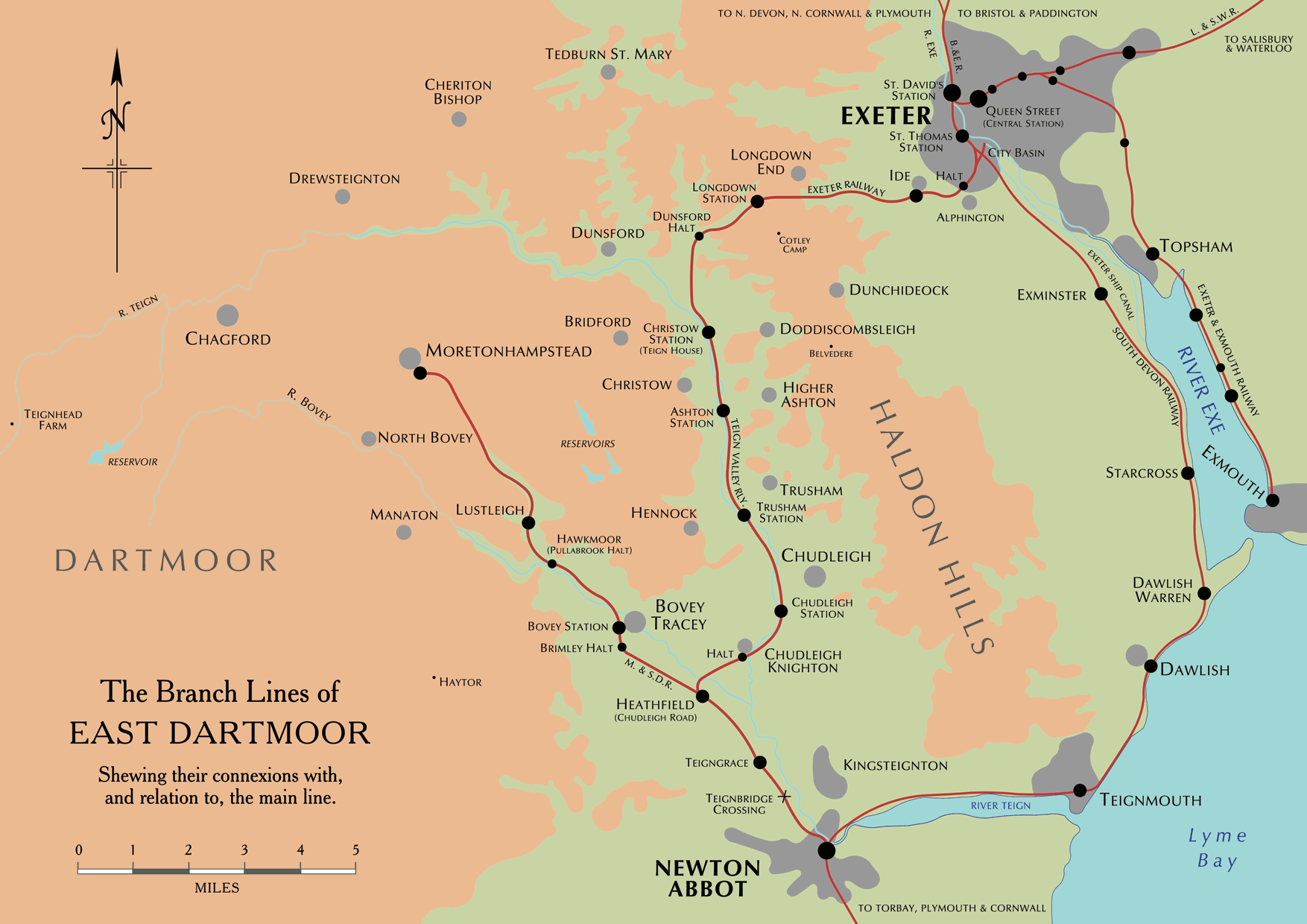
B.B.C. Spotlight Feature
Everyone knows that the Teign Valley is delectable.
Now its railway has been described as "curvaceous."
Neil Gallacher, Spotlight‘s Business Correspondent, telephoned on 4th March to say that he was putting together material for a piece on railways that may one day avoid the sea wall at Dawlish.
He seemed a pleasant young fellow but caused some consternation when he confessed that he had been reading these web pages but could not make out where the E.& T.V.R. stood. "Would the railway (being reinstated) be a good thing or a bad thing?" he asked. Some spluttering followed from this end.1
When he asked whether the Teign Valley would like to state its case to camera, it was suggested that since most of the coverage hitherto had been pretty superficial, he might contact Gerard Duddridge, the chairman of the local branch of Railfuture for some serious and informed comment.
Mr. Gallacher telephoned the next day and advised that he would be speaking to Mr. Duddridge. He was given the railway‘s permission to film at Christow on the 6th, but the railway declined to take part, suspecting that no matter what was said, the angle being sought was along the lines of "Japanese found in jungle ..."
The feature was broadcast over three nights from 11th March, covering the former London & South Western's main line to Plymouth, via Okehampton and Tavistock, the Teign Valley and Moretonhampstead branches, and the now legendary Dawlish Avoiding Line. Each was given around four minutes and the longest speech from a "Rail Expert" was 17 seconds.
As remarked upon in an article above, the Western Morning News' idea of constructive journalism was to send someone to Brentor Station to ask the owner how he felt about the sound of rail spikes being driven in the distance and the sight of the surveying gang approaching.
 Mr. Gallacher said that he was going to do better but his style was just the same. He went to the owner of the station building at the former Tavistock North, recently marketed as three residential units, who was worried that there may be a train at seven in the morning and another at nine at night — "We just don‘t know." Mr. Gallacher went to the former Exminster Station, now occupied by a firm of architectural salvors, where the owner expressed sadness that his house may have to be demolished because he had only just done it up.2
Mr. Gallacher said that he was going to do better but his style was just the same. He went to the owner of the station building at the former Tavistock North, recently marketed as three residential units, who was worried that there may be a train at seven in the morning and another at nine at night — "We just don‘t know." Mr. Gallacher went to the former Exminster Station, now occupied by a firm of architectural salvors, where the owner expressed sadness that his house may have to be demolished because he had only just done it up.2
And the reporter came to Christow. In the seven seconds used from what his cameraman shot, he could have fixed on props with punch, but chose instead to film the collection of rolling ruins which await repair, in the absence of the sentimental crank.
Mr. Gallacher opened the Tuesday evening piece (4‘ 15") about the London & South Western route with: ―Let‘s assume as railway planners do that Tavistock will, within a - decade or so, have a railway line coming up from Bere Alston."3 Five spokesmen appeared:-
| An unidentified local on Tavistock Viaduct | ... | . | ... | 5 | seconds | ||
| Councillor Kevin Ball, West Devon Borough Council | ... | 15 | " | ||||
| Owner of the former Tavistock North Station | ... | . | ... | 11 | " | ||
| Tony Berkeley, "Rail Expert" | ... | . | ... | . | ... | 11 | " |
| Jonathan Roberts, "Rail Expert" | ... | . | ... | . | ... | 17 | " |
On Wednesday evening‘s piece about the Teign Valley route (3‘ 36"), only two appeared:-
In his 15 seconds, "Rail Expert" Jonathan Roberts (Managing Director of Jonathan Roberts Consulting)4 said: "The Teign Valley route via Chudleigh is of limited benefit other than just as a diversionary route when the Dawlish sea wall is not available. It could have some commuter benefits but its journey time capabilities are very restricted."
Tony Berkeley (Anthony Fitzhardinge Gueterbock, O.B.E., 18th Baron Berkeley)("Tone" to his mates), in his 13 seconds, said: "The problem is that it‘s got severe gradients, I‘m told, and it‘s quite curvaceous5 – windy – so the speeds on it would be low. I would call it a second or third rate solution."
Three appeared on Thursday evening's piece (four minutes) on the Dawlish Avoiding Line:-
| Neill Mitchell, "Rail Expert" | ... | ... | . | ... | . | ... | 17 | seconds |
| Tony Berkeley, "Rail Expert" | ... | . | ... | . | ... | 13 | " | |
| Jonathan Roberts, "Rail Expert" | ... | . | ... | . | ... | 13 | " | |
Gerard Duddridge, the only man with any real knowledge of the subject, in the event did not appear and the whole effort can be disregarded as of no consequence.
1 Several followers were asked about this and the reassurance was obtained that the railway's position is unequivocal. Which just shows what comes from reading snippets on a smartphone.
2 Attentive viewers will have spotted in the yard the Devon County Council cast iron and timber road sign which until the late 1970s stood at the crossroads at Spara Bridge (Ashton Station).
3 Another decade would make it 33 years since the first feasibility study was completed.
4 See this consultant's report, "Investment in resilience and economic development: the West Country rail network." www.jonathanrobertsconsulting.co.uk
5 Curvaceous (an obscure engineering term), having an attractive body with rounded hips and breasts.
Occasionally, small pieces of evidence come to light which happen to support the greater historical account. Here, an open reference given to a nurseryman reveals that his former place of work, the modern-day Jack's Patch at Bishopsteignton, had been bought as part of preparations for the construction of the Dawlish Avoiding Line in 1937, as had much of the land needed between Newton Abbot and Teignmouth. It was not sold back until some years after the scheme was wound up in 1949.
>> Appendix: Reference from The Teignmouth Horicultural Company >>
It has to be wondered whether the features editor of the Western Morning News telephones one of his regular little coterie of safe writers to request some copy, thus: "Can you send us fifteen-hundred words on blah-blah? Usual stuff will do. You‘ll get your hundred quid."
Neill Mitchell, "independent regional connectivity analyst," was wheeled out again in the Friday, 4th April edition, the day the line at Dawlish was to reopen. He had written an amusing letter the day before, saying that a junior civil engineer of his acquaintance, named Oliver (aged 4½) from Chudleigh, had planned a new line tunnelling beneath Haldon that would be eight miles shorter than the existing one and 15 minutes quicker.
Without checking, Mr. Mitchell quoted these figures in his article commissioned to appear on the morning that services resumed through Dawlish.
It is assumed that the analyst lives in or near Bere Alston, since it is on the platform of this station that he often faces the television cameras. Yet he pours cold water on the idea of reviving the main "Green Line" from Waterloo, despite having been a regular traveller on it (this writer also remembers journeys between Exeter and Plymouth).
In a rational world, young Oliver would campaign for his local station (on the Teign Valley Branch) to reopen, Neill Mitchell would press for through trains from his home station to Waterloo and everyone else would forget about building unnecessary high speed cut-offs.
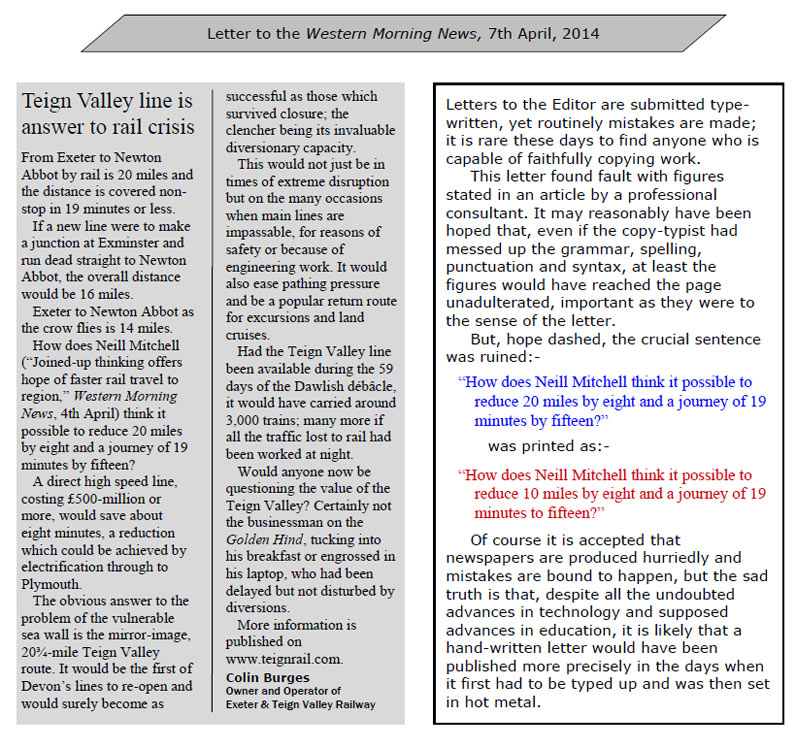
See also:-
>> Western Morning News transport analyst discovers worm hole in space-time continuum >>
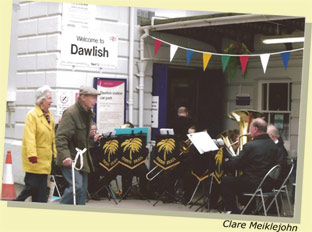
To the strains of "Bridge over the River Kwai," the South Devon Railway‘s main line reopened to traffic on 4th April.
Repairs were estimated to have cost £35-million. £16-million compensation is to be paid to train operators. The total cost of the disruption may only be guessed.
As part of the promotional effort designed to make the line attractive to local passengers, it is to be dubbed "The Atmospheric." It is not often that this railway applauds anything that the present shower does, but it has to be said that this is a splendid idea.
Sorry to spoil the mood, but ...The praise that has been heaped upon Network Rail and its "superhuman" workforce should be tempered by a sprinkling of reality.
There is no doubt that the track authority devised a plan and mobilized men, plant and materials very smartly. Given the constraints of the modern construction site, the work could not have been done any faster.
It is no use conjecturing how different it may have been in times gone by, when the engineer could have called up trains laden with boulders from rail-served quarries on either side of the blockade; cranes, locos and wagons at his immediate disposal; and plentiful manpower, with not a hard hat or an orange jacket to be seen. So, the engineer might have had the Up road back in place for 5 m.p.h. within a week. That was a world removed from this one.
The staff and contractors that kept the local fast-food joints busy were just doing their jobs; none wore orange capes and tights. Some put their backs into it; others, as always, were seen just marking time. But for the emergency, many of the men would have been on "bare strokes" (basic pay); now, it is a cert that every one of them will be taking an expensive foreign holiday this year, buying a new car or making a hefty payment on his mortgage.
The task proved once again that the railway has ceased to serve itself. Very nearly all of the equipment and materials were brought by road to Dawlish Warren and Dawlish stations. Only in the final weeks did a ballast train tread the rusty metals from Exeter. The staff are no longer railwaymen at all. They spend their working lives racing vast distances on the road system and scarcely use the trains for duty or pleasure. Not one of them has the faintest vision of an expansive, general purpose railway muscling its way into new territory and areas of transport business.
Had the weather gods been angrier and the conditions of 4th February prevailed over numerous tides—which admittedly seldom occurs—then the damage could have been nightmarish: enough to close the railway for much longer than two months, even well into the summer timetable period. If the industry quietly accepted that it had been lucky, no air of humility was allowed to pervade its self-congratulatory outpourings.
Network Rail may have acquitted itself satisfactorily with the repair, but it should not be forgotten that before the débâcle the outfit had continued to state that it was sure such a failure could not happen and had rubbished the calls for work to start on reopening the other routes west.
Network Rail is part of the Frankenstein railway; less grotesque than Railtrack, perhaps, but still a monstrous, artificial creation that must be put out of its pointless misery.
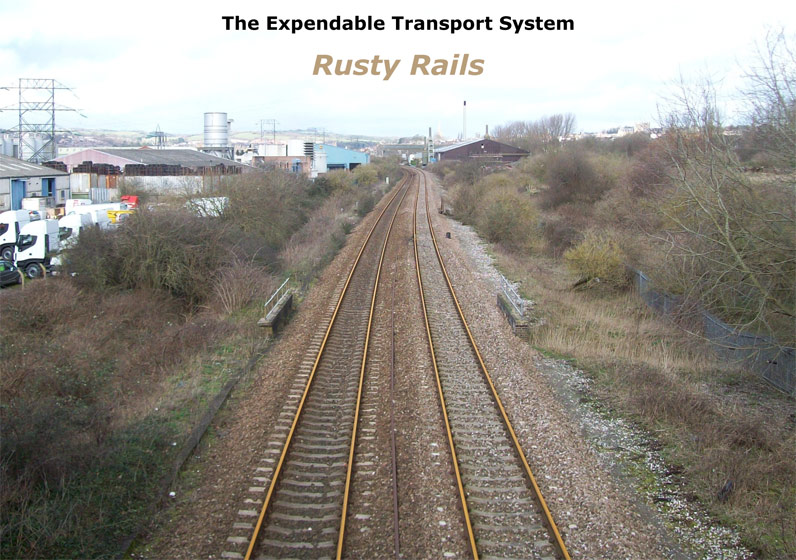
The disused South Devon main line passing beneath Clapperbrook Lane Bridge. Behind the camera is the site of the planned £4-million Marsh Barton Station. Would it have gone 59 days without seeing a passenger train?
There seems to be a strange residual belief at large that the railway still somehow fulfils the essential functions it once did, when many or most aspects of life, industry and commerce were in one way or another touched by rail transport. But that age is now so long in the past it is hard to see how anyone remains ignorant of what has happened: that the greatly predominant system is now road transport.
The wildly inflated sums that it was claimed were being daily lost as a result of the Dawlish débâcle do not stand scrutiny. For them to have been taken as reasonably accurate, there would have to have been obvious evidence such as factories on short time; business deals not being struck; holiday accommodation emptier than it would normally be in February and March; raw materials and components, consumables and luxuries not being delivered; and a host of other debilitating effects—in short, a severe economic slow-down.
The painful truth is that life in the two "cut off" counties went on and if people's travel habits were disrupted, it was more likely to have been because of damage to their local roads. Everyone got his paper and post, his food and fuel; these and everything else have been on road for many years. Certainly in the West Country, the railway is a side show whose traffic can be absorbed onto the roads without it even being noticed.
Train operators were running coaches direct from Plymouth to Tiverton and Bristol car park stations quicker than the trains. No-one bothered running trains to Dawlish Warren and Teignmouth. Diesel units were moved on lorries, albeit the 139 loads were far more than usual. Gas oil fuel was put on road last year.
Of course, a great number of rail passengers were put out by the blockade and these general observations are not meant to diminish the delay and inconvenience caused to individuals. But these difficulties must be seen in scale: fewer than 1% of people in Devon, for example, travel to work by train.1
As is the way of things, it is very unlikely that the railway will benefit from any but the most half-hearted action. Strong weather resilience will not be achieved. Indeed, expenditure may go to other modes. Government has already agreed to subsidize Newquay Airport and the campaign to improve the A303 road has become louder.
1 2001 Census
This saga is continued under:-
>> Great Western Main Line West of Exeter Route Resilience Study >>
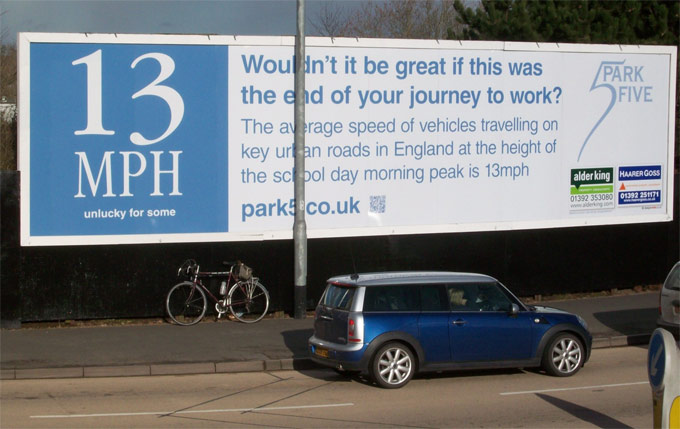
"Council leader wants remainder of Moretonhampstead Branch closed"
This is not what the leader of Teignbridge District Council actually said, but in the week before the Dawlish Débâcle, the Mid-Devon Advertiser reported:-
"Teignbridge Council leader Cllr Jeremy Christophers said he was also trying to persuade Network Rail to release the little used Newton Abbot to Heathfield line for a cycle-pedestrian route, but so far they were refusing."
On 7th February, the railway wrote to Teignbridge District Council requesting a reiteration of policy on the subject, as before the Local Development Framework was prepared the authority had confirmed, after hostility from the Stover Canal Society in 2010, that the railway was safeguarded.
>> Stover Canal Society threatens railway >>
Graham Smith, a Teignbridge District Council officer, kindly telephoned on 6th March to say that the letter had landed on his desk. He apologized for the delay in responding and said that he would be writing a reply when he could ascertain what the current policy was in respect of the branch railway.
He telephoned again on 2nd May but could give no more information.
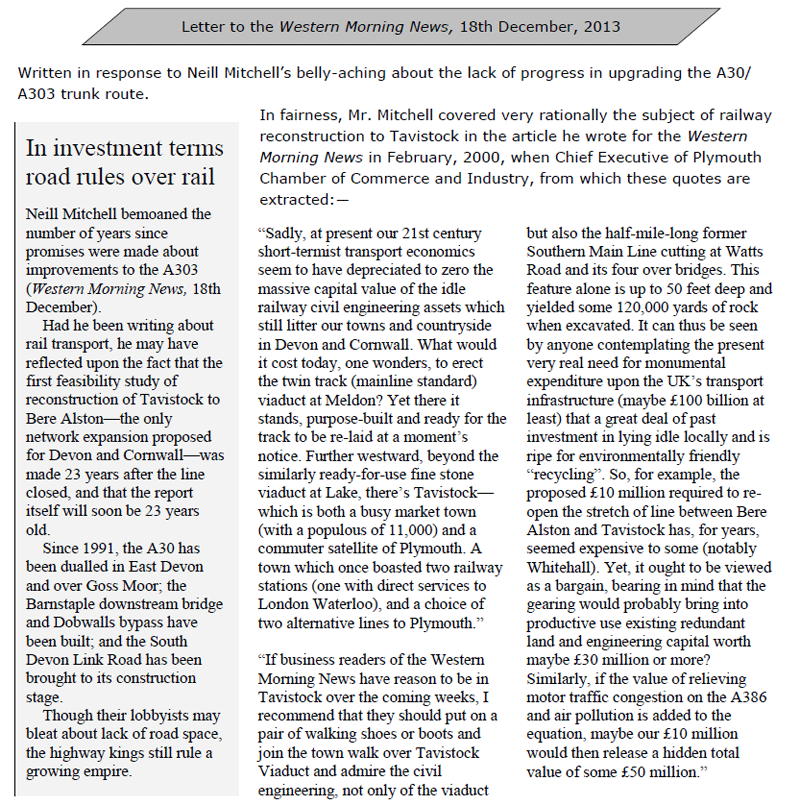
>> See also:— Broken Bridge—Bunkers Hill “B” >>
B.R. ceases to be
The fag end of nationalization has finally been snuffed out.
Further to the brief item on BRB (Residuary) Ltd. included in the Perridge Tunnel pages, it can now be written that the organization was disbanded in September, 2013, and its functions transferred to a number of existing bodies.
Most of the Historical Railways Estate (formerly known as the Burdensome Estate) was passed to the Highways Agency (of all people). Other responsibilities and liabilities were taken on by London & Continental Railways Ltd., Network Rail, the Rail Safety and Standards Board and the Department for Transport. Included in the transfer were the quaint “Rights to Wreck,” a residue of the railways' complete transport system.
Thus the people's railway that began life in 1948 vested with 20,000 locomotives, 55,000 carriages, 1¼-million wagons, 12,000 lorries, 123 ships, 35 hotels, 650,000 staff, over 8,000 stations and enough track to stretch more than twice around the equator, very nearly all financed by private investment with very little help from government (arguably, the railways had actually subsidised the state), ended up in 2013 with its remaining baggage being thrown out or given away like the few tatty possessions of a poor, forgotten soul after a funeral.
Greenwall Lane Bridge (EXR 7-04)
A case of state-sponsored vandalism
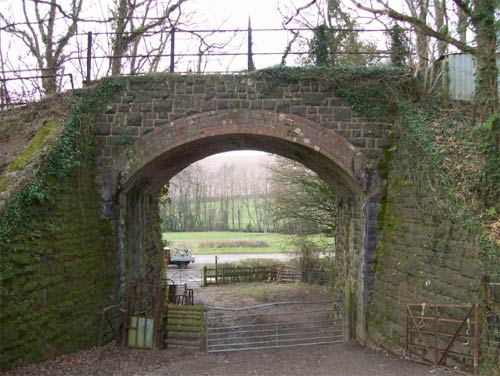
This bridge lies on the Exeter Railway between Dunsford Halt (Farrants) and Christow, seven miles and four chains from the main line junction. After the bridge over Marsh Barton Road in Exeter, Greenwall Lane is the most prominent of the remaining structures on the line. In poor condition, as may be expected after 60 years' neglect, the shadowy BRB (Residuary) Ltd.* applied to Teignbridge District Council in February, 2013, for planning permission to destroy the whole structure and slope back the embankments.
The railway made no attempt on this occasion to interest any local representative or parish council. Let their silence show how much they are interested in future public transport provision.
* BRB (Residuary) Ltd. was dissolved in September, 2013, and its functions passed to other departments. See >> B.R. ceases to be >> above. For an outline of its origins, see under Perridge Tunnel below.
>> Appendix: Objection sent to Teignbridge District Council >>
The application was passed under delegated powers in April, subject to certain conditions being met. Carly Perkins, the case officer, advised the railway on the 30th that the authority had looked into what it could do to preserve the structure but that there were no avenues open; their Building Control Engineer had examined the bridge and concluded that the BRB assessment was correct.

Richard Bland, the Teignbridge Conservation Officer, as a consultee strongly objected to the proposal in his response (making the number of objectors, two):—
“Demolition would remove a structure that makes a positive contribution to local character and distinctiveness.
“While significant defects may have been identified in the arch I don't think that a case has been made to justify its demolition, without the applicants providing the cost of the necessary repairs to the existing structure, when compared with alternative costs of demolition, disposal of the stone and other material off site and the re-grading of the remaining embankments.
“I would suggest that outright demolition of this historic feature without the above first being provided and the proposals verified by our Engineer should be resisted.”
Other interesting responses from consultees:—
Nigel Passmore, Devon Building Control Partnership:
“BRB appear to be a government owned organisation, and it also appears they do have an interest in saving and preserving structures and assets where it sees this would be in the national interest.”
Barbara Morgan, Town Planning Technician (Western), Network Rail:
“In relation to the above application I can confirm that Network Rail have no observation to make.”
at least to say: “We are not sure where the future might take us”?
Conveniently, around this time, Adrian Sanders, Liberal Democrat M.P. for Torbay, wrote a “Dispatch” column for the Western Morning News under the heading, “Investing in transport links is route out of recession.”
In it he stated:—
“One of the biggest challenges is deciding what the future holds for the main rail line west of Exeter. The line between Dawlish and Teignmouth is at high risk of disruption from rock falls and wave action; keeping this section of track maintained costs around £500,000 per year. It is likely that the situation will become worse, and therefore more expensive to deal with, in the coming decades, but to date neither the Government nor Network Rail seem to have done any long-term planning.
“As in the past, there are potential alternative lines that could be considered. In the early 20th century, services ran from Exeter to Plymouth via Okehampton and the Tamar Valley, while there was also a line between Exeter and Newton Abbot away from the coast through the Teign Valley. With passenger numbers and demand for more rail services rising steeply, people have started to look at reopening old lines and stations. In this case, however, we are faced with some serious obstacles.
“In the Teign Valley much of the old line is now covered by housing development, while the main drawback of the North Dartmoor line is its remoteness from the main centres of population and the increased journey time between Exeter and Plymouth.
The railway dutifully responded:—
Your dispatch to the Western Morning News last week was heartening stuff for those concerned about railway expansion.
Only a few months after a government minister, wading through floodwater, made the customary empty promise that something would be done about the resilience of the West Country’s rail links, the first effective action of the state was to apply to demolish a bridge on a former diversionary route, continuing the “scorched earth” policy practised for sixty years.
As a consultee, Network Rail was asked to comment by Teignbridge and the reply came back: “Not interested.” Would it have hurt this visionless outfit to have been daring enough at least to say: “We are not sure where the future might take us”?
Much of the former Teign Valley Branch is not covered by housing development, as you stated; in fact, there are only two houses built actually on the line. The obstacles in the way of reconstruction are great but not insurmountable.
Railfuture has computer-modelled modern traction over closed routes. In the event of disruption to the coastal main line, if the Teign Valley were open, with its four long passing loops installed as a wartime insurance measure, your train home might be delayed by as little as twenty minutes.
In engineering terms, the inland route is still 80% complete. Did not your 2010 manifesto pledge to look at lines that were still 90% complete?
Incidentally, the “Southern” line from Exeter to Plymouth, via Okehampton and Tavistock, did not close until 1968. Devon County Council refuses to back, even in principle, reinstatement of the abandoned section between Meldon and Bere Alston.
Of course, key to justifying expenditure on rail infrastructure is not just density of traffic carried, but its diversity also. It has to be asked why the railways have offloaded freight and parcels traffic. And why, for instance, no passenger train operator wants more than a small share of Torbay holidaymakers.
Thank you for showing some enthusiasm for rail transport.
Mr. Sanders kindly replied:—
Thank you for your letter of the 4th May.
The Liberal Democrats are indeed very much in favour of re-opening as many viable rail lines as possible. This is sadly not a view shared by the two major parties or indeed Network Rail.
There are plenty of backbench MPs who share my enthusiasm for this and hopefully we are slowly convincing bodies such as Devon County Council that far more investment in rail infrastructure needs to be made.
Thank you again for your letter and please do keep me updated with any developments the Teign Valley line makes.

In September, the railway wrote to Ian Leigh, the B.R.B. engineer, requesting that some of the facing stone be donated for incorporation into new work at Christow (A letter had been sent in April to Richard Bland, Teignbridge Conservation Officer, thanking him for his support and suggesting that he might put pressure on the Board to save material. It was learnt later that he had left to take up a position in Australia).
No reply was received but John Martin of Hammonds, the framework contractor, telephoned on 5th November to advise that all material was going to neighbouring landowners.
He showed a little interest in the project and said that he would call in when he was on site, which he did on 11th. He seemed a pleasant young fellow, but when a message was left for him the following week asking if the railway may at least have the iron railings, it was ignored.
The 1,500 tons of stone and earth was taken away during November and December to a nearby farm, which had conveniently become a licensed tip.
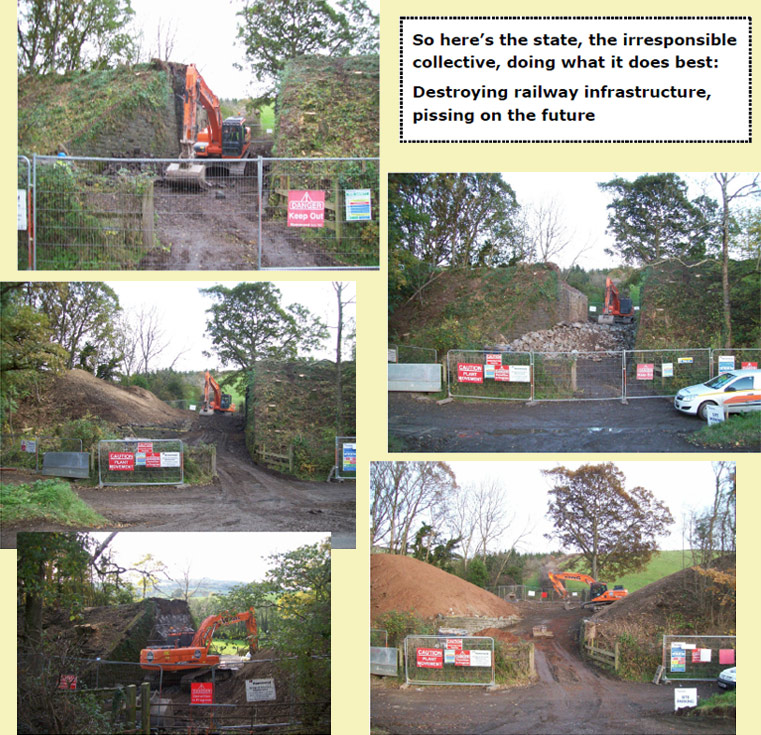
In March, 2014, the railway submitted a Freedom of Information Request to the Highways Agency, the successor to BRB (Residuary). The reply disclosed that the sum spent on the bridge from 2000 to date was £137,493.90 and that the cost of the demolition contract was £95,111.22, making a total of £232,605.12. This does not include the unavoidable costs of officer time and expenses attributable to this structure.
>> Appendix: Freedom of Information Request >>
Rationalization of Risk
To support the claim that demolition of Greenwall Lane Bridge was unnecessary, bridges in poor shape being not uncommon, the railway in its objection to the local authority drew attention to a weak bridge which crosses the Paddington to Penzance main line near Exeter.
>> Appendix: Objection sent to Teignbridge District Council >>
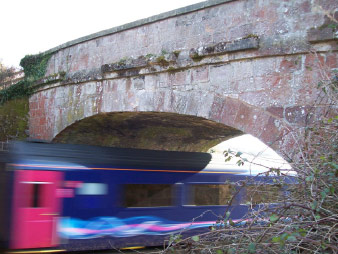
If indeed it was the only responsible course, the brick arch of Greenwall Lane being in real danger of sudden collapse, the railway used the example of Cotley Lane Bridge, where the abutments remain, as they do in a great many other cases.
The only reason that Greenwall Lane could not have been left in this condition is that the state has imposed an imperative to extinguish its liabilities, and the only way this can be done here is by reducing the structure to practically nothing. The state has 3,500 other redundant structures.
Set against the chance of the arch collapsing on someone—probably 10,000 times less than being struck by lightning—the risks attached to a demolition site are statistically much higher. A huge road vehicle mileage, small and heavy plant operation, carting away 1,500 tons of material along a narrow lane, all carry a burden of risk and consequence, seen and unseen, immediate and delayed. Of course it would have been irresponsible to have done nothing when there was the remotest chance of harm to human life, but the balanced response would have been the most minimal. That is, demolition of the arch back to its springing points, where the structure would be stable, and distribution of the fallen material between the abutments and wing walls.
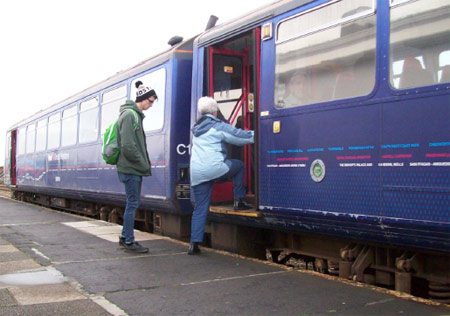
Another example of real risk can be found just beyond the main line junction, 7½ miles away. Many times every day for decades, passengers have been faced with the greatly substandard Down platform at St. Thomas Station, but nothing can ever be done to make it safe.
It is repeated until everyone is sick of hearing it that public money allocated to one area cannot be spent in another, even in the same field (broadly, in this case, transport), so it is no use considering how better it might have been applied. The £150,000 and more blown on Greenwall Lane, though government money raised through taxation, could not have been spent on some constructive task or to lessen some greater danger.
So the notional risk to the occasional rambler is dealt with at enormous cost, while the lot of passengers at St. Thomas is ignored. And this must include those elderly and less fit who find it impossible to use the station, and are therefore banished from the otherwise safe environment of the railway to the hazards of the world outside.
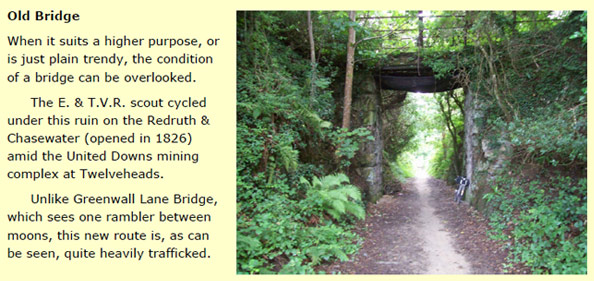
Broken Bridge
Bunkers Hill “B”
The railway which supposedly is billed to be the first reinstatement of a closure in Devon is the stretch of the former London & South Western (Plymouth, Devonport & South Western Junction Railway) main line between Tavistock and Bere Alston.
Talked about for more than two decades, it would be a half-hearted scheme, about as lightweight as railway reconstruction can get.
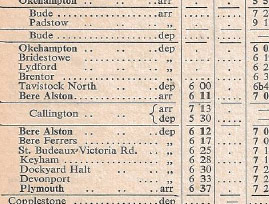
If plans were realized, Tavistock would not be served once more by through trains from Waterloo; it would not even have its North Station restored. The massive viaduct straddling the town leads to a station site smothered by development, including the West Devon council offices erected almost as a statement of policy: “We will never have a railway return here.”
Instead, a new car park station would be built on the outskirts of Tavistock, possibly as distant as Callington Road Bridge, to avoid having to replace its missing steel spans. Nothing more than a single line would connect the new “basic” station with Bere Alston, where the disused island platform would not be brought back into use for the Callington Branch. Trains from Plymouth to Gunnislake would share the single line from St. Budeaux Junction to Bere Alston with trains from Plymouth to Tavistock.
And the line would only be rebuilt if the now obligatory shared-use path were put alongside.
The first engineering feasibility study was done on behalf of Devon County Council in 1991, 23 years after the line was closed. The report itself is now 23 years old.
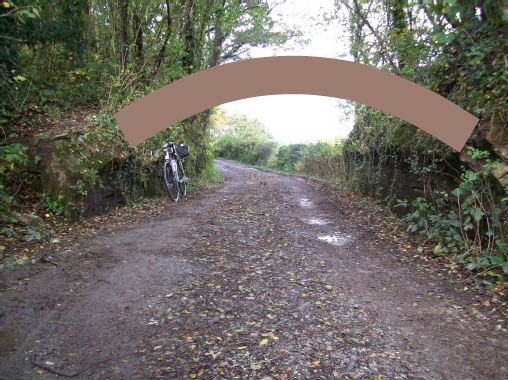
The consultants found, as the E. & T.V.R. scout did in September, that all the structures between Callington Road (exclusive) and Bere Alston were intact, bar one. Bridge No. 682, Bunkers Hill “B,” 219 miles and 72 chains from London Waterloo, and just six chains short of the buffer stop at Bere Alston.
The Teign Valley scout confessed that, distracted by the sound of the engine whistle on the other side of the Tamar, he cycled past without even noticing the ruined bridge, before skidding to a halt and setting back.
The line was closed completely in 1968. It can be taken that very quickly afterwards, following standard practice, the track was lifted and the railway laid waste. Not too many years later, the land was sold off where possible, including right up to where the buffer stop at Bere Alston sits today.
In the 1970s (maybe later, since the bridge is still shown on a 1982 survey), the B.R. Property Board would have got in a steam navvy to pull down the brick segmental arch, presumably because of limited headroom. The very substantial neighbouring embankment has since been reduced as well.
If anyone had come along at the time and suggested that it would not be long before consultants would be studying the possible reinstatement of the railway, he would have been laughed off the site.
The double line of well-engineered railway that once went over this bridge and carried express trains heading for Devonport King's Road and Plymouth Friary—and the latter-day D.M.Us. that this writer remembers—was gone.
This was not a temporary suspension of services while the era of cheap oil—and all the stupid, short-sighted planning and provision that rode on the back of it—was allowed to play itself out. No, this was annihilation. It was intended to be, or seem, physically irreversible and this view became rooted in people's minds, to the extent that most now scoff at the idea of railway reconstruction; unlike their take on the road transport structure which is somehow untouchable and meant to last for ever.
The point here is that the pleas for Greenwall Lane Bridge today were received in much the same way as those for Bunkers Hill “B” might have been when it was demolished.
The descendants of the people that would not have listened then are the residuals now making their last stand in a garret in York, where they continue to follow orders and destroy what they can of the abandoned part of the railway system.
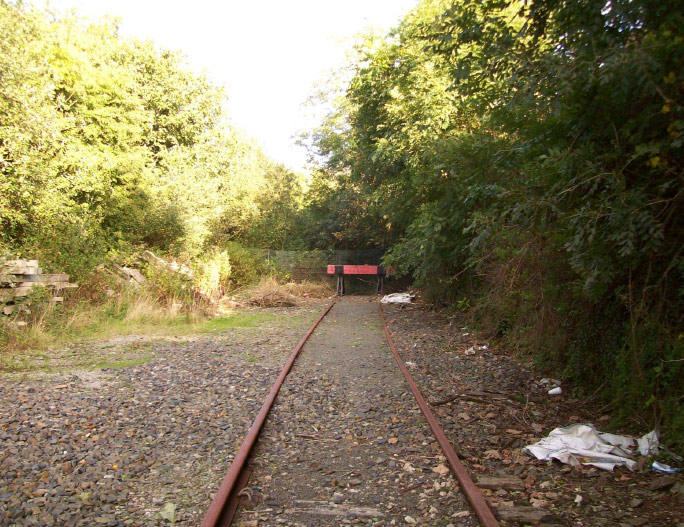
The ruins of Bunkers Hill “B” lie a short distance from the end of the line at Bere Alston.
Tavistock, 6½ miles away, waits for the return of one of its railways, which does not look like being soon.
Over this former Down Main, expresses from London Waterloo once sped towards Plymouth.
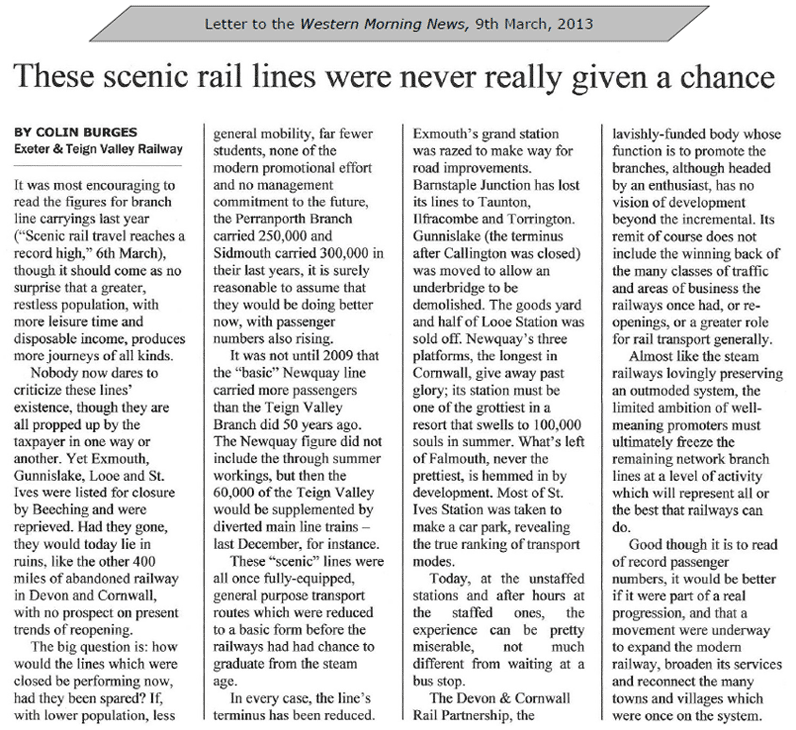
Perridge Tunnel
Perridge Tunnel is by far the largest individual engineering work on the Teign Valley Branch. It lies just east of Longdown Station in the parish of Holcombe Burnell and takes its name from the nearby Perridge House and estate. The tunnel's eastern portal is four miles from the main line junction, while the western portal is 3½ miles from Christow.
Work began on both Culver and Perridge tunnels in August, 1896. The ceremonial blasting through of Perridge's headings to join each other was completed on 3rd March, 1897. The bore was later opened out but it was to be another two years before the bricks were delivered to Teign House Siding (Christow), and the tunnel was not finally lined throughout until around January, 1902.
After closure of the line in 1958, the tunnel was let to Traycrop, Ltd., for mushroom growing and was later divided by a partition wall and let also to the former Exeter Maritime Museum for storage of craft. In about 1986, a collapse occurred and the tenants cleared out. It has been closed up ever since.
The collapse is almost midway into the tunnel, which corresponds with a point on the surface a little to the west of Perridge Lane. Here the crown of the tunnel is around 190 feet deep.
Unlike its close neighbour, Culver Tunnel, which is now part of the Culver estate and is open and in regular use, rock pressure caused movement of the lining quite early in the life of Perridge. This was first repaired in 1927 and repairs continued to be done up until 1950. Although there can be no denying that the lining is deteriorating (“Every possible tunnel profile you could wish to see is in there,” said one B.R. examining engineer), the tunnel is substantially intact: the collapse affects around 40 yards out of 829.
One of the defects discovered during the tunnel's operational life was that in places considerable voids existed between the crown of the lining and the shillet. This may have stemmed from inaccurate boring or from the time it took to line the tunnel after boring. In any case, the voids should have been filled so that any pressure on the side walls would not cause the unloaded arch crown to distort.
Another possible cause of the collapse was slippage in one of the nine recorded back-filled construction shafts, but this has been dismissed. It is now thought that the cause was a slip on a geological fault line along which part of the tunnel alignment coincides. In March, 2000, a 165 ft. borehole was sunk just off the line of the tunnel from 522 ft. above sea level. The tunnel floor rises from 339 ft. at the Exeter end to 382 ft. at the Longdown end.
BRB (Residuary) Ltd., the successor since denationalization of the B.R. Property Board and owner of the residual, non-operational estate, in keeping with its mandate to dispose of or extinguish its assets and liabilities, intends to block Perridge Tunnel with concrete in the area of the collapse; and beyond it, if there is determined to be a danger of further failure. In a reply from the now defunct Strategic Rail Authority to Richard Younger-Ross, M.P. for Teignbridge, this was stated: “The costs of partial infilling are estimated to be in the order of £800,000 while repair work would be at least £1-million.”
The railway (E. & T.V.R.) began its campaign in 2003 by bringing the matter to the attention of organizations, representatives and individuals, it being important always to shine as much light on an obscure subject as possible. South Western Mining & Tunnelling Ltd. and Gunn Engineering & Environment Consultancy were engaged to advise the railway in 2004 and later an approach was made to the Board's (BRB) civil engineer. He advised that work to infill the tunnel was programmed for the summer of 2006.
In a letter to the Director, Structures, at Hudson House in York, the railway contended that, although Perridge Tunnel “carried” a public road, there was only an “infinitesimal liability” and that no work really needed to be done. This was refuted: the risk, it was stated in reply, was that the tunnel could not be monitored in its present dangerous condition.
The officer was also asked whether the presence of the public road meant that the tunnel could not be handed over to other than a statutory body; Culver Tunnel, which lies entirely within the estate and carries no road, had been disposed of years ago. He replied:
“The presence of the public road is one of the factors preventing the transfer of the tunnel to a non-statutory body.”
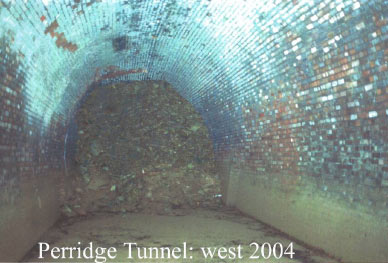 The railway's suggestion of a partnership, like the one that enabled the Lynton & Barnstaple Railway to fund the difference between repairing Chelfham Viaduct to a safe condition and one adequate for railway operation, was agreed to in principle. The railway then requested an estimate of costs and a meeting of BRB, Jacobs (its consultants) and the railway's engineers (to be paid for by the railway) at Longdown. No figure was mentioned in writing by the Board but it was agreed that a meeting should take place. That agreement was restated on several occasions but no meeting ever took place.
The railway's suggestion of a partnership, like the one that enabled the Lynton & Barnstaple Railway to fund the difference between repairing Chelfham Viaduct to a safe condition and one adequate for railway operation, was agreed to in principle. The railway then requested an estimate of costs and a meeting of BRB, Jacobs (its consultants) and the railway's engineers (to be paid for by the railway) at Longdown. No figure was mentioned in writing by the Board but it was agreed that a meeting should take place. That agreement was restated on several occasions but no meeting ever took place.
After obtaining a bat licence from DEFRA, delayed because work was prohibited during the hibernation period, a radar survey of the tunnel was completed in September, 2006. A copy of the survey report was provided for the railway's engineers to study. It transpired that the course of the tunnel was not quite as plotted by the Ordnance Survey.
The railway continued to keep in touch and press for the opportunity to present a viable and economical method of repair. A letter sent to York in July, 2007, included a résumé of South Western Mining & Tunnelling (see box).
The Board engaged Carillion Rail to research the construction and subsequent history of 60 (of the 160) disused tunnels remaining in state ownership, including Perridge.
No further word was received until a letter from the BRB engineer in February, 2009, advised that a planning application had been put before Teignbridge District Council for permission partly to infill the tunnel. The scale of the engineering works proposed exceeded even the statutory body's permitted development rights.
Strangely, the BRB maintained that a meeting was still possible. The railway replied stating that a meeting would cost around £1,000 and that it was “loath to spend such a sum if the outcome is merely a fuller explanation being given of the methods you intend to employ on the course you seem set upon.”
The railway hurriedly tried to whip up opposition to the planning proposal, which resulted in three out of the eight parish councils or meetings that were contacted writing objections to Teignbridge.
After reading the railway's letter to the Western Morning News, a volunteer with the National Coastwatch Institute at Teignmouth, who sees the natural forces attacking the coastal line, wrote an objection. And one conscientious individual from Ashton objected.
The district councillor agreed to call in the planning application for determination by the committee, which would have allowed the railway three minutes to convince the members in a former railway town that railways had a future.
The young case officer's hubby was a railway employee, yet she did not know what BRB stood for. How quickly the near half-century of the “Clause Four” railway has slipped into obscurity.
In an office not far from the station which once dominated Newton Abbot, where trains once left its Moretonhampstead Bay for the Teign Valley, the planning officer passed the case in front of her senior, forgetting to mention it had been called in, and the destruction of Perridge Tunnel was nodded through under delegated powers. The railway sent a letter to the head of planning asking for some general statement of support. The appeal not to be dismissed was answered with a six line dismissal.
Did any of this matter in the end? Not at all, for in July, 2009, the BRB engineer advised that the most likely option now was abandonment of the tunnel. The estimated cost of the infilling was £800,000; repair of the collapsed area was put at £1,100,000. Costs were estimated for the “do nothing” option; these were substantial but mostly theoretical.
All along, there seemed to be reluctance by the BRB to deal with the Cornish miners, who are in demand the world over (two jobs await each graduate of the Camborne School of Mines). This could be put down to any of a number of factors: the general aloofness of public bodies; the dislike of any shadowy organization having its cosy world intruded upon; and the enforced procurement procedure which militates against local, common sense solutions. The railway must stop short of claiming that there was a transport politics factor because no obvious influence can be discerned.
All that can be said here is that any impartial observer would surely find it strange that the offer to pay for the Cornishmen's suggestions to be heard was not taken up, if only for the sake of widening the advisory circle.
In January, 2010, the BRB engineer advised that both mouths of the tunnel were to be sealed and that internal examinations would cease.
>> Appendix: A selection of correspondence from the file >>
In March, 2014, the railway submitted a Freedom of Information request to the Highways Agency, successor to BRB (Residuary). The reply disclosed that from 2000 to date £221,015.72 had been spent on the tunnel, not including the unavoidable costs of officer time and expenses attributable to this structure.
>> Appendix: Freedom of Information Request >>
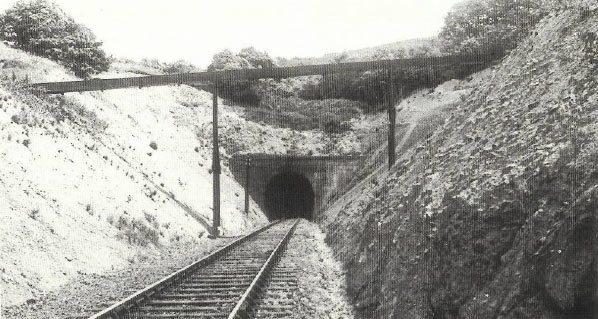
The western portal of Perridge Tunnel in 1921, showing the original aqueduct carrying one gully across the cutting to join another. This is the summit of the four mile climb from Marsh Barton. Just off picture to the left, on a rail post which is still there, would have been the board instructing Up “Goods and Mineral Trains to stop here to pin down Brakes.” A considerable length of the tunnel at this end (less at the other end) was built partly in the open and then covered. Had this not been done, to make the tunnel shorter, an enormous amount of extra material would have had to have been removed as the approach cutting became deeper and wider.
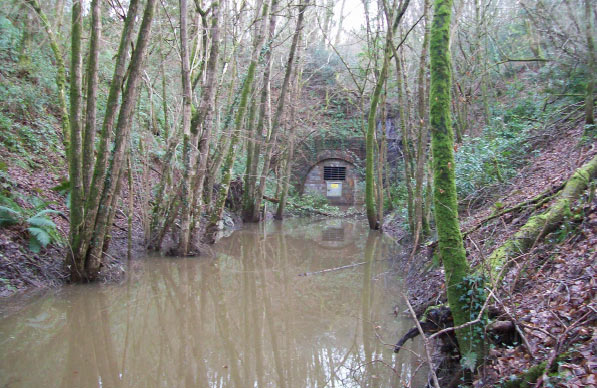
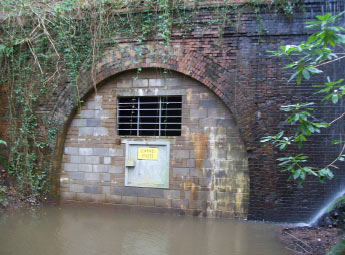 The western portal in January, 2013.
The western portal in January, 2013.
The “palisade” gate of recent years has been replaced by a wall with a ventilation grille and access hatch.
The notice warns of “CONFINED SPACES.” There were no such warnings when the Daniel brothers worked at South Crofty.
With much of the cutting rim drainage having failed, the basin is filling up and is at a depth of about 2½ feet at the tunnel mouth. If this level continues inside the tunnel, then the water will be up to the height of the blockage—above the crown—which will be acting as a weir.
About three chains of the tunnel at this end was built as “cut and cover,” still obvious on the surface. The five brick rings of the lining are visible.
Click on these images to enlarge and see captions.
Tunnel Inspection Reports
In response to a Freedom of Information request through "WhatDoTheyKnow," Highways England (now National Highways) released these reports of visual examinations of Perridge Tunnel by Balfour Beatty in 2017 and 2018.
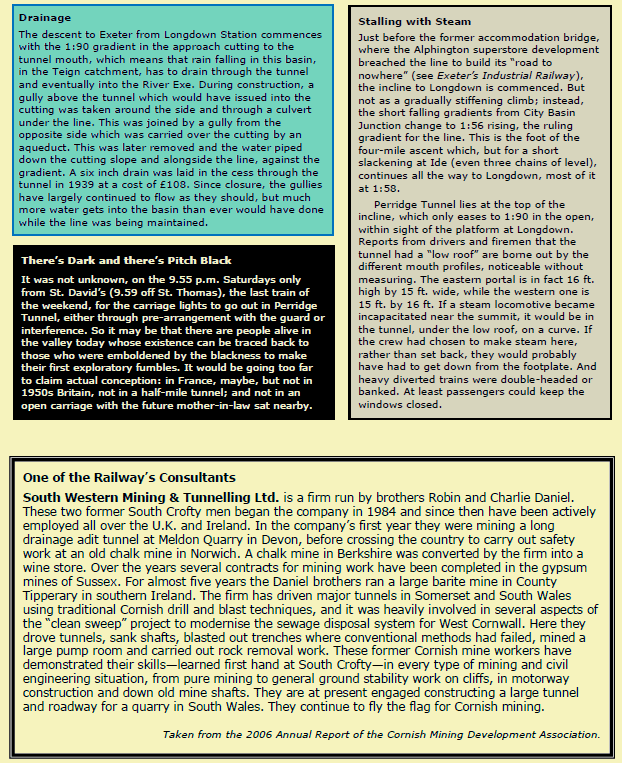

Don't destroy our disused rail routes
Talk of another railway route inland to Plymouth ("Second rail line not part of £35bn upgrade" and leader, 3rd April) generally refers to the reinstatement of the Southern’s main line via Okehampton and Tavistock. This was closed as a through route in 1968 and today 23 miles of it are dismantled.
Less mention is made of the Great Western’s way of avoiding its coastal route: the branch lines that linked Exeter and Newton Abbot by means of the Teign Valley. These closed from 1958 and now 15 miles of the 20 lie abandoned.
It was a difficult route: the severe gradients and curvature on the Exeter section through the north of the Haldon Hills and the original minimal track provision made for very drawn out diversionary working.
During the last war, however, Government paid for long passing loops at four stations which greatly improved the line’s capacity. And modern traction would make light work of the banks, which were less taxing anyway than those between Newton Abbot and Plymouth.
Railway reconstruction involves huge costs, but new construction would in most cases be very much more expensive. On the Teign Valley Branch, for instance, the two tunnels and four out of the six river bridges remain.
Ownership of disused structures is still vested in the fag-end of the British Railways Board, which is charged with disposing of or extinguishing its liabilities.
Many argue that the time has come to cease destroying disused railways because nobody can be sure what the future has in store. Continuing to develop road transport, with its complete dependency on oil, while shunning other modes, shows no caution or foresight.
Yet, even as there is increasing awareness of the need for an alternative rail route, Teignbridge District Council has before it a planning application by the BRB which proposes blocking a collapsing tunnel on the Teign Valley line with 100 lorry loads of concrete.
At nearly half a mile long, Perridge Tunnel, between Exeter and Christow, is the largest engineering work on the whole inland route. It was repaired several times in its operational life and is beyond repair now. I have tried to cooperate with the BRB, commissioning expert tunnel engineers to advise, but nothing I have been able to do has stopped BRB’s consultants firming up a scheme to destroy the tunnel, almost as if there were some other force at work.
Not beaten, I am now mobilizing opposition to the planning application from parish councils, pressure groups and individuals that think the tunnel should be kept open as an option for the future. Anyone interested may contact this railway, view the web pages (teignrail.co.uk) or submit comments to Teignbridge, quoting the authority’s reference 09/00389.
Plea to save tunnel falls on deaf ears
The letter you kindly published under "Don't destroy our disused rail routes" on 21st omitted a crucial word—which I think readers would have gathered. Perridge Tunnel on the Teign Valley line is NOT beyond repair.
It is now too late to stall the British Railways Board’s plans to block the tunnel through the planning process because the junior case officer at Teignbridge has issued a consent, despite the application having been called in by a district councillor for determination by the committee.
This is how a massive structure on what was once a railway route of strategic value is disposed of by the local authority, which happily continues with policies enabling free movement of the motor car and lorry, even as doubts grow about how the road system can be sustained in the future.
In answer to Richard Giles’ appeal for reality in rail spending (25th): the situation at Perridge is in fact led by the state’s pressing ahead with a scheme to destroy the tunnel which would cost around £1-million. My demand is that, if taxpayers’ money is to be spent, it should produce a beneficial result if possible.
Cornish mining and tunnelling engineers are respected and sought after the world over (I am told that two jobs await each graduate of the Camborne School of Mines), yet the BRB seems reluctant to give the specialists I have engaged a hearing. So it is not known whether the tunnel can be repaired for the same sum—or maybe even a bit less—as is planned to be spent on its destruction.
Who Supported the Railway?
| Organization or Individual | Stance | |||||||||||
| Devon County Council | ... | ... | ... | ... | ... | ... | ... | ... | Not interested § | |||
| Teignbridge District Council | . | . | . | . | . | . | . | " | " | |||
| Sustrans | ... | ... | ... | ... | ... | ... | ... | ... | ... | ... | " | " |
| Campaign for Better Transport (formerly Transport 2000) | . | " | " | |||||||||
| Railfuture (formerly Railway Development Society) | ... | ... | Supportive * | |||||||||
| Torbay Line Rail Users' Group | . | . | . | . | . | . | " | |||||
| Sir Harry Studholme (Landowner, Perridge) | ... | ... | ... | ... | " | |||||||
Before the planning application was submitted, Holcombe Burnell, Dunsford, Bridford, Christow and Doddiscombsleigh parish councils, representing in all 2,854 head of population (2001 census), had written to BRB (Residuary) expressing support for the railway.
When the application went in, an attempt was made to excite more of the line's communities. Eight parish councils or meetings were contacted, representing 5,318 souls.
Holcombe Burnell did not reply to the railway but objected to the proposal. Dunsford did not reply and entered “no objection” to the proposal. Bridford and Christow replied to the railway and objected to the proposal. Doddiscombsleigh did not reply, resolved to object but missed the deadline. Ashton, Trusham and Hennock did not reply and did not object. Bridford and Christow have since turned against the railway.
§ For good measure, does not support reinstatement of former Southern
route to Plymouth.
* Lists the Teign Valley as a route to be safeguarded. www.railfuture-sw.co.uk
Letters Appendix
For a while, the railway kept up a steady flow of letters to RAIL magazine and the Western Morning News, which circulates in Devon and Cornwall and parts of Somerset and Dorset. It was a useful exercise as it enabled different aspects of the wide subject to be summarized and articulated, usually in response to events, or a prompt from the editors or other correspondents. Many of the points had never been made before and the railway's approach was unusual. It is the sort of low level, “drip-drip” campaigning that the railway in exile should be doing all the time, across the land, to keep the ideas and knowledge alive.
Sadly, although the correspondence is now quite old, most of what was said remains true. So much could have been done since then, but instead nothing happened and the position is worse than ever today.
If you read nothing else of the 20,000 words...
The railway's favourite piece has to be the one that RAIL entitled "Who needs the men in suits?" The most succinct must be the one which rejected that there was any comparison between a modern train operating franchise and the oldest of the "Big Four" pre-nationalization railway companies.
The favourite line: "Don't you love to hear people who have been trampled on while making a bid to reach the trough, start moralizing about the inequality of the struggle?"
And the one the rag did not publish: “Thank you for issuing the motoring pages as a supplement. Now I can throw it out in one piece. When are you going to publish a public transport supplement for your grown-up readership?"
>> Appendix: Letters >>
Green Groups
The railway has attempted to make contact with and interest some of the many “action” groups which have sprung up in response to the recent revelation that the climate is changing.
The impression gained is that transport is too big a subject to be tackled and so members generally busy themselves with stuff that, as James Lovelock put it, “doesn't matter but makes conscientious people feel better.” And it is suspected that, even among many of the environmentally aware, the car occupies the same untouchable position.
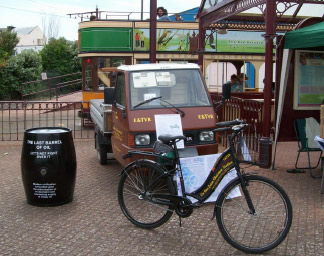 An exception is Sustainable Seaton, which bravely held its first Green Transport gathering in August, 2008. The railway went along with its new BEE, still in factory green, and a load of propaganda and props.
An exception is Sustainable Seaton, which bravely held its first Green Transport gathering in August, 2008. The railway went along with its new BEE, still in factory green, and a load of propaganda and props.
It was one of the wettest days of the summer and the gathering was held on the sea front. The railway team shivered through the morning and, wet through, eventually took refuge in a fish and chip café. Interest in the event was obviously dampened but the organizer deserved much credit for the initiative.
A neighbour at the gathering was the Seaton Tramway, whose manager kindly invited the railway for a guided tour; this was reciprocated. In October, Teign Valley friends enjoyed a full day's visit, which ended with fish and chips being eaten on the sea front while gazing at the lights of ships anchored in Lyme Bay and recalling the same place in August.
The Green Transport gathering was held again in June, 2009. The railway's autotruck was under conversion and so the event was missed, but the 2010 gathering was attended and it was fine. The railway's stand was photographed with the event's organizer for the Axminster Gazette.
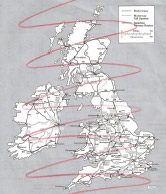 Boots the Chemist
Boots the Chemist
Until the railway is in a position to have its own diaries printed, it cannot function without the Boots Scribbling Diary, it being one of the few to start the week on Sunday.
In 2007, the railway wrote to the Nottingham H.Q. to congratulate the old quaker firm for sensing which way the wind was blowing and quietly repositioning itself. In the 2008 diary, the motorway map had been replaced with one of National Rail. Jesse Boot would never have forsaken the railway.
Unfortunately, the motorway map was back in 2009 and it is still there in 2013. Perhaps many more wrote about its loss than wrote in support of the rail map.
Rail Transport Services
As the cause of the decline of the railways since nationalization, at times the utter defeatism within the industry must at least have ranked equal with external political meddling and the other acts of sabotage.
For all that B.R. was at times capable of showing the vigour of private enterprise, the nationalized railway was mostly geared for continual contraction and it was a rare manager who wholeheartedly believed in the system in its entirety.
This malaise was not cured by denationalization and was epitomized in Exeter's Yellow Pages a few years ago. Under "Rail Transport Services," it said: "See road haulage." See road-bloody-haulage!
A letter was despatched to English, Welsh & Scottish, the company founded by Ed W. Burkhardt of Wisconsin Central, and now owned by a branch of Deutsche Bundesbahn. The craven surrender was pointed out to them and they were implored to be more constructive. The letter was repeated; no reply was received.
But the situation has improved: there is now no entry in Yellow Pages. Apparently, there are no Rail Transport Services.
Contrast this with the Great Western's bullish approach to establishing new sources of traffic, as exemplified in the circular letter (see appendix) from Exeter's Goods Office at the foot of St. David's Hill. The Great Western had Traffic Advice Cards for staff of all departments to fill in and return if it was thought that a firm should be approached with a view to securing traffic to the company.
A short railfreight revival occurred under Ed Burkhardt, the unlikely dragon-slayer of the new private era, who brought his experience from the States to our shores. In very little time, E.W. & S. salesmen had won back traffic and found new flows. Even with minimal infrastructure, opportunities were taken to load a few wagons at a semi-derelict siding and find a way of collecting them. The attitude was summed up in a statement issued to the railway for its 1997 open day (see appendix).
Ed, the only railwayman with a fan club, was unceremoniously dumped by his board and his expansive moves quickly turned to retreat.
But at least traffic is being forwarded again from Marsh Barton.
>> Appendix >>
And the traders—what do they care?
The example of British Ceramic Tiles.
Only in Britain could a railway station exist right beside a large factory without it being the least dependent on rail for the transport of its materials and finished products, not to mention the other services which once would have been afforded.
While this is not entirely true any more, road having somehow gained supremacy even in countries that have tried to advantage their railways, nowhere has general railfreight suffered such decline as in Britain.
Because of the reduced network and sparseness of facilities, and the dispersed nature of modern commerce and industry, there are often obvious reasons why rail is unsuitable or impractical as a means of transport; but when a factory site which once had a private siding is redeveloped and the railway remains at the neighbouring station, it becomes harder to explain if there is no movement.
Whose fault is all this? Is it anyone's fault? Well, of course it is. Putting aside the uncomfortable truth that in a democracy everyone has theoretically to share responsibility, the true instigators can be identified and the blame apportioned. It is not a simple process, but it is not a mystery either, even though as time passes, and knowledge and experience wane, it takes on the air of the inexplicable.
In a world full of chatter, strange is the silence on this subject. Letters to the shrunken railfreight organization are ignored; letters to traders and industrialists are ignored.
A reply from a rail operator might point out some of the political and practical realities of overcoming years of contraction, but still would sound an upbeat note. A reply from a manufacturing concern, priding itself on following good environmental practice, might state: “The Acme Tile Company has looked into using rail transport but no services are available to meet our requirements. The firm is desirous of putting traffic on rail and will press for changes in policy which would help to stimulate a revival in the mode.”
But, instead, there is no answer. Not a word. Not even the courtesy of an acknowledgement. In the so-called information and communication age, an entire system can slip from view and cease to be discussed.
>> Appendix: Letter >>
Stover Canal Society threatens railway
In the 19th century, it was the railways that did for the canals ...
Those who delight in finding industrial dereliction should see the remains of the Stover Canal before much longer, because they are about to be cleared and interpreted and prettified by the heritage humpers for the benefit of the masses, with their screaming children, shitty dogs and psychedelic psychling attire.
Seriously, though with some there may a tinge of sadness at losing a little unspoilt haven of the past, the restoration of the Stover Canal, sensitively done, would surely be a wonderful sight and a valuable amenity to Newton Abbot and the district.
The canal was opened in 1792, principally to carry clay and granite to the Teign estuary and thence to Teignmouth for shipment. The Moretonhampstead & South Devon Railway was built alongside the canal and it was later bought by the Great Western Railway. By the last war, the canal was disused, falling into ruin in the succeeding decades.
After ten years' parleying, a 30-year lease has been granted by Network Rail to Teignbridge District Council, which lease has been assigned to the Stover Canal Trust to enable work and fundraising to begin.
This would have earned congratulations from, and caused no concern to, railway supporters and campaigners, but for a stupid remark from someone, picked up by the press, about the Stover Canal Society's aims including closure of the branch line.
A letter was sent to Teignbridge requesting a statement of its support for retention and development of the railway in accordance with local plan policy. The council replied positively.
>> Appendix: Letters >>
Marsh Barton, Exeter
Further truncation of the Teign Valley Branch (Exeter Railway) to allow the development of an out-of-town superstore, the construction of a new road and the greater use of cars and lorries provides an example of how destructive planning policies of the „seventies and „eighties continue to be applied, even as authorities proclaim ever more loudly their conversion to environmental philosophy.
This case was first described in a pamphlet published in 1998. Much has changed since then but the following abridged version serves as a good introduction.
Anyone who has gone along Marsh Barton Road will have passed beneath a girder bridge, the only obvious sign that a railway penetrates the trading estate. Although not built as an industrial railway, it is today all that remains of Exeter's small system of lines which once served the area.
The changed emphasis of recent times may lead people to believe that this railway’s integrity and future development is assured. Here it will be shewn that this is far from being the case.
As a longstanding centre of administration and clerical shunting, Exeter has never had a large industrial area like its neighbouring cities and former great ports, Bristol and Plymouth. Even so, it would be unusual for a place the size of Exeter, positioned at the gateway to the west and once a port itself, not to have some vestige of a district given over to trade and industry, and of the transport systems which were once essential to such activity.
Plymouth, being a conurbation with water frontage on three out of four sides, has always had numerous industrial areas, unlike inland Exeter which originally had just one compact commercial district, clustered around its waterways, the River Exe and the Ship Canal.
The low-lying area behind the quay and the canal basin later became the domicile of the city's light industry and utilities. In 1867, a branch of less than half a mile was built to connect the South Devon Railway's main line with the canal, and so the two great transport modes of the 19th century came to coexist, with mixed gauge lines laid around the city basin, where a wagon turntable bed can still be seen today, preserved as a feature.
In later years, the branch would serve the canal, the gasworks, a timber yard, an engineering works and the Central Electricity Authority. Not strictly part of the Basin Branch, but accessible from it, was the oil terminal alongside the main line, designed to discharge quickly complete trains of fuel tankers.
The Paddington to Penzance main line contained the industrial area for many years, and when the embankment was made on the other side which completed the Exeter Railway from Christow in 1903, it stood above the fields of Marsh Barton. The E.R. intended that its new Alphington Road goods depot (now the site of two more loud shopping sheds), although on the Up side of the main line, would serve the old commercial district just around the corner under the bridge. The E.R. was linked directly to the Basin Branch by the Canal Branch, which dived under the main line between the two junctions.
It was not until the opening of Exeter Corporation's new cattle market in 1939, along what was Marsh Barton Lane, that the old area spilled over into a new expanse. A siding from the goods depot ran down to Marsh Barton Road and served the extensive cattle pens at the foot of the Exeter Railway's embankment.
The Exeter Railway joined with the existing Teign Valley Railway at Christow, the two lines being worked as one, later generally becoming known as the Teign Valley Branch. The early development of Marsh Barton Trading Estate would have been seen from the branch trains, but this view was denied the railway passenger when the line was closed in June, 1958.
The track was immediately lifted between Christow and Alphington Halt, the usual practice to prevent any thoughts of reinstatement. The dismantling would have extended to Marsh Barton Lane were it not for two of the new traders on the estate requesting rail connections. So, instead of Marsh Barton Lane bridge being demolished as well as the one at Church Road, it was rebuilt in 1960 with a new longer span and the road beneath was lowered to give the standard clearance. A three-quarter mile rump of the old Exeter Railway was spared, the last 11 chains acting as a headshunt for the new Marsh Barton Trunk, which was opened in July, 1958. The line fell towards the estate and had a buffer stop just off Trusham Road.
Following the norm everywhere else, the railway gradually retreated from the area. Commercial shipping ceased on the canal, the power station shut, Exeter converted from coal to natural gas and firms went over to road transport. Alphington Road goods yard and its modern rail-served warehouse were closed. The cattle market removed, though its sidings had been lifted long before then. Part of the Marsh Barton Trunk was recovered, followed by part, and then all, of the Basin and Canal branches.
All that remains today is the rump of the Teign Valley line, the “EXR” mileage mark on Marsh Barton Road bridge being one of only a few clues to the railway's origin. The Trunk now goes only as far as Pearse's siding, from which is despatched a weekly block train of fragmented scrap to a Cardiff steelworks. For a while, before the purchase by Wisconsin Central of the B.R. railfreight operation, this was Exeter's only revenue-earning traffic and all there was in Devon outside Plymouth.
The remnant of the Teign Valley Branch, now Exeter's industrial railway, having survived largely hidden from view for forty years after the last passenger train, is now under threat. The railway which is the reason for many of the Marsh Barton roads being named after Teign Valley villages is to be cruelly truncated by the very authority which should be responsible for the line's integrity. And not because the line is defunct, its traffic having long ago vanished, for on most Saturday mornings the old E.R. still carries a thousand tons of metal over the same track whose condition in 1958 was cited as one of the stock reasons for closure to passengers.
The threat to this tenuous rail link arises from the growth of Marsh Barton and its road traffic. The estate has only two entrances and now has a new neighbour, the more genteel business park, feeding its traffic. For many years, expansion was held up by the Alphin Brook, but development has long since crossed this natural boundary and now rolls out like the Wehrmacht across the Russian steppes. Homes have sprung up all over the old commercial district, helping to reduce the pressure on the green fields, while these are gobbled up by the extravagant, North American-type land use of park developments, whose sprawl was caused, and now depends upon, road motor transport.
The desire to provide a new entrance to Marsh Barton and relieve some of the pressure on Alphington Road, one of Exeter's busiest routes, led to plans for a Grace Road link. Grace Road is very near to Alphington Cross and it is only natural that the highway boys should be itching to join them up. At the Marsh Barton end is an empty plot, formerly occupied by a factory, while at the other end is a development site where the Government Buildings have recently been demolished. Between lies the embankment of the old Teign Valley line with its accommodation underbridge, reminding of the days when there were fields on each side.
The Government Buildings site was designated in Exeter City Council's local plan as employment land, a continuation of existing use and an extension of Marsh Barton. However, speculators had a different idea and sought planning permission for a retail development. Rightly opposed by the city council, this application was granted by Government after an appeal because of the value of what is called “planning gain;” the developers had agreed to build part of the Grace Road link at their own expense.
At this stage the retailer did not have a name, so which one would take up this opportunity? Less than a mile away is the second of Exeter's three branches of Sainsbury's, a dreary „eighties shed adding a further blot to the already disfigured riverside at St. Thomas. Sainsbury's could not let another giant open on its doorstep so it had little choice but to take the Government Buildings site. Soon there will be a redundant superstore at St. Thomas and an even bigger new one, complete with petrol filling station, in Alphington. And there will be a road to nowhere: part of the Grace Road link will be built as far as the railway's boundary fence.
The county council has no powers to purchase operational railway property, but this is immaterial in a case like this where the owner is only too glad to divest itself of land which is seen more as a liability than an asset. Not long ago, the solution here would have been somehow to lose the residual traffic; all around the country, a well-practised routine involving reduction in service, ridiculous rate rises, condemnation of sidings, imposition of impossible conditions or the like, would usually convince businesses that their traffic was no longer wanted on rail. Fortunately, that sort of approach has been dropped but we are left with the colossal damage to the infrastructure it caused, as every flow of traffic lost was followed swiftly by the ripping up of track and terminals.
But truncation of the branch is still possible. Pearse's premises lie in the fork between the main line—that is the branch itself—and what is left of the Marsh Barton Trunk. The yard immediately adjoins the branch, but is at a lower level, so if some means could be found to load wagons standing on the embankment, the rest of the track could be taken up, leaving the way open for the developer of the Marsh Barton plot to oblige the impoverished council by building the second half of the new road, cutting through the railway's abandoned earthwork.
Despite lots of talk, there is still no sign of traders queuing up to use rail transport and some may question the point of holding on to track which can be dispensed with by restructuring, or which has been devoid of traffic for some time. But this is Exeter's only industrial railway. A public railfreight depot has been mooted for Marsh Barton and the site of Hardinge Machine Tools would serve the estate in this capacity very well. The course of the Trunk is still open and if it were to be relaid, firms requiring rail transport could take premises along Marsh Green Road and Christow Road, which back onto the line, as they became available. Sight of the buffer stop on Trusham Road used to suggest that it had once been the intention to continue the Trunk further into the estate, possibly with in-street sections. These opportunities will be lost, at least in the short term, when 14 chains of the branch is taken up. And it should be borne in mind that the track authority is under no obligation to surrender its land, certainly not to assist road development. Attracting freight traffic back onto rail is always going to be hard now that commerce and industry have become in the main so remote from the network; a situation aggravated by the loss of many railways which once penetrated the industrial areas. It is madness now to inflict further damage.
Anyone looking at this little area would have some difficulty in reconciling what is occurring on the ground with the various policies and guidance notes that have been reissued to reflect the public's new-found concern for the environment. With the county being unable to fund the Grace Road link, the key to the commencement of the scheme has been the new superstore situated well away from the city. Out-of-town shopping is supposed to be discouraged because of its effect on centres and its complete dependence on motor transport. The city council was not at fault here, but if the link road had been shelved, the inspector would have had no planning gain to consider at the appeal. In this case, the retailer is relocating from a town site occupied for scarcely ten years, thus introducing the ultimate in material consumption: the throwaway building.
The road improvement was not planned because the traffic of the area had ground to a halt, although this is very nearly the case sometimes, but because it is still accepted that the number of motor vehicles will rise and that therefore additional road space will be needed. This theoretical forecasting has now been discredited, either for the simple reason that providing for a perpetual increase in traffic can no longer be afforded, or because of a realization that endless road expansion is actually getting us nowhere.
It is strange, then, reading in the county plan and elsewhere about the hierarchy of transport modes, about the protection of railway land, the importance of town centres, the need to make less use of cars and lorries and to cut emissions, about sustainable development and all the rest of it, to come across an instance where three of the subjects repeatedly mentioned arise together—out-of-town shopping, road building and railfreight—and to find that the one which by all accounts is to be encouraged, is in fact being sacrificed for the benefit of the other two.
The route of the A38 road through Plymouth was protected for nearly 50 years before it was built. The preferred course of the Kingskerswell by-pass, which may never be built, is posted in the Teignbridge planning office and woe betides any rotter who applies to encroach upon it. Yet there is no measure of protection even for an operational freight railway and nothing like the same degree of foresight can ever be used where potential is unclear. Railway capacity was for so long reduced to suit the diminishing traffic available that there grew within the industry a mindset against keeping disused track in place, while the idea of major railway development taking place in the coming years is still impossible to entertain, as the statements of the track authority shew.
Those council officers with any conscience will be trying to overcome the problems of beginning an era of change and will be preparing to wrestle the monster that their predecessors helped to unleash. Others, unwilling or unable to get in step, will be happy to carry on the same sweet way they are used to and will see no real conflict in the situation here described, paying lip service to the new thinking: “Huh. We are doing all we can to encourage benign transport. The new superstore has four cycle spaces.” This lot will be undismayed by the power of big business and mystified that people should be increasingly dissatisfied at having to endure the motorized mayhem that is the substitute for sensible, far-sighted planning. If ever they stand back and regard their work, most will probably not see the damage that has really been done. While the roads of their subtopia throb with the daily scramble of people and goods turning ever-increasing circles, the old gang, slaves to the rubber wheel, still find this preferable to what might have been had public transport systems, particularly rail, been properly evolved and utilized.
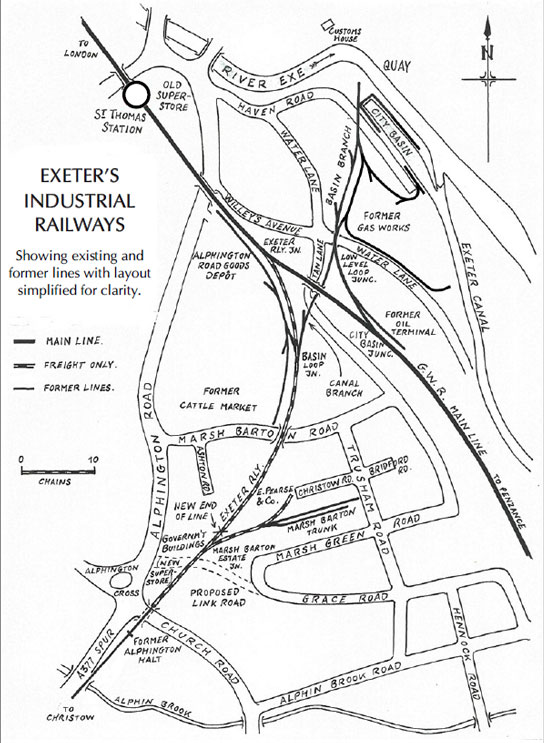
Britain has already lost enough railway track to stretch more than once around the equator, so it hardly matters at all that the stump of a branch line shut 40 years ago is to be pared further. But as long as railways are on the retreat, even if only a little ground is lost here and there, all the fine principles of reports and publications are rendered worthless in reality. Putting modern ideas into action—that is if indeed they are intended to exist other than on paper—would mean safeguarding the railway formations at Marsh Barton and redoubling efforts to make them active again.
In the very long term, it may be that another reason for retention of this railway is justified. With rising sea levels and worsening weather, it is not inconceivable that a main line railway company, having reclaimed for the means of transport its former importance, may be glad at times to have an inland route to Newton Abbot.
But perhaps this is just too fabulous a notion—expecting a democracy to look twenty years ahead.
Further Reading (see Publications)
For more than a generation, almost every planning decision has been based on the presumption of an infinite and abundant supply of oil—cheap oil. The scale and layout of modern development and the motor transport which makes it function is thus highly extravagant in the use of resources. Yet even after it has dawned on us that this whole structure in unsustainable, we can only make the feeblest attempts to change because what has been created is now so firmly established and all-embracing. Authority is naturally in the same position and while a series of half measures have been enacted as a sop, the momentum of the old order remains very largely unimpeded. A Journey in Time (91 pp.) describes the aftermath of a massive upheaval—caused by events beyond our control—as it affects a small part of Devon. The story is concerned mostly with transport, one of the worst modern offenders, but this subject cannot be discussed in isolation because it is so intertwined with others. Marsh Barton comes into view through the carriage window during the course of this journey and it can be seen how the new culture has altered an old-fashioned trading estate and how rail transport plays a vastly-expanded role. The issues touched upon here are examined in detail and so is the way in which transport affects, and is affected by, the rest of civilization. Shopping Mad (4 pp.) argues that supermarkets, being totally dependent on excessive use of road transport and huge amounts of packaging, can have no place in a world which will soon have to make serious efforts to reduce energy and material consumption.
By the time the pamphlet was published, the fate of the railway had long been decided and the late protest that followed was no less futile an exercise than would have been formal objection through the usual channels from the start.
There are periods in history when rationality and foresight play no part in events and anyone bold enough to preach caution is ignored or vilified, as if the path to war were set. Even in peacetime, when passions are not so inflamed, an unstoppable momentum can carry mankind towards the precipice, no matter what warnings of disaster are heralded.
Knowing this, people at odds with their times should not break themselves in vain, but instead should articulate their views as best they can and then withdraw, leaving the majority to get on with whatever idiocy prevails.
At the height of the frenzy, nothing much could actually be done to stop construction of Britain’s major road system, intended to replace the railways. Thousands threw themselves into the fray but were overwhelmed by money and corruption.
Today there is less concerted opposition to what has sprung from massive road building, notably urban sprawl and the ugly power of the giant retailers, who outgun every local authority in the land.
Meaning that anyone who opposes a case involving the development of a superstore and a road may as well kick at the incoming tide.
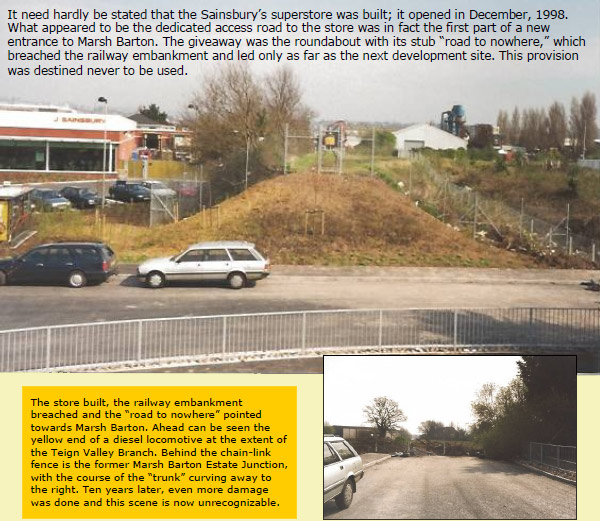
A small aside here is the story of a far from everyday purchase from Sainsbury’s.
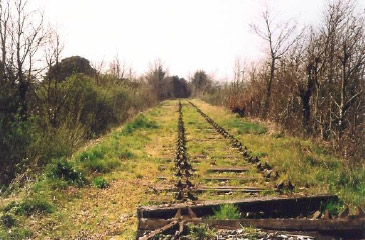
The firm had become the owner of the isolated section of railway embankment with its chaired sleepers still in situ. It was 2001, the year of the foot and mouth outbreak, and the only reason the sleepers had not been snapped up by the Min of Ag for its pyres was the fact that they were inaccessible to machinery; so the Teign Valley person was told when he found himself behind the scenes at the new store, dealing with a maverick Cornish manager who clearly didn't like Devonians. “Contractors are paying £25 each for them so you're going to have to do better than a pound,” he had said in the course of protracted bargaining. The T.V.R. did better the figure, but not by much, and the transaction was rung up on the till at the checkout; without the 180 sleepers having to be wheeled through.
This manager may have allowed access on the occasion of the walk organized to commemorate the centenary of the opening of the railway, but he had gone by 2003 and his dim successor refused. Sainsbury's and E. Pearse & Co. were the only track owners who would not allow entry.
From the Preface to the Second Edition of A Journey in Time.
Sleepers being recovered from Alphington and taken to Christow was not something I predicted in 1996. Rejecting the idea of defeat, I said that the developers would be foiled by stiff opposition from the rail lobby—that is, me—and that the branch would remain intact, being carried over the Grace Road link by a new underbridge, replacing the original accommodation one.
In fact, the rails were cut up, the land was sold and the railway embankment was breached. Today a road—as yet to nowhere—juts towards Marsh Barton through the gap. Soon it will be joined to the trading estate and land which should have been reserved for a rail freight depot or for rail-connected traders, will instead be occupied by Halford's, Pizza Hut and Kentucky Fried Chicken. So the development of Exeter as a standard cultural abyss continues.
Working atop the section of isolated embankment, my loaded “Dobbin” barrow aided by the 1:56 gradient, the most severe on the whole 16 miles, I have had chance to survey once more the world in which I feel such a stranger. This vantage point differs so much from its surroundings—homes and gardens neatly kept on one side, literally acres of tarmac on the other—that it is rather like looking in from the outside or from another time. The overgrown earthworks of disused railways are a familiar sight, but to find a strip of wild enveloped by the city and only little more than a mile from the centre is somewhat unusual.
As I dismantle what is left of this short length of railway, 7½ miles up the line from Christow, I can hear trains on the main line passing over the junction points and occasionally a freight train reaches the buffer stop of the branch, now truncated to the scrap yard; for forty years it had reached out almost as far as Alphington Halt.
The most invasive sights and sounds come from the direction of the new supermarket: a sea of cars and the unending drone of mass motor transport, including small diesel buses. It would be so easy to capitulate, to abandon my cause as hopeless and lost, yet I take heart from my scant knowledge of history. Empires, tyrannies and crummy institutions which seemed unshakable, unconquerable or irreplaceable, often appeared so until very near the moment of their collapse. In the society built upon cheap oil, I see both the weak foundations and the tottering structure, and I remain convinced that it will fall.
C.B.
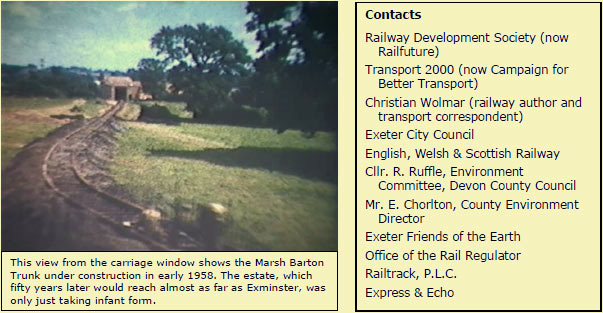
>> Appendix: A selection of correspondence from the file >>
The attack continued ...
Thirty-odd years after coming to Exeter, twenty-odd years after opening its second store at Exe Bridge and less than ten years after opening at Alphington, Sainsbury's were aware of “overtrading” and exhaustive studies revealed that, vis-à-vis competitors, in the dog-eat-dog world of modern retailing, the Alphington site was now quite disadvantaged.
So, in 2007, planning permission was sought for an expansion of the store and car park. The firm, under the holding name Eagle One, had acquired the neighbouring development site and it was also proposed to build the new road with houses and flats on one side and commercial premises on the other. The obligatory link road (actually to Marsh Green Road) was to be built on a different alignment, taking more of the railway embankment and wasting the earlier preparatory work.
The opening line of the Teign Valley's objection was the routine provocation: "It is well known that "so-and-so" is anti-rail."
The 2,300-word letter included these paragraphs:-
How big does the writing on the wall have to be? Councils continue to base every decision on the assumption that a substitute will be found for oil to perpetuate all that has been put in place, instead of beginning in earnest the transition to other systems. Futile gestures abound, while the same worn old blueprint is used again and again. Car culture—the thing itself and all that it has made possible—is now so embedded in human life that it blinds even those who should be planning responsibly for the future. Cars get bigger and are driven further more often. Lorries get heavier, corrugating the roads. Material consumerism grows rampantly while the pits which receive the detritus get smaller. American-style urban sprawl, entirely dependent on the car and the truck to service it, continues its cankerous advance into the countryside. The great edifice of modern civilization rises higher even as the sands beneath it start to shift.
The city is here given the chance to make a stand, to prove that change is afoot and at last to make a nod to coming realities. It could safeguard a railway, if only at first for the benefit of a few small traders who would show again how rail can provide unobtrusive transport. It could constrain an out-of-town superstore to help local enterprises entice shoppers back to parts of the city centre that have not yet been sterilized by flat-pack architecture, so that something of the character and vigour of pre-War Exeter could be reestablished. The city could abandon a senseless road scheme born in an era of ignorance and start planning for Exetram. It could even do better than the county and climb down from the position of saying that there will never again be a Teign Valley branch railway.
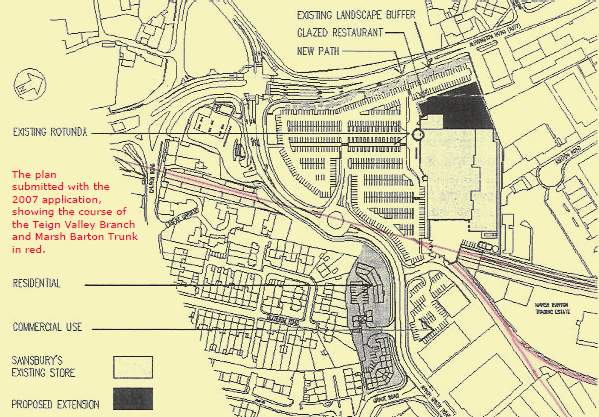
Splenetic?
The case officer must have handed the letter to one of the city's bellhops, John Rigby, Director of Economy and Development, now retired.
 Indignant pretence masking guilt, he stated that planners generally were very pro-rail but failed to give even one instance of this bent at work in Exeter.
Indignant pretence masking guilt, he stated that planners generally were very pro-rail but failed to give even one instance of this bent at work in Exeter.
After accusing the railway of being ill-informed, he stated that the Grace Road Link had been recently agreed, when in fact it had been a longstanding aim.
Quickly moving to the justification for the new road, in another example of the thinking that it seems nothing will undo, he trotted out that the link “is desirable in order to ensure that the industrial estate, employing some 9,000 people, can work more effectively because it is at present substantially constrained by only three entry/exit points.” Note that even as he professed his rail tendency, he failed in this case to consider the branch as a transport route.
Getting himself off the hook, Rigby said that he had only skimmed the letter and did not like the tone, so he would not be answering any points in detail.
 Laughably, he advised that the best way of advancing the cause of rail was to join Transport 2000, a pressure group that gently and ineffectually lobbies central and local government.
Laughably, he advised that the best way of advancing the cause of rail was to join Transport 2000, a pressure group that gently and ineffectually lobbies central and local government.
Secretaries of such groups quietly would probably love to be more forthright, but they represent timid memberships and fear being cut off from the little consultation that occurs if their stance ever went beyond the "critically positive."
The reader will decide whether it is wrong to let passion and belief permeate writing of this sort, a style which a man used to the sterile, heartless verbiage of innumerable policy documents would find "splenetic."
Sainsbury’s withdrew its planning application and submitted a revised one the following year (2008).
The Teign Valley's short objection contained these lines:-
Even the first minor petroleum price rises are causing hardship and dismay, but, as the fabled peak approaches, there can be no more cheap energy and there is certainly no alternative that can be squandered as oil has been. Security of the nation's food supply is suddenly looking shaky, thanks in large measure to supermarkets' global purchasing methods and their screwing of domestic farmers. Earth's resources are being depleted at a frightening rate, both land and raw materials. Add the problems of climate change, pollution, waste disposal, reduced fertility, loss of human skills and capacity, and much else that should need no expansion upon here, and the warning becomes less writing on the wall, more smack in the face.
Were Exeter part of the transitional movement, what its council would do is constrain expansion of the superstore to the existing site and confront the developer's manipulation of the planning system; preserve the railway formation both for access to the trading estate and future reconstruction of the branch line; have confidence in the railway being able to snap out of its present stupor and rise to the challenge of winning back its position and new traffics; allow development of the Hardinge's site for commerce and industry, laid out for rail at the doorstep; accept the need to reduce and gradually eliminate dependence on the car and heavy lorry; encourage a return to diverse and dispersed small to medium-size shops and outlets which would be much better able to arrange local supply; scrap the road link, the pet project of some long-retired traffic engineer of the 1970s school.
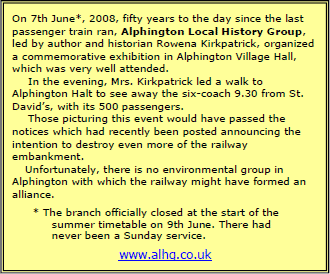 In September, 2008, Exeter City's planning committee refused permission for the development on the grounds that the proposal would mean the loss of too much of the railway embankment. Its value here was the screening it provided between Sainsbury's car park and the residential area, and as a nature reserve; no transport potential was attached to the earthwork, despite it having carried traffic on rail only ten years before.
In September, 2008, Exeter City's planning committee refused permission for the development on the grounds that the proposal would mean the loss of too much of the railway embankment. Its value here was the screening it provided between Sainsbury's car park and the residential area, and as a nature reserve; no transport potential was attached to the earthwork, despite it having carried traffic on rail only ten years before.
Incidentally, Sainsbury's had bought one of the houses nearest the store at above market value. It is not clear what the purpose of this was, but it could have been to provide for a footpath through to Blenheim Road.
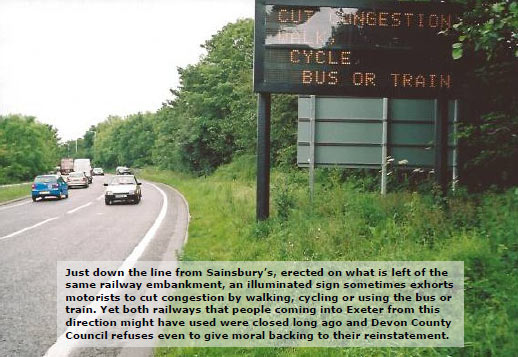
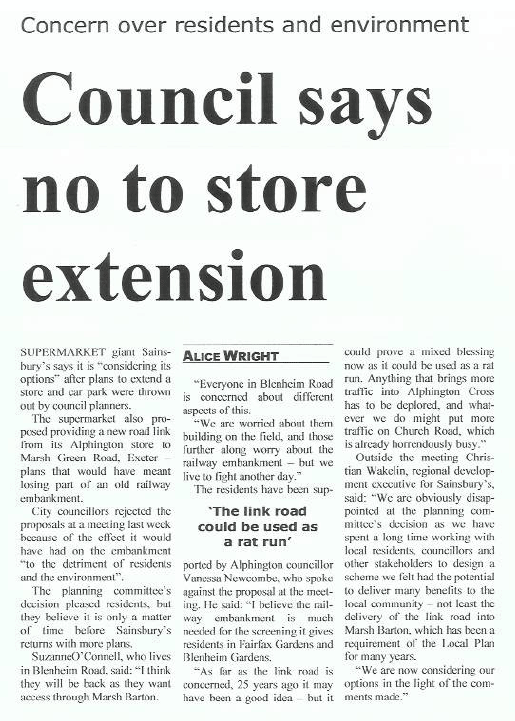
A Third Objection
Like a great army, regrouped and reinforced, Sainsbury's again joined battle in 2009, determined to win their objective. Actually, this time the campaign was less ambitious: the homes and flats had been dropped and the road and roundabout realigned so as to take much less of the railway embankment. And a new embankment was proposed which would divide the residential area from the rest. Some environmental crap was thrown in as a sop.
If only for the mind stretching (and possibly to be assured a place at the top table after the revolution), the railway shoved in its third objection to the straitjacketed authority. The following passages are extracted:-
Anyone with an enquiring mind, standing near here today, might reasonably ask how the much trumpeted raft of policies designed to reduce car and truck dependency, encourage freight onto rail, reduce pollution and waste, tackle environmental degradation, improve health and so on, had been interpreted in this instance.
For the reality—practice over policy, it could be said—is that a railway which once served communities nestling in some of the most beautiful countryside immediately accessible from Exeter; a railway which was once a diversionary route for main line trains now more than ever troubled by disruption on the coastal route; and a railway which, forty years after closure to passengers, was still carrying freight traffic and had vacant land on its flanks which should have been reserved for railfreight customers, was lifted to make way for a road.
In fact, 500 yards of functioning, network railway was lifted to make a few yards of 1970s “aspirational” road, which it seems, like so many hare-brained schemes of the time, once published in a local plan, can never be unseated by alternative thinking in later years. Such is the driving weight of the road establishment, that its adherents will continue with a scheme without having the sense to question its original purpose or test it against accumulated experience.
So, less railway, more road; more cars and lorries; worse air, more CO2, poorer health and more out-of-town shopping; an enquirer would surely be scratching his head as he tried to reconcile the policy statements and their application here, and as he pondered the future and its many challenges: peak oil, ever-extending supply lines, wanton consumption, rising sea levels, creeping urbanization etcetera.
In historical terms, out-of-town supermarkets are a flash in the pan; they and their methods belong to the era of cheap oil and have no prospect beyond it, despite apparently having become part of the established order. Authorities have no choice but to let the store owners play out their time, consumer demand being so great for what they provide, but they should never be allowed to mess up provision for a future in which they will have probably little or no part.
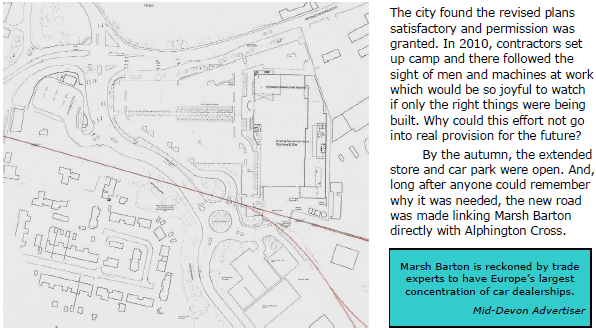
>> Appendix: A selection of correspondence from the file >>
A Brief Recap
The Government Buildings site, designated by the city council for employment, was granted retail use after an appeal because the developer agreed to build the first stage of the Grace Road link, a local plan aspiration.
Sainsbury's could not let a competitor open on a road leading to the St. Thomas store so the firm took the new site and its 13-year old building at Exe Bridge was demolished.
Railtrack surrendered the end of the branch railway so that there was no need to build an underbridge. The line was truncated and its embankment breached by a road thrusting towards the trading estate.
Within ten years, Sainsbury's needed to extend the Alphington store. The firm had bought the neighbouring land and was able to complete the link road, which ended up on a different course, rendering much of the earlier work useless.
So, where there was a railway there is now a road, which appears to have little value. Expansion of railfreight capacity at Marsh Barton and reinstatement of the branch railway when conditions change will now be more difficult. The out-of-town store and car park have got bigger. And it's all dressed up as being environmentally sensitive.
But there is a pond.
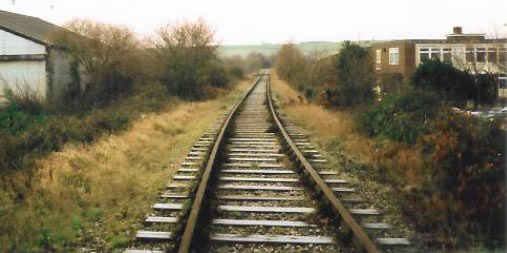
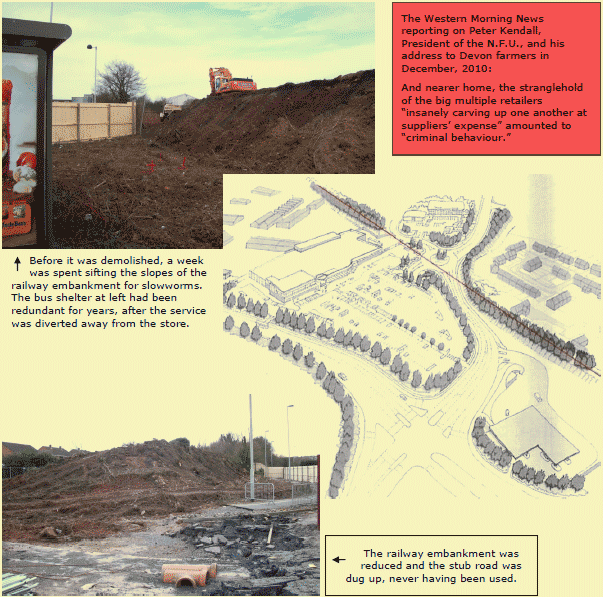
Add this to the list of reasons why the Teign Valley Branch cannot be reinstated
In a letter to John Hartley of C.P.R.E. Devon, on 6th October, Dave Black, Head of Planning and Transportation at Devon County Council, stated:-
“The Teign Valley route ran through a sparsely populated rural area providing little demand for its reopening. It was constructed as a rural single track line with passing places and poor curvature. As such any potential it has as a diversionary route is limited due to the lack of capacity and low line speeds. Furthermore as you state there are a number of obstacles to reconstructing the line. The A30 and the recently opened Grace road link (sic) bisect the line in Alphington and the A38 is constructed on its former alignment in places.”
Just to be clear, Mr. Black is right in his physical description of the branch, but wrong about its potential. In 1943, Government paid for long passing loops to be installed at Longdown, Christow, Trusham and Heathfield as part of wartime improvements to diversionary routes. This greatly improved capacity until the advantage was thrown away in 1958.
Reinstated with electronic, tokenless signalling, modern traction would enable heavier and faster trains to be worked over the line. Taking the running time of a main line, non-stop train between Exeter and Newton Abbot as about 17 minutes, a train diverted via the Teign Valley would be delayed by around 25 minutes. Which, to anyone who has endured emergency bus substitution, would be quite tolerable.
Mr. Black is also right in saying that there would be little demand for a train service. Decades of effective encouragement of car ownership has led to havens like the Teign Valley being stuffed with people whose only experience of public transport is taxis, aeroplanes and inter-city trains. They have escaped the worst of the degradation caused by mass motor transport and see any curtailment of the freedom to drive as being a matter for the city dweller. The smug rural dweller, whose work is elsewhere and whose choice of home was based exclusively on private transport, still would expect to press his vehicle into the confines of the town or city.
There is no understanding of how widespread, communal transport would work; how largely radial bus services centred on a spinal railway system would cause the least impact and make the best use of energy. Thinking people know that events stacking up will force a rethink of much modern practice. Transport will not escape restructuring and in future will have to be considered in pure terms, devoid of status or edge.
It is true that few in the Teign Valley want their trains back. But is it possible to measure demand from people who are not yet sufficiently informed to know what it is they really need?
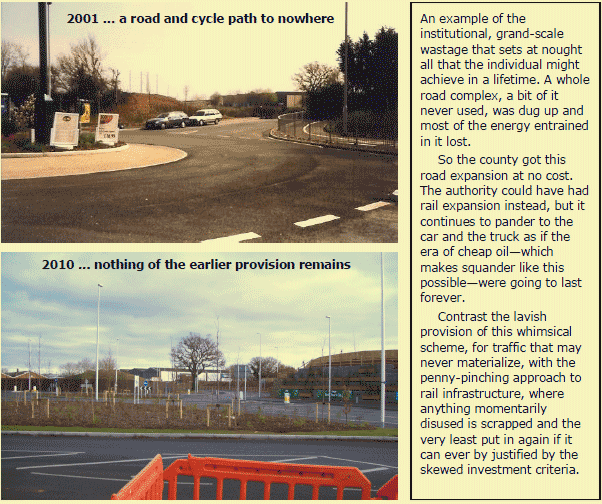

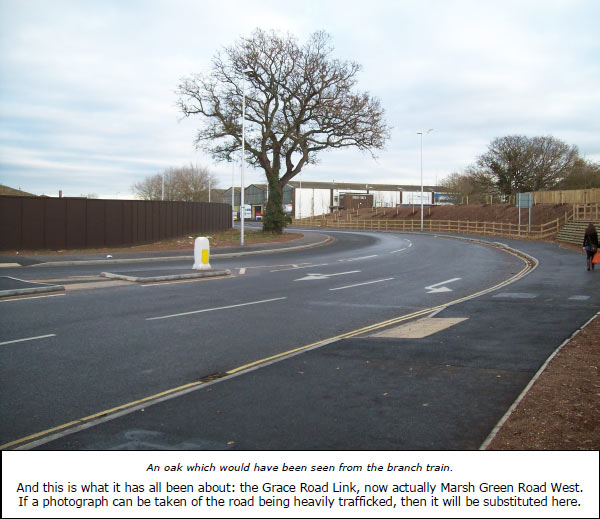
Friends of the Atlantic Coast Line - Focal
Anyone wishing today to experience a Great Western branch line like the Teign Valley should catch the train to Newquay.
The Teign Valley Branch train never used to deliver its passengers almost to the edge of a Cornish cliff as the Newquay one does. The Teign Valley Branch did not start on one coast and end on another, or pass through clay country—the spectacle of china clay mining, at any rate. And there were none of those names so redolent of the land beyond the Tamar; the Devon train did not stop at Luxulyan, Bugle, Roche, St. Columb Road and Quintrell Downs.
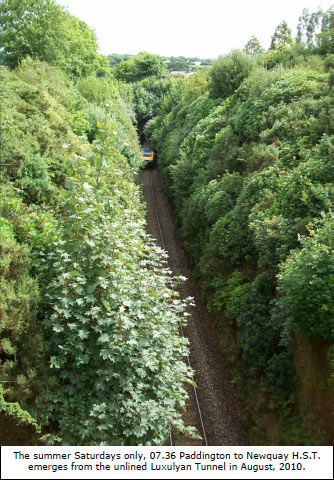 But the deep, sheer cuttings and high embankments, the gradients and curves between Par and Luxulyan are characteristic of the ruined branch line between Exeter and Christow.
But the deep, sheer cuttings and high embankments, the gradients and curves between Par and Luxulyan are characteristic of the ruined branch line between Exeter and Christow.
The rest of the Newquay line is a delight and should be savoured in its own right. It was mostly put together from two horse-drawn tramways and apart from diversions to avoid a rope-worked incline and an inadequate tunnel, the modern train takes the same route, passing much of interest in its 21 mile journey.
And the best of it is, thanks to regular through trains in summer (mostly on Saturdays), the line can be enjoyed in the comfort of a Mark III coach on an H.S.T., almost the last semblance of a real train left in G.W. territory.
Young holidaymakers, bound for their fortnight of excess in Cornwall's premier resort, probably do not wonder why their train has stopped at Goonbarrow Junction, where the only mineral traffic on a West Country branch, and some of the little freight traffic in the West of England, originates.
The line beyond is a long siding, not quite reaching the old buffer stop. A glance at the ruins of Newquay's terminus tells of grand days gone by, its remaining platform—one of three and the longest in Cornwall—mostly now deserted.
Newquay was also the terminus of the later branch from Chacewater, which ran via St. Agnes and Perranporth. When it closed, it was still very busy in summer and only just unremunerative overall.
It is this latter-day prosperity that the stalwart members of the local rail champions' group wish to see again—or at least, a bit of it.
The E. & T.V.R. is a supporter of the Friends of the Atlantic Coast Line.
>> Descending Luxulyan Bank >>
>> Climbing Luxulyan Bank >>
>> A Loco-Hauled Excursion Climbing Luxulyan Bank >>
www.nationalrail.co.uk
www.railaletrail.com
www.greatscenicrailways.com
www.cornwallpublictransport.info

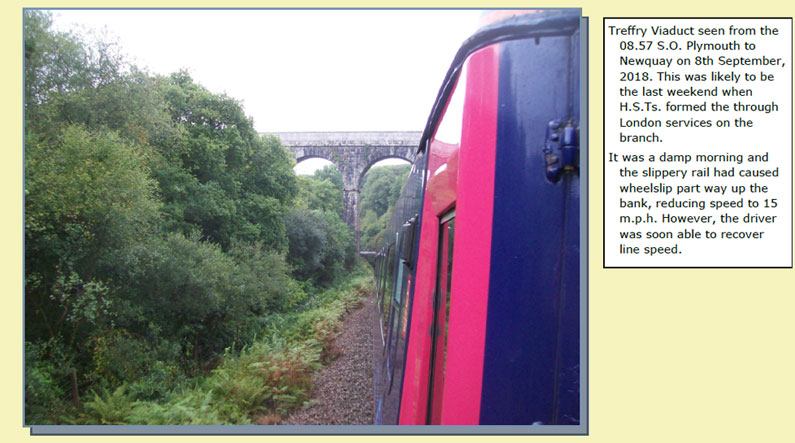

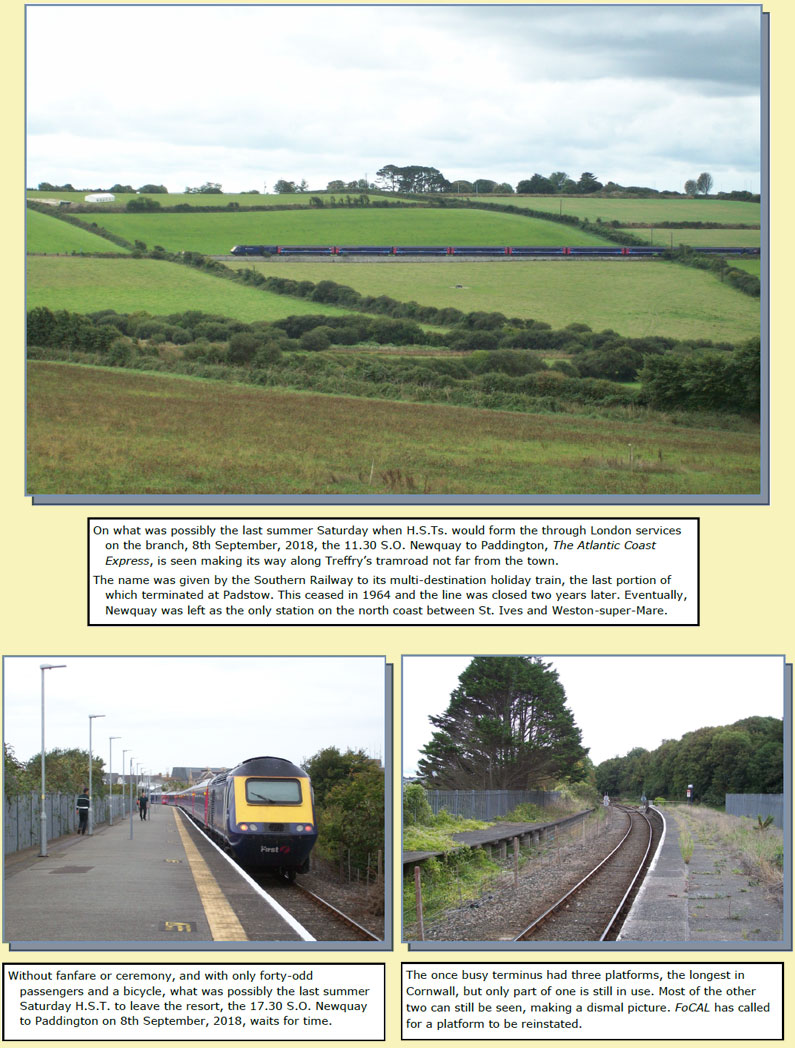
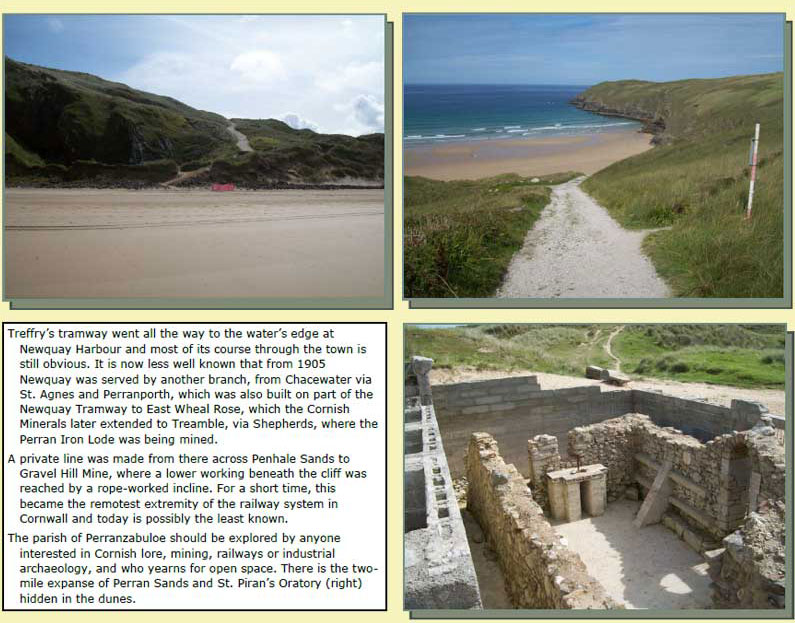
Local Transport Plan, Three
Not, it has to be admitted, the railway's best work, but since the recipients would be dead set against it, the phraseology hardly mattered. This submission was written hurriedly and sent to Devon County Council and Torbay Council in January, 2011, for consideration at the Consultation Stage of the Local Transport Plan.
No acknowledgement was received. It was also ignored by Doddiscombsleigh Parish Council. Other campaigners agree that it is important to state a case, even though it will be shouted down or shunned, because it acts as a marker in time. No decision-maker in future can say that he was not presented with an alternative view.
The Need for a Feasibility Study into
the Reopening of the Inland Railway Route
between Exeter and Newton Abbot
History
Until 1958, there were two ways of avoiding the main line of railway between Exeter and Newton Abbot during emergencies. After 1958, and until 1968, there remained one way, via Okehampton, but this was only of value to Plymouth and Cornwall. Now there is but one way into the peninsular beyond Exeter and this estuarine and coastal route is becoming increasingly vulnerable.
Modal Shift
There is already a drift from road to rail, caused more by a tiring of the car than by the particular attractiveness of trains. This is unfortunate but it is good that railways are winning on a practical level.
The era of cheap oil, which has been the foundation of unbridled road expansion, must pass and provision has to be made for a future in which energy will be costlier and less easy to waste.
Road transport being made to pay for its full environmental imposition will drive up the costs of vehicles and road use. Rising fuel prices, diminishing resources, extended supply lines and world political instability will lead to the abandonment of road transport use on the present scale. Much frivolous and unnecessary movement will be curtailed and demand for sustainable transport will ensue.
All pointers are towards the massive resurgence of a general purpose rail transport system, able to make frugal use of energy from any source, finite or renewable.
Rail operators must not use the normal tactic of pricing off new passengers and freight flows that cannot be accommodated but must have in train well advanced programmes to increase capacity and reach; that is, new and reopened lines and vastly more access points.
Volume usage and the winning back of profitable classes of traffic, both passenger and goods, will lead to railways that can afford to provide social benefits such as line reopenings which do not satisfy established funding criteria.
The Line Today
In engineering terms, despite 50 years' attrition, the Teign Valley Branch is still 80% complete. The remainder of the branch in Exeter serves a scrap metal trader on the Marsh Barton estate and weekly trains of 102-tonne wagons are forwarded. The branch would still be intact as far as Alphington, with potential for the development of more freight traffic from the estate, had not the city council pressed on with its obsolete road scheme. Huge incursions were made at each end of the branch in the 1970s by the construction of the A30 and A38 dual carriageways, but these are not insurmountable. Both tunnels and four out of the six river crossings are still intact. At Heathfield, the four-mile rump of the Moretonhampstead Branch lies mothballed. In all, 15½ miles of railway need to be rebuilt.
Potential
As existing structures weaken and crumble, others will take their place. Areas like the Teign Valley which are awash with wealth, but where there is little exchange, will become more community focussed. Interest in a communal transport system will grow, along with more localized production and supply. The idea of lines penetrating territory long lost and adding to the steel network will start a mania of rebuilding.
Beyond a functional role, the Teign Valley would of course provide for recreation which would add much to the line's viability. Town dwellers will use branch railways to reach tranquil areas for exploration on foot or cycle, causing little intrusion but bringing trade to new and existing accommodation and catering establishments.
As well as through working of ordinary services, there would undoubtedly be demand for land cruises and excursions to traverse the inland route by choice.
Operating
A reinstated Teign Valley Branch would not be an alternative main line. It would be what it was latterly: a branch line with diversionary capacity. This was greatly improved during World War II, with long passing loops installed at four places. Today, with electronic signalling and modern traction able to make light work of the severe gradients, a diverted train from Exeter to Newton Abbot could be delayed by as little as 25 minutes.
Exeter & Teign Valley Railway
The E. & T.V.R. has established a railway presence at Christow, the mid-point of the Teign Valley Branch. It can go no further as a construction project without major backing, but it is part of the purpose in the meantime to raise awareness and understanding of the potential of country railways to change not just transport, but established structures and practices in their hinterlands.
Open days are held and a permanent exhibition and educational resource will soon be finished. The railway leads with its “Transition Tourism,” which penalizes the motorist and encourages benign modes of travel to its on-rail camping accommodation.
The railway campaigns for rail and public transport in general. This mostly involves taking local examples and honing arguments which can be used universally. Most recently, the railway successfully campaigned against Department for Transport plans to block Perridge Tunnel and unsuccessfully against Exeter City severing the line at Alphington to further a 1970s aspirational road scheme.
Conclusion
Authorities must stop fixating on road transport because of the apparently endless demand from motorists and pressure from lobbyists who serve vested interests without shouldering any responsibility for the future.
Other systems must be nurtured into being to safeguard the best of modern civilization. Railway schemes must be talked about, promoted and set in motion. If a case can be made for the reinstatement of the Teign Valley Branch, others will follow and a momentum will be gathered.
Main railway routes must be made robust and reliable, Swiss fashion, and vulnerable stretches must have by-pass routes where possible.
The E. & T.V.R., in conjunction with professional consultants and graduate interns, is capable of conducting a feasibility study into the reopening of the inland railway route between Exeter and Newton Abbot.
Christow Station,
January, 2011
